Niigata's Murakami City: Enjoy Fun Events, Sightseeing, and Local Cuisine!
We use cookies to improve our contents. Check the detail and update your settings here .
We use cookies to improve our services.
For more details, please click here .

- Change setting
- Food & Drink
- Accommodation
- Things To Do
- All the categories
Transportation
- Weather & Seasons
- Long-Term Stay
- Travel Tips
- Event Tickets
- About MATCHA
- Company Profile
- MATCHA Special Features

Visiting Japan in Winter: Weather, Clothing, and Travel Tips 2023-2024

If you are planning to visit Japan in winter, read this article for information on weather, average temperatures and what to wear in the cold months. Recommended winter activities, snow festivals, and other travel tips are also introduced here.
All About Winter in Japan
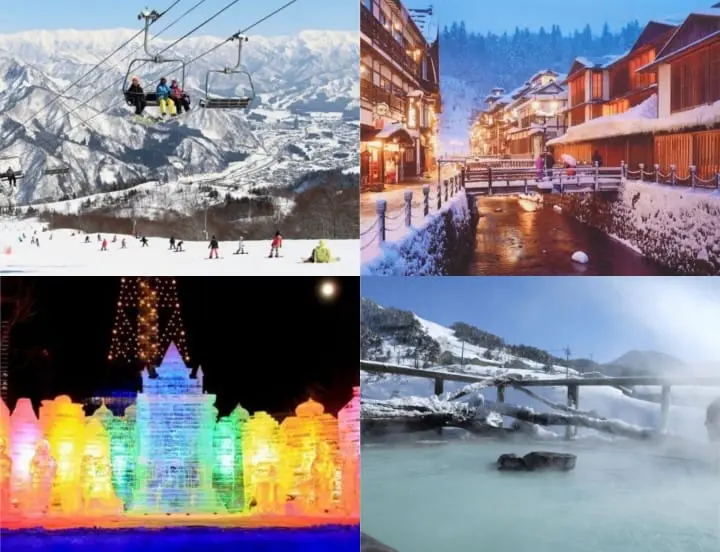
Japan is cold in winter and it is snowing in many places across the country. There is a unique beauty to the scenery, however, and there is a myriad of fun activities and delicious dishes that can only be enjoyed during this season.
We have compiled a guide of useful information for people planning to visit Japan during winter .
Japan in Winter: Travel Tips 2023-2024
Winter Temperatures in Japan What to Wear? Recommended Winter Clothing The Highlights of Winter in Japan 1. Winter Illuminations 2. New Year Celebrations 3. Snow Scenery 4. Winter Sports and Snow Festivals 5. Hot Springs
If you plan to explore Japan by car, use the coupon below to get a 10% discount on Nippon Rent-A-Car services!

Winter Driving in Japan: 11 Precautions and Tips
Winter Temperatures in Japan

Winter in Japan generally lasts from December to February .
In Tokyo, December temperatures tend to be around 12ºC (54°F) in the afternoon and drop to about 5ºC (41°F) in the morning and at night.
By January, afternoon temperatures drop to 10ºC (50°F) and morning temperatures tend to hover between 2ºC - 3ºC (35°F - 37°F). In February, afternoon temperatures are about 10ºC - 11ºC (42°F - 50°F) while morning and evening temperatures fall to about 3ºC (37°F).
Tokyo winters are sunny with little rain or snow. The air is dry, with the humidity around this time generally staying at a constant 30%.

What to Wear? Recommended Winter Clothing

You will need a coat in December. On some days, gloves and scarves might come in handy.
In January and February, you will need a down jacket or a coat. You will definitely need gloves and a muffler too.

Photo by Pixta On windy days, it is a good idea to have a knit cap and earmuffs. If you plan to be outside for a long time on cloudy days or in the evenings, we recommend that you use disposable kairo (heating pads, also called pocket warmers) to protect your hands and feet from the cold.
The heating pads can be purchased at any convenience store, supermarket, and drugstore. A pack of 10 heating pads costs around 200 yen. In order to use them, you just need to open the pack. The iron sand contained in the pad will begin to heat up in contact with the oxygen in the air. The pad will stay warm from 8 to 12 hours.

5 Types of Heat Packs: How to Stay Warm on Cold Winter Days in Japan
Please keep warm by wearing proper clothes and drinking hot drinks. If you do catch a cold, stop by a drugstore such as Matsumoto Kiyoshi and get some medicine. Light medicine to soothe a sore throat or to treat a fever can be bought without a medical prescription. In case of high fever and severe coughing, it's recommended that you go to the hospital.

Japanese Phrases To Use When You're Sick Or In The Hospital
It will be freezing outside but building interiors will be heated; it would be wise to layer your clothing so that you can take layers on and off when necessary.
↑ Return to the top of article.
The Highlights of Winter in Japan
1. winter illuminations.

Winter illuminations are one of the distinctive features of this season in Japan. The cities and towns are decorated with beautiful lights from around the end of November to February.
In Tokyo , you can find beautiful illuminations around Tokyo Station, in Ginza and Yurakucho, as well as Ebisu and Roppongi. The wide parks located less than one hour away from Tokyo, such as Sagamiko Pleasure Forest and Ashikaga Flower Park, have been drawing the attention of thousands of visitors thanks to the innovative collaboration between light and nature.
In Osaka , the Nakanoshima Park Illumination has an exciting theme every year while Kobe's Illuminarie are famous worldwide for the scale and splendor of the lights. If you visit Japan in the winter, do check out some of the light-up events around the city!

2. New Year Celebrations

From around the beginning of December, you can feel everyone's anticipation of the New Year celebrations all around the cities and towns of Japan. The shops will be showcasing products for the New Year, such as auspicious osechi cuisine , New Year's decorations , New Year's greeting cards and lucky bags (fukubukuro) full of goods that can be bought at special discount prices.
If you spend the New Year in Japan, how about joining the crowds for the traditional New Year midnight shrine or temple visit ?
In Tokyo, there are plenty of countdown parties and concerts held either in the open or in clubs and live music venues. The New Year's Fox Parade held in Oji , a town in the Kita ward of Tokyo, is increasingly popular, attracting participants from all around the country.

Year of the Dragon 2024 - The 12 Animals of the Zodiac in Japan
3. Beautiful Snow Scenery

The Shirogane Blue Pond in Hokkaido
When it comes to winter, natural scenery never fails to capture our hearts. The sight of entire vistas glittering white with freshly piled snow will both refresh and enthrall you.
However, such scenery cannot be enjoyed everywhere in Japan. In fact, in big cities like Tokyo, Osaka, and Fukuoka, snow is a rare sight.
Hokkaido is the first area to experience snowfall in Japan, with the first snowflakes drifting down in early November. The frozen Blue Pond in Biei and the drift ice in Abashiri are some of the splendid winter scenery in Hokkaido.

Ginzan Onsen in Yamagata. Photo by Pixta In Aomori, Akita, and Iwate, snow begins to fall around mid-November, while in Yamagata, Miyagi, and Fukushima, it will start snowing in late November.
Ginzan Onsen, a famous hot spring town in Yamagata, or the snow monsters of Zao are some of the sights that shouldn't be missed in winter in northeastern Japan.

Shirakawa-go Village in Gifu. Photo by Pixta
In Niigata, Toyama, Ishikawa, Fukui, Gifu (Takayama), and Nagano, it begins snowing in early December.
The Shirakawa-go Village or the hot spring resorts in Takayama is where you can enjoy idyllic winter scenery. You can visit these areas on bus tours from nearby major cities like Nagoya or Osaka.
Even in regions where snow does not tend to pile up, you can find snowy landscapes if you head towards the mountains.
For example, snow is very rare in Kyoto itself but places like Kinkakuji Temple, Ginkakuji Temple, and Kifune Shrine are famous for their snowy backdrops in the winter. The combination of temples and gardens is particularly gorgeous, and many visitors come to Japan during wintertime just to enjoy these evocative scenes.
4. Winter Sports and Snow Festivals

Japan is a mountainous country, which means it's an ideal environment for winter sports such as skiing, snowboarding, skating, and snow trekking.
Hakuba (Nagano), the GALA Ski Resort (Niigata), and the Bandai ski Resorts (Fukushima) are popular ski resorts that can be easily accessed from Tokyo.
Hokkaido's Niseko area is the go-to destination for those who wish to enjoy several days of skiing on powder snow. Additionally, there are six ski resorts near Sapporo, and other excellent slopes near Chitose, Rusutsu, and Otaru.

Gorgeous snow festivals are being held at various locations in eastern and northern Japan such as the Sapporo Snow Festival , the Asahikawa Winter Festival, and the Otaru Light Path.
They all contain extravagant displays of buildings and statues made completely out of snow and ice, which are illuminated at night, creating a wonderful landscape that can be enjoyed only during this season.
Each festival has various events that attract many visitors from all around the country. The tasty hot local dishes available at the yatai food stalls are themselves one of the attractions at these events.

5. Enjoy the Snow Scenery from a Hot Spring Bath

Winter is also the best time to appreciate hot springs . There's nothing like warming up by taking a hot bath in thermal water. Moreover, many hot spring resorts in the mountains offer open-air baths with wonderful views.
Noboribetsu Onsen in Hokkaido, Manza Onsen in Gunma, and Nozawa Onsen in Nagano are just some of the places where you can enjoy the amazing experience of taking a bath while gazing at the snowy landscape outside.

The Best 15 Onsen in Japan: Hot Springs to Visit in the Winter
Should I visit Japan in winter?
Visiting Japan in winter can be a wonderful experience, as the country offers a variety of unique seasonal attractions and activities during this time. For instance, winter is a great time to visit the northern island of Hokkaido for its snow festivals and winter sports, or to enjoy the beauty of snow-covered landscapes in regions such as Nagano and Shirakawa-go. Additionally, winter is also a great time to enjoy traditional hot springs (onsen) and seasonal cuisine, such as hot pot dishes and seasonal seafood. However, if you are not a fan of cold weather or snow, you may want to consider visiting Japan during a different season. Keep in mind that the weather and temperature can vary significantly between regions, so it's important to plan accordingly based on your interests and preferences.
How cold is Japan in winter?
The temperatures in Japan during winter can vary depending on the region and the specific time of the season. In general, northern areas such as Hokkaido experience colder temperatures, with average highs often around freezing or below. Other regions, such as Tokyo and Kyoto, typically have milder winter temperatures, with average highs ranging from around 8 to 12 degrees Celsius (46 to 54 degrees Fahrenheit). However, it's important to note that cold snaps and occasional heavy snowfall can occur, particularly in the northern and mountainous areas. It's a good idea to check the specific weather patterns for the time and region you plan to visit when considering a trip to Japan in winter.
Is Japan cheap in December?
The cost of visiting Japan in December can depend on various factors such as transportation, accommodations, and seasonal activities. Specifically, December is considered to be a part of the high travel season due to the winter holiday season, especially with the popularity of Christmas and New Year's celebrations. As a result, you may find that prices for flights, accommodations, and certain attractions could be higher than during other times of the year. On the other hand, many shops and department stores hold year-end sales and it's easier to find bargains. Additionally, there are seasonal activities and events unique to December, which can add value to your visit. It's always best to plan ahead, compare prices, and consider off-peak destinations and activities to make the most of your budget when traveling to Japan in December.
What should I wear in winter in Japan?
In winter, especially in the colder regions of Japan, it's important to dress warmly and layer your clothing to stay comfortable. We suggest wearing a eavy coat or insulated jacket, especially in colder regions, as well as layered clothing and thermal undergarments to trap heat and stay warm. Scarf, hat, and glove are important for protecting your neck, head, and hands from the cold. Waterproof and insulated footwear along with warm socks are essential if you plan to spend time outdoors in cold temperatures.
Is Kyoto worth visiting in winter?
Yes, Kyoto is definitely worth visiting in winter. In addition to the beautiful temples, gardens, and historical sites that Kyoto is famous for, there are beautiful winter illuminations at Kyoto Station and other locations, which add to the city's charm. The New Year traditions, which include special ceremonies at shrines and temples, as well as seasonal cuisine, are also a unique feature of Kyoto in winter. Additionally, Kyoto's traditional machiya townhouses and streets take on a special beauty in the winter, especially when dusted with snow. Please note, however, that it rarely snows in winter; there may be some snowfall in January and February.
Enjoy Your Winter Trip to Japan!
Winter in Japan is cold, but there are so many things that can only be enjoyed during this time: hot spring baths, hot pot dishes, snow-covered scenery, New Year events, and many more. Make sure to dress warmly and head out to experience everything that the season has to offer.

Main image by Pixta
The MATCHA editorial department. Our articles feature useful travel information for visitors to Japan, from how-to guides to recommended places to visit.
Related topics
Top articles, related article.

Top 45 Cherry Blossom Spots in Japan - 2024 Guide

Cherry Blossoms in Japan: 2024 Forecast and Best Spots

Japan Fall Foliage Forecast 2023: 25 Destinations and Tips
Nature / Seasons

Fall Foliage in Northern Japan 2023: Top 11 Spots in Tohoku

Autumn in Japan 2023: How to Enjoy the Fall Foliage Season

Japan in Winter: 10 Must-See Snow Festivals! 2024

Summer in Japan: 20 Fun Things to Do to Beat the Heat

15 Winter Things To Do In Japan - Hot Springs, Festivals, And Glistening Snow!

Weather In Japan - The Year Round Climate And Temperatures
Weather & Seasons
Start planning your trip
Special Features

Popular Searches
Latest news.

Showa Kinen Park Flower Festival 2024: Enjoy Nemophila, Tulips, and More!

A Must for Nature Lovers! Win a Free Stay at Unzen Amakusa National Park

A World of Light and Color! Van Gogh Alive in Japan 2024

Cherry Blossom Light-up in Tokyo! Yomiuri Land's Jewellumination

Cherry Blossoms and Sky Lanterns! Aichi Hanami Lights 2024

Japan's Public Holidays and Long Weekends in 2024

Aeon Mall Okinawa Rycom: A Shopping Mall Featuring a Resort Aura

Suica and Pasmo IC Cards: Prepaid Transportation Passes in Japan

Riding Taxis in Japan: The 6 Best Apps to Grab a Cab

How to Travel to Kyoto From Osaka: The Fastest and Cheapest Ways
New articles.

[Okinawa Yambaru]18 sightseeing spots and gourmet foods in Nago City! Enjoy play, nature, and food in Nago!

Room Introduction [Maisonette Suite Room with Barrel Sauna]

Nemophila field and yellow train

Golden Week 2024 in Japan: Dates, Events, and Travel Tips

[Yokoze Town, Chichibu District, Saitama Prefecture] Yokoze Carp Streamer Festival 2024 will be held until May 6th

- 2 Weeks for Couple
- 2 Weeks for Family
- Thailand Lantern Festival
- Indonesia(Bali)
- South Korea
- China (HK, Taiwan)
- Itinerary Ideas
- Asia Highlights Travel Reviews
- Thailand Travel Reviews
- Vietnam Travel Reviews
- Cambodia Travel Reviews
- Japan Travel Reviews
- Myanmar Travel Reviews
- China Travel Reviews

Plan a Japan Winter Trip 2024: Top Experiences & 2 Itineraries
Winter (December to February) in northern Japan is like a white fairy tale world: white snow, colorful Christmas illuminations, and a relaxed atmosphere. Although Japan is cold in winter, it still attracts visitors with its unique winter experiences, fewer travelers, and cheaper costs.
Japan is a great place to spend Christmas holidays with your family: relax in an onsen (hot spring) in a traditional ryokan (inn) while appreciating the snowy scenery in Hakone, ski with your teenage kids at Hokkaido's best powder-snow ski resort, experience dreamy wintry lighting in Shirakawa-go, and see snow monkeys bathe in an onsen in Nagano.
In this article, we are going to look at how to plan a winter travel itinerary, which could be a memorable family holiday.
- Do I Need a Visa to Visit Japan?
4 Top Japan-in-Winter Experiences
- Top 2 Winter Itineraries in Japan
Tips for Winter Travel in Japan
Winter weather in japan.
- How Much Does It Cost?
Do I Need a Visa to Go to Japan?
Japan restored its visa-waiver system from October 11th, 2022. If your country is on the Japan visa exemption list, like Australia, Canada, USA, UK and almost all European nations, you can visit Japan for 90 days (in most cases) without applying for a visa in advance.
Discover real reviews of Highlights Travel Family 's best-rated service across trusted platforms.
Here are four top things to do that you should not miss in Japan in winter:
1) Relax in a Onsen in a Cozy Ryokan in Hakone
Staying at a ryokan with onsens (hot spring baths) is the most attractive experience to be had on a winter's day for many travelers from Japan and abroad.
Hakone is the home of onsens and has numerous natural hot springs, some of them are believed to have healing properties. A ryokan is a traditional-style Japanese form of accommodation where you can sleep on a tatami and enjoy high-class kaiseki (multi-course classical Japanese cuisine).
Nothing is better than to relax in an onsen with stunning snowy trees and mountains around you and your family to create unforgettable holiday moments.
Suggested reading: How Long Should I Spend in Japan
2) Ski with Your Kids in Hokkaido/Nagano
Japan has lots of family-friendly ski resorts offering quality powder snow, perfect surroundings, clear English signage, and excellent service. Japan has the best ski resorts in Asia, but it is still cheaper to ski there than in Europe.
Hokkaido's pistes are definitely some of the top Japan destinations in winter , where world-class ski resorts include Niseko and Rusutsu. Skiing in Hokkaido you can enjoy light and fluffy snow, icy mountain scenery, professional English-speaking skiing lessons for kids, teenagers, and families, and fresh seafood.
Nagano, just an hour and a half from Tokyo, is also a well-known ski resort. Once the main venue for the Winter Olympics, Hakuba Valley is Nagano's best family-friendly ski resort.
Check more details about plan a ski holiday with your family >>>
3) See Charming Winter Lighting in Shirakawa-go
Shirakawa-go is a UNESCO World Heritage site , a picturesque village known for its traditional gassho-zukuri farmhouses, which have steep thatched roofs that are named after 'praying hands'. In recent years, Shirakawa-go has become popular with travelers for its beautiful countryside views and unique farmhouses.
These farmhouses are extremely charming when covered in snow and illuminated at night. The wintry lighting scenes can usually be seen from January to February, but the lighting-up time varies from year to year and stays require advance booking.
Contact our travel advisors and we can arrange it for you.
4) Watch Snow Monkeys Soak in Onsens in Nagano
Nagano is a city surrounded by mountains and is not far from Tokyo. It's well-known for its Hakuba Ski Resort and snow monkeys that soak in hot springs. It is a good place to go for family holidays in winter.
Monkeys (Japanese macaques) in Jigokudani Monkey Park are the only ones in the world who love to soak in hot springs in winter. Watching the snowflakes fall on the monkeys, each of them relaxing in hot springs to keep warm, would be a new and unforgettable memory of the trip.
Winter Itineraries in Japan: The Top 2 Options
Here are two winter itineraries that are hand-picked for families visiting Japan for the first time with two popular lengths of holidays (9 and 14 days) , both including relaxing in hot springs, seeing snow-covered shrines, enjoying a cup of steaming Japanese tea, and the option to go skiing with your kids.
1) The 9-Day Classical Route: Cover Major Highlights in Japan and Ryokan Experience
- Tokyo–Hakone–Kyoto–Osaka
This itinerary covers the top highlights of Japan: experience kid-favoured anime elements and an attractive Christmas atmosphere and illuminations in Tokyo, soak in onsens at a comfortable ryokan with snow scenery in Hakone, spend family time in Kyoto trying on kimonos and feeding friendly deer.
Here is a summary itinerary for you ( contact us for more details):
- Days 1–3: Tokyo (samurai, make sushi, anime center, and Asakusa)
- Days 4–5: Hakone (ryokans with onsens)
- Days 6–8: Kyoto (snow-covered shrines, geishas, sake, and feed deer)
- Day 9: Osaka and departure
It's also a great idea to spend an extra 2–3 days having a family ski time in Nagano, which is not far from Tokyo.
Suggested reading: 10 Days in Japan >>>
2) 14-Day Best Winter Experience Route: Skiing, Snow Monkeys in Onsens, Wintry Lighting in Shirakawa-go
- Sapporo–Otaru–Tokyo–Nagano–Shirakawa-go–Kyoto
You can get the best winter experience in Japan with this itinerary: ski and explore a famous chocolate factory in Sapporo — capital of Hokkaido, take a day trip to Otaru to enjoy a snowy view on the Otaru Canal, see the magical sight of snow monkeys soaking in hot springs in Nagano, and appreciate the wintry lighting in Shirakawa-go.
Here is a summary itinerary for your inspiration ( contact us for further details):
- Days 1–3: Sapporo (skiing, the most famous local chocolate factory and Sapporo Ice Festival)
- Day 4: Otaru (Otaru Canal and exquisite glass)
- Days 5–7: Fly to Tokyo (Tsukiji Market, Tokyo Tower, sumo, and anime)
- Day 8: Nagano (snow monkeys soaking in hot springs)
- Days 9–10: Takayama and Shirakawa-go (well-preserved townhouses and snow-covered gassho-zukuri farmhouses)
- Days 11–13: Kyoto (geisha, tea ceremony, sake, ryokan with onsen, feed deer in Nara)
- Day 14: Depart from Kansai International Airport in Osaka
To create a wonderful winter trip in Japan, here are some suggested tips to help you to avoid unnecessary hassles.
- Christmas and New Year is one of the busiest times in Japan. It's better to plan ahead and book flights and hotels at least 6 months in advance to reserve your favourite hotel/room.
- Winter in Japan is cold and snowy. You'd better take thick clothes to keep warm. We recommend you to bring a down jacket, gloves, and waterproof boots.
- Most ski resorts in Japan have rental shops to rent or sell ski equipment, so you don't have to take heavy ski equipment to Japan. Of course, it's okay to bring your own equipment. You can pay for a delivery service that will ship your skis directly to the ski resort.
Just let us know your interests and requirements , and we can help make it happen.
Winter in Japan is from December to February and the weather is cold and dry.
- In Sapporo on Hokkaido, the average daily temperature range is from 0°C (32°F) in the warmest part of the day down to -6°C (20°F) at night. While in Tokyo or Kyoto temperatures average above freezing, ranging from 2 to 10°C (36–50°F) on average.
- The average rainfall per month in winter is low in Tokyo/Kyoto at around 58 mm (2 in), but the average snowfall in Sapporo on Hokkaido is a moderate 104 mm (4 in) — and more snow falls at Hokkaido's mountainous resorts.
December sees the beginning of winter in Japan, with clear skies, and colder and drier weather. Cities like Tokyo, Kyoto, and Sapporo get into the festive spirit when celebrating Christmas and New Year.
January/February is the best time to ski in the white world of northern Japan. The high-quality powder snow is the most important feature of ski resorts in Japan, which attracts many skiers to come and enjoy it.
How Much Does a Japan Winter Trip Cost?
Japan rivals Europe both in terms of facilities and service standards, which means that travel in Japan costs more than in China or in Southeast Asian countries.
US$350-500 per person per day is the typical cost for a private tour with 4-star hotels, based on a family of 3–5 people. This includes a private guide, private car, full-day itinerary, tickets for attractions, and a local 4-star hotel.
Get Inspired with Some Popular Itineraries
At Asia Highlights, we create your kind of journey — your dates, your destinations, at your pace. You can have any trip tailor made for your travel.
More Travel Ideas and Inspiration
Sign up to our newsletter.
Be the first to receive exciting updates, exclusive promotions, and valuable travel tips from our team of experts.
Why Asia Highlights
Where can we take you today.
- Middle East
- African Safari
- Travel Agents
- Loyalty Program
- Our Differences
- Privacy Policy
Address: Building 6, Chuangyi Business Park, 70 Qilidian Road, Guilin, Guangxi, 541004, China
The Ultimate Japan Winter Itinerary (2 Weeks, 4 Cities)
02/27/2023 by Kristin Addis 2 Comments
When I think of the Japanese winter, I picture that feeling of being in a snow globe, or sitting in a steaming onsen (hot springs), or beautiful views of Mt. Fuji. It’s a tall order, to be sure, but like always, Japan delivered.
We recently spent two delicious weeks there, getting a taste of big cities, tiny villages, some of the most famous sights, and of course, delicious food. Honestly? I think we did a great job.
This is the ultimate two-week Japanese winter itinerary:
Table of Contents
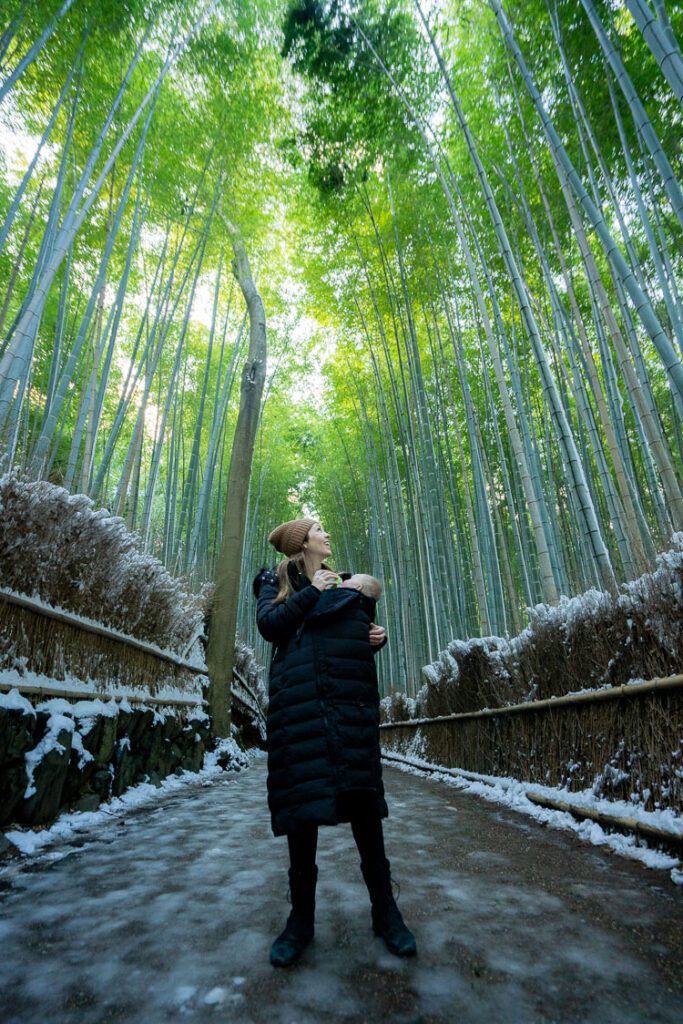
Our journey began in Kyoto and finished in Tokyo. If you can book one-way flights, this eliminates a transit day. You can also consider taking the two-hour bullet train from Tokyo over to Kyoto for the start of your trip.
Though it’s never a guarantee that you will get snow in Kyoto — in fact, it’s a rarity — seeing some of the most famous sites with the white stuff was magical.
Day 1: Bamboo grove
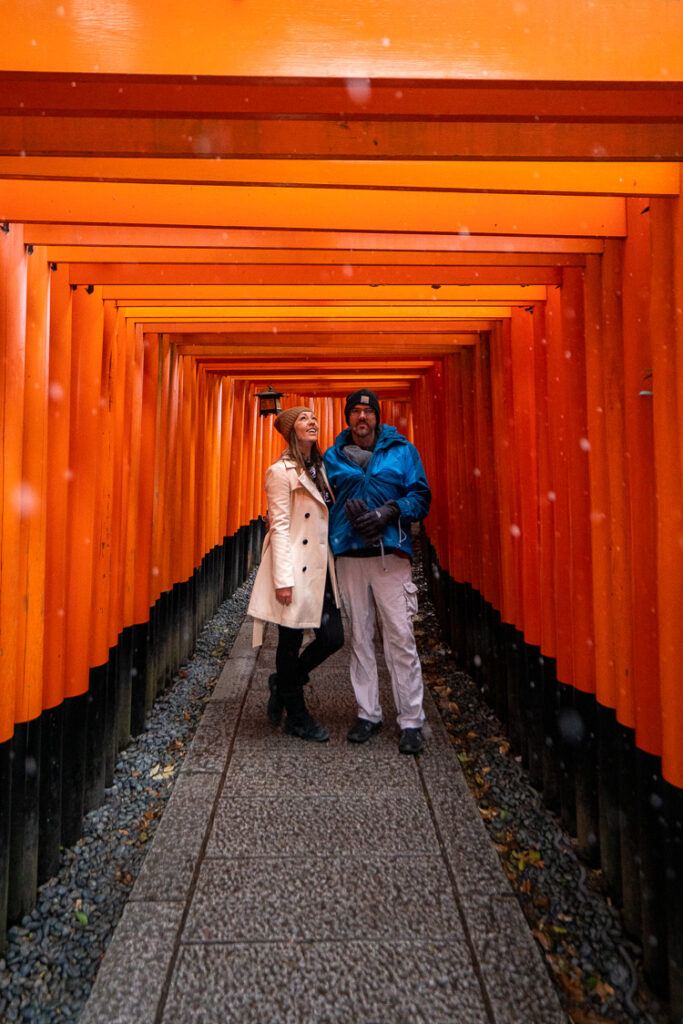
Head to Arashiyama as early as you can to walk through the bamboo forest and check out some of the shrines. The earlier you go, the smaller the crowds should be — however, the bamboo is thick and it can be dark super early in the morning. Though the shrines often have entrance fees that are usually around ¥500, the bamboo is free to walk through and enjoy.
You’ll see busy stands selling snacks close to the entrance, but honestly, they were a bit on the pricey side, and we found better ones elsewhere.
Jet lag took up more of the early part of our journey than intended, but if you are able, try to see the Kinkaku-ji temple, a golden pagoda surrounded by tranquil gardens and a pond. Finish the day with sunset on the famous street leading up to Hokan-ji temple.
Day 2: Kaiseki and torii
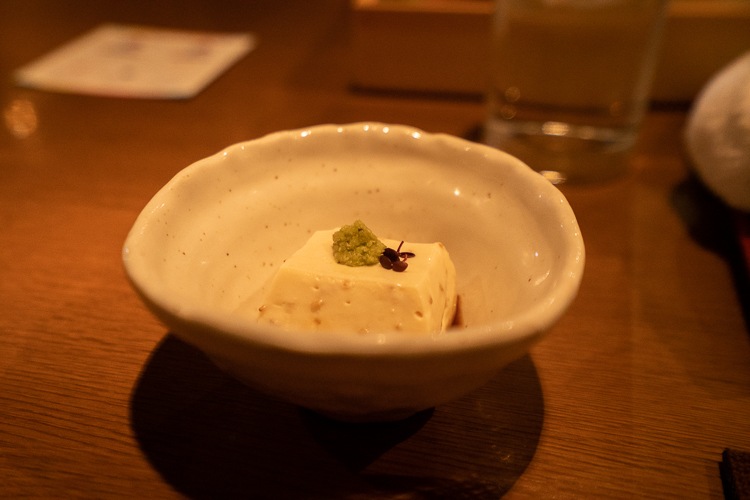
Our second day began with an early journey to Fushimi Inari Taisha, a Shinto shrine dating from 711 CE, with its famous walkways straddled by thousands of torii gates, and is free to enjoy. This and the bamboo forest were the sites I most hoped to see in Kyoto, and it was just as magical in person as I’d dreamed it would be.
It’s open 24 hours, as is the bamboo forest, so heading there early is a great idea. We happened to get there around 8am on one of the coldest, snowiest days of the year in the lowest season, and therefore had it almost to ourselves for a few minutes, but by 9am, busloads of people were showing up.
From there, check out the Kojingamine outlook for an overview of the city, followed by a visit to the Tō-ji temple, the tallest wooden pagoda in Japan dating back to the year 796.
Finish the evening with a stroll through the historic Gion district, or better yet, take a food tour. Ours involved a few hours of walking around, learning about the local culinary history, tasting traditional snacks and spices unique to Kyoto, and finishing with a kaiseki dinner, a ritual meal consisting of several courses created by a team of chefs. Each one features a different cooking style, though you can usually count on a rice dish, miso, sushi, and some kind of dessert. This is the highest level of dining in Japan and should not be missed! (The exact tour we took is no longer available, but you can book something similar .)
Day 3: Tea ceremony and shrines
Have you ever wanted to don a kimono? Participating in a tea ceremony is one of the best ways to get your chance. You’ll have the opportunity to learn the ritual around drinking green tea while wearing this traditional garment, plus get a photo doing so.
Finish the evening with sunset at Kiyomizu-dera, a Buddhist temple that is part of the Historic Monuments of Ancient Kyoto UNESCO World Heritage site.
Where to stay : Since we have a little one and arrived late at night into Kyoto, I booked a nice, affordable Airbnb near Kyoto Station. We loved our little spot!
(Due to our desire to catch an event that I’ll discuss later on in the post, we could only spend three nights in Kyoto, but it deserved so much more! I’d recommend staying at least three, if not more.)
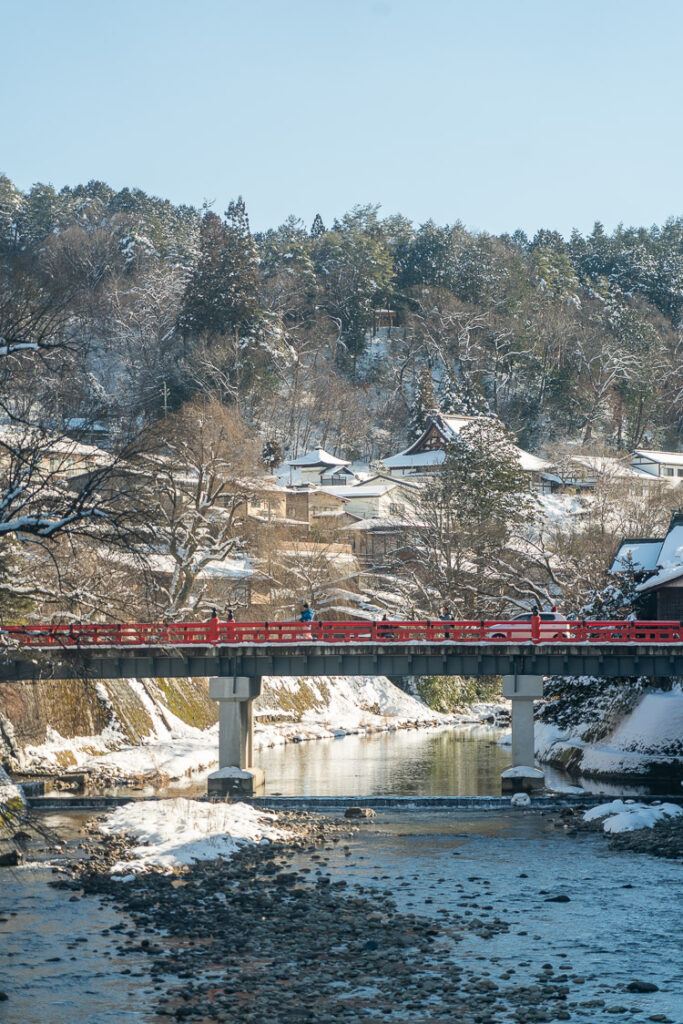
This adorable town full of friendly people is the gateway to the Japanese Northern Alps, as they’re called. We picked this town for its historic feel and famous food, and the likelihood of it being a winter wonderland (it was!).
Day 4: Journey to Takayama, known for delicious Hida beef
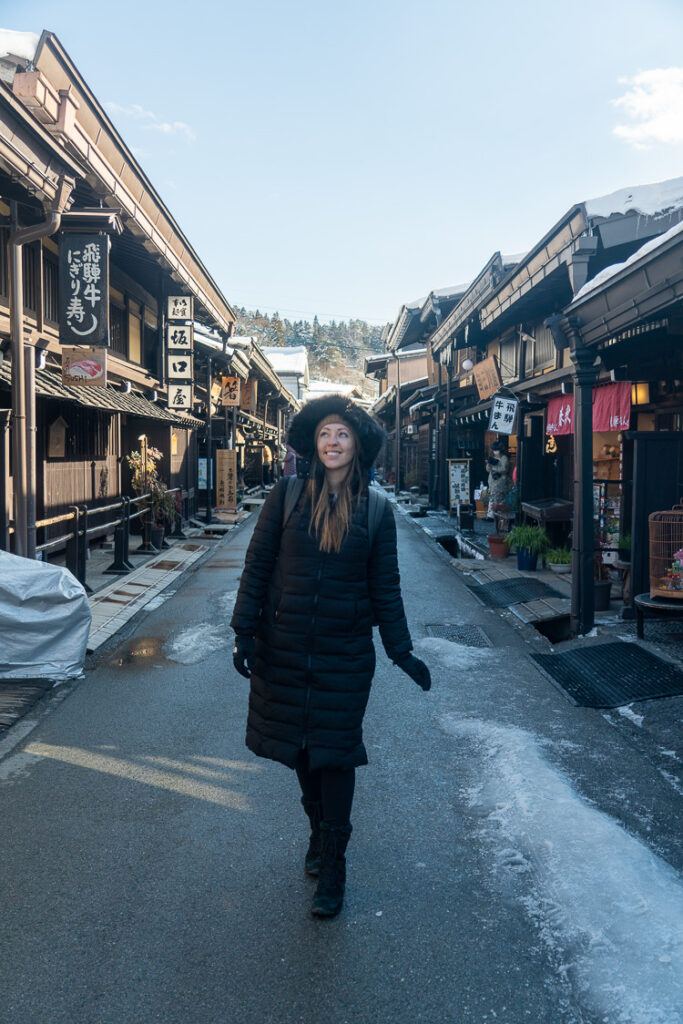
You’ll spend a good chunk of the day getting to Takayama, which is best accessed on Japan Rail (JR) via Nagoya. The ride there is beautiful, most of it alongside a deeply blue river. (Sometimes there’s also a direct bus, though, so be sure to check! We tended to use Google Maps for our planning, which I suggest doing when weighing your options.)
Spend the afternoon and evening sampling some local Hida beef, which is incredibly flavorful and tender, at Kyoya restaurant, where you cook your meal over a charcoal grill at your table! It was a delicious experience at a place we didn’t even realize was famous — we just stopped by, since it was near our Airbnb. Apparently a reservation is normally essential, so be sure to call ahead.
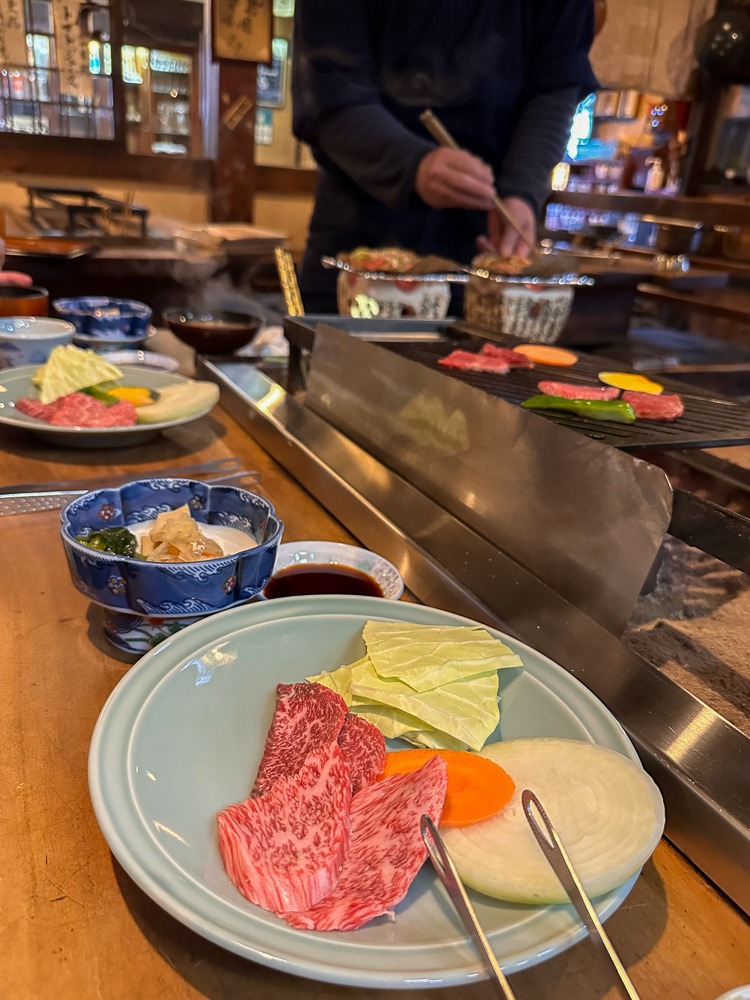
Day 5: Sanmachi and Hida no Sato folk village
Check out the historical houses (pictured below the subheading above) in Sanmachi, a neighborhood with traditional Edo-era architecture dating back to the 1600s through the 1800s. You’ll find small eateries, shops, and houses all along the way.
There’s a morning market along the river as well, where you can find food vendors. It’s perfect for an early stroll.
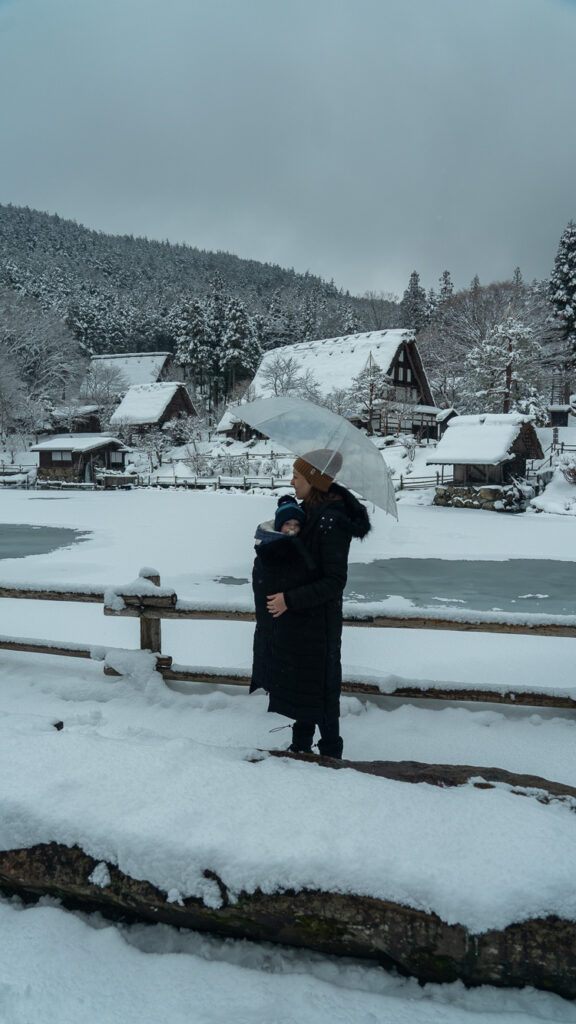
Spend the afternoon checking out the Hida no Sato folk village, an open-air museum featuring more Edo-era farmhouses. In the summer months, you’ll see grass growing on the thatched roofs, and in the winter, the village is famous for having feet of snow packed to the tops of the houses. It was magical to see them that way! Entrance is ¥700.
(The village also a great primer for the next stop, Shirakawa-go, a larger UNESCO World Heritage village from the same era.)
– Read More –
Traveling in Japan with a Baby
Day 6: Shinotaka ropeway or Gero onsen
Head out of town to the Shinotaka Ropeway (¥3,300 per adult), about a 1.5-hour bus ride each way, or consider heading to the town of Gero, south of Takayama, for a night. It’s one of the most famous onsen towns in Japan, known for its particularly smooth water.
(Due to my tattoos I can’t use most onsen , which I’ll discuss later, but for this reason, we opted to skip Gero.)
Where to eat: In Takayama, we loved the Tori Coffee and Sabou Usagi cafés, as well as Uemura for dinner. The latter is a truly tiny restaurant serving organic food the chef grows himself. I cannot recommend it enough! I messaged him via Instagram to book. Sakurajaya is also a fun experience, sitting at the bar and watching the chef make the food in izakaya fashion (informal, small dishes).
Where to stay : I loved our Airbnb here! It was the cheapest of the trip, at around $90/night, and had its own outdoor bathtub, which was magical with the snow!
Shirakawa-go
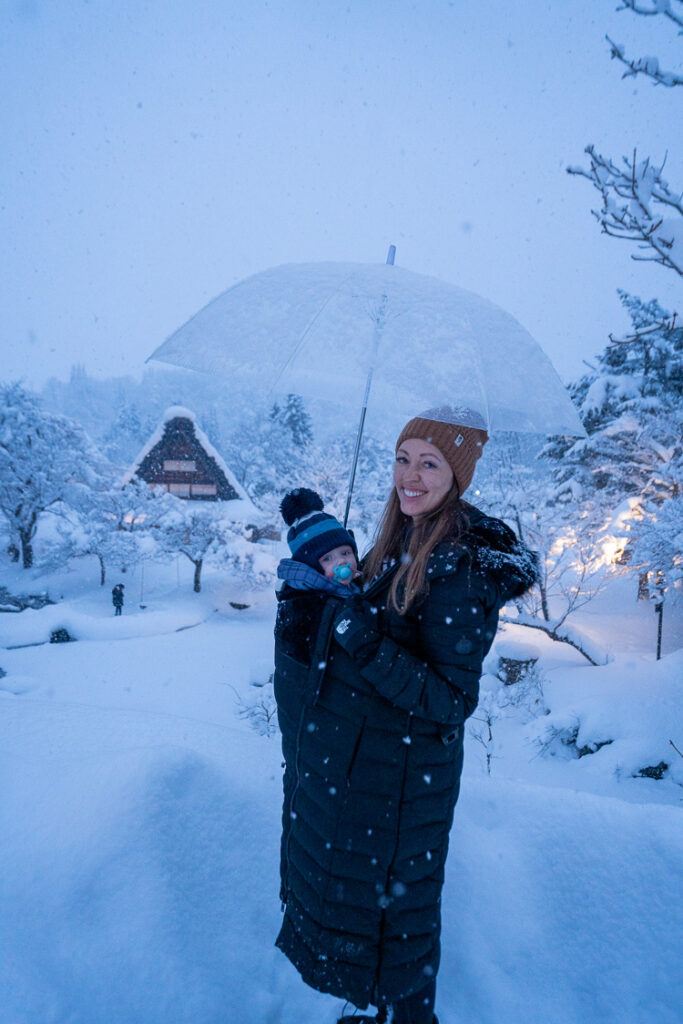
Day 7: UNESCO site Shirakawa-go
Light Up Shirakawa-go was the event I mentioned that caused us to leave Kyoto a bit earlier than I normally would have. Each winter, for six Sundays over January and February, Shirakawa-go lights up all of its buildings in the evening. If you are planning way ahead and can snag a reservation to stay overnight, do it, but if not, you can take a bus tour to the event from Takayama.
Tickets for this may sell out, as the number of visitors is capped. I logged on right when they went on sale in November and had to refresh the page for a couple of hours before finally getting through, but I’m happy to say that it was worth it. It truly felt like we were in a snow globe.
If you can’t get tickets for the light-up event, be sure to head there during the day. It is easy to access from Takayama via a bus that runs hourly (the bus costs ¥700, village admission is free). The village and buildings are quaint, there are a few museums you can enter for a couple hundred yen, and there’s an observation deck as well. The village would be delightful in every season, though I loved seeing it so snowy!
Stay: it’s possible to overnight in Shrakawa-go in the traditional houses . They book up well in advance for the light up event, though other times of year or other evenings would be easier. You’re only allowed to stay for one night in each house and they ask that you don’t bring large suitcases as there isn’t room for storage.
Day 8: Journey to Mt. Fuji
This was our longest travel day, making our way down to Yamanashi prefecture. It was so worth the journey, though, as staying on a lake with a view of Mt. Fuji was a highlight for us.
There were dozens of ways we could have chosen to get there, though we opted for the JR back through Nagoya, followed by a bus. (In 2023, the bus that runs between Takayama and Kawaguchiko was not running, but it would be by far the best and cheapest way in the future.)
Kawaguchiko
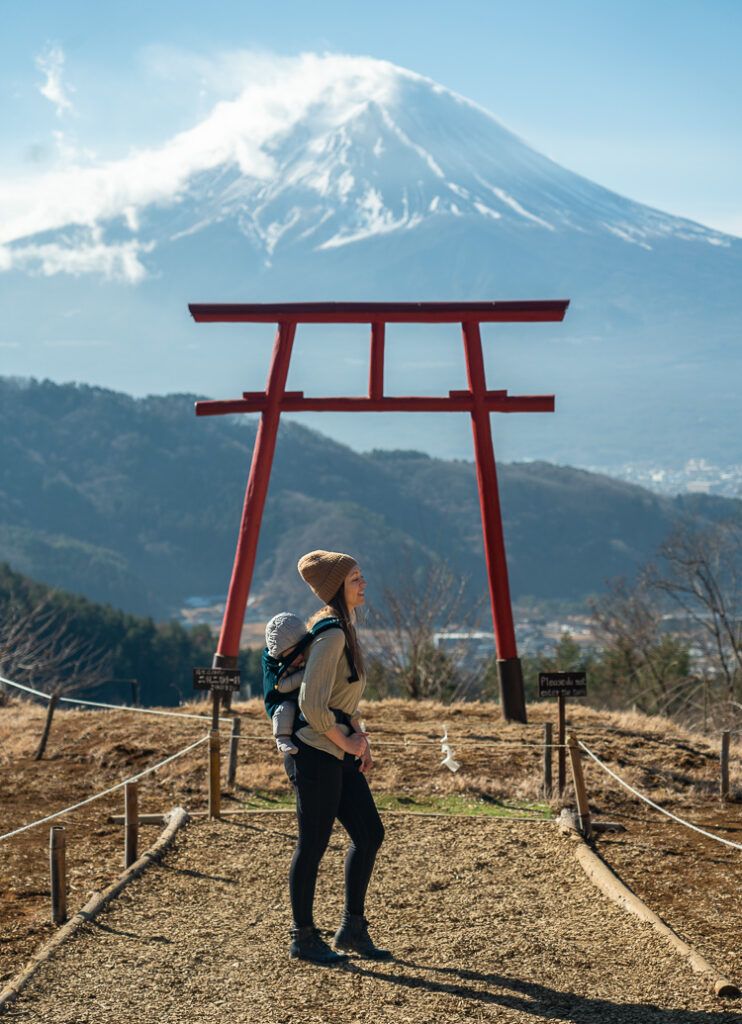
Wintertime is generally the clearest time of year and offers the best chance to see Mt. Fuji, one of the most famous sights in Japan.
When we were deciding between Kawaguchiko and Hakone, another popular spot an hour south, one of my Instagram followers suggested Kawaguchiko (and Takayama!), and I’m so glad we took her advice. We had gorgeous mountain views over the lake day after day.
Day 9: Chureito Pagoda
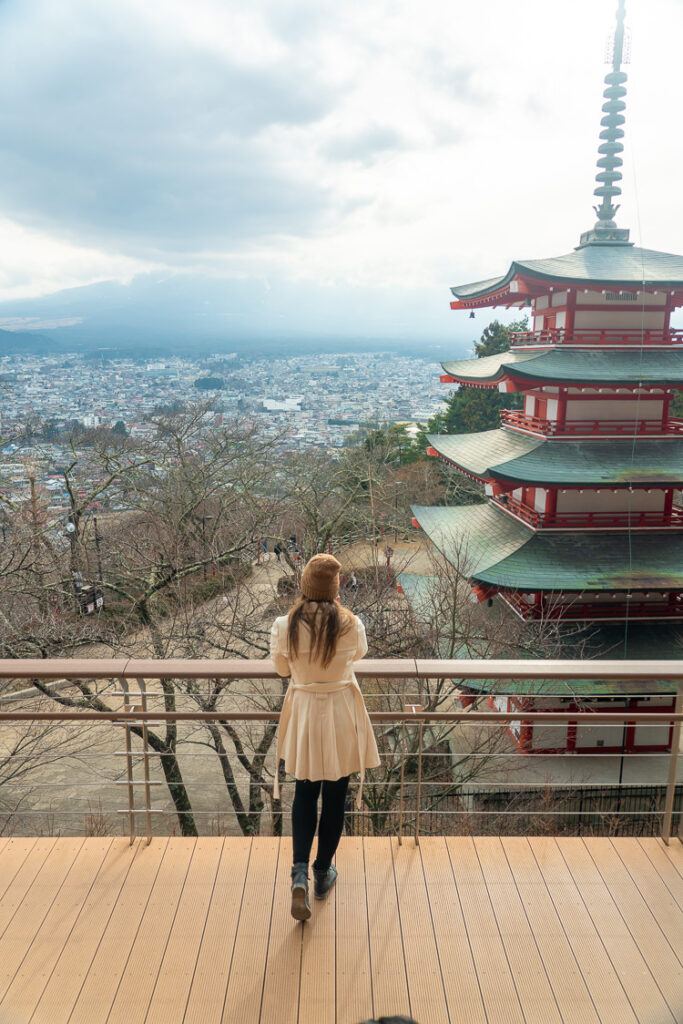
You can’t visit Kawaguchiko without seeing the Chureito Pagoda, which as one of the most iconic views in Japan.
That said, it was also my biggest heartbreak of the trip, having wanted to see this view of Mt. Fuji for years. The clouds rolled in just as we were getting off the train. C’est la vie!
The pagoda is free to visit. You’ll have to climb quite a few stairs to get there, though, but it’s worth it.
Consider also stopping by Oishi Park, which is easy to access from the sightseeing-loop bus, for another iconic Fuji view.
Day 10: Soak and stare at Fuji
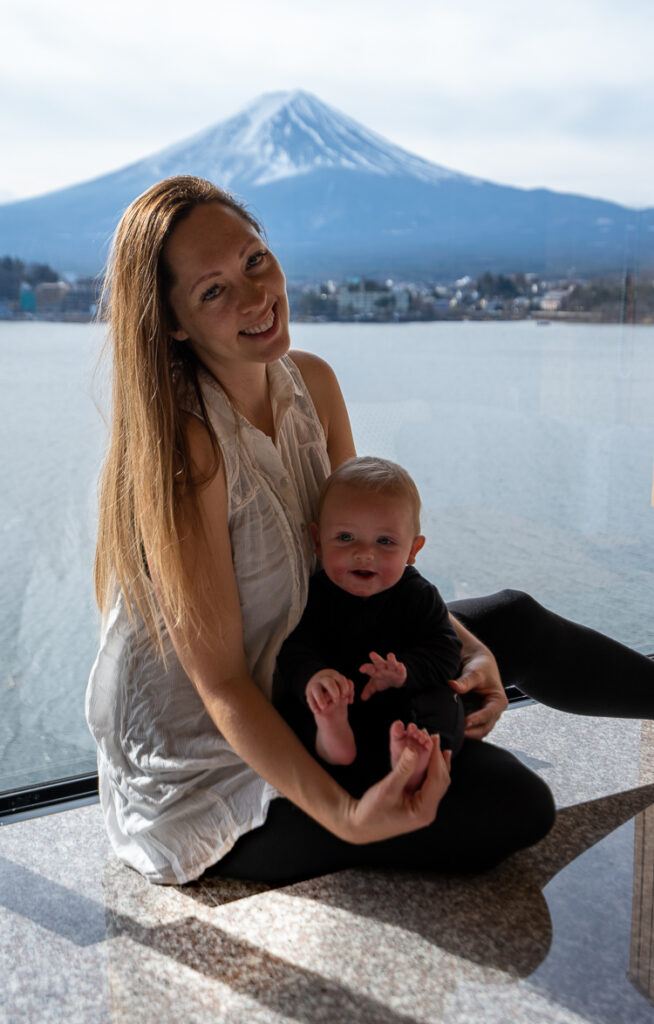
We spent a good chunk of our tenth day hanging out at our hotel, to be honest. I recommend booking a place to stay on the opposite side of the lake from Mt. Fuji (the northern side), so that you can take a day or so to just relax and enjoy the view.
We booked Ubuya , a ryokan (traditional Japanese inn that typically features tatami-matted rooms) that had private hot springs on the balconies. Since I have tattoos, this was the only way that I was going to get to enjoy onsen that are so iconic in Japan in the winter.
Due to tattoos’ association with gang culture, almost all onsen and even hotel spas in Japan ban those with tattoos, unless it’s very small and can easily be covered with a Band-Aid. You can’t cover them up with a swimsuit, either, as one is fully nude in onsen .
This ryokan was definitely a splurge for our trip, but it was worth it! We also ate breakfast and dinner in the hotel, the latter a kaiseki meal in a private room set up for us and the baby.
Day 11: Fuji ropeway and Asama shrine
Are you down for an Insta-famous photo opportunity? There are two big ones in the area, including the Mt. Fuji Panoramic Ropeway. It’s a short journey, so I normally would not feel the ¥1,800 per person round-trip is worth it, since you can get a great view of the mountain from the lakeside. But you can get some pretty cool pictures swinging with Mt. Fuji at a swingset at the top. You’ll have to queue up and pay an additional ¥500 for the photo op, which we didn’t do, but part of me wishes we had.
Next, take the bus bound for the Asama shrine and either walk from there, which is a 30-ish-minute uphill climb, or take a taxi to Tenku no torii. They’ll ask for ¥100 per person at the entrance and there will be another queue, but I loved the photos we got! (pictured at the beginning of the Kawaguchiko section).
Note: The “suicide forest” is also in the Kawaguchiko area, but it’s generally regarded as disrespectful to visit. Please pick other activities instead. There are many other beautiful forests in Japan!
Stay : As mentioned above, we booked Ubuya and loved the experience. If it’s out of your price range, I re commend staying on the same side of the lake and booking another hotel nearby so that you can still get the Fuji view from your room.
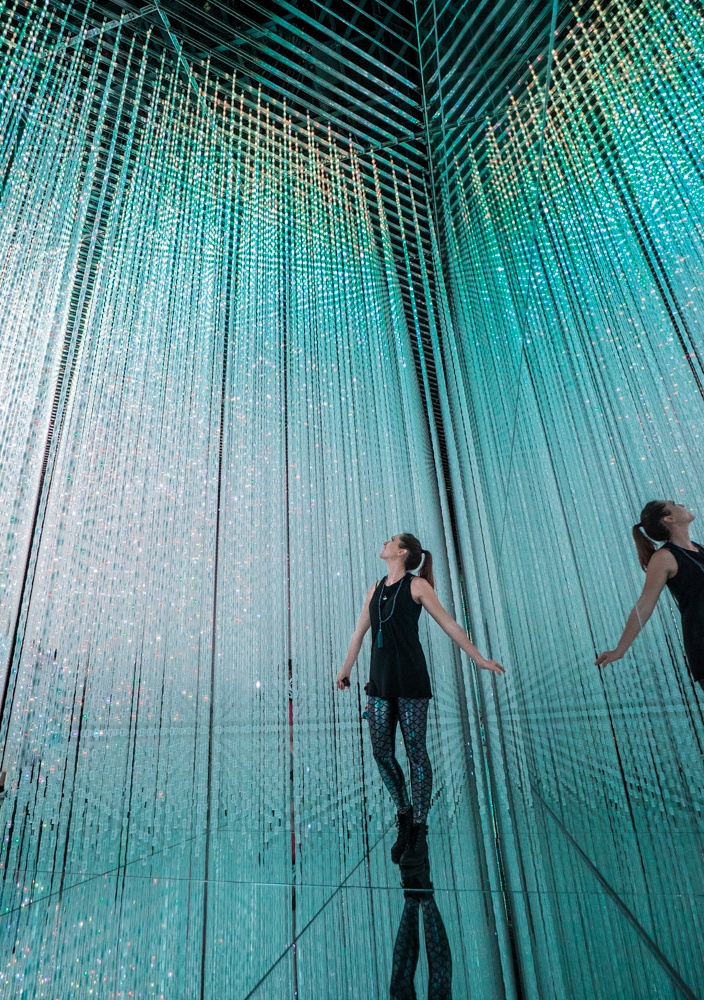
Welcome to the largest city in the world! I am usually not a big-city person, but Tokyo is a different animal. It’s one of the most unique places I’ve ever been, and there’s almost a limitless supply of things to do. Though you can only ever scratch the surface, these are some of my favorites:
Day 12: TeamLab and Harajuku
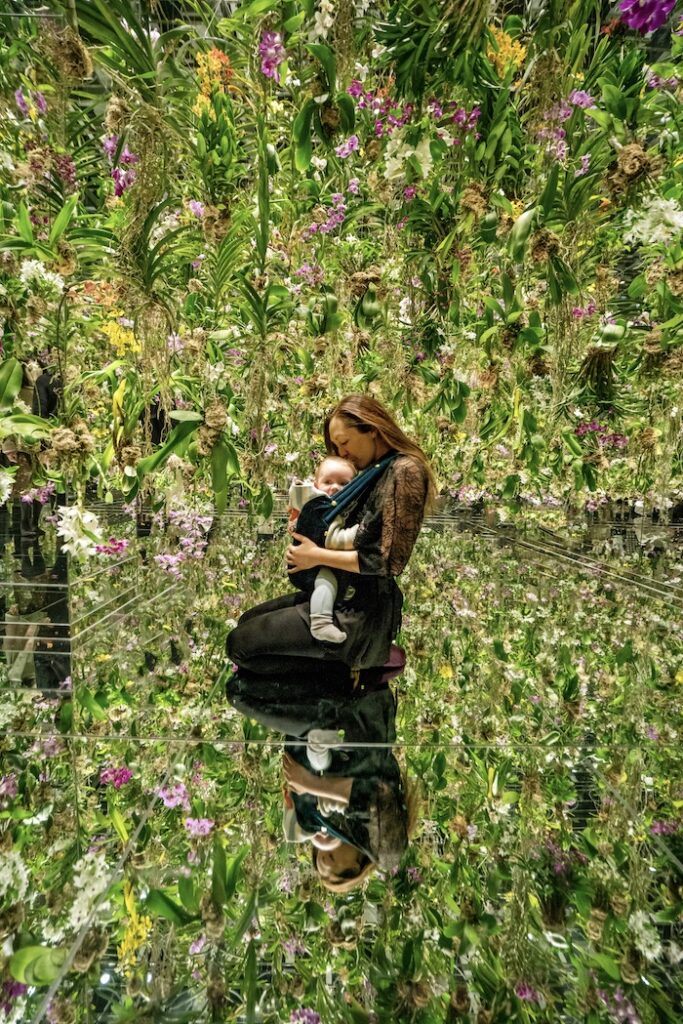
Harajuku is one of the most famous areas of Tokyo — and for good reason. There’s awesome shopping, creative cafés, and some famous local culture to check out. If you’re looking for something more traditional, in the same area, you can walk around the Meiji Jingu Shinto shrine.
From there, pop by the Hie shrine for another opportunity to walk through a smaller version of the Kyoto torii gates, as well as view one of the lovelier shrines in Tokyo, featuring white walls and a green roof.
Finally, do not miss a TeamLab exhibit! This art collective’s immersive art experiences get me every time. They tend to only remain open for a few years; TeamLab Planets should be open for another year or so, and it’s a must-see. I highly recommend going in the hours before closing so as to have fewer people in your photos. Book your ticket ahead of time too: this one somehow let us skip the whole line! Entrance is ¥3200.
Day 13: Nakano, Shibuya crossing, and ramen
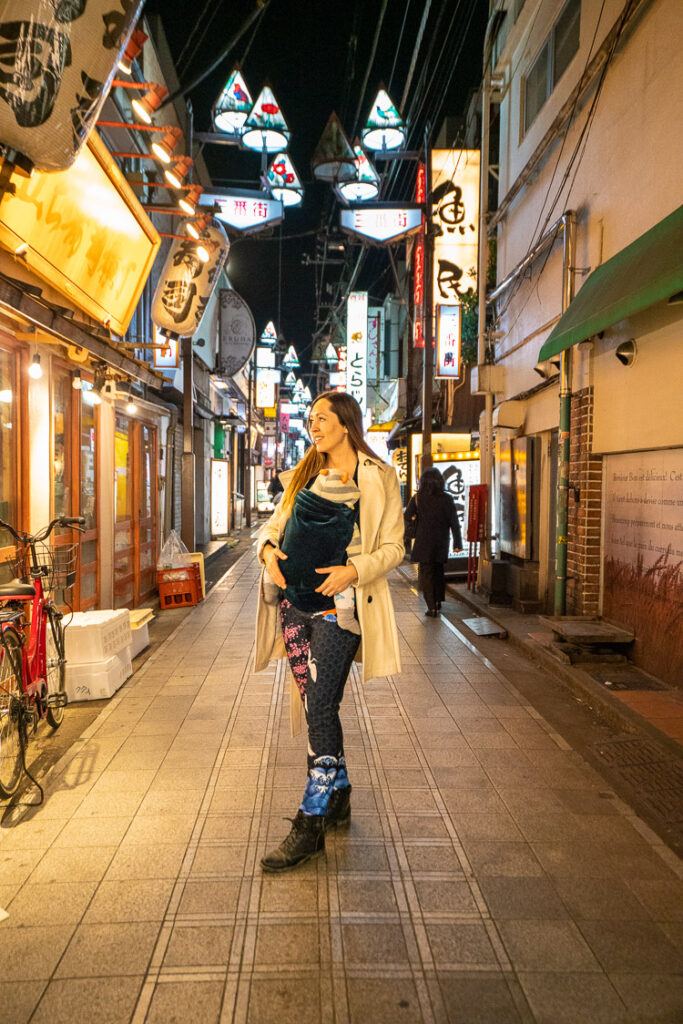
On our second-to-last day, I knew I wanted to do another food experience. There are a couple that I was looking at, including a walking tour in the famous Tsukiji fish market and a six-bowl ramen tasting . The latter just happened to fit better with our schedule, and it was delicious! We visited three ramen shops, all of which featured several unique flavors and styles. Garrett and I also shared each of our bowls, so that we could sample all of the flavors, so we ended up having 12 ramen samplings. Our favorite was the inventive pesto ramen, though I always love the curry version and was surprised by how much I enjoyed the squid ink as well.
Give yourself some extra time to check out Shibuya crossing, where the tour begins, which is the famous all-direction crosswalk that as many as 3,000 people use at a time! It’s quite a sight. If you want to see it from above, the Starbucks is a popular place to check it out.
We followed our ramen tour with a giant ice cream at Daily Chico at the Nakano broadway, pausing to take the photo featured above on one of the adjacent streets, which you can find by glancing to your right as you walk up the broadway.
Day 14: Imperial Palace, Disney, and unique kaiseki in Ginza
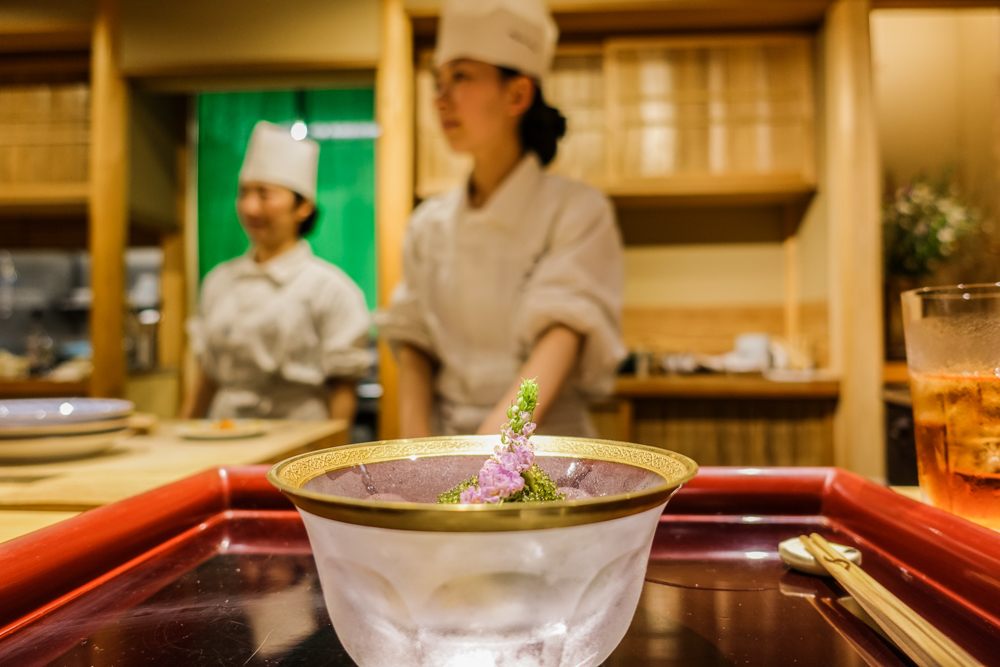
On your last day, you’ll have to make a difficult choice about what to see. I have a complete Tokyo itinerary here with a bunch of options. If our son were a bit older, we would have loved to go to Tokyo Disney or Disney Sea. Better believe it’s on the docket for the future!
Since our hotel was near the Imperial Palace, we opted to take a walk around the grounds. Keep in mind that you actually have to take a tour in order to get closer. The gardens are lovely, though, and the trees lining the streets near Tokyo Station are a great winter photo op.
I’d finish your trip with one of the most unique kaiseki experiences, in the high-end Ginza district of Tokyo: Tsurutokame , the only all-female kaiseki restaurant in Japan, featuring not only delicious food but incredible presentation. I was vegan when I visited a few years ago, and they even created a completely vegan menu for me! It was a highlight of all of my trips to Japan. It’s also popular, so book well in advance!
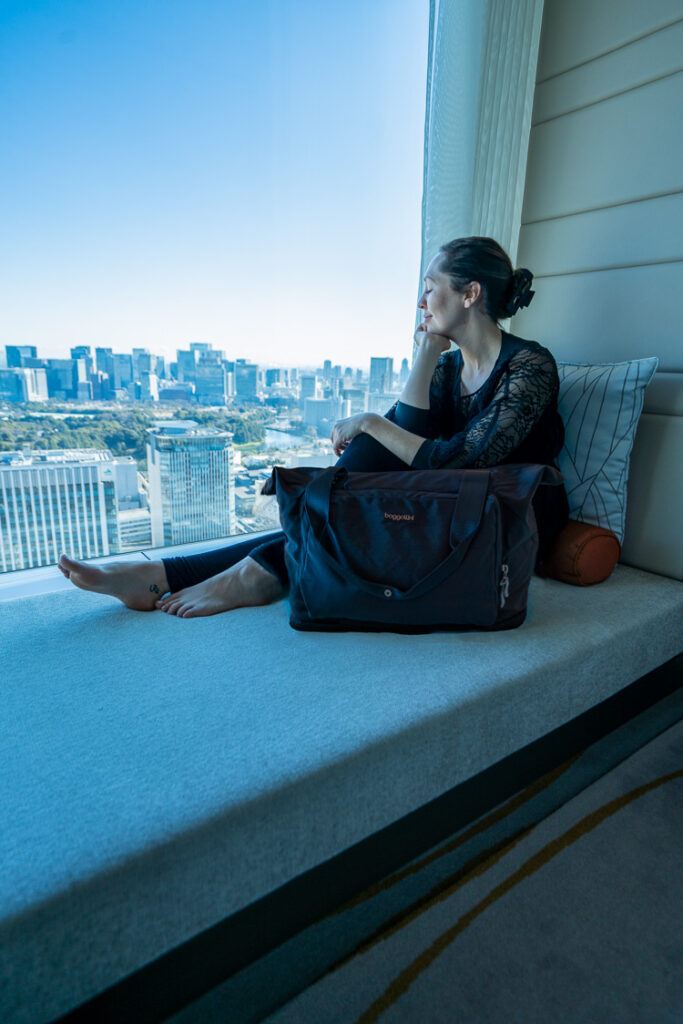
Where to stay : I splurged a bit on this part of the trip as well, booking us at the Prince Gallery Kioicho Hotel . The view from the room made it so worth it! The breakfast was delicious, and the location was central, but the best part about it was definitely the service, which was top-notch.
Although many of you won’t need to worry about this, it was also the only place we stayed in Japan that had a crib!
Hokkaido, Japan’s northernmost major island, is important to mention. Many people choose to ski its famous powder (known in the ski world as Ja-pow), during all or at least part of their winter trip.
From Tokyo, you can take the bullet train and be in Hokkaido in about four hours. Although it was under consideration for us, since we are not really ski people (who live in a ski town — it’s weird, I know) and had a baby with us, we passed.
But there’s good reason to visit. Sapporo, the largest city, has a snow festival each year that features massive ice and snow sculptures. It usually only lasts for a week, so plan your trip accordingly if you’d like to see it.
Getting Around

Getting around Japan was pretty straightforward using Google Maps. I would sometimes cross-reference with blog posts that specifically discussed the journey between certain destinations, just to be sure, but Google Maps was almost always correct. I also appreciated that it would usually give me the exact platform and even car to use in order to make a quick exit.
That said, both Kyoto Station and Tokyo’s larger metros can be confusing, although there were information desks scattered throughout, and they were super helpful — I would just show them where I was trying to go, and the staff person would point in the right direction.
To Rail Pass or not to Rail Pass?
Should you get the Japan Rail Pass ? Only foreigners are allowed to get this pass, which for a one-time fee gives you unlimited rides on the Shinkansen (bullet train) and Japan Rail lines. If you are going to be taking long-distance trains between Kyoto and Tokyo or Hokkaido, for example, it could make a lot of sense.
We opted not to do it, however, since two of the towns we visited — Takayama and Kawaguchiko — involved bus travel. It didn’t work out to be financially advantageous for us, just barely. We did, however, get the Tokyo metro pass , and I recommend the Hakone pass if you opt to go there.
If you do plan to take trains during the high season, it will probably make sense to get the JR pass and book your seats ahead of time. There are only a few cars on each train that are unreserved, which only worked out for us because we were there during low season. Book highway buses ahead of time as well, either in person at the station or online. I hadn’t realized this was important — we were lucky to grab the last seats on our bus to Kawaguchiko, which would’ve been such a pain to have missed!
Also, be sure to have cash on hand. There are ATMs in most convenience stores and train stations. We found that the ticket machine did not take our foreign credit cards, but if we waited in line for in-person service, we could buy a train or bus ticket with a card. Many restaurants also prefer cash.
Language and other notes
Although I can read a bit of Japanese, thanks to my years studying Mandarin and the similarities between the two, I don’t speak it beyond hello ( konnichiwa ) and thank you ( arigato ). Thanks to Felix, I learned that the word for “cute” is kawaii .
I found that people were always willing to try to communicate, though, since Japanese people are friendly and wonderful hosts. So I highly recommend downloading Japanese on Google Translate before you go. That way you can access it offline if you need to show somebody something or ask a question.
Also keep in mind that people bow as a sign of respect, a greeting, or thank you. Be sure to bow back, fully facing the person.
Japan is easily one of my favorite countries to explore because it’s just so different from anywhere else on earth. You get the opportunity to travel back in time, to feel blasted to the future in the big cities, and the friendliness is incredible.
Note: Some links in this post are affiliate links to the hotels and activities that we participated in. Purchasing through these links supports us at no extra cost to you
About Kristin Addis
Kristin Addis is the founder and CEO of Be My Travel Muse, a resource for female travelers all around the world since 2012. She's traveled solo to over 65 countries and has brought over 150 women on her all-female adventure tours from Botswana to the Alaskan tundra.
Leave a Reply Cancel reply
Your email address will not be published. Required fields are marked *
Save my name, email, and website in this browser for the next time I comment.
subscribe to our newsletter
This site uses Akismet to reduce spam. Learn how your comment data is processed .
06/21/2023 at 11:50 am
Hello! I enjoyed reading about your trip, the photos are amazing. I am starting to come around to the idea of going to Japan during winter. What dates/month did you travel?
Kristin says
07/01/2023 at 10:40 am
This was end of January into February 🙂
- Things to Do
Winter in Japan: 20 Best Things to Do in Japan’s Cold Season

- Joshua Furr
- Steve Csorgo
Winter in Japan is an exciting time filled with unique activities and breathtaking landscapes. Whether it’s skiing down powdery slopes, soaking in hot springs, or dining on snow crabs, winter has no shortage of things to do, see, and eat. If you remember to pack the proper attire, and don’t mind a bit of adventure, this list of 20 things to do in Japan in winter is your ticket to a cool time indeed!

This post may contain affiliate links. If you buy through them, we may earn a commission at no additional cost to you.
When Is Winter in Japan?
Winter in Japan typically lasts from December until February, and reaches its peak in January. However, as Japan runs long from north to south, the winter climate differs greatly between regions. For example, in Japan's northernmost island of Hokkaido , wintery weather can start as early as October, while Japan’s southernmost Okinawa barely has a winter at all. That’s why it’s important to plan your itinerary before packing clothes and gear.
How Cold Does Japan Get In Winter?
Tokyo in winter is chilly but relatively mild and sunny, with the temperature averaging 0-8°C, and snowfall a rarity. Sapporo , the capital of Hokkaido, regularly drops below 0°C between December and March, and snow is a given. The Hokuriku and Tohoku regions are also notorious for their snow, including Niigata , Yamagata , Akita, Aomori, and Toyama , where accumulated snowfall is often measured in meters in particularly snowy spots!
The Best Things to Do in Winter in Japan
1. hit the powdery slopes.
One of the top reasons to visit Japan in winter is skiing and snowboarding. Ski resorts can be found in much of Japan, including the well-established Niseko in Hokkaido, which sits in the shadow of Mt. Yotei. Niseko’s powder snow is light and dry, and there are loads of resorts suiting all skill levels.
Closer to Tokyo is the valley town of Hakuba , Nagano Prefecture , which hosted the 1998 Winter Olympics, and boasts 10 fantastic slopes frequented by a vibrant community. Just over an hour from Tokyo is also the highly accessible Echigo-Yuzawa , home to 12 ski resorts including GALA Yuzawa, which has its very own bullet train station!
Recommended Accommodation in Niseko: Annupuri Lodge at Niseko
2. Warm Up Inside a Kamakura Snow Hut
Like the Inuits of Canada, winter in Japan comes with its own frozen domiciles called “kamakura.” These hollowed-out snowdomes were originally built as shrines to the God of Water, and continue to be a beloved winter tradition providing a surprisingly snug nook against the frigid climate.
Several areas throughout Japan hold kamakura festivals, such as Yunishigawa Onsen in Nikko , which is famous for both large-scale snowdomes that you can sit in, along with rows of adorable mini-kamakura illuminating the night. Further north, the annual Yokote Snow Festival is held in Yokote, Akita Prefecture, on February 15 and 16. It features more than 80 kamakura, including those set up at the foot of the magnificent Yokote Castle.
3. Admire the Architecture of Shirakawa-go
Situated at the foot of the sacred Mt. Haku in Gifu Prefecture , the old homesteads in the UNESCO World Heritage site Shirakawa-go appear even more spectacular during winter in Japan. These structures, some of which are around 300 years old, were built with triangular thatched roofs in a traditional style called “gassho-zukuri” to keep the heavy snowfall that regularly hits the region from building up.
In addition to viewing these impressive dwellings, Shirakawa-go also holds several festivals throughout winter, like the Silkworm Festival and the Katteko Snow Fireworks, both in February.
Recommended Accommodation in Shirakawa-go: Onyado Yuinosho
4. Relish Japanese Winter Delicacies
Winter in Japan wouldn’t be complete without enjoying the bounties of the season. Seafood delicacies are particularly plentiful between December through February, with Japanese crab being the staple. There are several crab varieties to sample in winter, such as king crab in Hokkaido, and snow crab in the Hokuriku region, which includes Echizen crab in Fukui Prefecture and Matsuba crab in Tottori Prefecture .
Other winter must-tries include fresh “fugu” (pufferfish) in Shimonoseki, plump salty oysters from Hiroshima , firm and succulent monkfish in the fishing village of Kazamaura, and “buri” yellowtail from Toyama Bay.
Our Top Tips
JR Pass for Whole Japan
Explore Japan in the most convenient and economical way with a Japan Rail Pass! It is valid for the majority of railways and local buses operated by JR.
5. Thaw Out in an Onsen Hot Spring
Whether you’ve spent the day on the slopes, or a night out at a winter festival, nothing beats a soak in one of the many “ onsen ” hot springs that dot Japan. There are loads of remarkable resort towns to choose from, like the evocative Ginzan Onsen with its charming retro gas lamps and wooden inns, or Kusatsu Onsen , famous for its picturesque Yubatake hot water field.
If you feel squeamish about bathing nude with strangers, here are 12 Japanese onsen hot springs you can visit with swimsuits.
6. Sapporo Snow Festival
The Sapporo Snow Festival started back in 1950 with just a few snow sculptures, but has since exploded into a massive spectacle drawing in over a million visitors each year.
The attractions are spread out across three distinct venues: the central Odori, where many of the biggest and best snow sculptures are exhibited; the nightlife district of Susukino, which is decorated by glimmering ice sculptures; and Tsudome, an interactive venue with snow slides and more. A skating rink and a plethora of food stalls add to the fun, while after-dark light-ups bathe the scene in an enchanting glow.
Sapporo is also near many renowned hot springs, like Jozankei Onsen, and is the birthplace of miso ramen, giving you plenty of warmth and nourishment to fight against the cold.
Recommended Accommodation in Sapporo: Hotel Resol Trinity Sapporo
7. Bask in Stunning Illuminations
Although night comes early during winter in Japan, magnificent “ illumination ” displays stave off the darkness to cheer up locals and attract visitors during these otherwise dreary months.
Yomiuriland, one of Tokyo’s largest amusement parks, hosts the Jewellumination, where magical jewel-colored LED lights transform the grounds into a radiant wonderland. Closer to Tokyo Station is the Marunouchi Illumination, which sees over a million golden bulbs on hundreds of trees make the already bright Tokyo streetscape even more dazzling.
Winter in Osaka likewise has its central Namba area lit-up with a festive kaleidoscope of a million lights, while Osaka Castle is adorned by illuminated artworks. Most cities in Japan also have their own renditions, so be sure to check them out while visiting!
8. Ring in the New Year With Hatsumode
Hatsumode is a Japanese New Year’s tradition dating back to the Heian Period (794-1185). It is the custom of visiting a shrine or temple during the first week or so of the New Year to make an offering and pray for the coming year.
However, there’s more to hatsumode than just praying. As the entire community is involved, it has a festive mood complete with food stalls and activities. You can scoop up decorative “omamori” good-luck amulets, and have your fortune told via “omikuji” paper slips. For those unfamiliar with how to pray the Japanese way, we suggest checking out this article , too.
Popular hatsumode spots include Tokyo’s Meiji Jingu Shrine and Senso-ji Temple, Tsurugaoka Hachimangu in Kamakura , Fushimi Inari Taisha in Kyoto , and Izumo Taisha in Shimane . Keep in mind that crowds will be massive, so be prepared to wait in line.
9. Hunt For Bargains With Fukubukuro
Those who love a good deal will do well to visit Japan in winter! Japanese lucky bags, called “fukubukuro” are packed with a bunch of goodies sold all together at a discount, often with the contents inside kept secret until opening!
The process is simple: visit a store of your choice between January 1-3 (or even afterwards) and try to get your hands on one of these fleeting fukubukuro. While they can be found easily enough, some popular stores may require a reservation months in advance!
Why the appeal? Mystery may have something to do with it, especially since fukubukuro are a way for stores to unload old inventory, and could be filled with anything. Check out our guide to fukubukuro to learn how to secure your own.
10. Mingle With the Snow Monkeys
While Japanese macaques can be found throughout the nation, none are more entertaining than the “ snow monkeys ” that live at Jigokudani Monkey Park in mountainous northern Nagano Prefecture. Here, visitors can walk amongst dozens of these playful primates as they freely run, roam, and even bathe in nearby hot springs.
Due to the area’s high volcanic activity, natural hot springs abound, and the snow monkeys adorably take to the onsen much like we humans do, visibly enjoying the steaming water as snow falls around them. Thanks to their tame nature, it’s easy to snap great photos, but don’t get too close to them.
11. Engage In Alternative Snow Activities
If skiing and snowboarding isn’t your thing, there are plenty of alternatives to make the most of winter in Japan. For a more relaxed experience, join a snowshoeing tour, which are available with both modern snowshoes or traditional “kanjiki” Japanese-style snowshoes. If you’re seeking speed, then a thrilling snowmobile ride through forest trails would be right up your alley.
For younger visitors and those young at heart, airboarding down a slippery slope, ice-skating at one of the many rinks set up during the season, or just making some good old-fashioned snow angels is sure to leave you with unforgettable winter in Japan memories!
12. Cruise Through the Okhotsk Drift Ice
Every January, ice chunks from the mouth of Russia’s Amur River drift down the Okhotsk Sea into northeastern Hokkaido, forming drift ice famous in places like Mombetsu, Abashiri, and Shiretoko. These wide sheets of ice are around 50 cm thick, and can only be broken up by special icebreakers that also double as passenger cruise ships.
We recommend setting sail on the powerful Aurora, which departs from Abashiri Port, or the equally tough dual-drill Garinko, departing from Mombetsu Port. For an even more up-close encounter, there are also “ice walk” tours available , where you’ll be able to walk across the drift ice to feel the intensity of winter in Japan for yourself.
13. Go Ice Fishing For “Wakasagi” Smelt
As mentioned, winter in Japan comes with an array of delicious seafood, but like the adage goes: Teach a man to fish and you feed him for a lifetime. That being said, ice fishing for “wakasagi” smelt is not just a practical pastime, but an enjoyable and (if you catch something) satisfying experience. In January, Lake Akan and Lake Abashiri in Hokkaido are ideal as they are the first to freeze, but Nagano’s Lake Matsubara and Fukushima’s Lake Hibara are also popular haunts for ice fishers.
This primitive method of fishing requires warm clothing, proper equipment, and, above all, patience. While pros will often set themselves up, ice fishing facilities and tours with tents, holes, and gear all provided can be found at several frozen lakes in Japan.
14. Survive the Snow Monsters of Zao
Around January, the Zao Mountain Range in Yamagata Prefecture is blasted by Siberian winds smothering its fir trees in layers of distorted ice giving the impression of monstrous beasts! Dubbed the “Snow Monsters of Zao,” these surreal natural creations can be viewed from above aboard the Zao Ropeway, and then examined up close at the Jizo Sancho Station Summit Terrace.
After absorbing the 360-degree view of the frozen world below (and heating up in the station’s restaurant), pop on your skis or snowboard and race down the mountainside slopes of the Zao Onsen Ski Resort. While a pleasure to behold in the day, the Snow Monsters become even more photogenic during the Zao Juhyo Festival, when they are illuminated by colorful lights at night.
Read more about Zao Onsen and 14 other places to visit in Yamagata Prefecture.
15. Uncover Frozen Waterfalls
The freezing temperatures during winter in Japan affect all elements of nature, and even powerful waterfalls cannot escape its grasp. The majestic wintery sheen and long glass-like icicles of these “icefalls” is perhaps the most stark demonstration of winter’s boundless might.
In Kamikawa, Hokkaido, visitors can join the annual Sounkyo Onsen Ice Waterfall Festival, which not only features the iced-over Ryusei and Ginga Waterfalls, but also a breathtaking winter fireworks show. Closer to Tokyo, the Chichibu region of Saitama Prefecture hosts the Otaki Ice Festival in January, where the magnificent Misotsuchi Icicles hang from the rocks above. Within the deep forests of western Tokyo, the 23.3-meter Hossawa Falls is another beautiful frozen wonder only a 20-minute walk from the Hinohara Village Office.
16. Catch the Early Plum Blossoms at the Atami Plum Garden
The Atami Plum Garden, in the coastal resort city of Atami , was established in 1886 and is filled with over 450 plum trees of 60 varieties, some around 100 years old. The first wave of delicate buds blossom as early as mid-November, making them some of the earliest in Japan. This is followed up by staggered middle and late-blooming plum trees, letting visitors enjoy their flowers all throughout the winter.
17. Capture Photos at the Kasayama Camellia Groves
Winter in Japan is also the season of the radiant camellia flowers that flourish in Toragasaki at the northern tip of Mt. Kasa, Yamaguchi Prefecture. Here, 25,000 camellias grow across 10 hectares, dotting the pastoral landscape with vibrant flourishes of red and yellow.
To celebrate, the Hagi and Camellia Festival is held every year from mid-February to March, coinciding with the flowers’ peak blooming period. Visitors can enjoy activities and events while strolling along a promenade under the luxuriant canopy.
18. Spot the Yukitsuri Trees at Kenroku-en
While winter in Japan is an exciting time for travelers, the harsh elements can harm nature. For example, Kenroku-en, one of Japan's premier ancient gardens , is known for its Karasaki pine and other beautifully manicured trees whose delicate aging branches can crack under the weight of winter snow.
Therefore, in order to protect them, the groundskeepers perform “yukitsuri” between November and mid-December. Using ladders, this process involves painstakingly setting up a tent-like structure of straw ropes and bamboo poles over the trees to support their branches and prevent damage.
While most famous at Kenroku-en, the tradition of yukitsuri can be seen all throughout the snowy regions of Japan, and is often said to be one of the first signs of winter. Witnessing this kind act truly drives home just how important gardens like Kenroku-en are to Japanese people.
Recommended Accommodation Near Kenroku-en Garden: House Hotel Kenrokuzaka
19. Climb the Snowy Steps of Kifune Shrine
Kyoto doesn’t typically get a lot of snow, which is why when winter weather does grace the ancient capital, it’s a truly special occasion best appreciated at a few select spots.
One of these is Kifune Shrine, whose stone stairs lined with vermillion-colored lanterns form a striking contrast when blanketed in pristine white snow. From early January to late February, the path is lit up at night, casting a warm winter glow over the spectacle. This special illumination only happens when it's snowy, so if you choose to visit, pray for fresh white powder.
20. Follow the Path of Light at Miyajidake Shrine
Just like the Arctic reveals its Northern Lights, a rare luminous phenomenon also exists during winter in Japan. The 1,700-year-old Miyajidake Shrine is located in the seaside town of Fukutsu, Fukuoka Prefecture , and is reputable for many aspects, but mostly for its transient “Path of Light” every February and October.
The shrine sits above the city, facing west towards the Genkai Sea, and a straight road runs uninterrupted from its entrance to the coast, giving the impression of a path. Twice a year in late February and late October, the setting sun blazes a perfect golden trail from the sea all the way up to Miyajidake Shrine. To celebrate, the Path of Light festival is held for a week, culminating in its namesake phenomenon.

Brighten Up Your Winter in Japan With Fun Activities!
With boundless fun and frivolity, it’s well worth braving the freezing temperatures to experience winter in Japan. In general, snowy northern regions like Hokkaido, Tohoku, and Hokuriku have the best winter scenery and activities, so we recommend starting your seasonal sojourn there. Whether it’s staples like skiing and snowboarding, or more unique activities like walking on drift ice or meeting the snow monkeys, you’ll be glad you picked winter to visit Japan. So, use this article as a jumping off point and start planning your ultimate winter Japan holiday!
Thumbnail: PIXTA
The information in this article is accurate at the time of publication.
tsunagu Japan Newsletter
Subscribe to our free newsletter and we'll show you the best Japan has to offer!

- illuminations
- sea of okhotsk
- snow festival
About the author
Related Articles
Related interests.
- Factory tours
- Instagrammable photo spots
- Exhibitions
- Skyline & Observatories
- Beauty salons
- Hair salons
Restaurant Search
Tsunagu japan sns.
Subscribe to the tsunagu Japan Newsletter
Sign up to our free newsletter to discover the best Japan has to offer.
Connect with Japan through tsunagu Japan
Let us introduce you to the best of Japan through our free newsletter: sightseeing spots, delicious food, deep culture, best places to stay, and more!
- Work With Us
- Blogging Bootcamp

- Van Conversion Academy
- Campervan Shop
- Campervan Rentals
- Plan a Trip
- Itineraries
- Destinations
- Responsible Travel
- Family Travel
- Budget Travel
- Scuba Diving
- Travel Credit Cards
- Digital Nomad
- Teach English Abroad
- Blogging Resources
- Income Reports
- Travel Shop
- Meet Katie & Ben
- About Two Wandering Soles
- Personal Stuff
- Portfolio & Press
Winter in Japan: Things to Do + Why It’s a Great Time to Visit
Home » Blog » Japan » Winter in Japan: Things to Do + Why It’s a Great Time to Visit
There is something truly special about winter in Japan! We think you’ll be surprised by all the exciting things to do in Japan in winter. Plus, we’ll let you in on average winter temperatures around the country, as well as what to pack for the winter months.
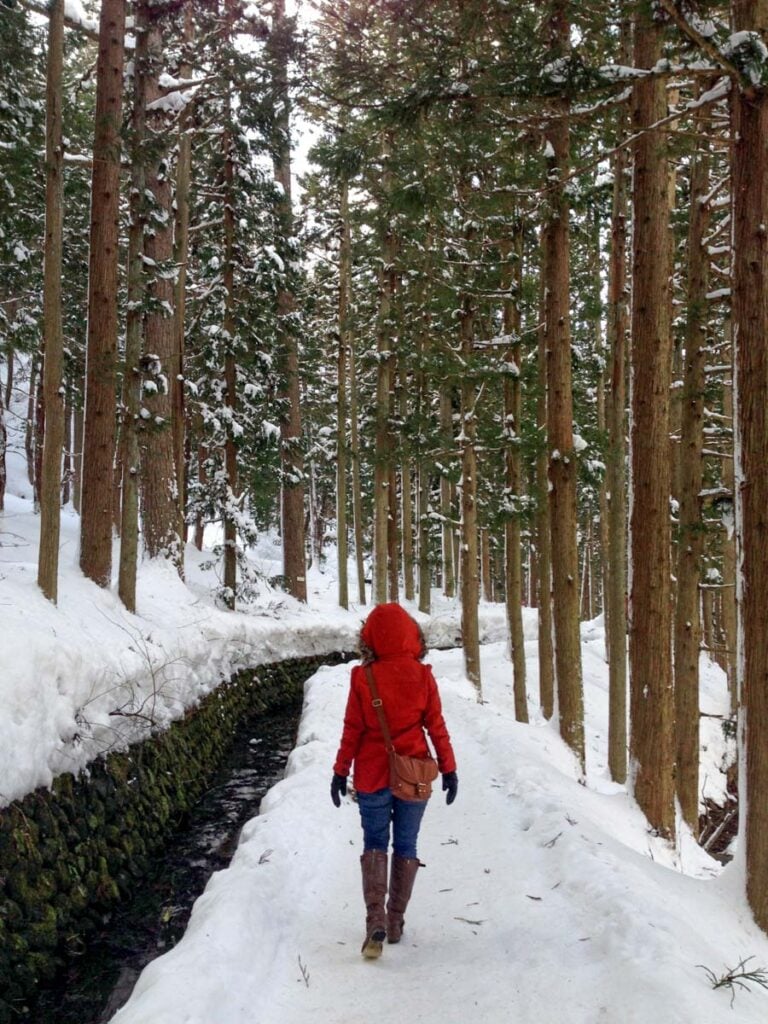
With powdery snow and plenty of things to do indoors and outside, Japan makes the perfect winter destination.
It might not be the first place you think of for a February getaway, but we’re going to explain why winter in Japan is magical. Plus, we’re going to share the best things to do in Japan in winter and which destinations to put on your itinerary!
Oh, and we’ll also answer that nagging question you’re already wondering: How cold will it actually get?!
Article contents
Reasons to visit japan in winter, winter weather in japan.
- Things to do in Japan in winter
- Best places to visit during winter in Japan
What to pack for winter in Japan

If you’re planning a trip to Japan, we have the ultimate resource for you!
This FREE PDF download includes everything you’re going to want to pack for your Japan trip, including what NOT to bring, plus tons of insider tips!
Sign up for our ultimate Japan packing list now and get a copy sent straight to your inbox.
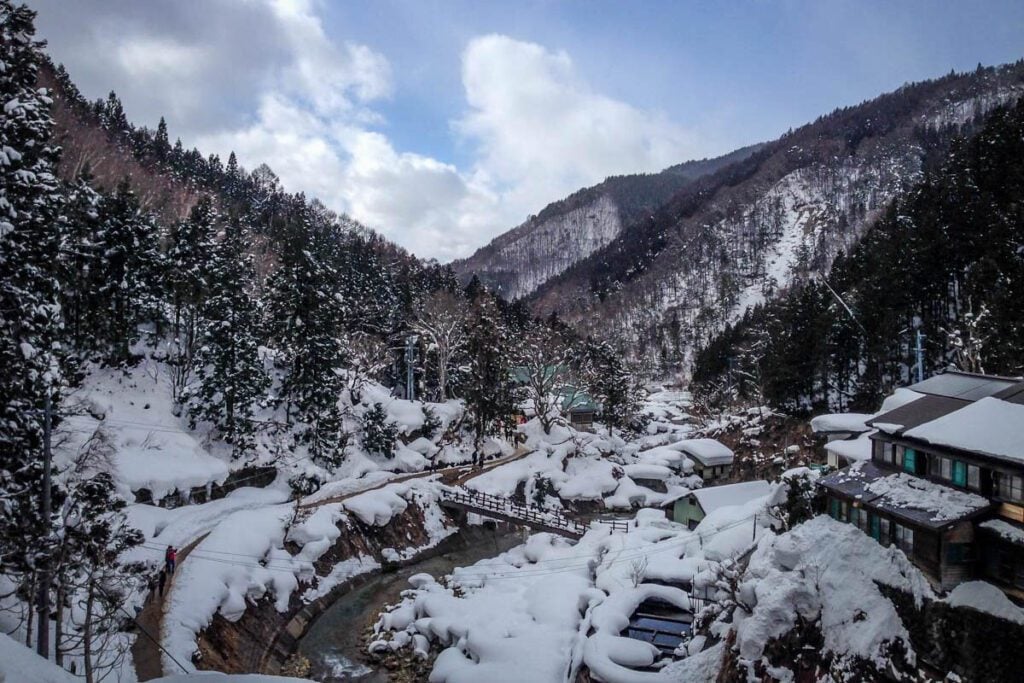
Winter vacation almost always conjures up images of sun-soaked beaches and palm trees blowing in the breeze. (And if that’s exactly what you’re after, check out our absolute favorite beach destination here !)
There’s no disputing the appeal of basking in the vitamin D (and vitamin SEA – see what I did there?!), but there is also something romantic and charming about a true winter holiday, snow and all!
So if you’re thinking of jetting off to a destination that’s a little different this winter season, keep reading…
I’m talking about walking through snow-dusted pine forests, slurping on piping hot soup in a cozy noodle shop, and soaking in natural hot springs while snowflakes melt on your eyelashes.
Sounds magical, right?
With an impromptu week of vacation from our teaching jobs in Korea , we booked a cheap flight to Japan and hoped that it would be a decent choice for a trip in early February.
Not only did the country exceed our expectations, but experiencing winter in Japan was even more magical than we could have hoped for. I may be going out on a limb, but I am pretty darn confident when I say that Japan makes for the perfect winter destination .

Each season in Japan has its draws , but winter in Japan is highly underrated.
Here’s our top 5 reasons winter in Japan makes a perfect snowy getaway, even if it is your first time in Japan .
1. Japan is less crowded in the winter
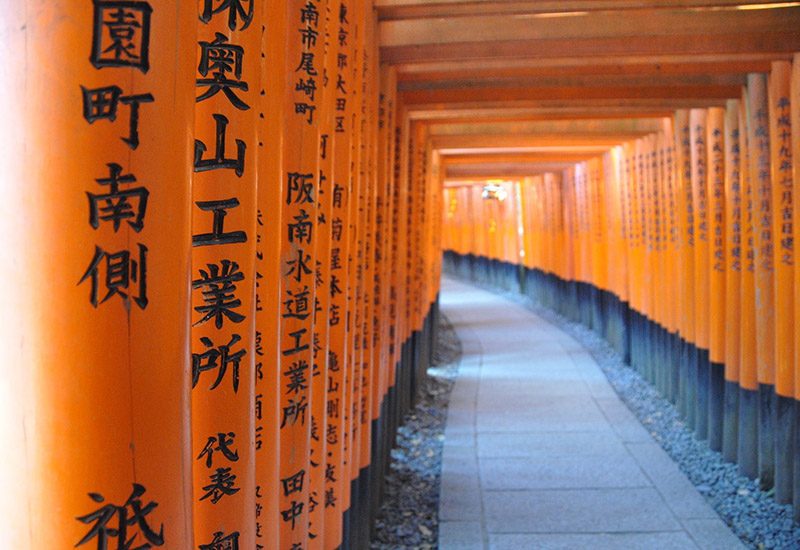
With more than 13.5 million people living in Tokyo alone, Japan is one of the most densely populated countries in the world.
The cherry blossoms in April bring in an estimated 63 million tourists each year and the already massive population swells to an obscene number, making it difficult (and expensive!) to book hotels and transportation .
Seeing the pastel flowers in full bloom would surely be an incredible experience, but those crowds may just drive you mad. You’ll likely have to fight through selfie sticks and wait hours for restaurants to clear out. Hotel prices skyrocket and booking last minute transportation can be near impossible.
Oh, and imagine exploring the highest populated city in the world (aka Tokyo), rubbing shoulders with passersby in the sweltering heat of summer.
If you visit when the crowds are fewer and the temperatures cooler, you won’t have to deal with all-day armpit sweat. This is a huge perk, folks.
You’ll be able to spend a few days in Kyoto or Tokyo without the crowds you’ll find at other times of the year. Trust us, traveling Japan during the less crowded winter season definitely has its benefits.
2. Prices are cheaper in the wintertime
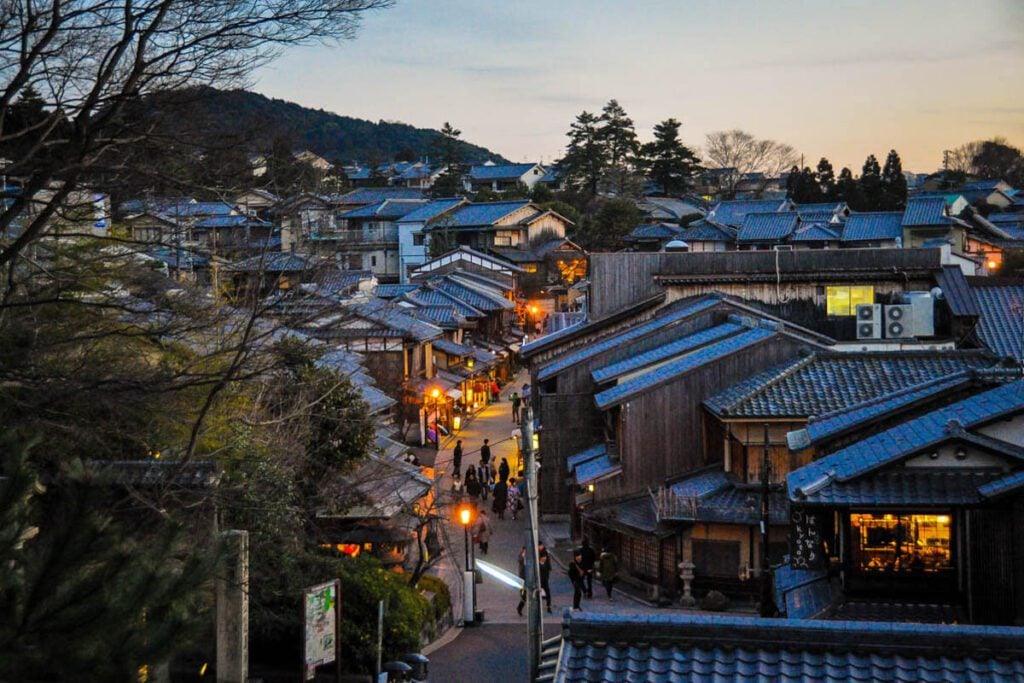
Since fewer people are visiting Japan during the wintertime, prices of hotel rooms tend to drop to reflect this. So if you’re looking to travel to Japan on a budget , winter is a great time to visit this notoriously expensive destination.
Note: One exception to this rule is around New Years, which is a popular time for Japanese people to take off and travel around the country.
3. There are many things to do in Japan in the winter
There are actually a ton of winter activities in Japan that you can’t do any other time of year (like skiing). Also, there are things to do that are simply not as enjoyable during warmer months (like soaking in a hot spring).
Below, we’re going over some of the best things to do in Japan during the winter months, so keep reading!
4. Winter in Japan is beautiful
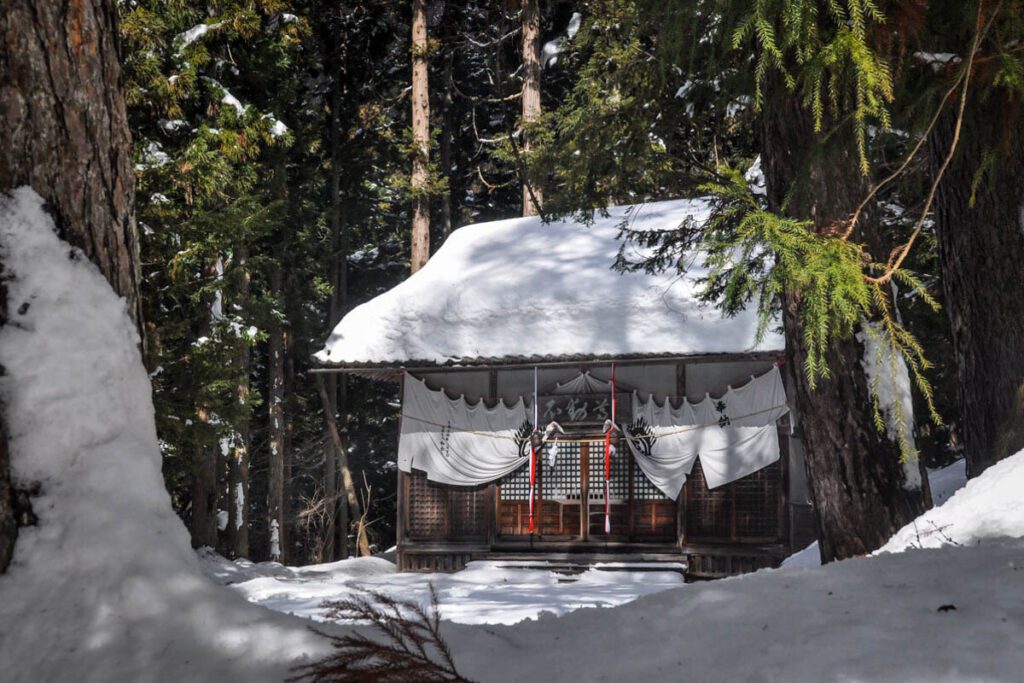
Snow-capped trees and quaint towns freshly blanketed in snow. Winter in Japan can look straight out of a fairytale… I mean you just can’t argue the beauty you’ll find in Japan during the winter months.
If you are a photographer, you’ll be pleased to find some of the most iconic places in the country have a unique look during the wintertime.
Psst! Check out our list of the most beautiful places in Japan you’ll have to see to believe!
5. Japan’s winter temperatures are pretty mild
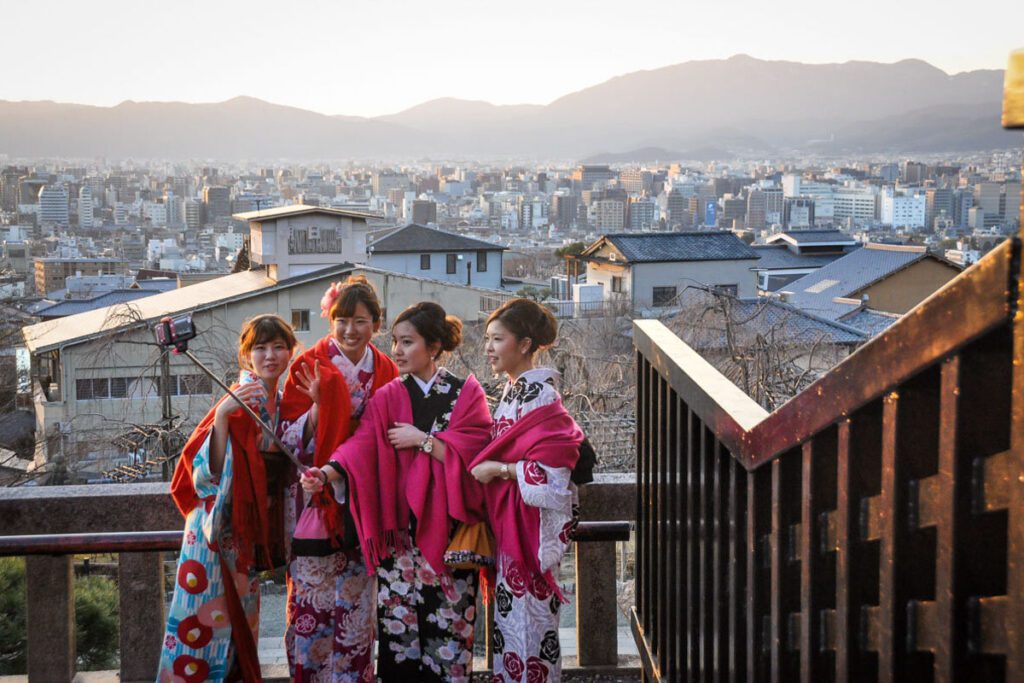
When I think of winter, I think of back home in Minnesota where we have huge mounds of snow, black ice on the roads, and weather forecasts of -10°F (-20°C). But that’s not at all the case for winter in Japan.
We traveled there in the dead of winter – beginning of February – and it got cold enough to snow in the mountains, but it didn’t stick to the ground. In the cities, the temperatures hovered between 40-50°F (5-10°C), so we were comfortable with just a light jacket outside.
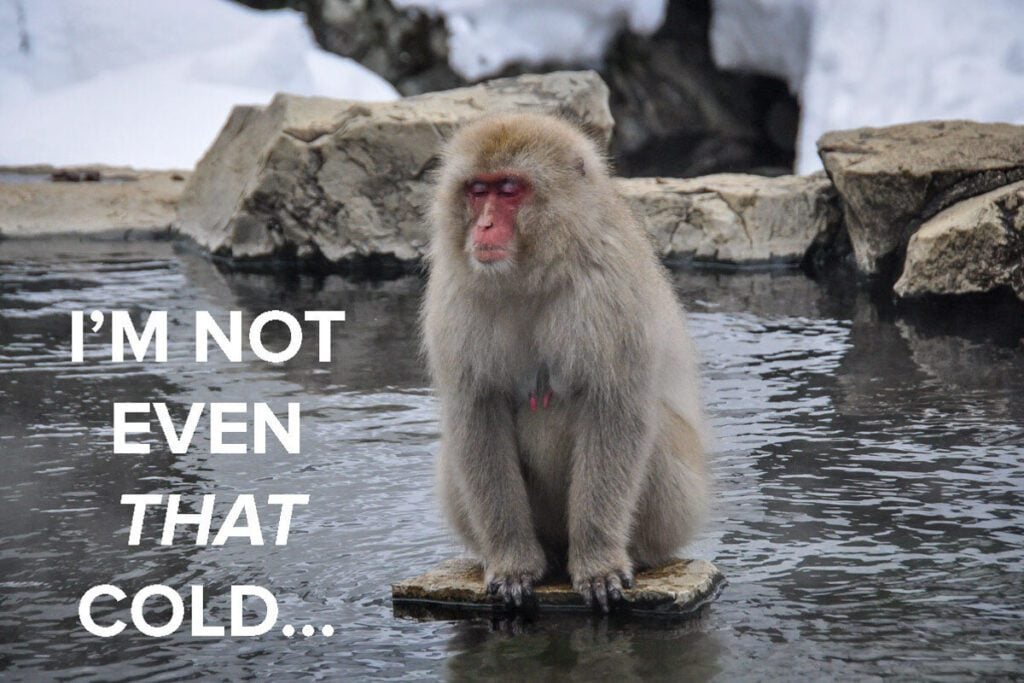
So how cold does it actually get?
Well, that question has more than one answer. You see, Japan spans more than 1,800 miles (3,000+ km) north to south, so the climate and average temperatures vary quite a bit.
Here are some average winter temperatures for the month of January (usually the coldest month):
- Sapporo: High 31°F / Low 18°F (0°C/-8°C)
- Nagano: High 38°F / Low 23°F (3°C/-5°C)
- Tokyo: High 50°F / Low 35°F (10°C/2°C)
- Kyoto: High 48°F / Low 33°F 9°C/1°C)
- Osaka: High 49°F / Low 35°F (9°C/2°C)
- Hiroshima: High 49°F / Low 34°F (9°C/1°C)
- Okinawa: High 66°F / Low 57°F (19°C/14°C)
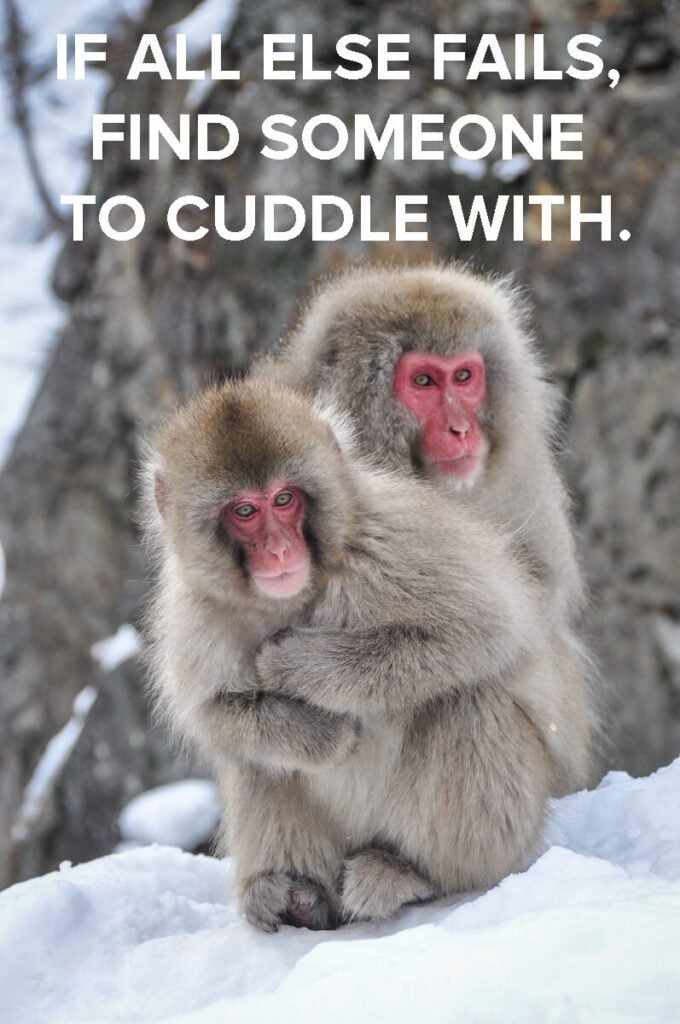
It’s worth noting that as you get higher in elevation, you’ll experience more snow and colder temps. And as you get closer to the ocean, you’ll rarely find snow that sticks for very long.
Let’s just say that if you have winters at home, Japan won’t be too much different than what you’re used to. And if you’re from an ultra cold place (like us Minnesotans!), Japan’s winter will feel pretty darn mild, especially in the major cities and in the southern part of the country.
Things to Do in Japan in winter
There are plenty of things to do in Japan during the winter. Some of these activities can’t be replicated during any other time of the year, making the winter extra special!
1. See the famous snow monkeys
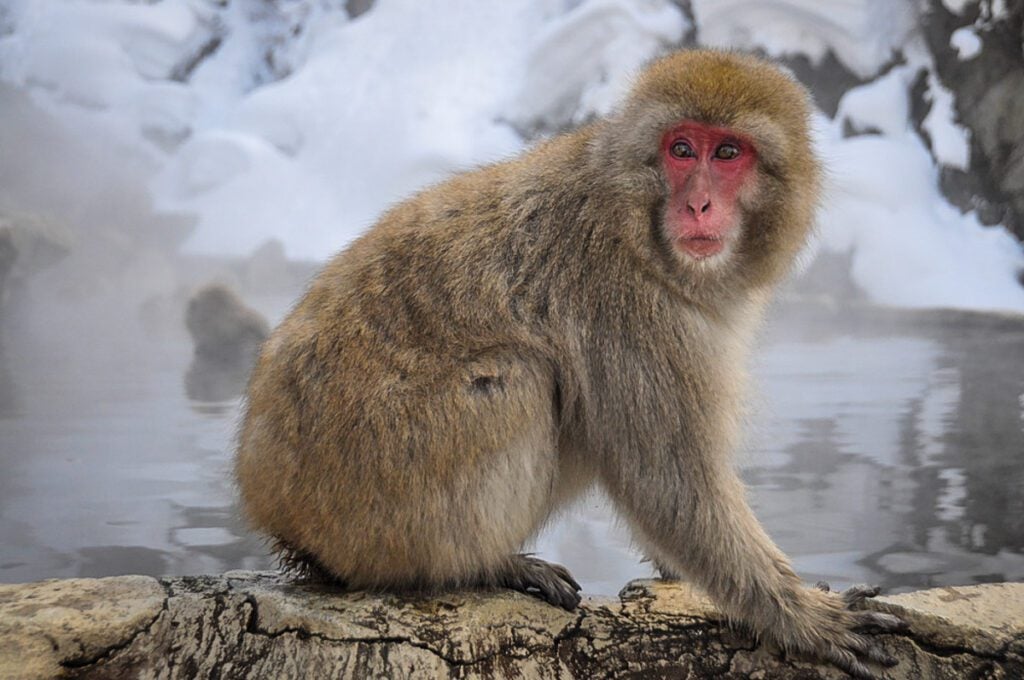
If you’ve Googled “winter in Japan,” you’re almost guaranteed to see pictures of the famous snow monkeys of Jigokudani Monkey Park. They appear to be peacefully soaking in their very own onsen (or natural hot tub) and are sprinkled with flecks of snow.
Well, this is one attraction that looks just like the pictures. And sure, you could visit the macaque monkeys in the summer, but they’re nicknamed “snow” monkeys for a reason. Just another reason to the Land of the Rising Sun in the winter months!
When we arrived to the trail entrance in early February, the park was an absolute dream. Snow covered the ground and fluttered lazily from the sky as we walked through a pine forest and past a babbling stream. It was pure magic.
When we actually entered the park, the monkeys strolled alongside us, almost asking to be photographed. The best part was seeing them splash in the water as the young ones played tag with each other and the elders relaxed their old bones.
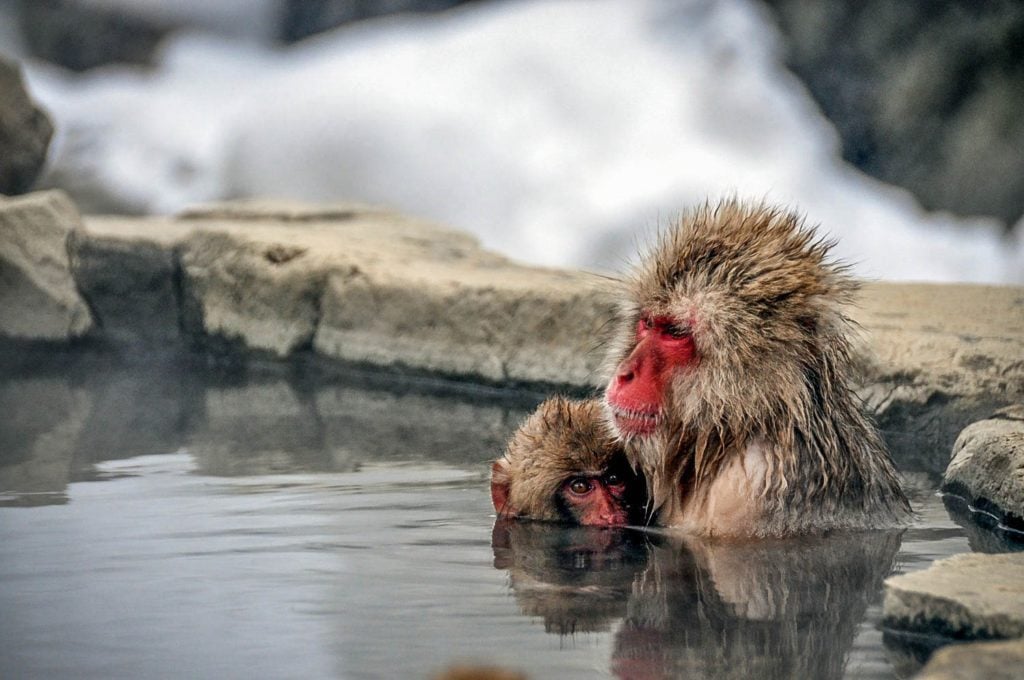
Do it yourself: From Tokyo, take the JR Hokuriku Shinkansen to Nagano Station (fastest 85 minutes). Then hop on the Nagano Dentetsu Line Limited Express train to Yudanaka Station (38 minutes).
From there take a local bus to Kanbayashi Onsen bus stop (15 minutes). Then walk through the snowy forest (wear proper shoes) for about 35 minutes, and you’ll arrive to at Jigokudani Monkey Park.
Budget Tip: If you are going to be visiting more places than just Tokyo and Nagano, it will be significantly cheaper to buy a JR Rail Pass. Find out how to book your JR Rail Pass before you arrive in Japan to save money on transportation!
Responsible Travel Tip: Please, please, please don’t feed these wild animals. They are fed by the park reserve to keep them healthy, but they can be very aggressive around any other food. There were some, shall we say, stupid teenagers who ignored the signs and brought a bunch of bananas and video cameras. Well, the result was not a pretty one and ended with blood speckling the snow. For more anecdotes and information on animal tourism, we’ve got the article just for you!
2. Go skiing in Japan
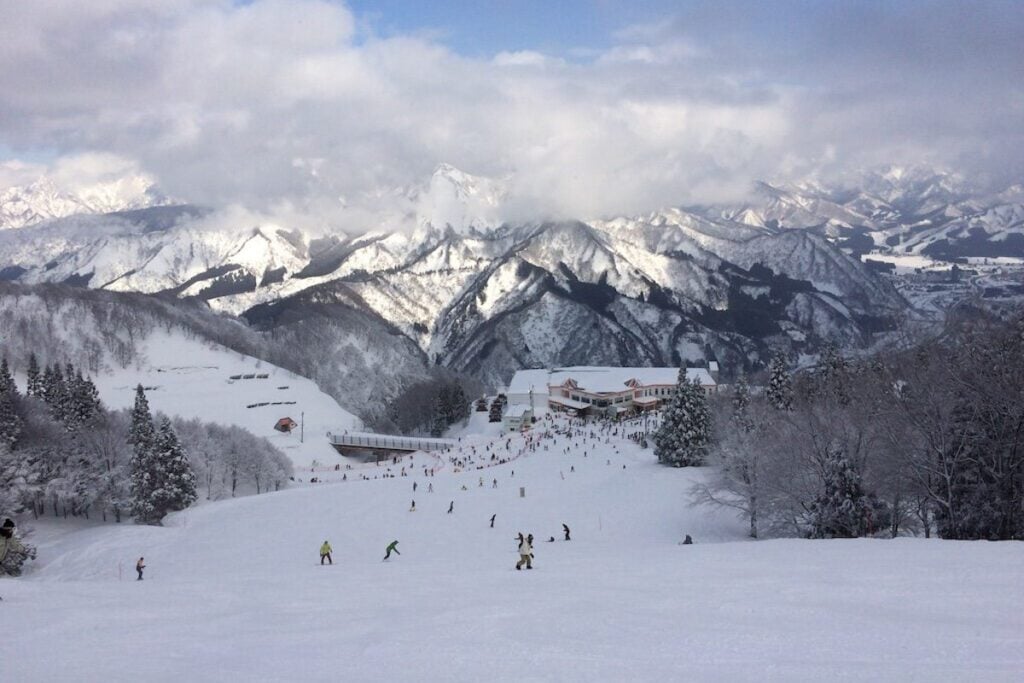
Did you know that Japan boasts some of the best skiing and snowboarding in the world?! With more than 500 resorts sprinkled throughout a country that is smaller than California, you really don’t have to go far to find good – no, GREAT – slopes.
Some of the better mountains are in the northern regions like Hokkaido and Tohoku, but we have been told it’s pretty killer, man all over Japan.
We’ve met some people who are ski instructors during the winter in Japan and when the season closes there, they travel south to Australia to start their season all over again for their winter. Pretty sweet gig, for any snow-lovers!
Read next: We’ve rounded up all the things Japan is most famous for in a guide that’s also packed with practical travel tips. Plus, we’re sharing a few things we personally think Japan should be famous for, but most foreign tourists are surprised to know.
3. Stay in a cozy Japanese inn
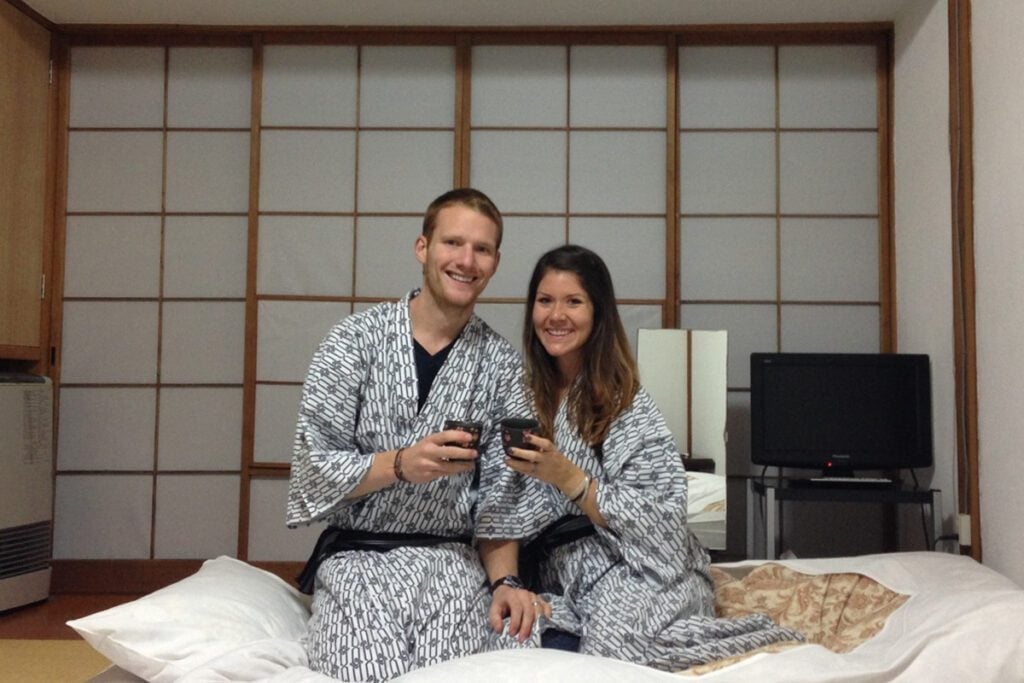
Staying in a ryokan is an experience that should be on every travelers Japan bucket list , but we can’t think of a much more cozy and romantic time to stay in a ryokan than during the winter months.
Cuddle up on your traditional futon mattress and enjoy the impeccable hospitality and food that ryokans are generally known for.
4. Soak in an onsen
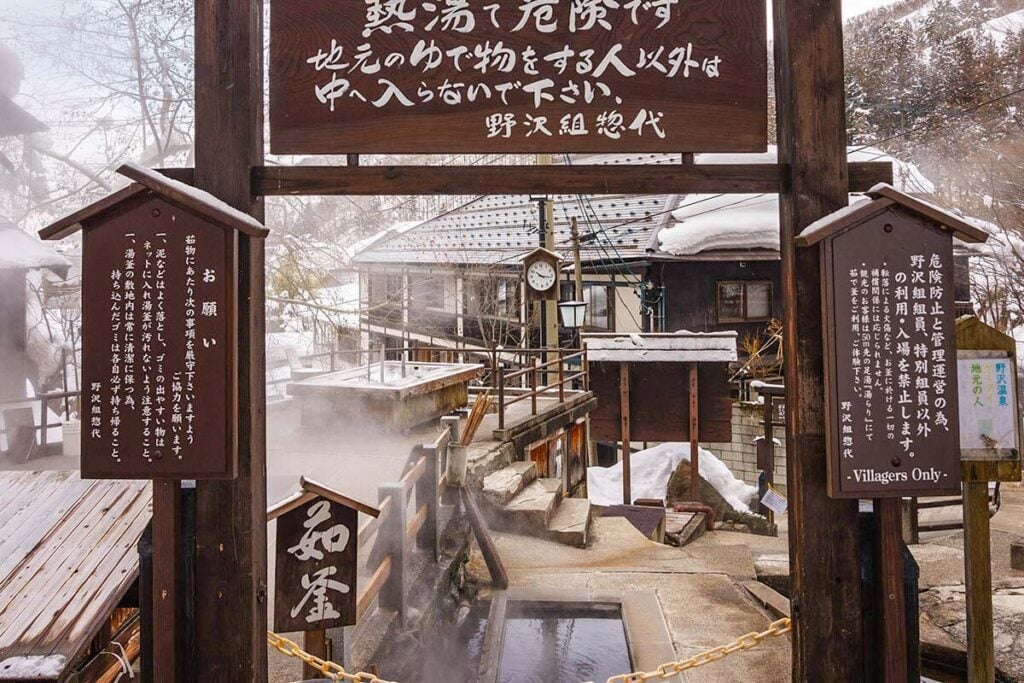
Picture yourself soaking in a toasty pool of water under the stars. Steam billows up from the water as snowflakes kiss your shoulders. Sounds pretty magical, right?
Oh, and I forgot one detail: you’re naked. Don’t worry – it’s not as scary as it sounds. We jumped right in and got used to them in Korea, and found them to be pretty freeing actually.
Onsens are Japanese bathhouses that were once used as peoples’ main source of getting clean. But today, most onsens have morphed into a relaxing, spa-like experience.
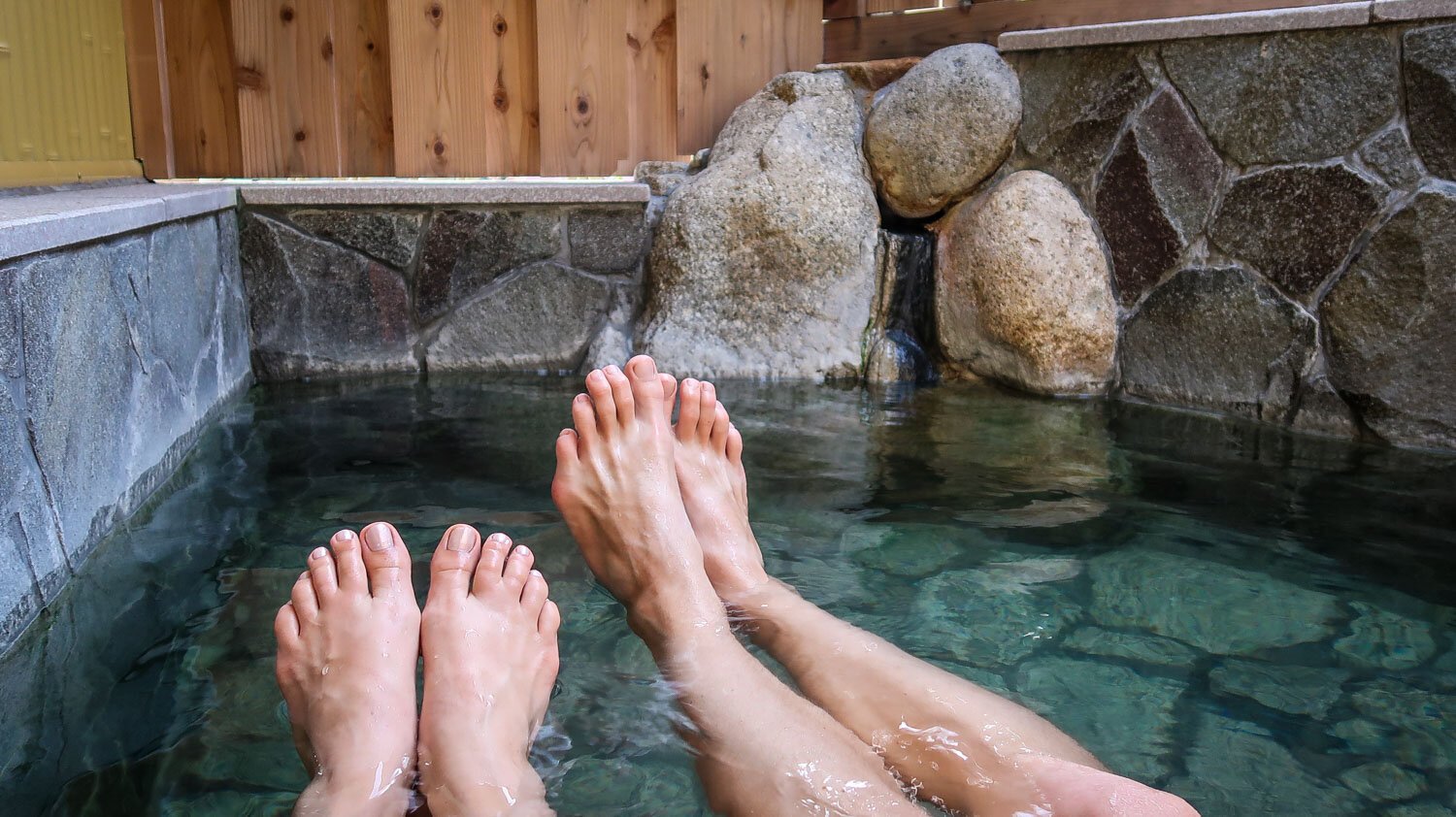
Though you can visit these bathhouses year-round, you probably wouldn’t want to be submerged in steamy waters on a hot and sticky day in the summer months. In the wintertime, however, there are few things that sound better.
There are onsens all around the country, and there are entire towns built around these hot springs. Prices vary depending on the view and the services offered.
If you’re seeking luxury, Hotel Green Plaza Hakone is known for having a fantastic view of iconic Mount Fuji and can make a great day trip from Tokyo . And if you’re looking for a budget option, book a guesthouse that has an onsite onsen. Often times in these cases they are private, so if you’re traveling as a couple, you and your partner can soak together.
5. Glimpse snowy Mount Fuji (or try to!)
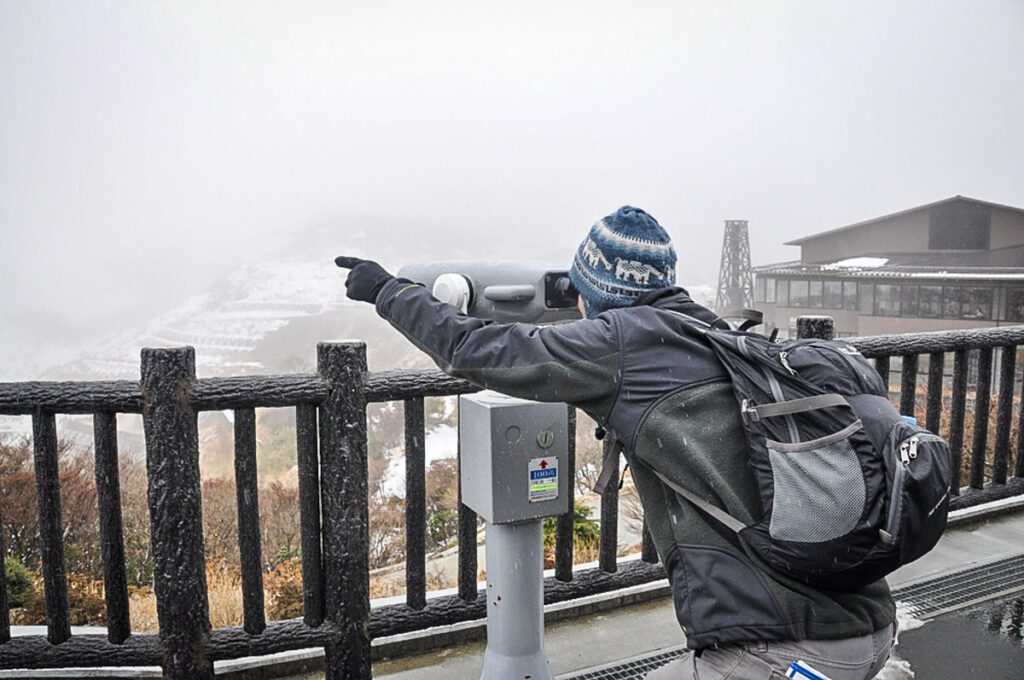
Oh, elusive Mount Fuji… She is a shy mountain who likes to hide behind clouds. But when she does show her face, oh boy, you’re in for a treat. If you’ve read our 1-week in Japan itinerary , you’ll know that we sadly reached her base on a day she wasn’t feeling so sociable. That b*tch.
The thing that really stung was our time in Japan was limited so we couldn’t stay an extra day. And it was on that day that the clouds parted and Mount Fuji’s peak was glistening in all her glory, I’m sure. It seems to always happens like that, doesn’t it?
The winter is a great time to see Mount Fuji because no other time of the year will she be sprinkled with a shiny white cap. When we go back to Japan, I want to return again in the winter with hopes to see her snowy peak.
But even if you can’t glimpse the iconic mountain, the small nearby towns in the Hakone region are surrounded by pine tree forests that are especially picturesque when dusted with glistening snow. Oh, and as I mentioned above (#1), the onsens are reason enough to make a trip to the Hakone region.
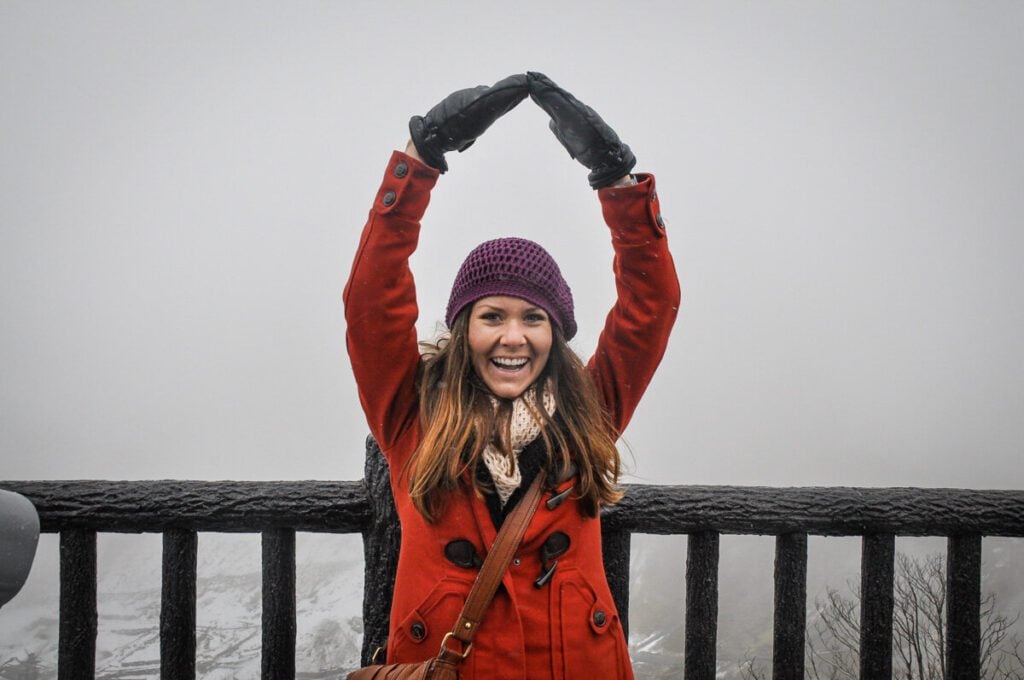
Do it yourself: The JR station nearest the Hakone region is Odawara Station. Thankfully, with the JR Pass , Tokyo to Odawara is just a short 70-minute free trip. However, to enter the Hakone region, you have to purchase the Hakone Free Pass, because there are no JR lines with the region.
The Hakone Free Pass is the most cost-effective package that includes all bus tickets in the area, a (super touristy but kind of fun) pirate ship ride, and a gondola ticket that brings you up close and personal with the famous mountain. We lay it all out in our Mount Fuji day trip guide !
If you’re traveling Japan on a budget , we’d recommend staying at Fuji Hakone Guesthouse , which is a traditional ryokan-style accommodation with a private onsen. We stayed there and had a great experience.
If your budget allows, check out these two gorgeous hotels with magical-looking onsens:
- Hotel Green Plaza Hakone
- Hakone Ashinoko Hanaori
And if you stay at either, let us know about your experience!
6. Eat ALL the ramen!
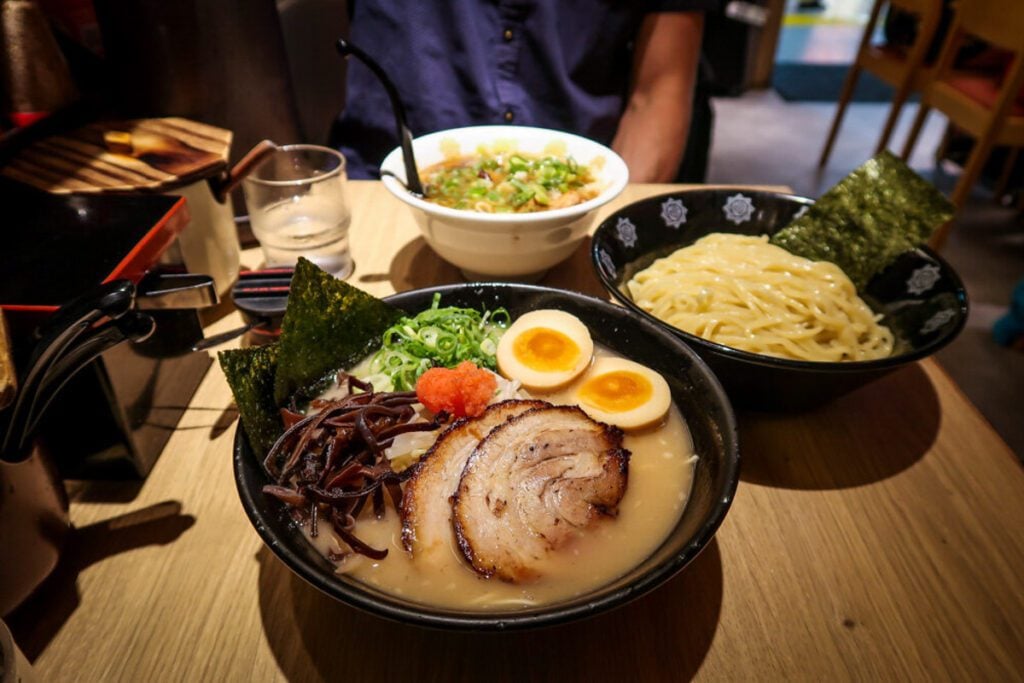
There is nothing better than escaping frigid temps than entering a cozy noodle shop and being welcomed by steaming hot pots and glorious smells. Oh, the smells.
Everyone in the place will be belly up to the noodle bar, faces hovering over a sweltering bowl of steamy deliciousness. Join them and slurp up your new favorite wintertime dish.
Visiting a noodle shop (or twenty!) is a must when in Japan. Ramen is one of our favorite Japanese dishes , but honestly, it’s just not quite as satisfying eating it during the warmer parts of the year. So if you’re traveling to Japan in the winter, be sure to get your fill. It’ll warm your tummy, your heart and your Rudolph nose!
Fun fact: slurping your noodle soup is considered polite in Japan, so go for it!
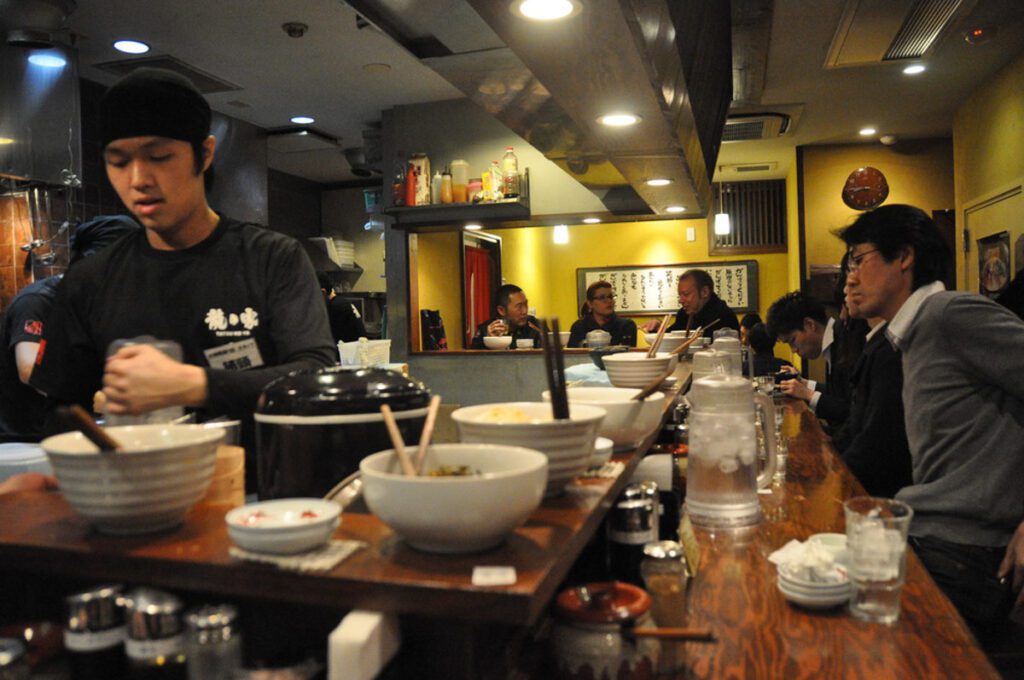
Do it yourself: This is an easy one. Enter a shop. Order soup. Eat. Well, actually it can be a bit more complicated. In some areas of Tokyo for instance, there are no noodle shops for blocks and blocks, while other streets are teeming with so many that it’s a daunting task to choose one.
For starters, check out this article that explains some of the best noodle shops in Tokyo – it does a great job of breaking down the atmosphere and specialties offered at each restaurant.
The other tricky part of this is that at some shops you’ll have to order your soup from a vending machine. You might have to decipher the menu by looking at the picture on the buttons (or ask someone friendly to help), inserting your yen, tapping your choice, and boom – it will print your receipt. Hand the receipt to a worker, find a seat and in less than 5 minutes you’ll have your steaming bowl of piping hot noodle soup.
7. Experience the Sapporo Snow Festival
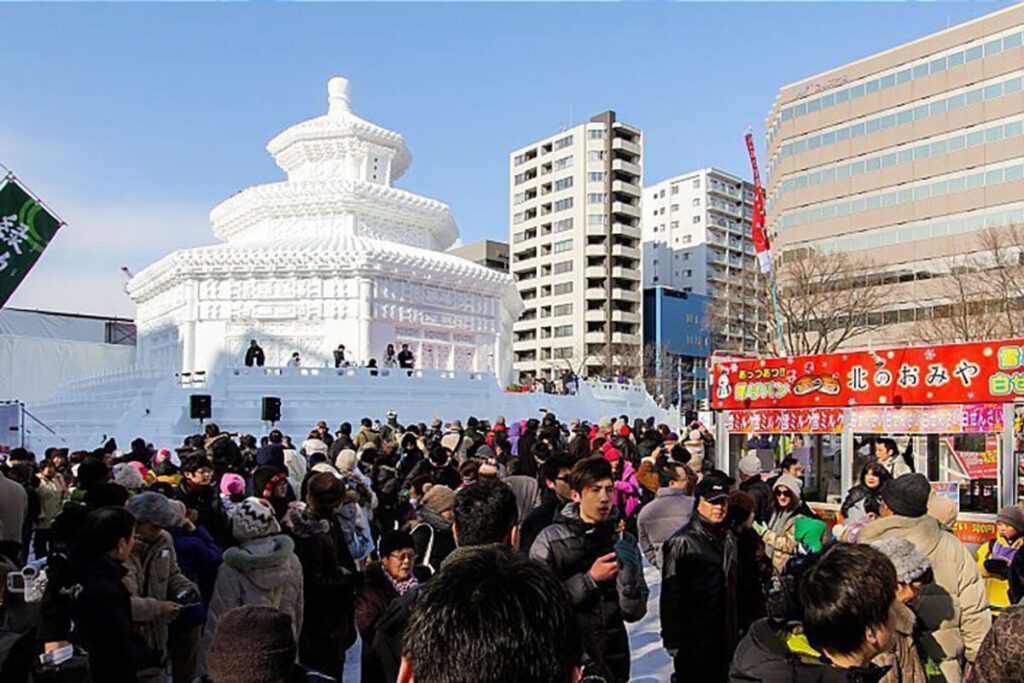
We literally missed this festival by 2 days. TWO DAYS.
If you followed our journey while we were teaching in South Korea, you know that vacation days are not very flexible, and the fact that we got an entire week off after already taking a 17-day trip to the Philippines is really rare. We felt pretty lucky and decided not to push our luck.
But I have rambled… My point is that the Sapporo Snow Festival, which takes place annually, usually in the beginning of February, looks so cool (literally!) , we may just have to make a trip back to Japan in the winter specifically for this festival.
Taking place in the northern island of Hokkaido, snow and ice sculptures consume more than 1.5 kilometers of a busy downtown parkway. Festival lights turn on soon after dark and you can enjoy the ice slides, international food stalls, ice skating rink and, of course, giant snow murals!
If you’re lucky enough to be in Japan for this festival OHMYGOSH we would be SO jealous! Please tell us about it.
Insider Tip: If your timing works out, go to the nearby Otaru Snow Light festival too. It’s not far from Sapporo, and typically overlaps with the final days of the Snow Festival.
Related: Want to know what else there is to do in Sapporo? Check out this 2-day Sapporo Travel Guide .
8. Warm up with a sake tasting
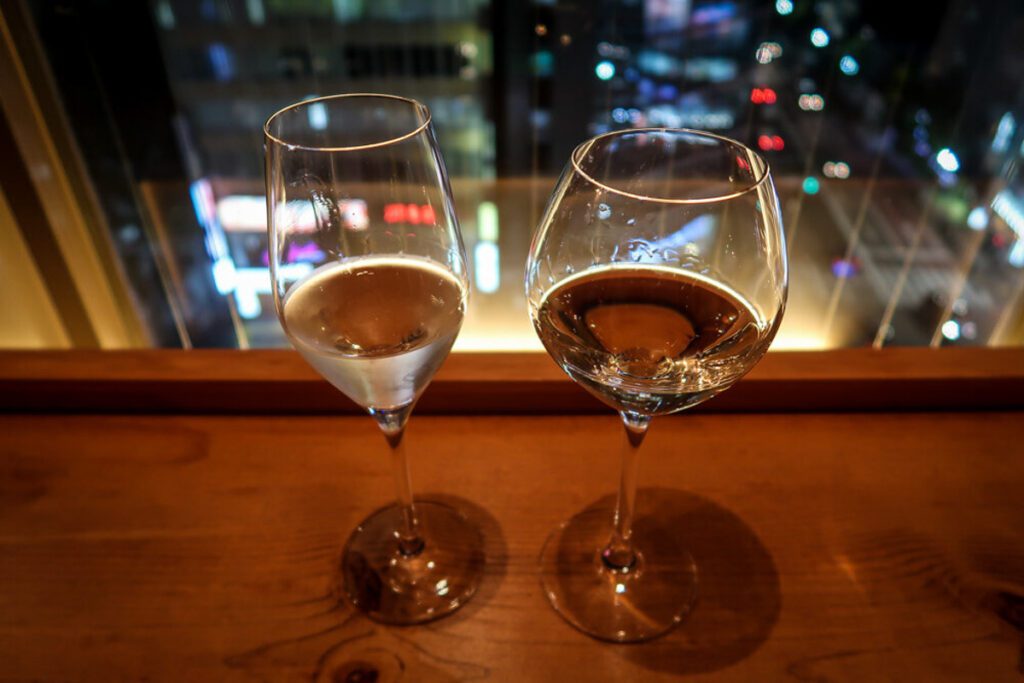
Second to ramen, we think doing a sake tasting is a pretty great way to warm up on a chilly winter day!
Whether you belly up to a bar in an izakaya , or you tour a sake distillery and learn all about Japanese rice wine, we think sake tasting makes a great wintertime activity.
Alternative: If you’re a whiskey fan, you’ll definitely want to try some during your trip. Japan is becoming increasingly well-known in the whiskey world!
9. Stroll through a Christmas Market
Not unlike Europe, Japan has its own tradition of putting on German-themed Christmas markets in the wintertime. Imagine strolling the streets lined with shops, mulled wine or hot chocolate in hand as Christmas music hums in the background. Sounds pretty magical, right?
If you are visiting Japan in the weeks leading up to Christmas (primarily during the month of December), you can take the opportunity to visit one of these festive markets and see for yourself.
Some of the top Christmas Markets to check out in Japan are:
- Tokyo Christmas Market in Hibiya Park
- Roppongi Hills Christmas Market
- Tokyo Skytree Town Christmas Market
- Yokohama Red Brick Warehouse Christmas Market
- Kobe Christmas Market
- Christmas Market in Nakanoshima
- Marunouchi Nakadori Avenue Market
10. Enjoy all sorts of indoor activities
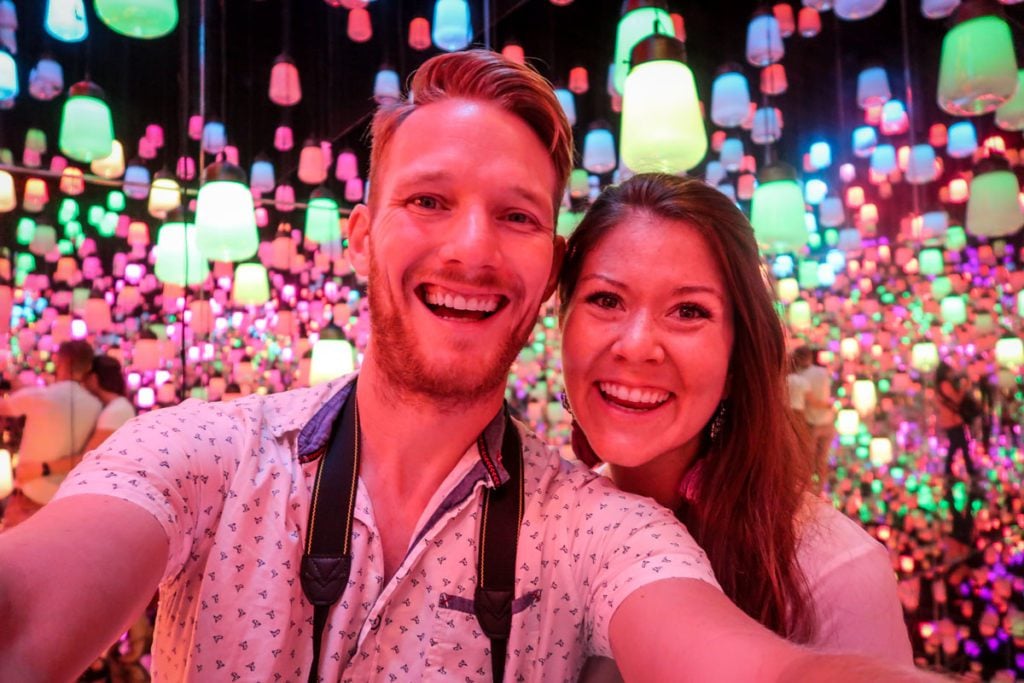
Japan has a ton of indoor activities, so even if you’re not a fan of the cooler temps, you’ll still be able to find quite a few things to do in Japan during the winter.
Here are some great indoor activities in Japan:
- Explore the wildly beautiful teamLab Borderless Digital Art Museum in Tokyo (pictured above)
- Sing the night away in a Karaoke room
- Take crazy pictures in a purikura (Japanese photo booth)
- Explore fish markets, like Toyosu Market in Tokyo
- Experience a Japanese arcade and play pachinko
- Take a Japanese cooking class
- Sample small dishes and drinks at an izakaya (Japanese pub)
- Attend a Japanese Tea Ceremony
- Go on a food tour
- Go shopping for Japanese souvenirs
- Check out a theme cafe or restaurant
Best places to visit in Japan during winter
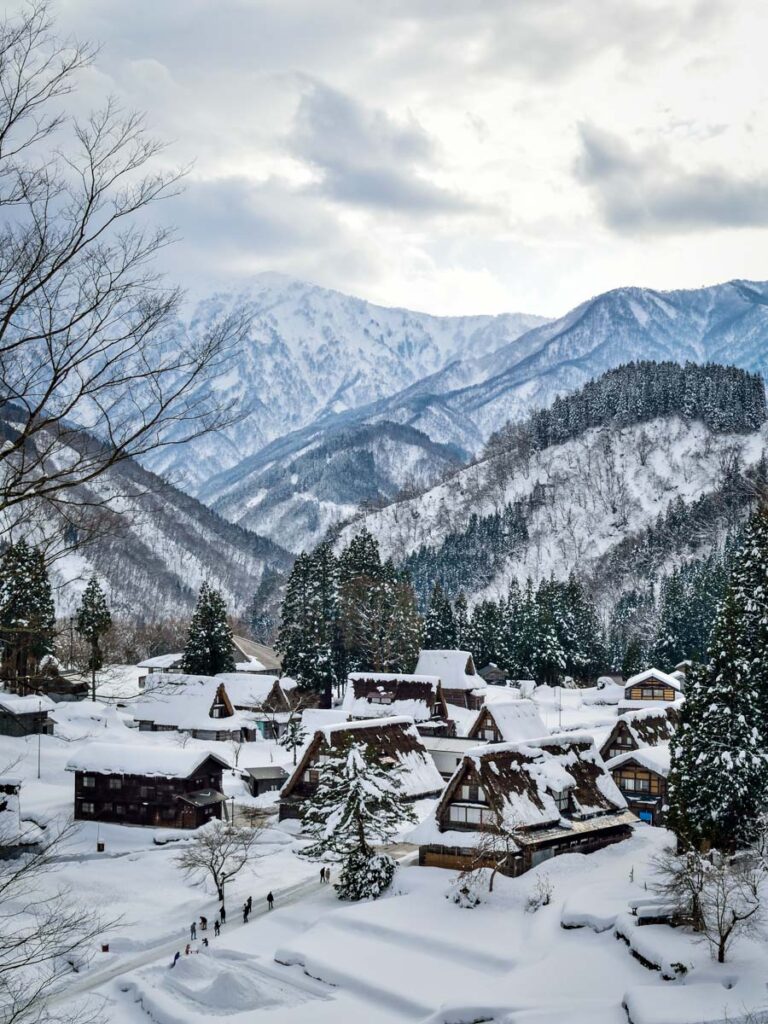
- Traditional villages like Shirakawago , Hida, and Gokayama (pictured above) : While they are picturesque during the entire year, they are especially beautiful when the traditional houses are blanketed in a fresh layer of snow and flanked by white-tipped pines.
- Sapporo: Home to the famed Snow Festival, Sapporo is a wonderful place to put on your winter itinerary, especially if your travel dates overlap with the festival. We’d also say that if you make it up to Sapporo, you might as well explore a bit more of Hokkaido!
- Nagano: Known as the host of the 1998 Winter Olympics, Nagano is home to great skiing, nearby charming mountain villages, and the famous “snow monkeys”.
- Our recommendation: We stayed at the Auberge Hidanomori hotel in Takayama during the summertime and had a fantastic stay. We think it would be even better during the winter months.
- Nozawa Onsen: This picturesque town is built around hot springs, so you’ll find all sorts of onsens to soak in. There is also skiing nearby.
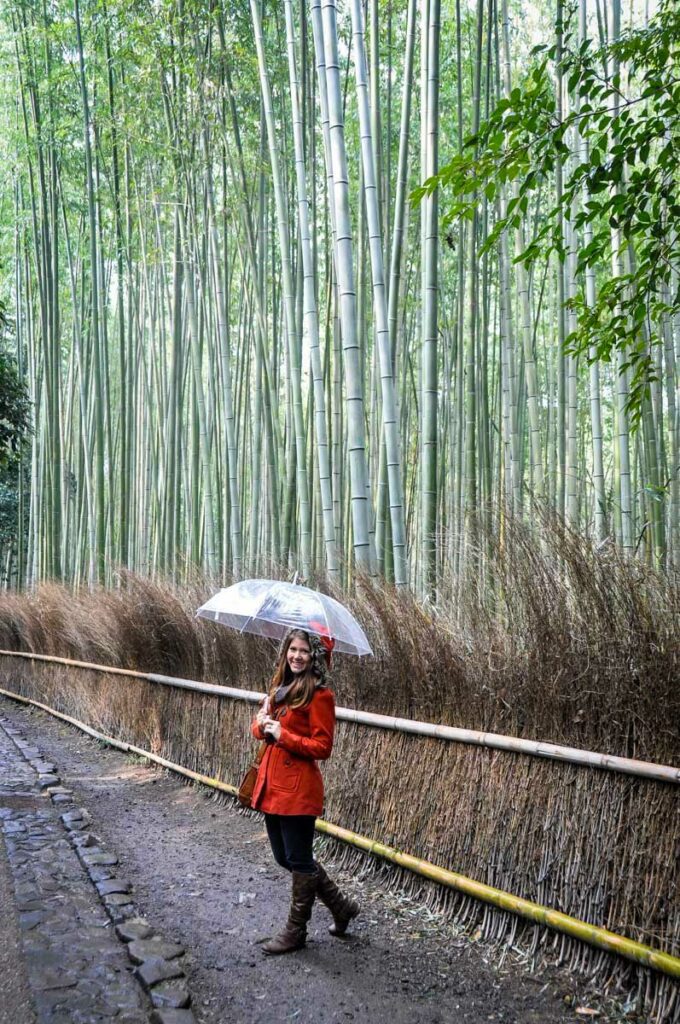
If you are traveling during the winter months, you’ll need to pack a little differently than you would during other times of the year.
We have a guide where we break down exactly what to wear during winter in Japan (for both women and men!), but here are some essentials:
- mid-weight coat for walking around the cities
- comfortable and warm boots/shoes for walking
Do you plan to do outdoor activities, like skiing?
Then you’ll want to add these items to your list:
- waterproof winter jacket
- waterproof gloves
- waterproof boots
- ski goggles
- any other ski equipment you don’t want to rent
Tip: Hand warmers are a big thing in Japan, so you can buy a bunch when you arrive to keep your hands and feet warm!
Hold up! We created a whole guide to all the things you need to pack for Japan (in addition to clothes!). Plus, we even have a (totally free!) packing list you can download !
This FREE PDF download includes everything you’re going to want to pack for your Japan trip, including what NOT to bring, plus tons of insider tips!
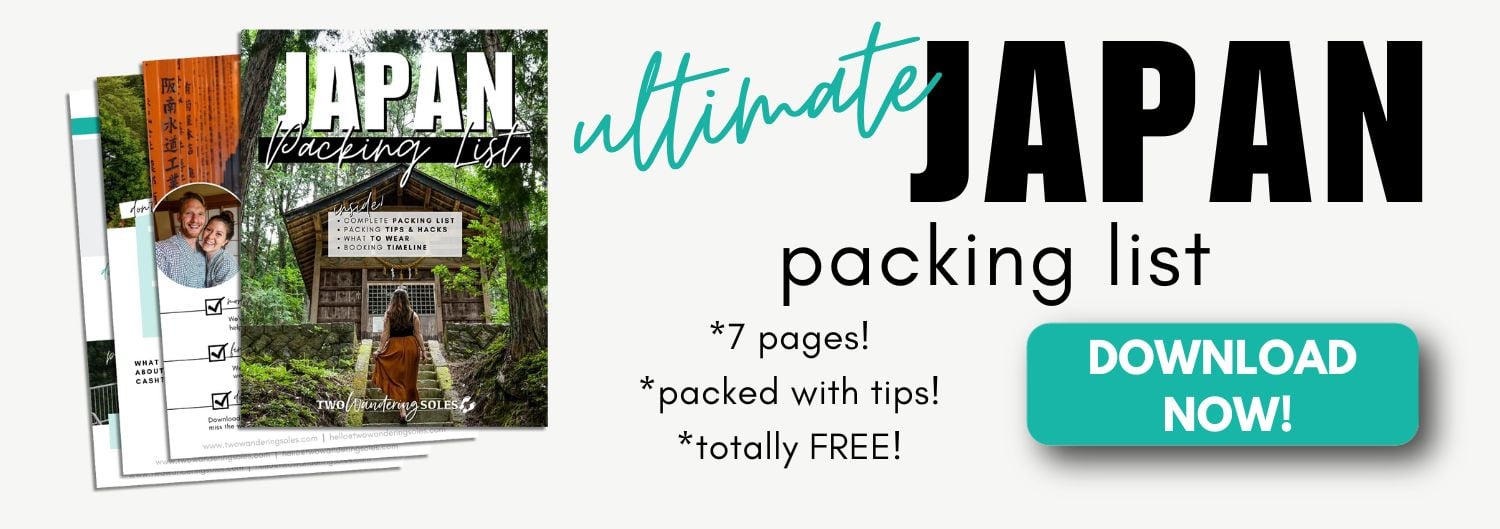
Still not convinced winter is a good time to visit Japan?
I suppose I can understand. I mean, not everyone is built like us Minnesotans to withstand cold weather! And if you’re still not keen after reading about all the things to do in Japan during the winter, then you might enjoy this country more at a different time of year.
Lucky for you, we’ve broken down all the seasons in Japan so you can choose the best time of year to visit, based on your personal travel style.
Japan travel tips & resources
Want more Japan tips, itineraries, budgets and resources?
We have TONS of resources on travel in Japan and destinations throughout the country. Check out our Ultimate Japan Travel Guide for all the answers to your most burning questions, or read some of our favorite articles below.
If you’re planning a trip to Japan, be sure to check out our other resources.
- First things first: we’ve created the ultimate guide to traveling in Japan , which is packed with everything you need to know for your first visit.
- We also have a complete 1-week itinerary , so the only planning you have to do is booking your flight!
- Plus, we’ve shared the breakdown of our budget and our favorite must do experiences in Japan.
- Are you a foodie? Then you can’t miss our list of foods to try in Japan !
- And don’t forget to read up on the Japan Rail Pass and how to book yours before your trip.
We loved Japan and would like nothing better than to help you plan your trip there!
Save this article on Pinterest for later!
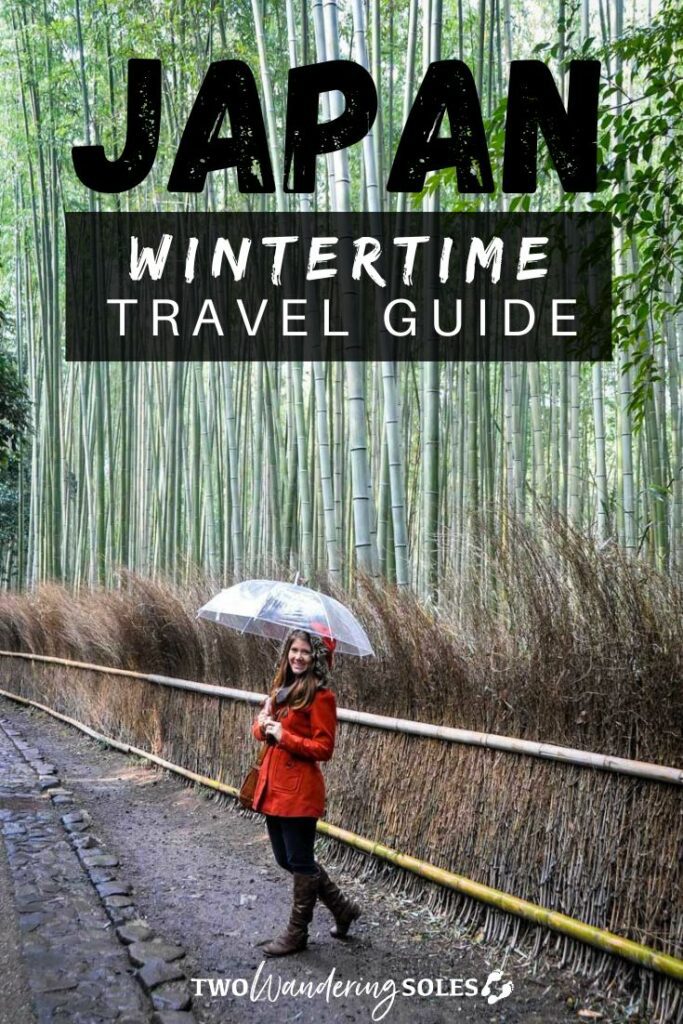
We want to hear from you!
Have you ever traveled to Japan in the winter?
Do you want to travel to Japan in the winter? What is your favorite season in Japan? Let us know in the comments below!
Leave a Reply Cancel reply
Your email address will not be published. Required fields are marked *
Save my name, email, and website in this browser for the next time I comment.

Japan Winter Itinerary – Activities, Destinations, and Trip Ideas!

If you’re wondering whether winter is the best time to visit Japan, then worry not! Japan has four distinct seasons, each with its own unique set of seasonal activities, places to visit, and different cuisines, making it a wonderful time of year to travel. Personally, I prefer the Japan winter season to the summer months, which are stiflingly hot and humid, making any kind of outdoor activity unbearable.
Winter in Japan has plenty to offer visitors, from the snow monkeys of Nagano to ice sculptures in Hokkaido. Japan’s mountainous landscapes mean its snowy peaks are heaven for winter sports enthusiasts, whilst illumination events around the country are popular with families and couples. Read on to discover what to do in Japan in winter using this 14 day Japan winter itinerary!
Have you been to Japan during the winter? What was your favorite activity? Let me know in the comments!
Are you planning a trip to Japan soon?
Check out my 4-day Tokyo itinerary, 5-day Tokyo itinerary , and 3-day Kyoto itinerary for first-time visitors. Also, don’t forget to download your free Kyoto Bucket List for 2024 .
Recommended 2 Weeks Japan Winter Itinerary
This is a sample of an ideal 2-week winter itinerary in Japan, but if you are visiting for a shorter period, you could also just select a couple of areas to travel to based on your interests. I’ve also included some ideas at the end for top winter destinations and activities for longer itineraries or if you want to switch out some of the suggested destinations below.
Domestic travel in Japan is super easy with an excellent public transport system and rail network, plenty of cheap domestic flights, and even night buses offering transport options to suit any budget.
- Days 1–2 Tokyo
- Days 3-4 Hakone/Mt Fuji
- Days 5-7 Hokkaido
- Days 8-10 Japanese Alps
- Days 11-12 Kyoto
- Days 13-14 Tokyo
This page contains affiliate links. If you choose to purchase after clicking a link, I may receive a commission at no extra cost to you .
Days 1-2 Discover Tokyo
Begin your Japan Winter Wonderland extravaganza with a short break in Japan’s capital city. Tokyo is so magical during the wintertime and has many beautiful Christmas displays, illuminations, and markets as well as all of the classic sights to try and squeeze in!
Tokyo Winter Itinerary – Day One

Spend your first day in Tokyo with some sightseeing, taking in the classic landmarks such as the Senso-ji Temple in Asakusa, one of Tokyo’s most famous temples and the oldest too. If you have time, take a guided rickshaw tour before you leave!
After visiting the temple, walk over to Tokyo Skytree where you can visit their annual Christmas market which usually runs from mid-November until December 25. Fill up on festive treats, see the tower light up, then go up to the top of the tower for epic views across the city!
Be sure to also check out Meiji Shrine and enjoy the peaceful gardens and ponds whilst strolling around. Unlike Senso-ji which is a Buddhist temple, this is a well-known Shinto shrine. Shinto is Japan’s ancient religion, so I think it’s interesting to visit both. Meiji Shrine is really close to Harajuku, Shibuya, and Omotesando which have plenty of attractions to occupy you for the rest of the day!
Shibuya also has a gorgeous winter light display, the Blue Cave illuminations, which sees around 800 meters of trees illuminated with approximately 600,000 lights to create a magical atmosphere. Over in nearby swanky Omotesando, the famous tree-lined shopping avenue is also covered with 900,000 golden lights to create a stunning display.
A little bit further afield but still worth the visit are the illuminations at Yomiuriland , a theme park in Tokyo whose attractions are decorated with millions of LED lights.
Tokyo Winter Itinerary – Day 2
Continue exploring Tokyo at your own pace and take in some special winter activities whilst you’re here like enjoying a Japanese winter dining experience, shopping for lucky bags, or experiencing a traditional new year.
Enjoy Japan’s Unique Winter Dishes

Much of Japan’s cuisine changes with the seasons and the arrival of winter marks the appearance of heart-warming dishes such as nabe , oden , and nikujaga . Nabe is a kind of Japanese hotpot usually filled with vegetables and meat or fish.
Eating nabe is a fun and social dining experience where friends gather to make the dish around a portable stove or meet in nabe restaurants. If you’re in Tokyo, you must try out a nabe party for yourself!
Oden can be purchased throughout Japan and is often sold in convenience stores during the winter, it consists of a light broth containing items including fishcakes, daikon radish, and boiled eggs. Nikujaga is a filling dish often cooked at home and is a kind of beef and potato stew, the perfect comfort food on a cold day.
Enhance your winter dining experience even further by getting cozy under a Japanese kotatsu, a low table with a built-in heater, covered by thick blankets that are impossible to leave once you’re under! Google ‘kotatsu dining Tokyo’ for a list of restaurants where you can have your own kotatsu experience!
Go Crazy for Japan’s Lucky Bags

Every winter in early January, people line up to buy fukubukuro, Japanese lucky bags. The idea is that you go to your favorite stores and buy a mystery bag that contains items that are heavily discounted. The only catch is that you can’t see what is inside the bag, so there is an element of luck involved as to whether you will like what’s inside. These kinds of bags are extremely popular, with many selling out within minutes of going on sale. If you are visiting Japan during this time, it’s a fun shopping experience to try. Whilst clothing brands sell some of the most popular lucky bags, other companies such as Starbucks also sell bags featuring items such as coffee beans, drinks vouchers, and mugs.
Experience a Japanese New Year

New Year in Japan is different from western countries, it is a time for families to get together and visit the local temple, eat traditional food known as osechi, and stay up to watch the first sunrise of the year.
It’s a time of reflection not partying, although you can still find western-style countdown parties in Tokyo too. One of the best places to spend New Year’s Eve near Tokyo is around Narita in Chiba , close to Tokyo’s Narita airport. This small town is buzzing on New Year’s Eve with lively restaurants and bars, whilst food stalls line the streets surrounding the Naritasan Shinsho-ji temple.
Days 3 & 4 Hakone Hot Springs and Majestic Mount Fuji

What could feel cozier than viewing Mt Fuji’s snow-capped peak from a traditional Japanese onsen (hot spring) on a crisp winter’s day? Depart Tokyo and head to Hakone for a couple of nights, an area famous for its abundance of hot springs, nature, and views of majestic Fuji-san.
If you’re planning to spend a couple of days exploring the area, then consider purchasing the Hakone free pass, a 2-day discounted pass which allows unlimited travel on eight different types of transportation in Hakone, including the sightseeing cruise and ropeway.
You’ll find an abundance of hot springs in the Hakone area, so be sure to take some time to do a bit of hot spring hopping in between your sightseeing! Even better, if the travel budget allows, stay in a Hakone ryokan with a private onsen so that you can really take some time to relax in your own exclusive space.
Ryokan Hakone Ginyu is a peaceful ryokan where every guest room features an outdoor hot spring bath with views over the Hakone mountains. The Hotel Green Plaza Hakone is close to attractions like the Hakone ropeway and features rooms with private open-air baths and Mount Fuji views.
Days 5-7 Explore Hokkaido, Japan’s Winter Wonderland

Head back to Tokyo and hop on a short flight to Hokkaido, Japan’s northernmost island and a haven for winter sports and activities.
Without a doubt, one of the best places to enjoy Japan in the winter is on the northernmost island of Hokkaido , which transforms into a stunning winter wonderland around December time as the snow starts to fall. The island offers something for everyone. If you’re looking for a city break, head to Sapporo and Hakodate to discover their Christmas markets and illuminations. The charming coastal city of Otaru is also a delight to experience during its annual festival in February, which sees thousands of candles light up the city and along the canal. Fans of winter sports can, go ice walking across Hokkaido’s famous partially frozen Lake Shikotsu or head to the slopes of Niseko, whilst nature fans can enjoy smelt fishing, canoeing, and snowshoe trekking through the Kushiro marshlands in a one-day winter tour .
Probably the most famous winter festival in Japan, the Sapporo Snow Festival is held every February for a week where visitors can admire jaw-droppingly impressive snow and ice sculptures among the many attractions.
Ice Hotel and Village
For something extra during your Hokkaido visit, check out the Hoshino Resort Tomamu which features a stunning ice village from mid-January to the end of February that you can visit with an ice bar, ice restaurant, and ice onsen!
Days 8-10 Explore the Japanese Alps
After your trip to Hokkaido, head back to Tokyo via a short domestic flight and explore the Japanese Alps in Nagano Prefecture or Gifu Prefectures. Jump on the bullet train in Tokyo and arrive at Nagano Station just 80 minutes later ready to continue your Japanese winter adventure!
Nagano: Hot Springs, Snow Monkeys, and Ski Resorts

From Nagano train station, travel for 45 minutes by JR trains to Yudanaka Onsen, the gateway to the Yamanouchi region, a popular tourist destination famous for its snow monkeys and the largest ski resort in Japan, Shiga Kogen which played host to the 1998 Nagano Winter Olympics.
Spend the night in a traditional ryokan and take a soak in the peaceful thermal baths whilst admiring the mountain views. After spending time with the snow monkeys or hitting the ski slopes, return to Nagoya Station.
Gifu Prefecture: Takayama and Shirakawa-go
Around a 4-hour train journey from Nagano Station, Takayama is a beautifully preserved traditional Japanese town nestled within the Hida Mountains which is ideal for an overnight stay and as a base to explore the area. Aside from exploring the old town, popular attractions here include the Hida Folk Village and the Shinhotaka Ropeway which transports visitors 2,200 meters above sea level to admire stunning mountain vistas via cable car all year round.
A popular side-trip from Takayama is a 50-minute bus journey to the UNESCO World Heritage Site of Shirakawa-go , an area famous for its thatched roof farmhouses which turn into a picture-perfect winter postcard scene each year, particularly during the village’s light-up events when the farmhouses are illuminated at night-time. The farmhouses have been preserved for hundreds of years and their sloped roofs are designed to cope with heavy snowfall.

Whilst most people visit Shirakawa-go as a day trip, it is possible to stay overnight in a minshuku – family-run guesthouses. For the overnight stay or visits during the illumination period, you should book in advance via a tour company to guarantee access. You can also t ake a trip to Shirakawa-go by bus from Nagano.
The UNESCO World Heritage site of Shirakawa-go in Gifu prefecture is one of Japan’s loveliest winter spots thanks to the region’s unique style of thatched farmhouses which have been preserved for hundreds of years. The building’s sloped roofs are designed to cope with heavy snowfall, making them a picturesque spot to visit for a day or stay overnight. Some of the villages in the area also hold winter illumination events where the houses are lit up at night.
Kanazawa Castle City
After a couple of days in Takayama and Shirakawa-go, you could spend also spend a night in Kanazawa – which can be accessed directly by bus in just over two hours. Kanazawa is an ancient castle city situated in the neighboring Ishikawa Prefecture. During the wintertime, Kanazawa becomes a picturesque snow-covered wonderland, with winter illuminations lighting up much of the city and its gardens. Kanazawa is also home to a historic geisha district that holds regular performances and the Nagamachi district which houses traditional buildings was once home to powerful samurai. Kanazawa is also the center of Japan’s gold leaf production and you can participate in your own gold leaf pasting experience too.
Days 11-12 Visit Kyoto, Japan’s Cultural Capital
Following your Japanese Alps adventure, from Kanazawa, you can take a train directly to Kyoto with a journey time of just over two hours, or alternatively, it’s about a half-day train journey from Nagano.
Kyoto is a must-visit destination in Japan any time of year, as one of Japan’s best-preserved and most beautiful cities. There’s so much to see and do in Kyoto, that a 2-night stay should be the very minimum amount of time that you spend there. Here are my top recommendations for how to spend 2 days in Kyoto:
Day 1 – Explore Kyoto’s Temples & Shrines

It would be impossible to see all the wonderful temples and shrines that Kyoto has to offer in a single day so my advice would be to research and just pick a few that appeal to you the most and spend a whole day temple hopping. Oh, and remember to pack good walking shoes!
My top recommendations for first-time visitors would be to check out some of the following sights:
Kinkaku-ji – Kyoto’s striking golden temple is always worth a visit and for minimal crowds, I recommend arriving right at 9 am when it opens and after you have finished taking photos, stop by the cute tea garden for some green tea.
Ginkaku-Ji and Nanzen-Ji via the Philosopher’s Path – the Philosopher’s path is a lovely scenic canal-side walk that passes by several shrines. The route only takes around 30 minutes to complete but you’ll also find a temple at both ends of the path, Ginkaku-ji and Nanzen-ji that are definitely worth a visit.
Heian Shrine – this is one of Japan’s most important Shinto shrines and features a huge Torii gate and extensive gardens, which were featured in the movie Lost in Translation.
Fushimi Inari – you’ve probably already seen photos of the famous torii gates at Fushimi Inari shrine, and as one of Japan’s most popular tourist attractions, the earlier you can arrive there, the better. As admission is free and it’s technically open all the time, you can get there as early as you like to avoid the crowds and get those perfect photos.
Gion – the Gion district of Kyoto is a treasure trove of hidden delights waiting to be discovered and is also the city’s geisha district. During the evening you may be lucky enough to catch a glimpse of a geiko or maiko (geisha in training) on her way to an engagement.
Kiyomizu-dera – this famous temple located in the east of Kyoto is a UNESCO World Heritage Site and is known for its large wooden terrace which offers visitors incredible views of the city.
Day 2 – One Day in Arashiyama

I always think it’s worth spending a whole day in Kyoto’s Arashiyama district, it has lots of things to see and do all within walking distance, rather than having to rely on crowded buses to get around like in downtown Kyoto.
Arashiyama is just a short train ride from downtown Kyoto and there are also plenty of hotels and traditional Japanese ryokan in the area if you want to experience an overnight stay here.
These are my top 5 recommendations for how to spend one day in Arashiyama:
Visit the monkey park – Iwatayama Monkey Park is home to around 120 Japanese Macaque monkeys and although it’s around a 20-minute uphill walk, the rewards include scenic views from the observation deck and the chance to observe the monkeys roaming freely. You can also purchase snacks such as peanuts and bananas to give to the monkeys!
Hire a boat – on your way back into Arashiyama town, you’ll cross a river where you can rent rowboats by the hour. This is a great activity to do if the weather is nice, and a chance to enjoy the scenery.
Stroll through the Bamboo Grove – be sure to take a walk through the famous Bamboo Grove, one of Kyoto’s most magical spots. The towering bamboo creates a sense of tranquility and calmness against the crowds of tourists.
Visit Gio-Ji – one of Kyoto’s lesser visited temples, this serene spot has beautiful moss-covered gardens and is the perfect place to stop and have a quiet moment.
Stop by Saganoyu Café – one of my favorite lunch spots in Arashiyama, this former bathhouse has been converted into an elegant café serving everything from pasta to stacks of pancakes!
Days 13-14 Return to Tokyo

Take the bullet train back to Tokyo and spend your last night in Japan enjoying the best the city has to offer! For a final night out to remember, choose your own adventure from one of the following activities:
Izakaya and Karaoke – if you want to experience a classic Tokyo night out like a local, find a cozy izakaya for drinks and food before ending the evening in your own private karaoke booth! One of my favorite izakaya is a cheap and cheerful chain called Hanbey, whose walls are adorned with Showa-era posters and advertisements. Top karaoke rooms in Shinjuku include Karaoke no Tetsujin (one of the more reasonably priced places), Karaoke Kan, and Karaoke Uta Hiroba, whose prices also include free soft drinks.
Classic Cocktails at the Park Hyatt – i t’s pricey but if you are looking for somewhere romantic and special to spend your last night then you can’t really go wrong at Park Hyatt’s New York Bar. They have a cover charge in the evenings when live bands perform and drinks are what you would expect to pay in a 5-star hotel, but you can’t beat the views, service, and atmosphere!
Dinner at Gonpachi – Gonpachi in Roppongi is the restaurant that inspired the famous fight scene in the movie Kill Bill, and the menu is typical of what you would expect to find in a Japanese izakaya, from charcoal-grilled meat skewers to sushi, and they are also known for their soba noodles.
Tokyo Bay Cruise – go for dinner onboard one of the traditional yakatabune boats for a memorable evening. Cruise Tokyo Bay in houseboats decorated with hanging paper lanterns and tatami floors and feast on delicious sushi and tempura dishes.
Get Lost in Tokyo’s Yokocho – yokocho are alleyways packed full of tiny restaurants and bars and are so much fun to explore you’ll feel a little like Alice falling down the rabbit hole! The best ones include Omoide Yokocho in Shinjuku, Ameya Yokocho in Ueno, and Harmonica Yokocho in Kichijoji.
Additional Japan Winter Trip Ideas for Longer Itineraries
If you have longer than 14 days to spend in Japan, then you could also check out some of the following winter destinations and attractions:
Get Spirited Away with Snow Monsters

The famous snow monsters in Yamagata Prefecture are snow-covered trees in the ski resort of Zao Onsen, whose sinister monster-like shapes are on show throughout winter with nighttime illuminations open to the public. In addition to the ski resort, there are plenty of natural hot springs and ryokans to experience in the area.
After you have found the snow monsters, head an hour north Ginzan Onsen, a traditional and secluded hot spring town in the mountains that looks like it came straight out of the Studio Ghibli movie Spirited Away with its wooden buildings and gas lamps.
Nabano no Sato Illuminations

The Nabano no Sato flower garden on the outskirts of Nagoya is famous in Japan for its spectacular winter illuminations with nearly 6 million LED lights brightening up the park with popular attractions like the tunnel of lights. The illuminations run from October to May each year with cherry blossom light-ups running from late February.
Cherry Blossom Viewing
Whilst cherry blossom season typically runs from mid-March through to early April, if you visit Japan in February there are a few early bloom spots you may be able to see cherry blossoms, such as Kawazu Town in Shizuoka Prefecture whose blossoms usually appear in early February due to the warm climate. Another spot for early blossoms is Matsuda Herb Garden in Kanagawa whose cherry blossom festival is held from early February to early March each year.
Try Some Winter Sports

Japan’s abundance of mountains makes it the ideal destination to try out some winter sports, and there are more than 500 ski resorts around the country to choose from. Japan’s ski season usually lasts from December to March although dates can vary depending on the weather conditions. Some of the most popular areas for winter sports include the resorts of Niseko, Rusutsu, Tomamu, and Furano in Hokkaido, and Hakuba Valley near Nagano which played host to the Winter Olympics in 1998. Just one hour on the bullet train from Tokyo you’ll also find Karuizawa, an upscale resort with skiing and ice skating.
Have any questions about your Japan itinerary or Japan winter travel? Join my Facebook group and ask me anything!
If you’re planning a trip to Japan be sure to download my 101 insider travel tips below, based on my experiences of living and traveling extensively in Japan for 4 years and interviews with local experts and tour guides.
Share this:
About author.
Related Posts

Japan in September – 14 Things to See and Do in 2024!

Tokyo Bucket List – Best Experiences & Attractions in 2024!

Japan in August – 16 Things to See and Do in 2024
Leave a reply cancel reply.

The Veiled Explorer
Solo Muslim Female Traveller | Tech Engineer | #breakingthebias
Japan in Winter: 12 Reasons To Visit And Travel Tips
Winter is an interesting time to visit Japan. Whilst many people wouldn’t think of East Asia as a tour stop for winter sports, that’s precisely what winter in Japan has to offer. Not to mention the winter festivities, and the fact that this is precisely the best time to enjoy the Japanese onsen.
In this article, I’m going to give you all the reasons why you should visit Japan in winter, the experiences that shouldn’t be missed, and all the top tips to plan a flawless winter getaway.
Contents Page
Winter in japan, what to wear when visiting japan in winter.
- 12 Highlights Of Winter In Japan To Visit
The Veiled Explorer’s Summary
When is winter in japan.
Like the rest of the Northern Hemisphere, winter in Japan runs from December to February, with temperatures ranging from 12ºC to 3ºC . For those who have only experienced Thailand, or its neighbouring countries, during the winter, this may come as a surprise.
But Japan is very much a winter destination for snowy adventures. And, like with every other season, the Japanese put on an amazing array of events. In fact, even mother nature herself puts on a spectacular show here in the winter.
Japan In December
If you want to enjoy the cold, crisp air whilst still being able to explore, then December may be the best time for you to visit Japan. Winter is only just starting out in December, and the cold air is still mild compared to the coming months.
That being said, you’ll still need a coat and scarf as the temperatures range from 12° C at its warmest to 5° C at its coldest. Though, if you plan on visiting the Japanese Alps it will be significantly colder with temperatures ranging from 6° C to -2° C .
If you want to catch some warmer weather though, then be sure to head to Okinawa where the temperatures range from 20° C to 16° C . Whilst it may not be the summer heat Japan is known for, it does make for a pleasant break from the chilly weather.
Japan In January
January is a very cold time to visit mainland Japan, as this is when the country is experiencing the peak of winter. In January, the temperatures in mainland Japan range from 10° C in the warm afternoons to -3°C come nightfall.
Want to catch Tokyo in the snow? Well, your best chance of seeing a snowy Tokyo will be from January. Though do bear in mind, whilst it does snow in Tokyo, it’s not as heavy as other areas of Japan. Planning on also catching Osaka in the snow? Well, that too can happen in January. Just picture Osaka castle surrounded by snow. Dreamy indeed.
Always dreamed of visiting Okinawa during the quieter, less crowded season? Well, the low season in Okinawa is during the winter period, which begins in January.
Japan In February
February is still in the full force of winter in Japan and very much still requires layers to be worn for a pleasant time. During this time, the temperatures range from 11° C in the warm afternoons to -1°C come nightfall.
For those who are into snow activities, February is the peak season for snowy fun in Japan. So if you are visiting Japan during the snow season, be sure to add it to your itinerary for an epic time.
Is Winter A Good Time To Visit Japan
Except for the incredibly busy travel period that runs between New Year’s Eve and the 4th of January, winter is a perfectly pleasant time to visit Japan. Just make sure you adjust your plan accordingly. With festivals kicking off for the season and snow falling in abundance in the northern regions, there’s lots of fun to be had in winter in Japan.
One of the most important things to plan when visiting Japan (if not the most important), is to choose your outfits wisely. Having the wrong outfits when visiting Japan in winter can literally break your holiday.
For everyday exploration, consider wearing layers so that you can strip down or layer up where required. I would recommend wearing at least three layers, with the first being a thermal/base layer. This is designed to both insulate you and wick away any moisture.
For the outermost layer, especially when visiting the Japanese Alps or heading to the northern regions, you may want to consider wind and waterproof clothing.
NOTE: You may also want to wear an additional layer over your base layers, such as a long sleeve T-shirt and leggings.
What To Pack For Japan In Winter
- Thermal / Base Layer
- Thermal Socks
- Long Sleeve Tops
- Knitted Tops
- Jumper Dresses
- Thick Abaya
- Thick Hijab
- Waterproof Coat
- Windproof Coat
- Smart Wool Coat
- Ski Clothes
- Hiking Boots
- Walking Shoes
- Walking Boots
- Lip Balm: To prevent your lips from becoming chapped
- Sunscreen: Just because it’s winter, it doesn’t mean that the sun won’t be out. Especially if you plan to undertake snow sports.
Outfit Inspiration For Winter In Japan
Jumpers & knitwear, highlights of winter in japan.
Now that’s we’ve established what Japan is like in winter? Why you should still visit? And what to wear when visiting? We’ll now turn our attention to the best experiences and things to do in Japan come winter. From celebrations to activities and must eats, this section will cover it all.
1. New Year’s Eve Celebrations
Since adopting the Gregorian calendar in 1873, Japan has been celebrating New Year’s Eve aka shogatsu on the 31st of December across the country. And like the rest of the world, New Year’s Eve is a big cause for celebration in Japan.
- For a cultured New Year’s Eve in Tokyo: You can head to the Zojo-ji Temple outside the Tokyo tower for the New Year’s Eve countdown. From around 10pm you’ll see the crowd start to gather and at the stroke of midnight, you’ll hear the monk ring a bell 108 times.
- For a traditional New Year’s Eve in Tokyo: Head to the Shibuya Crossing, where the roads will be closed to cars from 9pm and revellers will wait for the New Year’s Eve countdown together.
NOTE: If you’re staying in an Airbnb or walking past local businesses on New Year’s Eve, you may notice a huge clean out to welcome a happy and prosperous new year ahead.
2. Winter Illuminations
Winter illuminations are one of the top winter attractions in Japan for both locals and tourists alike. Given its popularity, they have now popped up all over the country, and you’ll find them incredibly popular with couples on Christmas Eve and Christmas day.
Popular winter illuminations in Japan:
- Tokyo – Marunouchi Illumination
- Tokyo – Caretta Shiodome
- Hokkaido – Sapporo White Illumination
- Tokyo – Country Farm Tokyo German Village
- Kanto – Sagamiko Illumillion
- Gotemba City – Toki no Sumika
- Nagoya – Nabana No Sato
3. Winter Landscapes
One of the best things to do in Japan is to visit the scenic nature locations that adorns this beautiful country. And winter is no exception, as you’ll find most places are either covered in snow or frozen over, making it a unique time to view the winter landscapes in Japan.
Unmissable Scenic Winter Landscapes In Japan
- Zao Snow Monsters In Yamagata – On the mountaintops of the Zao Ski Resort you’ll find fir trees covered in thick gigantic layers of snow that resembles snowy monsters. If you’re visiting in late January, be sure to time your visit with the Zao Snow Monster Festival.
- Okhotsk Sea Drift Ice In Hokkaido – Every winter, a large amount of ice drifts in from Russia’s Amur River from mid-January to March, making it a spectacular that everyone tries to see. Whether you want to take a walking tour or a boat tour, the tour operators in Hokkaido’s got you covered.
- Shirahige Falls In Hokkaido – The Shirahige Falls is a majestic waterfall with piercing blue waters that freezes over in winter to form one of the most striking landscapes. And for a bonus, the waterfall and the nearby blue pond are both lit up from dusk till 9pm.
- Tadami River Bridge No. 1 In Fukushima – For a picture perfect wintery view from the train, this is the train ride to make in Japan. Here you’ll find an icy blue-green river surrounded by frosted green trees covered in snow.
- Mount Fuji, Kawaguchiko – Winter is the best time for chance of catching a glimpse of Mount Fuji and the shores of the 5 lakes in Kawaguchiko is one of the best places to view it from.
4. Winter Sports
If you thought Europe was the only hot spot for winter sports, well think again. As Japan is the go-to destination for those with an appetite for winter thrills in Asia. Whether you’re after ski jumping, skating, downhill skiing, snowboarding or any other snow activity, you’ll find it here.
Popular Winter Sport Activities And Destination In Japan
- Niseko, Hokkaido – Best for beginner and intermediate skiers. Here you’ll find powdery snowfall, Niseko Annupri International Ski resort, apres ski activities and onsen. Niseko is famed for its ski resorts and is a favourite with international skiers and snowboarders.
- Furano, Hokkaido – Best for beginner and intermediate skiers. With 24 slopes on offer, everyone will be able to find a slope to ski on here. And for those looking for something different, you can even go on banana boat rides here. Yes, apparently it’s now also a winter activity!
- Hakkoda Ski Resort, Aomori – Best for intermediate and advance skiers and for those wanting to view the Snow Monsters.
- Zao Onsen Ski Resort, Yamagata – Best for all levels. There are 40 ski lifts here but the main attraction (for me anyways) are the snow monsters.
5. Snow Festivals
Like with every other season that arrives in Japan, the good Japanese people put on a festival full of merriment come winter. And lucky for you, you don’t even have to be into winter sports to enjoy the festivals.
Popular Snow Festivals To Visit In Japan
- Sapporo Snow Festival, Hokkaido – The Sapporo Snow Festival is one of the most popular snow festivals around the world that attracts over 2 million visitors each year. It’s held in early February and during this time you’ll be able to view sculptures made of snow and ice. And if you’re visiting at night, you’ll be able to see them all lit up.
- Asahikawa Winter Festival , Hokkaido – The Asahikawa Winter Festival is the second most popular festival in Japan and given that it’s also located in the Hokkaido region, it tends to attract over 1 million visitors each year. Most who come also attend the Sapporo Festival, especially as they both run at the same time. However, in addition to viewing the sculptures and light, you’ll also find firework shows and other events here.
- Yokote Kamakura Festival, Akita – The Yokote Kamakura Festival is the largest traditional Kamakura Festival in Japan. Kamakura are igloo like snow huts that are built in all sizes to honour the water deity. During this time, you’ll find the city decorated with lanterns and large Kamakura that you can enter. Once inside the snow huts you’ll find traditional winter food including sweet treats such as mochi and amazake (a sweet fermented rice drink).
6. Ryokans and Onsen
If there is one thing that you absolutely must do in winter in Japan, it’s to stay at a ryokan with an onsen or visit an onsen for a day visit.
If you aren’t familiar with a ryokan, it’s a traditional hotel that can be as small and intimate as an inn or as big and luxurious as a hotel. But they both typically offer a very traditional Japanese stay that comes complete with tatami mats and all.
If you happen to be staying in a hot spring town, it’s very likely that the onsen at your ryokan will be filled with water from the local hot spring. And if you didn’t know, it is commonly acknowledged that these hot springs have a number of health benefits in addition to soothing your tired muscles.
Even if you aren’t into any of the traditional winter activities, we can all agree that a relaxing steaming hot bath with potential healing properties in the midst of winter is definitely a good reason to visit in Japan.
NOTE: If you opt to visit a communal onsen you should know that whilst men and women are segregated, both genders bathe in the nude and swimsuits/shorts will be seen as odd. If you’re uncomfortable with this, you should opt for a Ryokan where you’ll have a private onsen in your room.
7. Japan’s Snow Monkeys
If you were looking for a heart melting cute reason to visit Japan, this is it. Away from all the winter activities in the Japanese Alps live these adorably cute snow monkeys that you’ll find bathing in their very own onsen. Yup you read that right, in Japan even the monkeys take hot baths.
Famed for their mischievousness and their cool lifestyle, if you ever wanted to see these snow covered monkeys, winter is the best time to view them in their natural habitat.
8. Shirakawago Japanese Alps
Shirakawago is one of those traditional villages that looks postcard perfect all year round. It has over 180 farmhouses that come complete with thatched straw roofs in traditional Japanese architecture. It is a quaint and isolated town that comes to life upon the arrival of the tourist buses every morning, whereby you’ll find tourists walking up and down the streets thereafter.
But if you want to truly enjoy this small town, it’s highly recommended that you stay the night to truly appreciate it.
9. Japanese Wintertime Comfort Foods
If there’s ever a good reason to travel, food is it. And Japan has no shortage of comfort food to warm the cockles of your heart in the depth of winter. From hot broth based dishes to sweet treats, there are lots of dishes to choose from.
Popular Winter Food In Japan
- Oden: A popular one pot dish that contains various seafood and hearty vegetables that has been sold at street food stands since the Edo period.
- Okayu & Zosui: They are both popular hot pot porridge dishes cooked in either a water or broth base and topped with various toppings.
- Yudofu: A Buddhist vegan friendly silken tofu dish that’s cooked in a kombu-flavored dashi broth.
- Yakiimo: This is simply a humble roasted sweet potato that’s sold roasting hot from street vendors.
- Shabu Shabu: This is a hot pot dish that’s traditionally made with hot water and kombu seaweed and topped with toppings of your choice. This can range from meat, tofu, vegetable or rice cake toppings, making for a hearty meal.
NOTE: For the Muslim travellers abiding by a Halal diet, please note that a lot of broth based dishes are usually made with pork or meat. Even the vegetarian ones. The sweet treats are not always a safe option either, as they could be made with gelatin or alcohol. So I would highly recommend asking for an ingredient list where possible, especially if you aren’t familiar with a dish.
10. Fresh Sushi And Seafood
Japan is the go-to destination for fresh sushi and seafood , and winter is no exception. If you’re visiting in winter, some popular catches are putter fish, crab, yellowtail, oysters, bluefin tuna, and sea bream, so there’s bound to be something for every seafood lover.
11. Red Crowned Cranes
For the bird watchers that want to view a winter bird migration, Hokkaido is the place to head to. After a survey was conducted by the government in Hokkaido, it became clear that the number of red cranes was reducing. In a (successful) attempt to prevent their extinction, a conversation was launched.
Today when visiting Hokkaido in the winter you’ll be able to view around 300 red crowned cranes fly in to feed at the conservation sanctuary.
12. Hijab Friendly Weather
For those who are conscious of travelling to the far east in their hijab (though trust me you don’t need to be) winter could be the best time to blend in. You can easily dress up your hijab with a beanie on top and a scarf for extra warmth, and no one will bat an eye at you.
You May Also Be Interested In
- Best Things To Do In Japan In Summer Time
- Ultimate 4 Fun Happy Days In Tokyo Itinerary
- 42 Best & Fun Things To Do In Mauritius
- Loch Ness To Urquhart Castle, Your Complete Guide
So there we have it. What to expect when visiting Japan in the winter? What to pack and wear when visiting Japan in the winter? And finally, 12 awesome reasons and things to do when visiting Japan in the water.
With so many things going on during winter in Japan, what are you looking forward to most? Leave me a comment down below to let me know.
Want to be friends?

Review: 9 Reasons To Stay At Lux Belle Mare
How to choose your travel destinations in 2020, celebrity beyond cruise ship – ultimate review, the ultimate guide to santa teresa costa rica.
We use cookies on this site to enhance your user experience. If you continue to browse you accept the use of cookies on our site. See our Cookie Policy for more information.
- Media & PR
- Meetings & Events
- School Groups
- Travel Trade
- Select Language 简体中文 繁體中文(香港) 繁體中文(臺灣) India (English) Bahasa Indonesia 한국어 ภาษาไทย Tiếng Việt Singapore (English) Philippines (English) Malaysia (English) Australia/New Zealand (English) Français Deutsch Italiano Español United Kingdom (English) Nordic countries(English) Canada (English) Canada (Français) United States (English) Mexico (español) Português العربية Japan(日本語) Global (English)
- India (English)
- Bahasa Indonesia
- Singapore (English)
- Philippines (English)
- Malaysia (English)
- Australia/New Zealand (English)
- United Kingdom (English)
- Nordic countries(English)
- Canada (English)
- Canada (Français)
- United States (English)
- Mexico (español)
- Global (English)
- Fujiyoshida
- Shimonoseki
- Ishigaki Island
- Miyako Island
- Kerama Island
- Tokyo Island
- Koka & Shigaraki
- Hida Takayama
- Ginza, Nihonbashi
- Beppu & Yufuin (Onsen)
- Ginzan Onsen
- Nagasaki Islands

- Kumano Kodo
- Shikoku Karst
- Amami Oshima
- Hachimantai
- Omihachiman
- Aizuwakamatsu

- Diving in Japan
- Skiing in Japan
- Seasonal Flowers in Japan
- Sustainable Outdoors
- Off the Beaten Track in Japan
- Scenic Spots
- World Heritage
- Home Stays & Farm Stays

- Japanese Gardens
- Japanese Crafts
- Temple Stays
- Heritage Stays
- Festivals and Events
- Theater in Japan
- Japanese Tea Ceremony
- Cultural Experiences in Japan
- Culture in Japan

- Local Cuisine Eastern Japan
- Local Cuisine Western Japan
- Local Street Food
- Japan's Local Ekiben
- Japanese Whisky
- Vegetarian and Vegan Guide
- Sushi in Japan Guide
- Japanese Sake Breweries

- Art Museums
- Architecture
- Performing Arts
- Art Festivals
- Japanese Anime and Comics
- Japanese Ceramics
- Local Crafts

- Scenic Night Views
- Natural Wonders
- Theme Parks
- Samurai & Ninja
- Iconic Architecture

- Wellness Travel in Japan
- Japanese Ryokan Guide
- A Guide to Stargazing in Japan
- Relaxation in Japan
- Forest Bathing (Shinrin-yoku)

- Experiences in Japan
- Enjoy my Japan
- National Parks
- Japan's Local Treasures
- Japan Heritage
- Snow Like No Other
- Wonder Around Japan

- Visa Information
- Getting to Japan
- Airport Access
- COVID-19 Practical Information
- Anime Tourism
- Countryside Stays
- Sustainable Travel
- Accommodation
- Sample Itineraries
- Travel Agents
- Deals and Tours

- Traveling by Rail
- How to Travel by Train and Bus
- JR Rail Passes
- Train Passes and Discounted Tickets
- Scenic Railways
- Renting a Car
- Yokohama Cruise Port Access
- Travel Brochures
- Useful Apps
- Accommodation Types
- Online Reservation Sites
- Eco-friendly Accommodation
- Luxury Accommodations
- Traveling With a Disability
- Hands-free Travel
- How to Book a Certified Tour Guide
- Volunteer Guides
- Tourist Information Center

- Japanese Manners
- Sustainable Travel in Japan
- Spring in Japan
- Summer in Japan
- Autumn in Japan
- Winter in Japan
- Seasonal Attractions
- Monthly Events Calendar
- Cherry Blossom Forecast
- Autumn Leaves Forecast

- Japan Visitor Hotline
- Travel Insurance in Japan
- Japan Safe Travel Information
- Accessibility in Japan
- Vegetarian Guide
- Muslim Travelers
- Safety Tips

- All News & Blog
- Travellers Blog
- Guides to Japan
- Stories of Japan
- The Other Side of Japan
- Media Releases
- JAPAN Monthly Web Magazine

My Favorites
${v.desc | trunc(25)}
Planning a Trip to Japan?
Share your travel photos with us by hashtagging your images with #visitjapanjp
The ultimate guide to winter in Japan
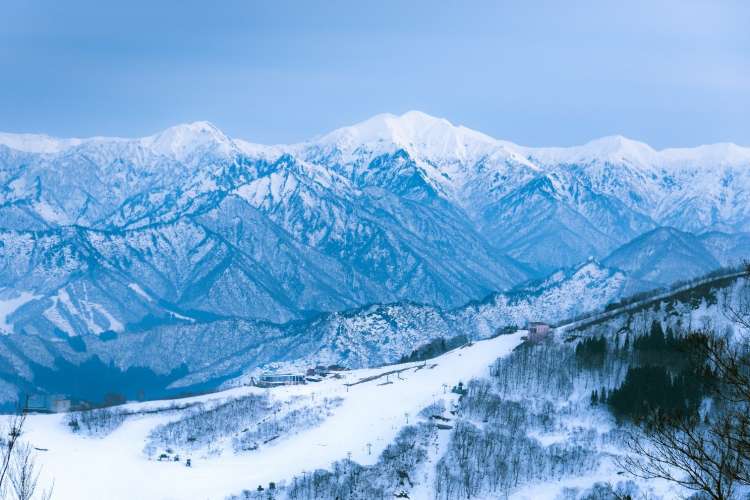
When travellers think of a winter trip to Japan, images of icy mountain peaks and cosy ramen houses always come to mind. And if you are a ski or snowboard enthusiast, endless slopes covered in top quality snow will be high on your winter wish list.
With perfect powder snow and over 600 resorts to choose from, Japan is the ideal destination to enjoy incredible winter sports. Even if you don’t ski or snowboard, Japan offers winter adventures full of culture, outdoor activities, and superb cuisine. What’s more, Japan embraces the wintertime like few other countries, making the coldest months a great time to visit. From snow monkeys and pretty villages to perfect skiing, hot springs and warming winter festivals, read on to discover the reasons why you should choose Japan as your next winter getaway.
Skiing & Snowboarding
Regardless of where you're travelling within Japan, the winter brings ample powder to many mountain regions, and with it many ski and snowboard enthusiasts. Japan’s rugged mountainous landscape boasts numerous peaks and the country’s unique weather and geographical conditions result in snow with low moisture content earning it the "Ja-Pow" nickname (Japan Powder).
Whether it’s in Hokkaido, Nagano, Niigata or Tohoku, you’ll find slopes for all skill levels and resorts that provide the perfect base to recharge. Most Tokyo-based travellers head to nearby Nagano for the great skiing and convenient accessibility and Hakuba is one of the most popular areas among several other resorts in the area.
Winter festivals
The wonders of Japan’s winter season are not limited to ski resorts. Despite the cold air, many traditional festivals and events take place in the winter, transforming the dark winter nights into a fun and warm celebration.
Arguably Japan's most popular winter event, the Sapporo Snow Festival welcomes upwards of two million people, showcasing hundreds of sculptures made of ice and snow. The festival is held in the first week of February with the elaborate pieces displayed in Odori Park, Susukino and Tsudome.
Onsen hopping
With fresh, pure water bubbling out from the volcanic earth below, many towns and villages have sourced this soothing water for hundreds of years and have developed a rich culture around public bathing and relaxation. Some locations have outdoor baths and enjoying the hot water with snow all around is nothing short of magical.

Destination Guides
Japan’s icy northernmost island is best loved for world class powder snow, delicious seafood, and natural hot springs. Much of Hokkaido is wild and unspoiled, with volcanic lakes and a fascinating indigenous culture. Just a short flight from Tokyo, Hokkaido is the perfect escape in all seasons.
Why we love it: What better place to feel on top of the world than hitting the high slopes of Niseko and Rusutsu in winter? Alternatively, you can scour markets for fresh sushi, sashimi, and other seafood delights or hike and explore the island’s many national parks in summer.
What’s new: The latest instalment of Hoshino’s KAI line of ryokans is a spectacular blend of local culture and modern comfort. Inspired by the art and architecture of the indigenous Ainu people, all 42 rooms of KAI Poroto have views of Lake Poroto. The onsen itself is filled with Shiraoi waters, a rare type of onsen water that contains organic minerals.
Where to go: Niseko United is located on the mountainside of Niseko Annupuri — a 1,308-metre-high mountain — and consists of four ski resorts : Niseko Annupuri International Ski Area, Niseko Hanazono Resort, Niseko Tokyu Grand Hirafu, and Niseko Village Ski Resort. While each resort is independent, they all connect near the mountaintop and are covered by the Niseko United All Mountain Pass.
Rusutsu Resort houses a resort hotel and ski slopes within its grounds and is one of largest single ski resorts in the whole of Hokkaido. Thirty-seven courses extend over the west, east, and Isola Mountains, offering a wealth of snow activities that cater to all levels, from beginners to professionals.
Get off the beaten path: Starting from Sapporo Station, a short train and bus ride can place you at the site of the 1972 Winter Olympic Games in less than 40 minutes. Sapporo Teine Ski Resort is one of the most accessible resorts in the prefecture offering reasonable prices and trails and is suitable for beginners and more seasoned pros.
More information on Hokkaido: https://www.japan.travel/en/destinations/hokkaido/
Japan's north-eastern wilderness which encompasses six rural prefectures is bound by custom and heritage. The region’s picturesque Ginzan Onsen town is like stepping back in time to the early 20th century.

Why we love it: Tohoku is just over one hour on the shinkansen (bullet train) from Tokyo depending on which part you’re visiting. The Tohoku region is a veritable winter wonderland, home to some of the most popular ski resorts in the world and its very own ‘snow monsters’. But if you’re after something a little more slow-paced and away from the adrenaline-filled slopes, there are plenty of winter experiences to keep you occupied.
What’s new: ANA InterContinental Appi Kogen Resort in Iwate Prefecture brings luxury travel to Tohoku. Guests can enjoy the best of sophisticated Japanese hospitality and breathtaking nature with Tohoku’s first luxury resort, set upon stunning snowscapes that are renowned by locals as ‘miracle silky snow’.
Where to go: If you're into mountains and outdoor sports, Shirabu in Yamagata Prefecture has everything on offer. For skiers and trekkers, Shirabu is a constant draw, and is also famous for its hot springs. The area is dotted with traditional Japanese inns with thatched roofs and rustic cottages that bear witness to the area’s 700-year history.
Zao Onsen , also in Yamagata, is an historic hot spring area and one of the largest hot spring and ski resorts in the Tohoku region. The snow monsters — or Juhyo — that Zao is famous for spread out near the top of the slope and you can reach them by taking two connecting cable cars from the foot of the mountain.
Get off the beaten path: Set in a beautiful valley in Fukushima Prefecture, Aizu-Wakamatsu has stunning onsen, well-preserved traditional townscapes, and is also famous for its lacquerware. During winter, the town becomes a winter lover's dream. The white Tsuruga Castle is mesmerising against snow-covered surroundings. A visit to Ouchi-juku will make you feel like you’ve gone back in time. The village holds a snow festival each year where you can enjoy the picturesque scenery covered in deep snow, sample local delicacies and enjoy traditional local performances as well as a fireworks display.
More information on Tohoku: https://www.japan.travel/en/destinations/tohoku/
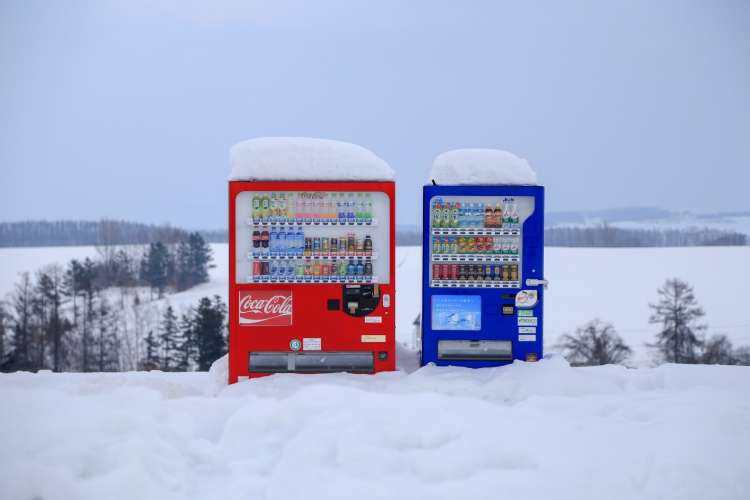
Nagano & Niigata
Come to Nagano and Niigata for world-class outdoor sports, and stay for townscapes from the samurai era, vibrant festivals and abundant hot springs. Host of the 1998 Winter Olympics, Nagano is an outdoor sports mecca particularly famous for skiing and snowboarding. Skiers and snowboarders descend on Nagano from around Japan and across the globe. After hitting the powder-rich slopes, get warm with onsen soaks and flasks of hot local sake.
Why we love it: Often called the "roof of Japan," it boasts the highest mountain ranges in the country. Enclaves of rural culture continue much as they have for centuries, with the villages of Tsumago and Narai appearing as if they were plucked straight from a samurai film.
What’s new: The winter illumination at Matsumoto Castle is truly spectacular. The castle is famous for its unique black exterior, earning it the nickname ‘Crow Castle’. The colourful illuminations are especially spectacular, as the illuminated castle reflects off the surface of the moat surrounding the structure, creating an amazing mirror effect. https://matsumotoillumi.jp/
Where to go: Hakuba Valley is an international mountain resort made up of 10 ski resorts scattered at the base of the Ushiro Tateyama Mountain Range in northern Nagano Prefecture. Running from south to north, the ten snow resorts have distinctive ski areas offering all snow travellers an exciting winter experience.
Niigata Prefecture’s GALA Yuzawa Snow Resort is touted as the only snow resort in Japan with a shinkansen station, and one of the most accessible ski resorts from Tokyo. The region receives huge amounts of snow each season, and GALA Yuzawa enjoys excellent snow conditions. Being less than 80 minutes from Tokyo by Joetsu Shinkansen means that even a daytrip from Tokyo is possible.
Jigokudani Yaen Koen (Snow Monkey Park) in Yamanouchi, Nagano, is one of the habitats of a population of Japanese macaques, and visitors can view these elusive creatures up close. During winter months, you can see them soaking in the area's hot springs to keep warm.
Get off the beaten path: Just over an hour by jetfoil from the nearest city on Niigata's coast, Sado Island is a remote retreat best known as the home of Kodo, Japan’s world-renowned taiko drumming group. While you’re there, take a taiko drumming lesson at the Sado Island Taiko Center, home to giant drums made from zelkova logs and cowhide. Sado's onsen is another attraction, as is the award-winning sake produced from the rice grown on the island.
More information on Nagano & Niigata: https://www.japan.travel/en/destinations/hokuriku-shinetsu/nagano and https://www.japan.travel/en/destinations/hokuriku-shinetsu/niigata

And if you think you’ve seen it all? Gunma Prefecture
A few hours northeast of Tokyo, the little-known hot spring resorts of Gunma offer the perfect location to get away from the crowds in winter. Literally in the centre of Japan, the land-locked prefecture of Gunma is surrounded by mountains, volcanoes and packed full of nature. The landscapes in this part of Japan are just stunning. They’re sights you don’t see very often, but they are beautiful, especially dusted with a fresh layer of snow.
Why we love it: Located in Joshin’etsukogen National Park, the historic 140-year-old Hoshi Onsen inn creates a world entirely different from city lifestyle. Here you can soak in 100% pure spring water that bubbles up from between the rocks set in the bottom of the baths.
Located on the expansive Minakami Kogen Ski Resort, this "Dog Sledding Trial Run" is the only place on Honshu where you experience real dog sledding without having to travel to Hokkaido.
What’s new: Container-style hotels are popping up across Japan. HOTEL R9 The Yard Ota is a new container hotel that features an innovative exterior and 37 comfortable guest rooms that are equipped with a full range of facilities that are ideal for winter travel.
Where to go: Kusatsu is a popular hot springs town home to 13 public baths. Considered one of the three best onsen areas in the country, the hot springs are amplified by the fun atmosphere of the resorts and spectacular scenic views. While you’re here, witness a ‘yumomi’ performance - a traditional way of cooling down hot spring water - before soaking in a mineral-rich onsen experience. The area’s ski resorts offer mellow slopes that are beginner friendly, where extensive snow grooming keeps the slopes smooth and easy.
Get off the beaten path: If you’re looking for a liberating open-air rotenburo bath, head to Manza Onsen that pours out in an alpine region 1,800 meters up in the mountains. Soak in its milky-white waters while you enjoy the surrounding natural landscape covered in the colours of autumn or the snowfall of winter and gaze up at the star-filled sky.
More information on Gunma: https://www.japan.travel/en/destinations/kanto/gunma/
For more information, please contact: James Cooley | [email protected] | +61 401 316 701
- Previous Article
- Back to Overview
- Next Article
- JNTO Sydney
Please Choose Your Language
Browse the JNTO site in one of multiple languages
- Skip to main content
- Skip to primary sidebar

Destinations
- Plan Your Trip
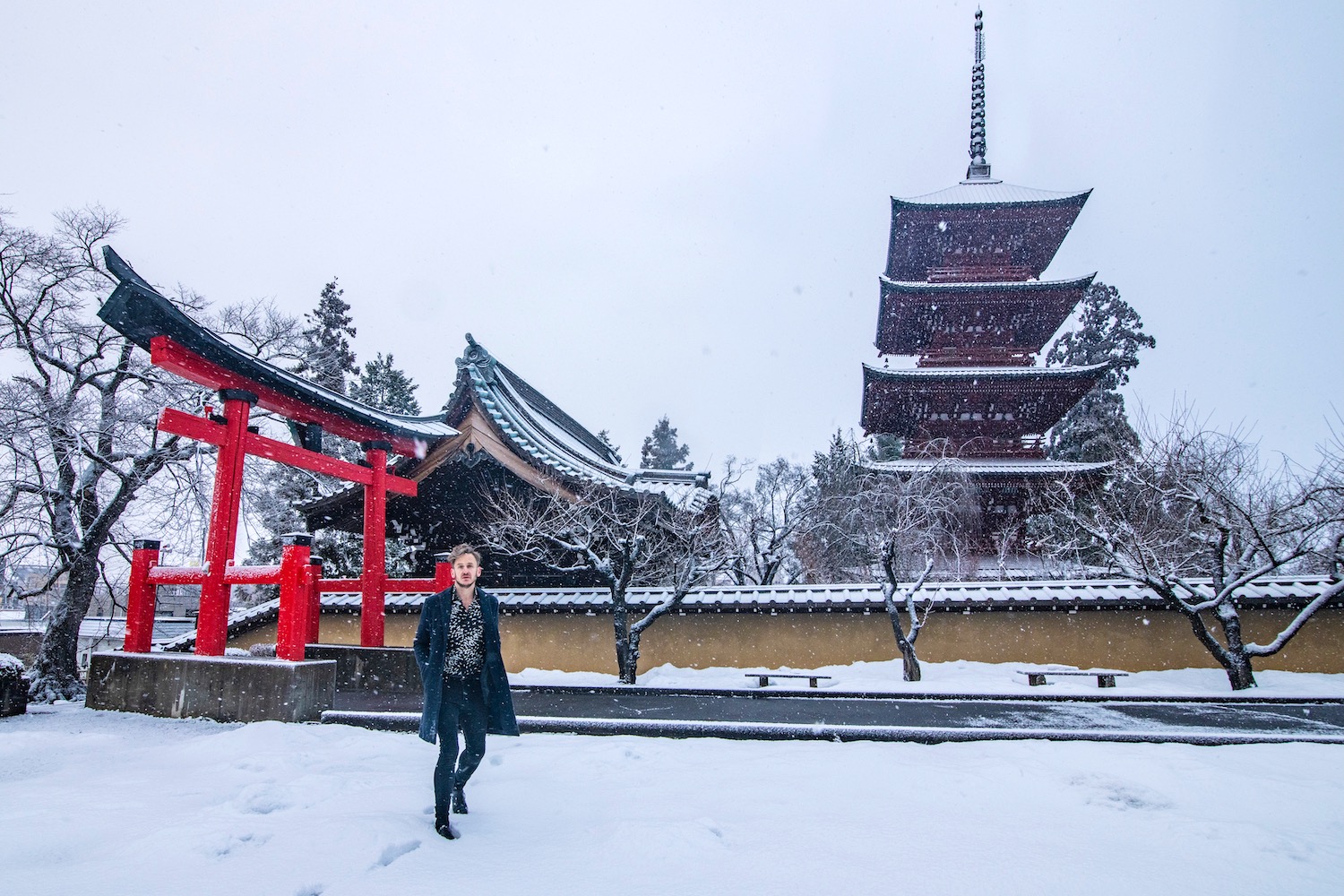
Japan’s Magical Winter Season
My first trip to Japan in winter was unspectacular—you might even say it was bad. It was late January 2015 and I headed to Hokkaido, but not to ski. Although local tourism authorities had helped me put together an itinerary, I was woefully underprepared, and left Japan the second week February feeling like I’d missed something.
That’s the bad news. The good news? From my 2019 cold weather swing through Tohoku and Hokuriku, to 2023, when I made a second stab at a winter journey around Hokkaido , the magic of this understated, underrated season has steadily revealed itself.
No matter what about Japan snow season attracts you, or where you think you’ll end up traveling, be sure to continue reading. I’ll not only ensure you avoid the mistakes I made during my first Japan winter itinerary—I’ll guide you toward the transcendental experiences that have now define winter in Japan for me.
How Cold Does It Get in Japan?
The weather varies throughout Japan’s winter season—and, not surprisingly, depending upon where in the country you travel. For example, while Japan in January is usually below freezing (especially in Hokkaido, where it can dip below -20ºC, and the Tohoku region ), I’ve found that places like Kansai and Shikoku can be comparatively balmy during this period, with highs around 10ºC or even higher.
In general, the temperature in Japan in February will decrease, and the propensity for snowfall will increase. This is even the case in cities like Tokyo and Kyoto , which in spite of pictures you might’ve seen online, aren’t exactly winter wonderlands. Certain parts of Japan can be cold and snowy well into the spring—the Tateyama Kurobe Alpine Route just north of the Japanese Alps , for example, doesn’t even open for traffic until mid-April!
Places to Visit in Japan in Winter
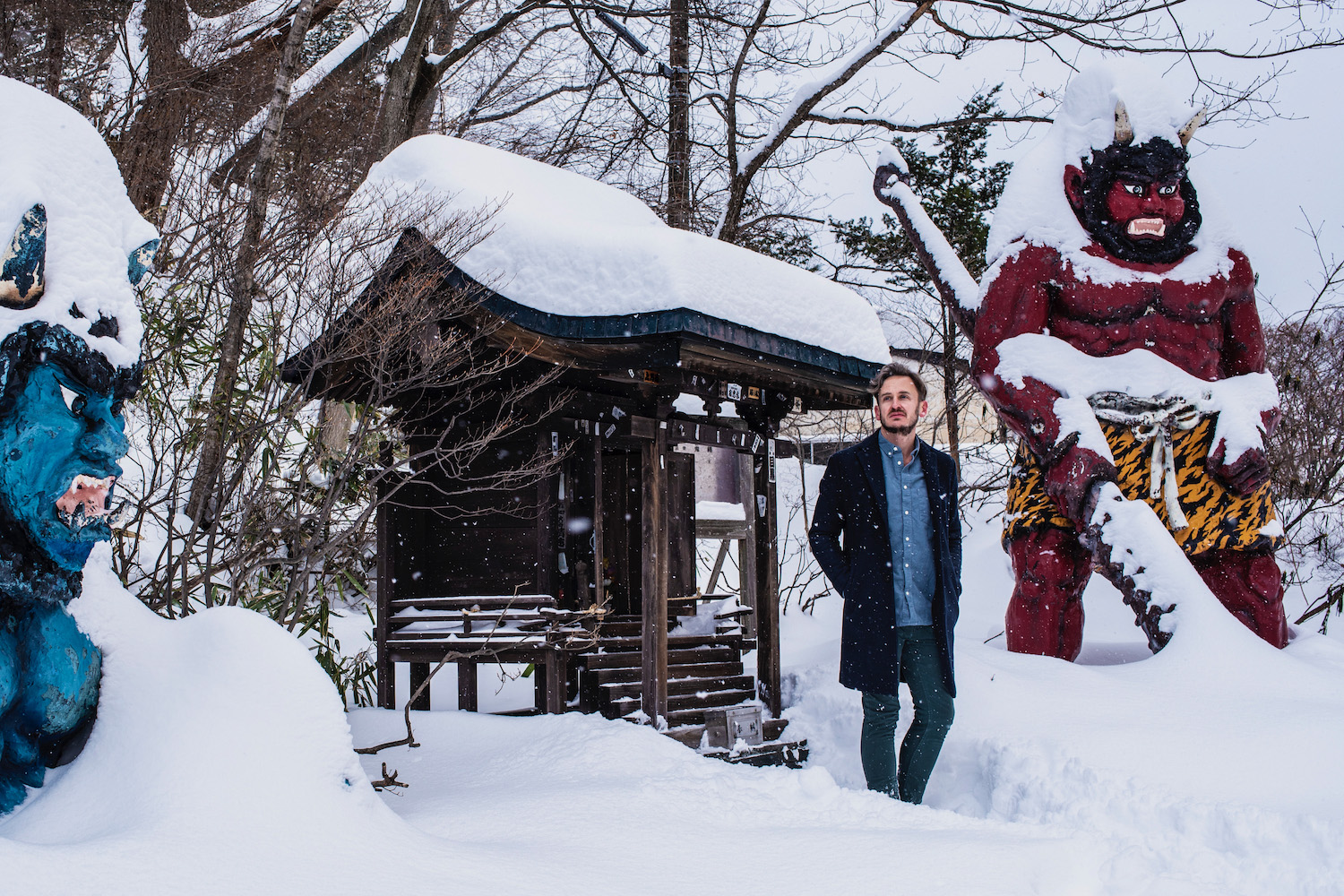
For most people planning a winter holiday in Japan, the country’s northernmost island is going to be near the top of the list. However, Hokkaido is not exclusively for skiers, even though it might seem that way on paper, given how many people make a beeline for Niseko . For example, you can enjoy a walk along the icicle-lined Otaru Canal , attend the Sapporo Snow Festival , marvel at the “Penguin Parade” in Asahikawa , see red-crested tancho cranes in the marshlands surrounding Lake Akan near Kushiro or peer down on Hakodate ‘s star-shaped Goryokaku fort covered in snow.

When clients contact me about a Japan winter itinerary, I often tell them they should choose Tohoku (the northeastern part of Honshu island) instead of Hokkaido. The reason I give them? “Tohoku,” I explain, “is Hokkaido’s scenery with the culture of mainland Japan.” To put it another way, you’ll enjoy wild nature but more typical Japanese architecture and traditions. Spend your days amid the “snow monsters” in Yamagata , and your evenings bathing at Zao Onsen . Traipse amid snow-buried warrior homes in the Kakunodate Samurai district, or visit Akita prefecture’s Yokote Castle when locals build kamakura , which are basically Japanese igloos.
Mt. Fuji and The Japanese Alps
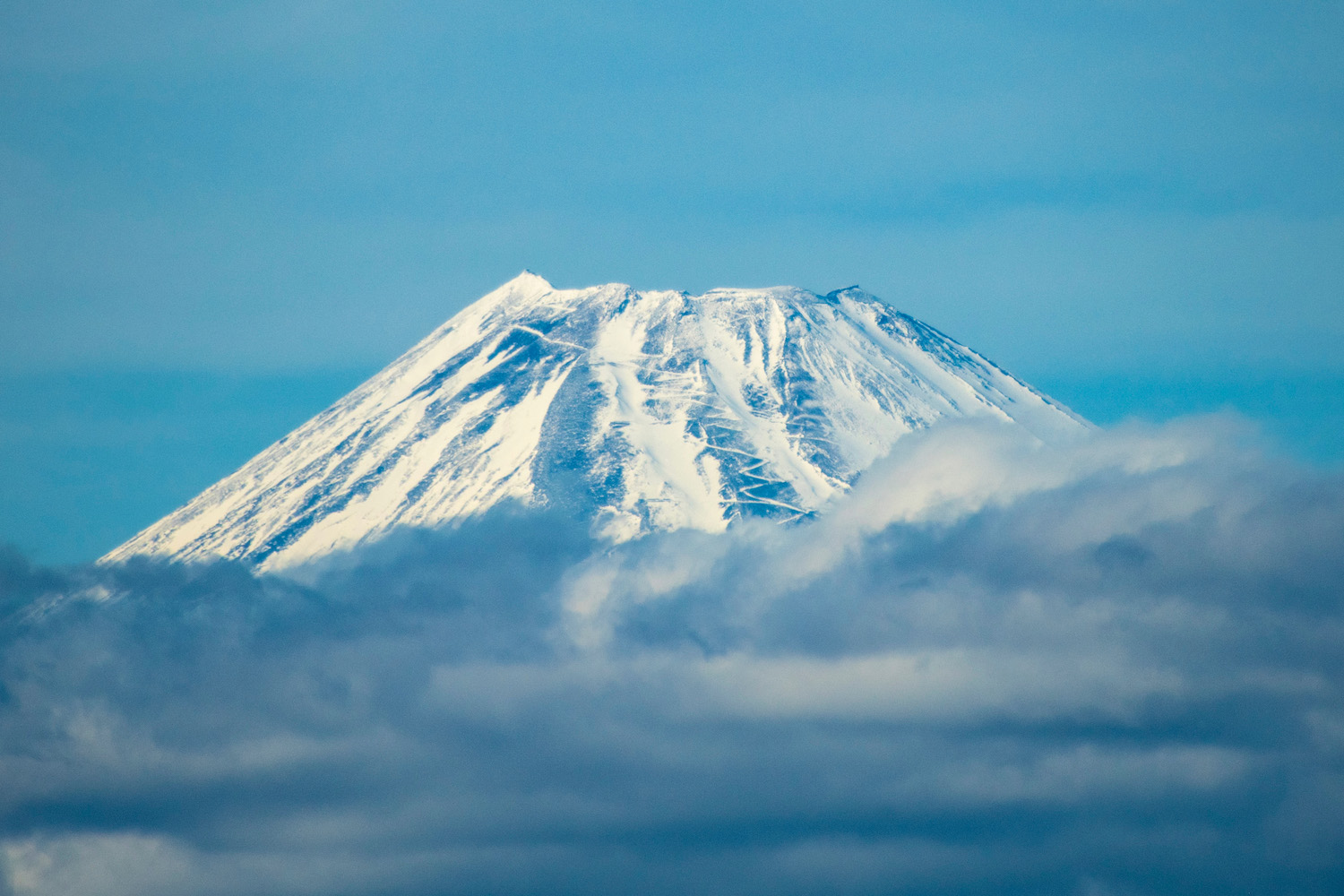
Probably the third-most popular destination in Japan in the winter is the Japanese Alps , which are famous for many of the same reasons Tohoku and Hokkaido are—and not just because of the Hakuba ski resort. Here again, skiers aren’t the only ones who can have a good time, even if Nagano prefecture is home to many of Japan’s best ski resorts. I personally love to base myself in the castle city of Matsumoto and take day trips from there, whether to the scenic Chuo Alps , charming towns like Shirakawa-go and Takayama or the historical Nakasendo trading route. You can also do various activities at Mt. Fuji during the winter , although you obviously can’t climb it.
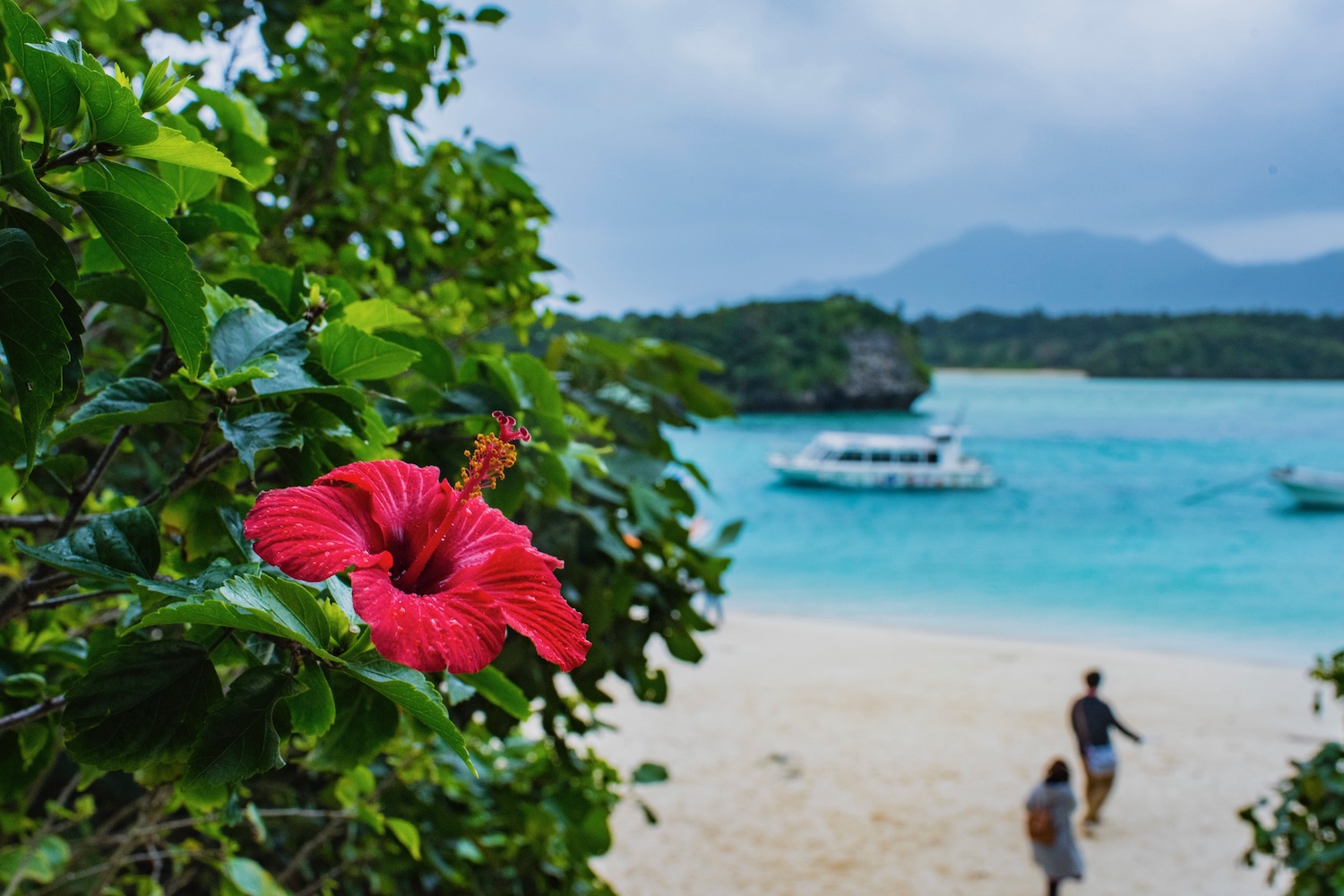
Perhaps the strangest destination option for Japan winter travel is sub-tropical Okinawa , but not for the reasons you’re thinking. To be sure, while seeing Okinawa’s unique species of cherry blossoms is a pretty singular experience, you shouldn’t be expecting beach time on Tokashiki Island or at Kabira Bay on Ishigaki . Of course, it could still be possible, particularly if you choose to visit during early winter (so, Japan in December) or later in the season, in early-to-mid March. Additionally, the chill winter months are the perfect time to enjoy warming Okinawan cuisine, including taco rice and hearty pork Okinawa soba noodle soup.
Japan’s Major Cities
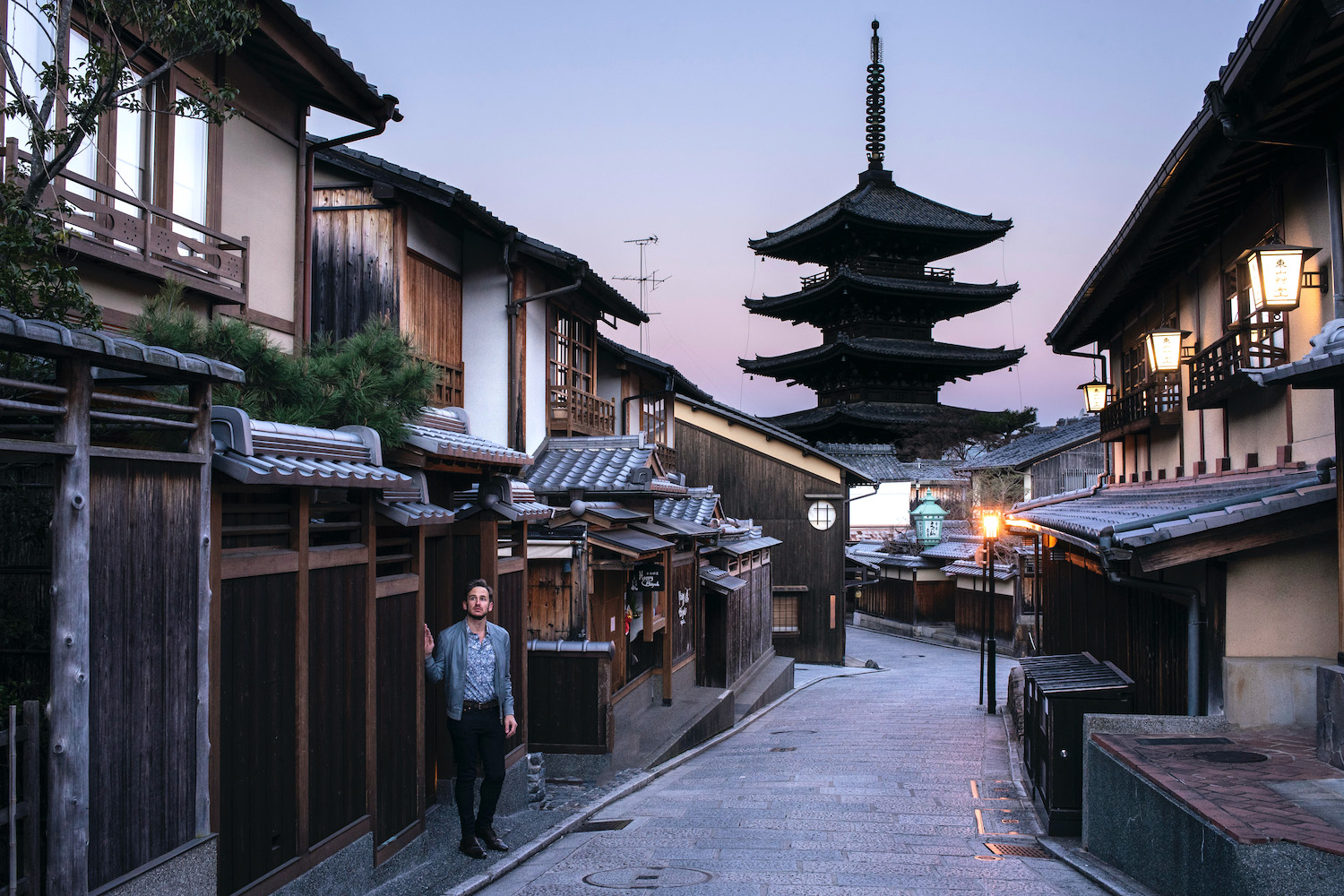
Although the list of things to do in Tokyo in winter is relatively short, this uncrowded season is still a great time to visit the Japanese capital. Likewise, places like Kyoto , Nagoya and Osaka are practically deserted during winter—and are absolutely delightful if you’re lucky enough to get snow. Fukuoka ‘s chilly winter nights provide the perfect justification to gorge yourself on rich tonkotsu ramen, while Hiroshima manages to feel even more solemn when it’s cold.
Things to Do in Japan in Winter (Besides Ski)
Gawk at the incredible beauty around you.

The thing that shocked me most as I executed my Japan winter itinerary was how colorful the country was during this seemingly dead season. From the vermillion gates of Tokyo’s Hie Shrine , to the tangerine glow above Mt. Fuji at sunset, to the turquoise waters of Tsuru no Yu onsen, to the cloudless azure of the skies above Zao Onsen’s pure white snow, Japan is a vibrant rainbow of color in the winter, much to my surprise and delight.
Practice Your Winter Photography Skills
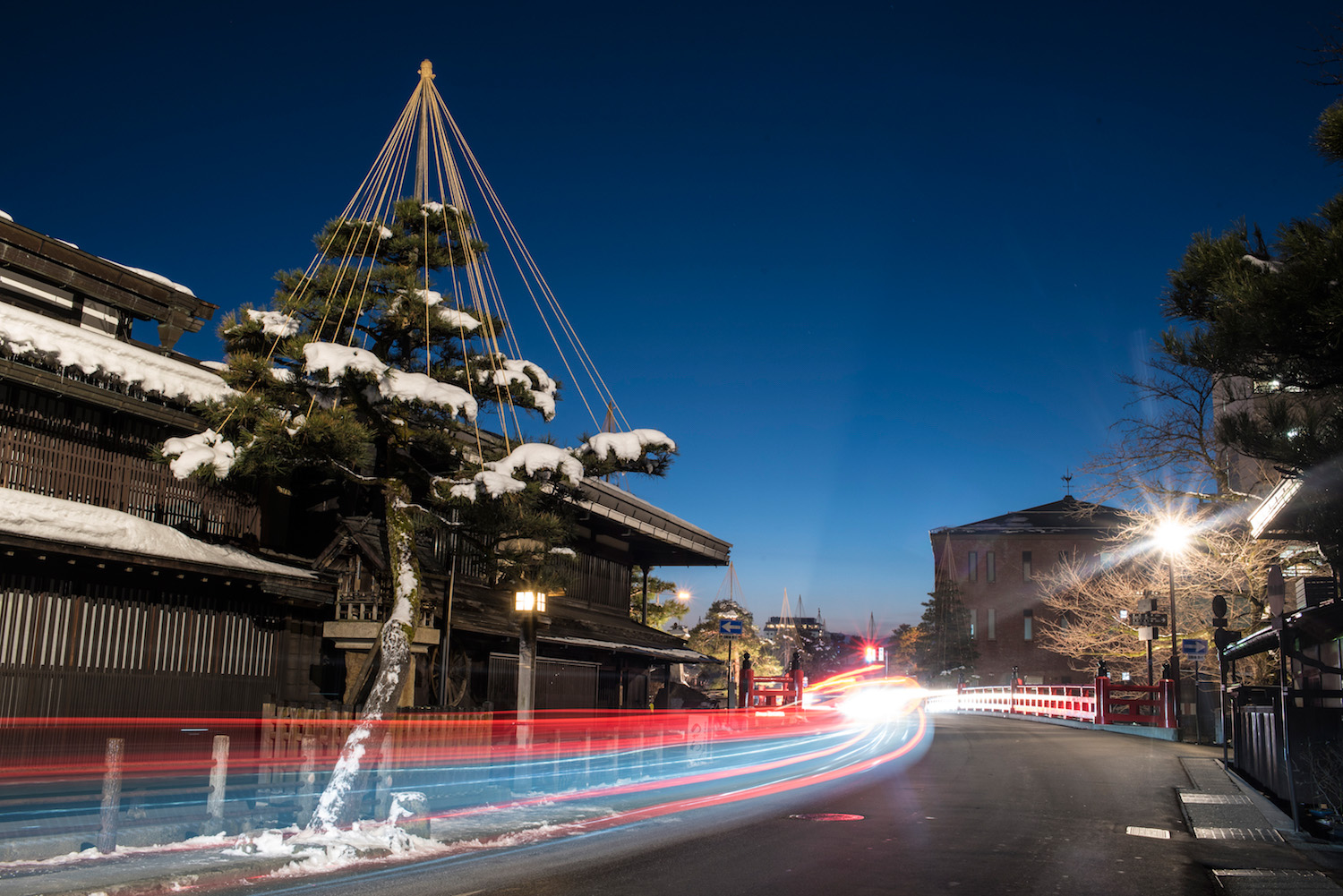
As a result of what I’ve just written, another top choice for what to do in Japan in winter is snow photography , which is more difficult than you might expect. For instance, while scenes without snowfall require slight over-exposure in order to capture the brilliant white carpet before you, you’ll want to turn up your ISO (and speed up your shutter!) in order to get shots of falling snow just right, lest they be blurred. Invest in a good pair of gloves so your hands don’t freeze, and an extra battery of two—they die faster in the cold!
Enjoy Japanese Animal Adventures
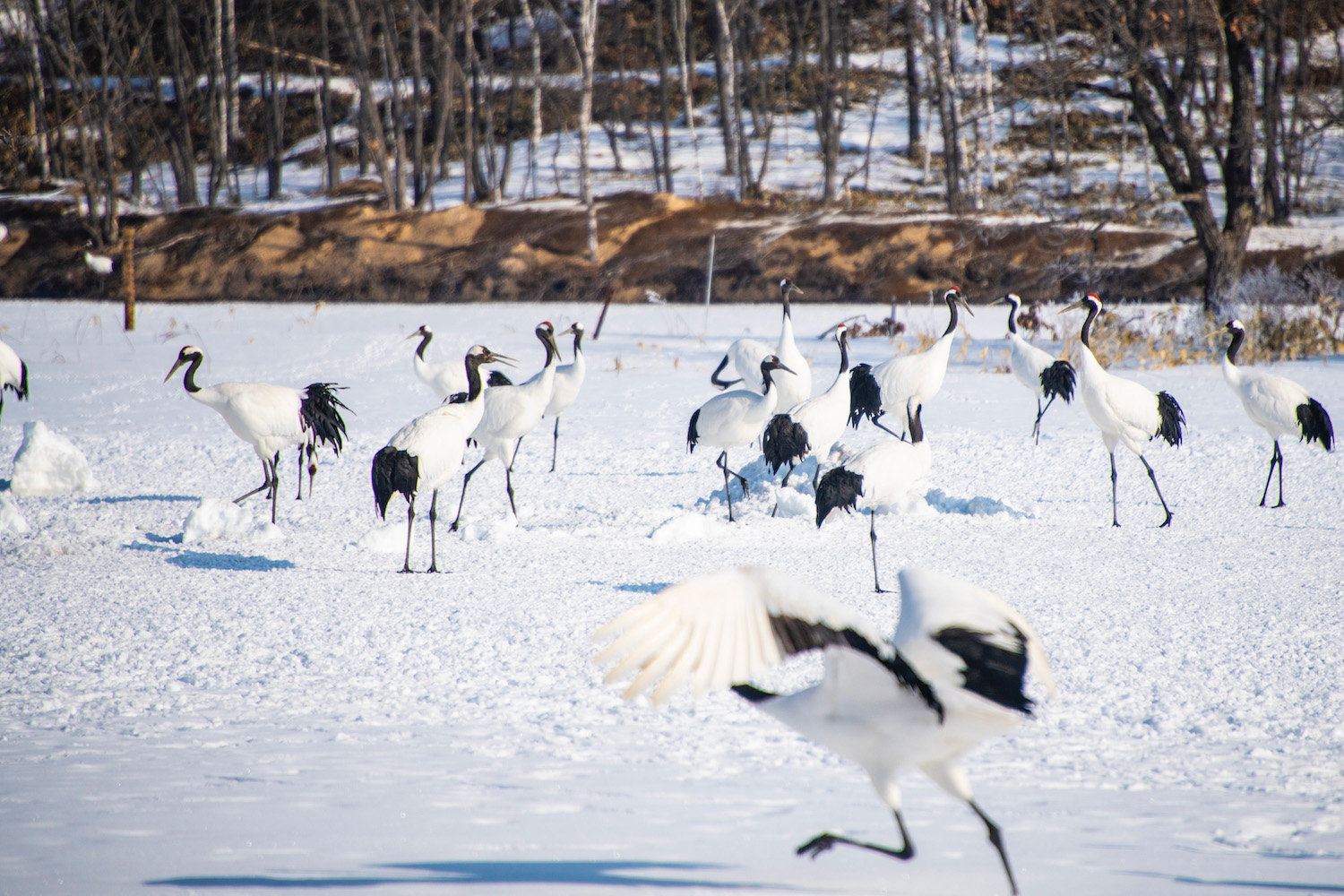
Japan in the winter isn’t just for humans—it’s also when many of the country’s cuddliest residents are at their most resplendent. Of course, seeing animals during a Japan winter travel itinerary isn’t without its caveats—in any season. To start with, while a hike to see the snow monkeys of Jigokudani , a bus journey to the red-crested tancho cranes of Hokkaido or a train ride to see the deer of Nara is relatively innocuous, I’d probably think twice before visiting the so-called “ Fox Village ” of Miyagi prefecture . Likewise, there are certain winter animals you should probably avoid, most notably the bears that are endemic in many parts of Japan.
Savor Warming Winter Foods

One of my favorite things about winter time in Japan is eating—and eating everything in sight! To be sure, while certain dishes (like seasonal oden bowls with spicy mustard, piping hot ramen and steaming plates of tonkatsu curry) seem better suited for season, I’m just as likely to tear into a plate of fresh sushi or enjoy whatever local soft cream flavor is hot, especially the gold-covered variety that’s so popular in Kanazawa ! Just make sure to watch your calorie consumption, if you care about that sort of thing—icy sidewalks can make it difficult to run or jog in Japan in winter.
Visit a Ski Resort Anyway
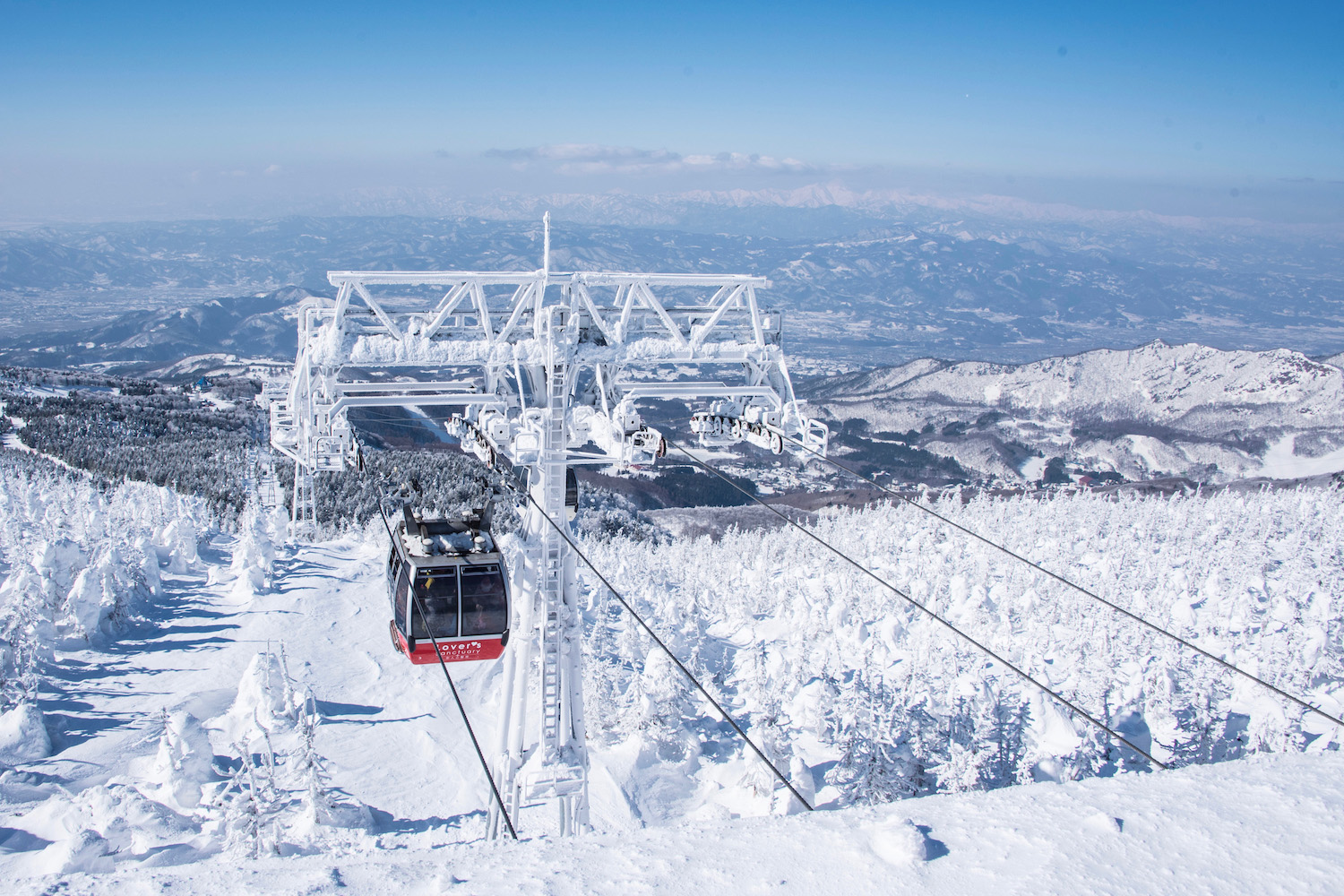
As you search for things to do in Hokkaido in winter (or even Tohoku, as the case may be), the majority of places you find are going to relate to skiing. However, you needn’t be a skier to visit these places. Whether you get loaded at an après ski bar in Niseko , or ascend the aforementioned Mt. Zao in Yamagata to marvel at the towering snow monsters, you don’t need to be on a pair of skis (or even snowshoes) in order to enjoy Japan’s ski season.
Best Onsen for Japan in Winter Travel
Many people email me asking what to wear in Japan in winter (TIP: a trip to UNIQLO once you arrive in Tokyo should put you in contact with most of what you need), but in some cases the answer is surprisingly simple: Nothing at all! In my opinion, winter is the very best time of year in Japan to enjoy onsen hot springs, particularly if you can find a place to bathe outdoors.
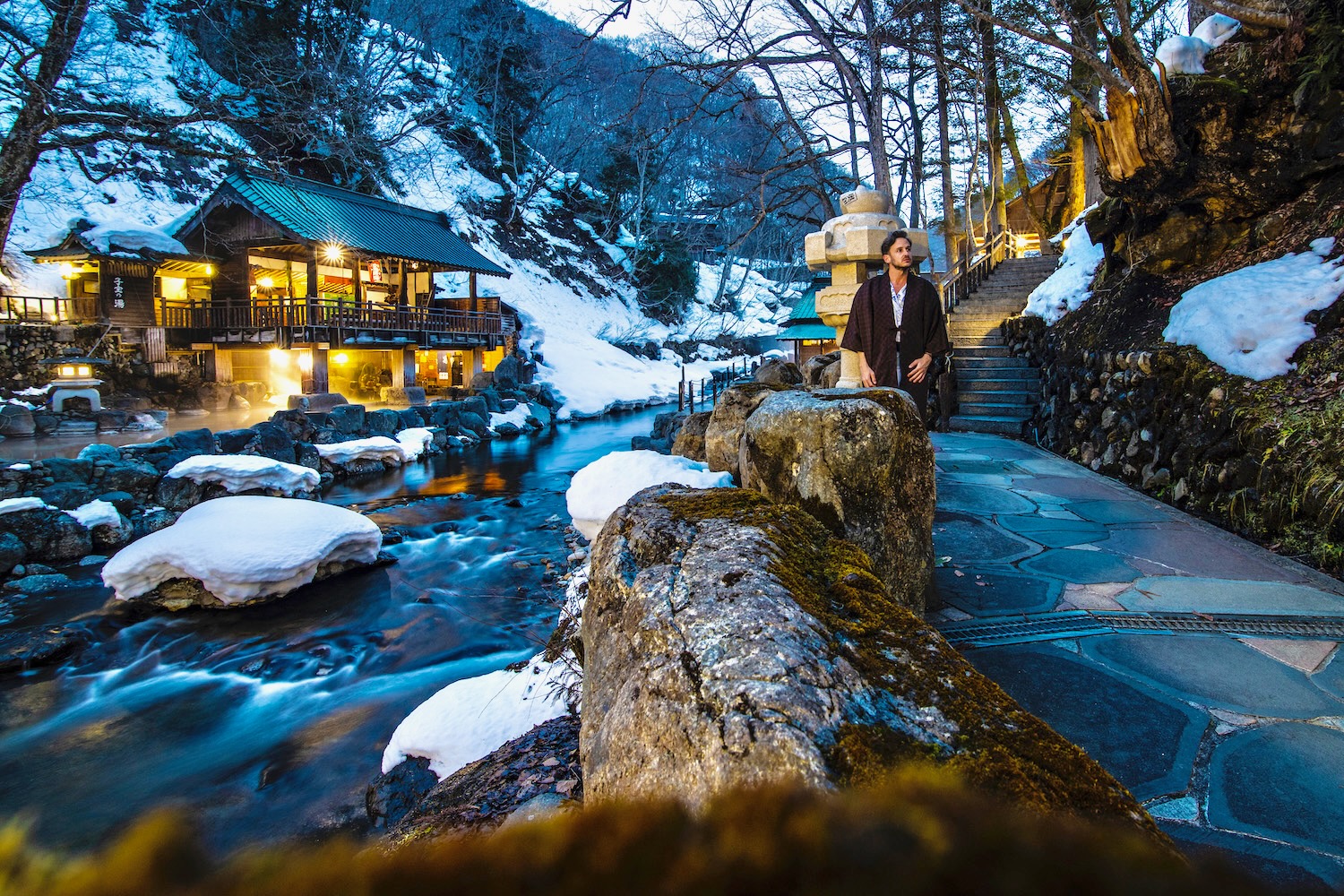
As far as the best (or simply my favorite) Japan winter onsen, that’s a bit more difficult to say. Takaragawa Onsen , located in Gunma prefecture a couple hours north of Tokyo, will always hold a special place in my heart—it’s objectively the most beautiful “natural” hot springs hotel in Japan. I find Akita prefecture’s Tsuru no Yo somewhat overrated, on the other hand, while Shuhokaku Kogetsu in Kawaguchiko probably has the best view (SPOILER ALERT: Mt. Fuji reflected in the waters of Lake Kawaguchi), even if it’s prohibitively expensive for the majority of travelers.
Other FAQ About Traveling to Japan in Winter
Is japan worth visiting in winter.
Visiting Japan in winter is absolutely worthwhile, even if you don’t ski. From light crowds even in the temperate cities of Kyushu and Shikoku , to the chance of seeing your favorite attractions in Kanazawa or Kyoto blanketed in snow, Japan is at its most undisturbed during the winter months.
Is Japan cold in winter?
Japan can be very cold in winter, or very mild. If your Japan winter itinerary takes place in Hokkaido or the Tohoku region, you can expect lots of snow and temperatures well below 0ºC/32ºF. Destinations in Japan’s south and west like Shikoku and Kyushu are mild and sunny, while Okinawa can be downright balmy. Major cities like Tokyo, Kyoto and Hiroshima can be cool and wet, but rarely get legitimately cold or snowy.
Does it snow in Tokyo in December?
Tokyo almost never sees snow, in December or otherwise. If your Japan winter travel itinerary focuses exclusively on the Kanto region and you absolutely must see snow, consider riding the Shinkansen to Nagano or Nikko , or taking a day trip to hike Mt. Takao if you’ll only be in the Tokyo’s city center.
The Bottom Line
In some ways, I prefer Japan in winter to every other season, though that wasn’t the case until somewhat recently. If you can curate a Japan winer itinerary spotlighting places that interest you and experiences that keep you on your toes, the magic of this underrated, understated season will wrap itself around you like a bamboo stalk dusted with fresh snow. You needn’t ski in order to enjoy Japan at its snowiest, though you might commission a custom Japan winter trip to make sure you can see the best of the rest of what’s on offer, whether you’re contemplating visiting Japan in December, January or February.
Plan Your Japan Trip

Subscribe to email updates!
Words, images and design ©2018-2024 Robert Schrader, All rights reserved. Read Privacy Policy or view sitemap .

A Japan Winter Itinerary + 7 Unique Things To Do In Japan In Winter
Thinking of visiting Japan in winter? Don’t leave these unique experiences off your Japan winter itinerary.
A Japan winter itinerary is going to be packed with magical sights that most tourists don’t get to see.
That’s because winter in Japan is a truly unique time – and that means you can enjoy some of the most unique things to do in Japan when you visit during the winter season.
If you’re still deciding when to visit Japan, this winter itinerary might just convince you that the colder months are one of the best times to visit Japan.
Even if you’ve visited Japan in the spring, summer or autumn, winter in Japan will be a completely new experience.
Here’s how to plan a trip to Japan in winter, including where to go, what to add to your Japan winter itinerary and must-know tips for visiting Japan in winter.
Is it worth visiting Japan in winter?
Japan 2-week itinerary: winter edition, the japan rail pass, tokyo in winter, day trips from tokyo in winter, hokkaido in winter, kyoto and osaka in winter, 1 – visit an onsen, 2 – slurp ramen, #3 make the most of indoor entertainment, 4 – stay in a traditional japanese house, 5 – indulge in the izakaya experience, 6 – go shopping, 7 – take part in a traditional tea ceremony.
Just to let you know… This post (probably) contains affiliate links, including Amazon Associates links, and I may receive a small commission if you click one. This is at no extra cost to you and allows this site to keep running.
First things first, you’re probably wondering if winter is even a good time to visit Japan.
After all, even if you’re only just starting to plan your trip to Japan , you’re probably well aware of the famous cherry blossom festival .
And while taking part in the annual hanami (flower viewing) tradition should be on every traveller’s bucket list, it’s also, understandably, peak travel season in Japan.
Given that many visitors time their trip for the spring and summer seasons, places generally get busier (and more expensive!) at these times.
As much as I loved witnessing the cherry blossoms turn the streets of Kyoto pink, I still feel winter is a totally underrated time to visit Japan.
Not only will most places be quieter and have fewer crowds during the off-peak months, but winter is when Japan may just be at its most enchanting of all.
Japan in winter itinerary
When it comes to planning a Japan winter itinerary, I would largely follow this itinerary for 7 days in Japan, with a few extras added in.
Those extras would be two of my favourite places in Japan and both are better in winter: Hokkaido and the snow monkeys hot springs at Jigokudani Snow Monkey Park.
While both of these places can be enjoyed all year round, they really come into their own in the colder season when snow lines the ground.
The 2-week Japan itinerary below will help you see the best of Japan in winter in just a couple of weeks.
If you have more time, you could easily spend at least one more full day in each of the places included.
And if you don’t have a full two weeks to explore, I would reduce the number of city days and focus on spending a few days in Hokkaido.
While northern Japan has something to offer in every season, winter really is the best time to visit Hokkaido.
With heavy snowfall, snow festivals with snow sculptures – such as the Sapporo Snow Festival – and many of the best winter activities that Japan has to offer, it would be a shame to miss Hokkaido on a winter trip to Japan!
- Day 1: Arrive in Tokyo. Explore the city, including the eccentric Tokyo nightlife
- Day 2: Explore Tokyo
- Day 3: Day trip to Mount Fuji
- Day 4: Take the shinkansen to Hakodate
- Day 5: Explore Hakodate. Transfer to Sapporo for the night
- Day 6: Take a day trip to Noboribetsu and Jigokudani “Hell Valley”
- Day 7: Enjoy winter sports (or get cosy in one of the many ski resorts), visit seasonal events or take a day trip to a National Park
- Day 8: Travel back to Tokyo on the shinkansen
- Day 9: Take a day trip to see the snow monkeys (alternative: Hitachi Seaside Park)
- Day 10: Travel to Kyoto
- Day 11: Explore Kyoto during the day, then experience Kyoto at night
- Day 12: Visit Nara Park
- Day 13: Transfer to Osaka, visiting Himeji Castle on the way. Explore Osaka
- Day 14: Osaka/departure day
If one thing becomes abundantly clear when planning a 2-week winter itinerary for Japan, it is that the Japan Rail Pass is essential.
This handy little card gives you access to the entire network of high-speed trains (and some non-high-speed local trains) across the country, making it possible to squeeze much more into your winter trip to Japan.
If you plan to visit Hokkaido – I highly recommend it! – it will also save you a small fortune on the cost of travel in Japan.
It’s best to order your pass before you leave because it’s much cheaper than buying it once you arrive. Plus, it’s also much easier.
You can buy your pass on this website (the best place to buy!) and get free delivery to almost any country in 24-48 hours. If you prefer, you can also do as I did and pick your pass up when you arrive, but you’ll save time by getting it delivered.

Where to go in Japan in winter: in detail
Unlike other countries – like Spain or parts of the United States , for example – the fact that it’s winter won’t restrict you much in Japan.
If anything, it’ll mean you get to see a really special side to this already magnificent country.
Here’s a breakdown where to go during winter in Japan, including the places included in the winter itinerary above:
Most trips to Japan will begin with at least a few days in Tokyo since most international flights land at Narita Airport (or sometimes Haneda Airport).
Although you might not be able to enjoy strolling around the city’s expansive parks as much, there won’t be many things you’ll have to skip.
Even when it’s chilly outside, you can still enjoy all the city’s highlights, including Harajuku’s shopping street and Golden Gai’s unique nightlife . In fact, Golden Gai’s tiny bars are even cosier when it’s cold outside.
You also won’t have to skip the 24-hour karaoke, 24-hour sushi trains or the many ramen houses.

Insider travel tip
If you haven’t already booked your flights, I recommend using WayAway to find the best options. Not only do they aggregate the largest number of supplies and the best prices, but you can also get 10% cashback with a WayAway Plus membership!
WayAway Plus is one of my favourite travel hacks because you can save money on almost anything. You just use their search engine to find the best deals and get up to 10% of the cost back in cold hard cash (in your Paypal account).
I love it so much that I’ve teamed up with them to give Alajode readers an exclusive discount of 55% (less than $4 per month)! Sign up using this link and enter the code “ ALAJODE ” to save on your next travel bookings.
With a destination like Japan, you could save hundreds of dollars in just one trip.
The Japan winter itinerary above includes a couple of day trips from Tokyo.
While it’s possible to spend the night at most of these destinations, there’s really no need. As long as you have a Japan Rail Pass , it’ll be just as easy – or even easier – to head back to Tokyo at night.
My one tip would be to stay as central in Tokyo as possible. Being close to a train station – especially Tokyo station – will be super helpful when it comes to making the most of your time in Japan.
Plus, since winter in Japan can get quite chilly, it will minimise the amount of time you need to spend out in the cold.
Anywhere in the Shinjuku or Shibuya area will make a great base for exploring Tokyo and beyond via rail:
Recommended sustainable Tokyo hotels:
- Stay in the heart of the city in luxury: Imperial Hotel
- Apartment living with home comforts: Citadines Shinjuku Apart-Hotel
- A luxe stay with traditional touches: JR Kyushu Hotel Blossom
- Quirky and affordable: Book and Bed
- For unrivalled views of the city: Kimpton Shinjuku (by IHG)
While it’s not possible to hike Mount Fuji during the winter months, it’s still very possible to visit.
And it’s something you won’t want to miss!
Seeing Fuji capped in a layer of snow is a sight you’ll never forget, but is only possible for a few months of the year.
The best way to see Mt. Fuji is on a day tour such as this one that stops at several scenic spots. The bus picks up and drops off in Shinjuku, which is another reason to make it your Tokyo base.
Hotel deals in Shinjuku (updated live)
If you haven’t booked your Tokyo accommodation, these limited-time hotel deals are updated daily and many of them off free cancellation if you change your mind:
Shibu Onsen & Jigokudani Snow Monkey Park
One place you won’t want to miss in Japan in winter is Shibu Onsen.
A short bus ride and hike from this small onsen town you’ll find the famous snow monkey hot springs .
Winter is also the best time to see the Japanese snow monkeys bathing in natural hot springs because the cold weather means they spend more time in the water. Which means more cuteness and even better travel photos !
The easiest way to visit is on a day trip from Tokyo. It’s a long(ish) journey, but joining an organised guided tour from Nagano station is the easiest way to take the stress out of logistics.
This one-day tour meets where the shinkansen arrives and will drop you off after, so you can make the most of your JR Pass. It also includes lunch and sake tasting!
Hitachi Seaside Park
Hitachi Seaside Park is an expansive garden that changes with the seasons.
The park has been designed so that each area has different plants and flowers in bloom at each time of year.
That means that, if you v visit in the winter, you’ll see a completely different spectacle to what you would see in the summer.
Even if it wasn’t set up to change seasonally, the design of this park is a piece of art worth seeing.
You can visit on a day trip from Tokyo , but stay overnight if you want to make the most of it and get the Japanese onsen experience .

Outside of Tokyo, Hokkaido is a must if you’re visiting Japan in winter.
In fact, winter in Hokkaido is a pretty magical experience and probably the best time to visit Japan’s northernmost island. And since Hokkaido has a much longer winter than the rest of the country, it’s well-equipped for winter travellers.
If you’re an avid skier, you’ll love Hokkaido’s ski towns and resorts. And even if you’re not, staying at one is a great way to unwind in the Japanese mountains.
Whether you head there or not, make sure you leave time for Noboribetsu. If you only do one thing in Hokkaido during winter, take a soak in the hot springs and enjoy the incredible views.
You can visit on a day trip from Sapporo or, if you want the full onsen experience, book a night at the Noboribetsu Grand Hotel (if there are any rooms still available – it books up fast!).
Hokkaido loves winter and has several festivals celebrating the colder months of the year.
The Hokkaido Snow Festival is the most popular of all, taking place in late January and/or early February every year. If you can time your Hokkaido trip around it, it’ll almost definitely be worth it.
And if it doesn’t, you can still enjoy the Sounkyo Ice Festival which runs all the way until March.

Japan’s other major cities, Osaka and Kyoto, both have their own unique charm during winter. You could visit both on a day trip or overnight adventure from Tokyo, but stay a little longer if you can.
Kyoto may just be the most photogenic city in Japan, and even more so in winter. The only thing more magical than seeing its narrow streets and towering temples is witnessing them covered in snow.
Kyoto gets incredibly busy during cherry blossom season and the warmer months, so winter is a great time to see it without the crowds. Plus, there’s even more nightlife to enjoy there.
Osaka doesn’t suffer from the freezing temperatures that other Japanese cities face during the winter, so it’s a great time to visit Japan’s second-largest metropolitan area.
You can still enjoy all the same shopping, restaurants and entertainment , but with smaller crowds than in peak season. As a foodie hotspot, Osaka is a great place to try some local delicacies in the warm .
In addition to that, Osaka also has its own share of light festivals and celebrations to enjoy throughout the winter.
Once again, I’d recommend choosing Osaka accommodation that is centrally located and/or close to a train station because travel distances can be significant.
Both Kyoto and Osaka make a great base for exploring nearby tourist attractions. Some of the best ones to explore during the Japanese winter include:
- Himeji Castle

Activities to add to your Japan in winter itinerary
Wherever your trip to Japan takes you, make sure you add these unique experiences to your Japan winter itinerary.
They’re all just a little bit better when it’s cold outside!
There’s nothing like slipping into a natural hot bath when it’s freezing out. If you can, find an open-air one and enjoy the fresh surroundings.
Just make sure know the onsen rules first!
Ramen is good at any time of year, but it’s the best when it’s cold outside.
There’s nothing like feeling the warm, yummy noodle soup heat you up from the inside out.
I’m yet to try bad ramen in Japan, but the best by far was in Hokkaido. But perhaps that’s just because it was coldest there…
Japan has no shortage of indoor activities. From robot shows to karaoke contests, there’s always plenty to keep you entertained when you don’t want to be outside.
Do a little digging and you never know what you might find.
Japanese homes may just be the most logical houses on the planet.
From sliding doors that can make the room as big or as small as you like, to dining tables complete with blankets to cover your legs, there’s nowhere cosier to stay during the winter.
There are plenty of ryokan style accommodation options on Booking.com, Hotels.com and Agoda , including both hotels and homestays, and it’s well worth spending at least one night in one!
Izakaya are informal bars that serve drinks and snacks similar to tapas.
Every visitor to Japan should try to visit one of these bars, especially in the winter. When it’s cold outside, the cosy atmosphere is a great place to warm up.
Alternatively, sign up for an izakaya cooking class to learn more about Japanese culture while trying some food yourself.
Japan is home to some of the best brands on the planet.
From electronics to fashion, there’s no shortage of unique places to shop – especially in the capital city, Tokyo.
During the winter months, prices are often reduced as stores prepare for the new season, so it’s the perfect way to escape the cold and experience a new side of Japanese culture.
Tea plays an important role in Japanese culture – and is also the perfect way to warm up on a winter day.
You’ll learn all about it while sipping a warm cup of ceremony-grade matcha.
Tea ceremonies are available in Osaka, Kyoto , Tokyo and almost every big city so there’s no reason not to add one to your Japan winter itinerary!
RELATED READ: Norway’s Lofoten Islands are another great winter trip – here’s why.
Japan Travel Planning
Even though I found Japan surprisingly easy to travel, it still pays to be prepared.
In fact, it’s one country where you’ll really save yourself some time and money (not to mention stress!) by having as much prepped in advance as possible.
Here is a checklist of things to have prepared before you go:
Shinkansen Tickets
The Japan Rail Pass is a no-brainer for anybody who wants to see more than one part of Japan.
Booking in advance is super simple – much simpler than buying in Japan – AND comes with free 24-48 hour delivery.
I booked through JRailPass.com and can’t recommend them more for their price, efficiency and customer service.
GET YOUR TICKETS
Travel Insurance
The good news: things generally run smoothly in Japan and, when they don’t, the healthcare is some of the best in the world.
The bad news: when things don’t go to plan, it can be very expensive.
That’s why travel insurance is a must in Japan.
Since moving to Portugal, I use and recommend True Traveller because they cover a wide range of activities and circumstances.
If you’re resident outside of Europe, EKTA travel insurance offers affordable, transparent and extensive coverage all over the world.
WiFi/Sim Card
Getting a sim card in Japan is tricky (and expensive!). Unfortunately, I waited until I was there and learned the hard way, so I highly recommend arranging your WiFi situation before you go.
The best way to stay connected while travelling Japan is with an eSim that you can use right away or this local sim with unlimited data that you can pick up on arrival.
Save on flights to Japan
Did you know that you can save up to 10% on flights with a cashback service?
With WayAway Plus , you can find the cheapest flights, transfers and other travel services and receive part of your purchase back in cash. It goes straight to your Paypal account!
I use WayAway to book all my flights so that I can save extra and have secured an exclusive discount for Alajode readers to do the same.
Use this link and the code ‘ALAJODE’ to save a massive 55% on your yearly membership plan and start saving. That mean you’ll get up to 10% off all travel services for less than $4 per month. In just one trip to Japan, that could save you hundreds of dollars!
Not only does a VPN help protect you and your data while travelling, it can also help you access geo-locked content.
That’s something that comes in really handy in a place like Japan, especially if you don’t speak the local language!
NordVPN is the one I use and trust, and currently has this great deal available.
Airport Transfers
If you’ll be arriving late or staying somewhere fairly remote, consider booking an airport transfer on arrival.
This will take a whole lot of stress out of an already confusing situation when you land in Japan, especially after a long flight.
I’ve found this website has the best prices and the widest availability (sometimes in places where there aren’t even taxis!).
About Jodie Marie Dewberry
Jodie has been travelling the world full time since 2017, sharing the most unique places in the world along with tips for living as a digital nomad. She is a passionate wildlife photographer and has worked with a number of prominent travel brands, including airlines, tourism boards, hotels and tour operators.
Leave a comment Cancel reply
Save my name, email, and website in this browser for the next time I comment.

- WHERE TO GO
- CHERRY BLOSSOMS
- FALL COLORS
10 day Japan winter itinerary ⛄ How I did the Japanese Alps ⛄ Tokyo Nagano Hakuba Takayama ⛄ Backpacking Japan travel blog
This is basically part 1 of my Japan winter itinerary and almost exactly what I did. (Part 2 is winter in Hokkaido !)
This starts off from Tokyo, and then heads to places where you can visit the mountain range called the Japan Alps or Japanese Alps.
This is how I did it anyway in early 2019.
I started at the very end of February and was in these places through March.

This was actually a little late in terms of winter landscape, as some places I visited didn’t have the packed snow as seen in pictures. The snow was melting.
So if you have flexibility in your dates, it may be better to try to go earlier in the season than I did. Although they did say the season I went was unseasonably warm so snow was melting earlier than usual. In pictures below that you don’t see packed snow, google winter pictures of these places!
But even with places that did have snow melting, you’re sure to have a very Japan experience by following this winter itinerary!
There are some places on this list that aren’t necessarily winter-specific destinations, but since you are in the area, they can be a perfect way to experience more of Japan!
First, the quick list of the best places to visit for winter in Japan when starting your trip from Tokyo.
Then, the quick list of the 10 day trip itinerary to go to these places with 1-2 weeks in Japan.
Then, a little bit about where to stay.
And then, a bit more about getting around Japan, specific to these places, by bus or train!
3 best places to visit for winter in Japan in 10 days
…when you’re making a loop from tokyo.
- Nagano City
These are the places to spend your nights!
And then from these places…
9 best things to do in Japan in 10 days
1. nagano city.
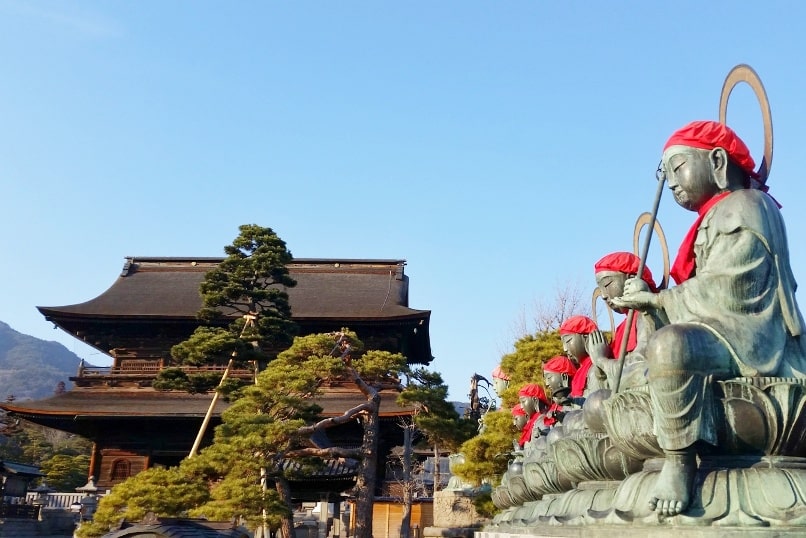
2. Jigokudani snow monkey park

3. Shibu onsen hot spring town

4. Obuse chestnut town
- Samurai training
- Japanese calligraphy class
- Traditional tea ceremony + you get to wear a kimono!
- Ninja lesson
- Make ramen from scratch!
- Sushi making experience
- Sumo training!

5. Hakuba Valley
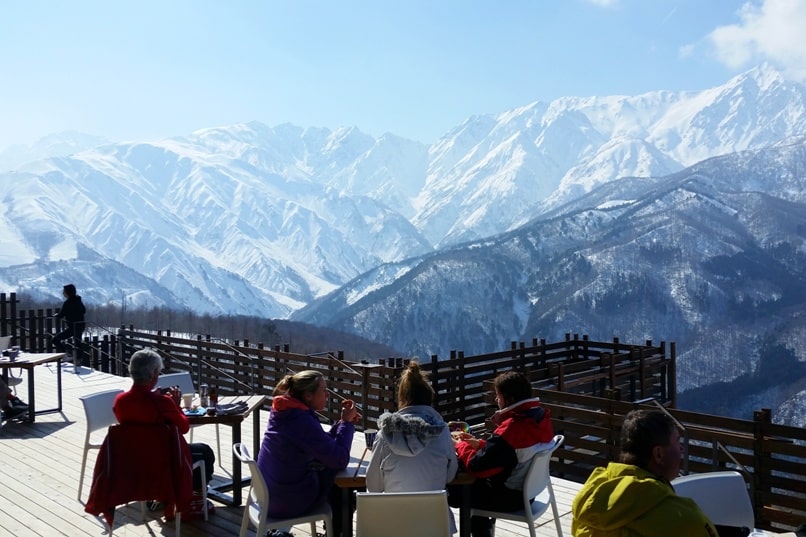
6. Matsumoto

7. Takayama
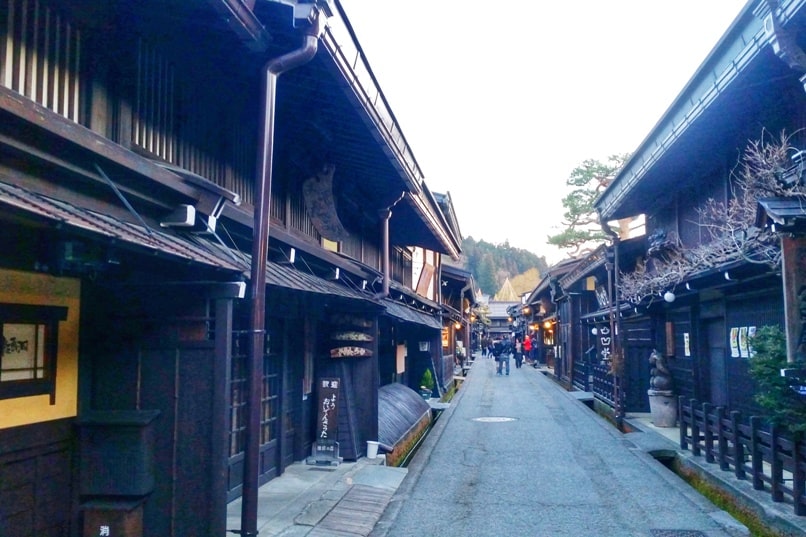
8. Shinhotaka ropeway

9. Shirakawago

So how to make these things a part of your trip to Japan?!
Here is the quick list of the Japan winter itinerary!
Day 1: Tokyo to Nagano
- Tokyo to Nagano by bus (4 hours)
- Overnight in Nagano
Day 2: Nagano
- Jigokudani snow monkey park
- Shibu onsen
Day 3: Nagano
- Zenkoji Temple
Day 4: Nagano to Hakuba
- Nagano city to Hakuba by bus (1.5 hours)
- Overnight in Hakuba
Day 5: Hakuba ski resort
- Happo-one ski resort (gondola ride for winter landscape of snow-capped mountain views if you don’t ski!)
Day 6: Hakuba ski resort
- Iwatake ski resort
Day 7: Hakuba to Takayama
- Hakuba to Matsumoto by train (1.5 hours)
- Matsumoto walk , including to Matsumoto Castle
- Matsumoto to Takayama by bus (2.5 hours)
- Overnight in Takayama
Day 8: Day trip to Shirakawago
- Takayama to Shirakawago by bus
- Visit Shirakawago
- Walk around Takayama Old City
Day 9: Day trip to Shinhotaka Ropeway
- Takayama to Shinhotaka ropeway by bus
- See winter mountain views around the Shinhotaka ropeway
Day 10: Takayama to Tokyo
- Takayama to Tokyo by bus or train
- Overnight in Tokyo
There’s a bit more on how to get around Japan below, but first…
Where to stay in Japan
There are maps and links below (partner websites) to search for hotels in the overnight cities that are a part of this itinerary. Put in future dates into the map, and have a look at hotel prices and reviews!
Since this itinerary uses the snow monkey pass (more on this in a bit) to go places from Nagano city, it can be convenient to stay near Nagano Station which is where you can find the train station and bus station.
I stayed at this hostel that also has private rooms that will give you a Japanese feeling.
For Hakuba, it can be helpful to first decide what it is you want to do here. The ski resorts are kind of spread out, so it will save you time if you stay in an area that will be closest to some of your activities. Some ski resorts might be a 30 minute to 1 hour shuttle ride away.
I stayed at this hostel that also has private rooms. It was located within walking distance of a shuttle bus stop, and they offered a free ride to the train station too.
If you follow this itinerary by going to the suggested day trips, then it will be convenient to stay near the bus station (which is also near the train station).
I stayed at this hostel that also has private rooms, and also gives you a bit of a Japanese feeling. This was a 5-10 minute walk from both the bus station and the old city area. If that’s all booked up, this hostel is a sister property of that one, also in a good location.
To be safe, it would be best to book your flight out of Tokyo on the day after you arrive back. Winter travel can mean an increased risk of delays. You don’t want to feel stressed about having to make it back by a certain time for your flight! (Although this could be a good reason to have travel insurance for those weather related delays !)
Shinjuku is where the main long distance terminal is located, and it’s also the location of a major train station too. This is also a popular Tokyo neighborhood for tourists.
In Shinjuku, I’ve stayed at this more modern hostel . In another area of Tokyo, I’ve also stayed in this hostel right near the Asakusa neighborhood of Tokyo that offered free group activities like cooking classes, and I would also recommend having a look at this hostel that is in Asakusa. This neighborhood can also be nice if you’ll be further exploring Tokyo.
And now…
A few more details about getting around Japan!

Getting from Tokyo to Nagano

To get from Tokyo to Nagano, it’s possible to take a shinkansen train if you want to use your JR pass .
But it’s also possible to get there for cheaper, at least when it comes to individual tickets. (Tokyo to Nagano shinkansen train vs Tokyo to Nagano bus.)
I basically just showed up at the Shinjuku bus station in Tokyo (THE main bus station in Tokyo) and bought a bus ticket to Nagano. I don’t always recommend this approach as it depends on season and destination (you might not get a seat), but it worked out for me at the end of February! The bus was fairly empty.
See more about my trip from Tokyo to Nagano by bus .
Getting around Nagano city area

Day 2: Nagano city
- Shibu onsen, small hot springs town
Day 3: Nagano City
- Obuse, the small chestnut town
Nagano is the name of a prefecture (similar to a state or province), and there’s also a city by the same name. This region was home to the 1998 winter olympics.
When in Nagano city, I bought the 2-day snow monkey pass which is around 3,500 yen (US$30). This included all necessary transportation to and from the famous Jigokudani snow monkey park (there’s a direct bus), and it includes the entry too. This is where you see snow monkeys in the onsen hot springs.
The snow monkey pass also includes transportation to Shibu onsen , which is a small hot springs town. You can visit Shibu Onsen on your way back from the monkey park. (It is kind of a long walk, but I walked there from the monkey park.) The pass also includes transportation to Obuse , which is a small town known for chestnuts. Visiting both of these places can give you a quieter small town Japanese experience.
You can buy the snow monkey pass once you arrive in Nagano, in the basement level of the train station. Follow signs for the Nagano Dentetsu Station.
When you’re in Nagano city, also be sure to visit Zenkoji Temple. This is a famous temple in Nagano.
Nagano is also known for the Japanese noodles called soba . While you can find soba all over Japan, since it’s a specialty here, be sure to have soba in Nagano! You might be able to see them prepare the soba from the street too.

I stayed at a hostel in Nagano which can give you a Japanese feeling type stay – see my photos !
Also see my photos for:
- How to spend 2 days in Nagano
- Walk through streets of Shibu Onsen
- Walk through streets of Obuse
Getting from Nagano to Hakuba

There is a direct bus from Nagano City to Hakuba.
You need to buy a bus ticket before you board the bus. The Nagano bus station is right next to/at the train station. You can buy bus tickets at a store near the place to catch the bus to Hakuba. (You’ll see signs.) It can be better to buy a ticket as soon as you arrive in Nagano, just so you don’t have to worry about tickets selling out. I bought mine on the same day I was leaving though.
Getting around Hakuba

- Happo-one ski resort
Hakuba is a popular ski destination in Japan, as well as a popular snowboarding destination.
Hakuba Valley located in Nagano prefecture, and is a part of what’s called the Japanese Alps or the Japan Alps.
There are a number of ski resorts and snow fields that make up Hakuba, and there’s a Hakuba Valley mountain area pass. This will give you access to all 10 mountains that make up Hakuba Valley including the gondolas and ski lifts, as well as free rides on the shuttle buses that run between the various ski resorts. You can go for 1-day ticket, starting at around 6,100 yen (US$60), through a 7-day ticket. Here are updated prices for the ski lift pass.
You can find ski rentals and snowboard rentals in Hakuba.
Even if you don’t ski, Hakuba can be worth a visit if you are seeking winter landscape! Have a look at taking the gondola at either the Iwatake ski resort (get snacks or a beer at Hakuba Mountain Harbor) or the Happo-one ski resort. You’ll need to buy a round-trip gondola ticket. And without a ski lift pass, the way you’ll get around the various Hakuba ski resorts will also be the shuttle, but that will be around 500 yen (US$5) per ride.
Some of the bigger ski resorts have free shuttles running around the areas too.
I stayed at a hostel in Hakuba that was a short walk from a Hakuba shuttle stop, and it’s also near a train station. See my photos!
Getting from Hakuba to Takayama

To get from Hakuba to Takayama, Matsumoto is basically along the way. Matsumoto has a famous castle, so it could be a convenient stop when you want to visit a castle in Japan!
See more about my trip from Hakuba to Takayama .
Getting around Hida Valley (Takayama area)

- Takayama to Shirakawago by bus (1.5 hours)
- Takayama to Shinhotaka ropeway by bus (2 hours)
- See winter mountain views
Takayama’s old city is a relatively small area you can walk that will give you that “very Japanese” feeling.
Takayama also makes for a good base for day trips by bus. You can make a trip to the UNESCO world heritage site and historic village of Shirakawago. (Google winter pictures for Shirakawago!)
You can also make a trip to Shinhotaka ropeway for more snow-capped mountain views if you didn’t get enough in Hakuba. If you’re interested in winter hiking or snowshoeing, this is a good area to start a trail too. You need to bring your own gear though! Otherwise if want just a casual winter hike, you can walk for 10-15 minutes on the snow-packed trails and then turn around!

See more about my trip to Shinhotaka ropeway on a cloudy day .
Takayama has a specialty “ Takayama ramen ” so be sure to have some of this type of Japanese noodles when in Takayama!

I stayed at a hostel in Takayama , which is another place that can give you a Japanese feeling type stay! It’s also a short walk from the bus station, which is convenient for those day trips!
Getting from Takayama to Tokyo

- Takayama to Tokyo by bus (6 hours)
There is a direct bus from Takayama to Tokyo. It’s best to buy this bus ticket at the bus station as soon as you get to Takayama so you don’t have to worry about bus tickets being sold out.
Otherwise, train is another way to get from Takayama to Tokyo, although it will require a train transfer and will be more expensive. If you plan on further exploring Japan like the traditional Golden Route tourist trail , this might be a time consider activating a JR pass . If riding the shinkansen bullet train is on your bucket list for Japan, this is a time you can take it. (You can also take it at the beginning of this Japan itinerary, from Tokyo to Nagano.)
For the end of the trip, instead of heading back to Tokyo, I moved on to Hokkaido for more of winter in Japan. There was plenty of snow to be seen in Hokkaido even at the end of March!
I went from Takayama to Nagoya by bus to get to the Nagoya airport, and from there took a flight to Hokkaido. (I almost didn’t get a bus ticket, so I would definitely say get this in advance if you’re headed to the airport!)
HAPPY 10 DAYS OF WINTER IN JAPAN!

How to spend winter in Japan
- 10 day winter itinerary with the Japan Alps
- 7 day winter itinerary in Hokkaido
If you're looking for a route for winter in Japan, here are some ideas!
- 10 day Japan winter itinerary
- Tokyo to Nagano bus
- 2 days in Nagano with snow monkey pass // Stay at this Nagano hostel (private rooms available)
- A few days in popular ski resort area Hakuba (go here for at least a day even if you don't ski for the winter landscape in the mountains!) // Stay at this Hakuba hostel (private rooms available)
- Hakuba to Takayama ( Hakuba to Matsumoto train / a few hours in Matsumoto / Matsumoto to Takayama bus )
- A few days in Takayama with day trips: Shirakawago / Shinhotaka ropeway on a sunny day // Stay at this Takayama hostel (private rooms available) and eat regional Takayama ramen
- Takayama back to Tokyo OR Takayama to Nagoya airport to fly to Hokkaido for more winter landscapes!
Hokkaido winter itinerary (train to get around - there are JR Hokkaido passes available, and you can use a regular JR pass too)
- Sapporo to Asahikawa (Asahikawa for penguin walk at zoo)
- Asahikawa to Abashiri (Abashiri for drift ice cruise)
- Abashiri to Obihiro (night in Obihiro and go to Lake Shikaribetsu ice village the next day)
- Obihiro to Sapporo
- Sapporo to Noboribetsu onsen hot spring town (day trip)
- Sapporo to Hakodate // Stay in this Hakodate hostel
- Hakodate to Tokyo on shinkansen bullet train through the underwater tunnel! ( Regular JR pass will be worth it if you take this train ride along with one more long distance train ride within 7 days)
Is a JR pass worth it?!
- Google maps can make it easy to figure out whether or not you should get a JR pass!
- In google maps, type in your departure and arrival city, and choose the transit icon. The route will come up, and so will the estimated cost at the bottom!
- Here is an example of a train route with cost on google maps.
- So do that for all of your long distance routes to figure out how much it might cost.
- Next, go here to see how much a JR pass costs from an official JR pass vendor (and partner of this website).
- And compare!
- Not all forms of public transportation are JR, but long distance shinkansen bullet trains are, and that's where the most cost savings will come.
Best of Kyoto (and Japan!)
- Best temples to visit in Kyoto
- Japanese gardens in Kyoto
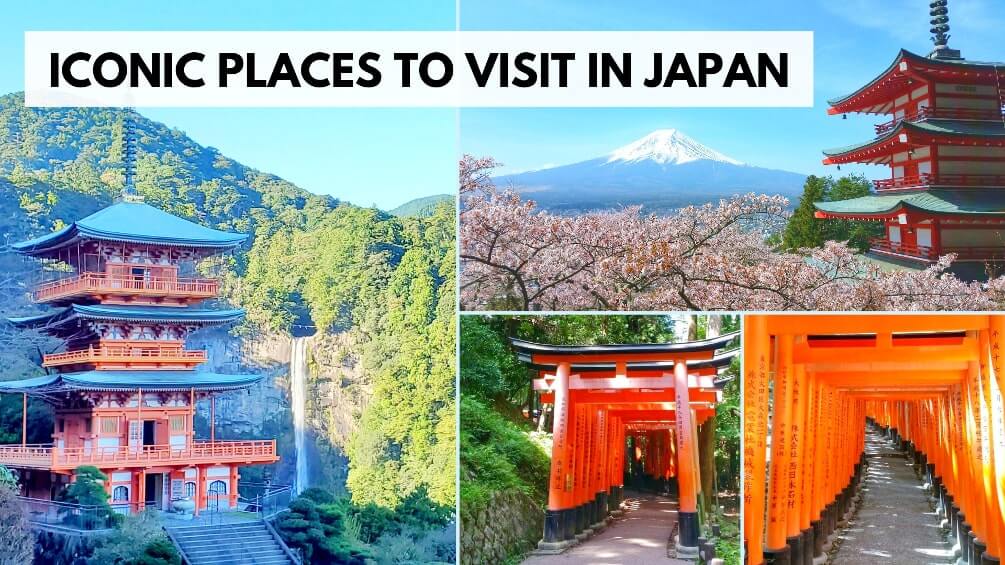
Japan Winter Travel Checklist
While Japan winter travel offers some beautiful scenes of snowcapped temples, frozen waterfalls, and amazing snowscapes. You’ll need to be prepared for how unforgivingly cold it is while sightseeing in the winter.
What’s Japan Winter Travel Like?
Japan’s winters are cold, wet, and often windy. One thing you’ll need to keep in mind when traveling Japan in the winter is that you’re going to be exposed to the elements for long periods of time. Most of the major sights are either outside or centuries-old wooden structures with no heating.
Snow Covered Kiyomizu-dera
You also have to think about traveling between the sights. This often involves being exposed to the cold while waiting at a bus stop or on a train platform. Some platforms have small heated rooms, but this is not guaranteed.
Platform Waiting Room | © DAJF / Wikimedia Commons
Naturally, some parts of Japan are colder than others. The coldest areas are Hokkaido and north of the Japanese Alps on the Sea of Japan side. These areas tend to be a lot colder and get more snow.
Snow Covered Matsumoto Castle | Brian Jeffery Beggerly, CC BY 2.0 , via Wikimedia Commons
However, even in Tokyo, from mid-January to mid-February the temperature can drop by 4 to 6 degrees Fahrenheit in the morning and evening, and is often below 50 degrees Fahrenheit during the day. We’ve put together this Japan Winter Travel Checklist to help you prepare for your trip.
Your Japan Winter Travel Checklist
Warm clothing.
Pack a mix of lightweight and heavy layers.
- Thermal Underwear: Especially if you’re planning on visiting a colder region.
- Warm Coat: We recommend a down coat because they tend to be lighter, warmer, and can be rolled up for packing .
- Gloves: Try to get a pair that match what you’ll be doing in Japan. A pair that’s compatible with a smart phone is recommended.
- Hat or Ear Muffs: You’re going to want to cover your ears, I promise.
- Muffler or Heavy Scarf: We recommend bringing a scarf to protect your neck.
- Thick Socks: Bring plenty of thick socks. When it rains or snows, and your socks get wet, you’ll be thankful you have those extra pairs.
Air Activated Hand Warmers
Comfortable shoes.
Wear shoes that can handle wet and slippery conditions, such as waterproof boots or shoes with good traction.
Light Rain Coat
Japan’s winter months can be wet. Be prepared by packing a light raincoat to throw on if you get caught in the rain, or snow. There is no need to bring an umbrella. They’re easy to find at any convenience store and very reasonably priced.
Medications
If you’re prone to getting sick during the winter, make sure to pack any necessary medications. Japanese drugstores won’t have your brands.
Electronics
We recommend bringing a portable charger to keep your phone, pocket Wi-Fi , and other devices charged while you’re out exploring.
Skincare Products
Japan’s winter air can be dry and harsh on your skin, so make sure to pack lotion, lip balm, and any other skincare products you need to keep your skin hydrated. Don’t expect to find your favorite brands while in Japan.
It’s a good idea to carry between 20,000 yen to 30,000 yen (about $200 to $300 USD) in cash with you, as not all places in Japan accept credit cards .
Travel Documents
Tourists are required to carry their passports at all times in Japan. We recommend keeping it on you in a safe dry place.
Want a Unique Japan Trip?
Discover Japan planning secrets with our best selling Itinerary Planning Course . Or inquire about our exclusive Small Group Tours .
Enjoy Your Trip
Japan is one of the most hospitable countries we’ve ever lived. As always, we recommend that you go into your trip with an open mind, wide eyes, and a respect for the culture you’re visiting.
Disclaimer: There are affiliate links in this article. This means that if you make a purchase after clicking on these links, we may receive a small commission at no extra cost to you. We have no association with the companies or the products reviewed. These are our own opinions of top travel products.
You might also like
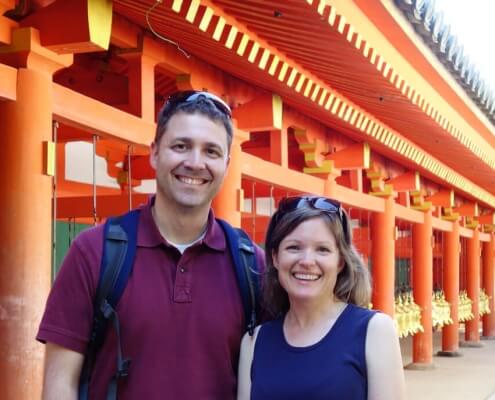
Becki and Shawn Japan Travel Specialists
Hi, we’re Becki and Shawn! We love Japan and are truly passionate about Japan and Japan travel.
We’ve lived, worked, and traveled in Japan for 20+ years, so we know where to go, what to see, and how to get there. Join us in Japan for an adventure of a lifetime!
Accreditations
- Japan Tours
- Destinations
- Experiences
- Travel Tips
Reviews & Recommendations
This site uses cookies. By continuing to browse the site, you are agreeing to our use of cookies.
Cookie and Privacy Settings
We may request cookies to be set on your device. We use cookies to let us know when you visit our websites, how you interact with us, to enrich your user experience, and to customize your relationship with our website.
Click on the different category headings to find out more. You can also change some of your preferences. Note that blocking some types of cookies may impact your experience on our websites and the services we are able to offer.
These cookies are strictly necessary to provide you with services available through our website and to use some of its features.
Because these cookies are strictly necessary to deliver the website, refuseing them will have impact how our site functions. You always can block or delete cookies by changing your browser settings and force blocking all cookies on this website. But this will always prompt you to accept/refuse cookies when revisiting our site.
We fully respect if you want to refuse cookies but to avoid asking you again and again kindly allow us to store a cookie for that. You are free to opt out any time or opt in for other cookies to get a better experience. If you refuse cookies we will remove all set cookies in our domain.
We provide you with a list of stored cookies on your computer in our domain so you can check what we stored. Due to security reasons we are not able to show or modify cookies from other domains. You can check these in your browser security settings.
We also use different external services like Google Webfonts, Google Maps, and external Video providers. Since these providers may collect personal data like your IP address we allow you to block them here. Please be aware that this might heavily reduce the functionality and appearance of our site. Changes will take effect once you reload the page.
Google Webfont Settings:
Google Map Settings:
Google reCaptcha Settings:
Vimeo and Youtube video embeds:
You can read about our cookies and privacy settings in detail on our Privacy Policy Page.
Travel Japan Like a Pro
" * " indicates required fields
- Destinations
- Travel Tips
- Travel With Us
- Paid Travel Internship
- TTIFridays (Community Events)
- SG Travel Insider (Telegram Grp)

8-Day Japan Winter Itinerary For Less Than S$1.2k — Fox Village, Snow Monkey Park, Gassho Houses
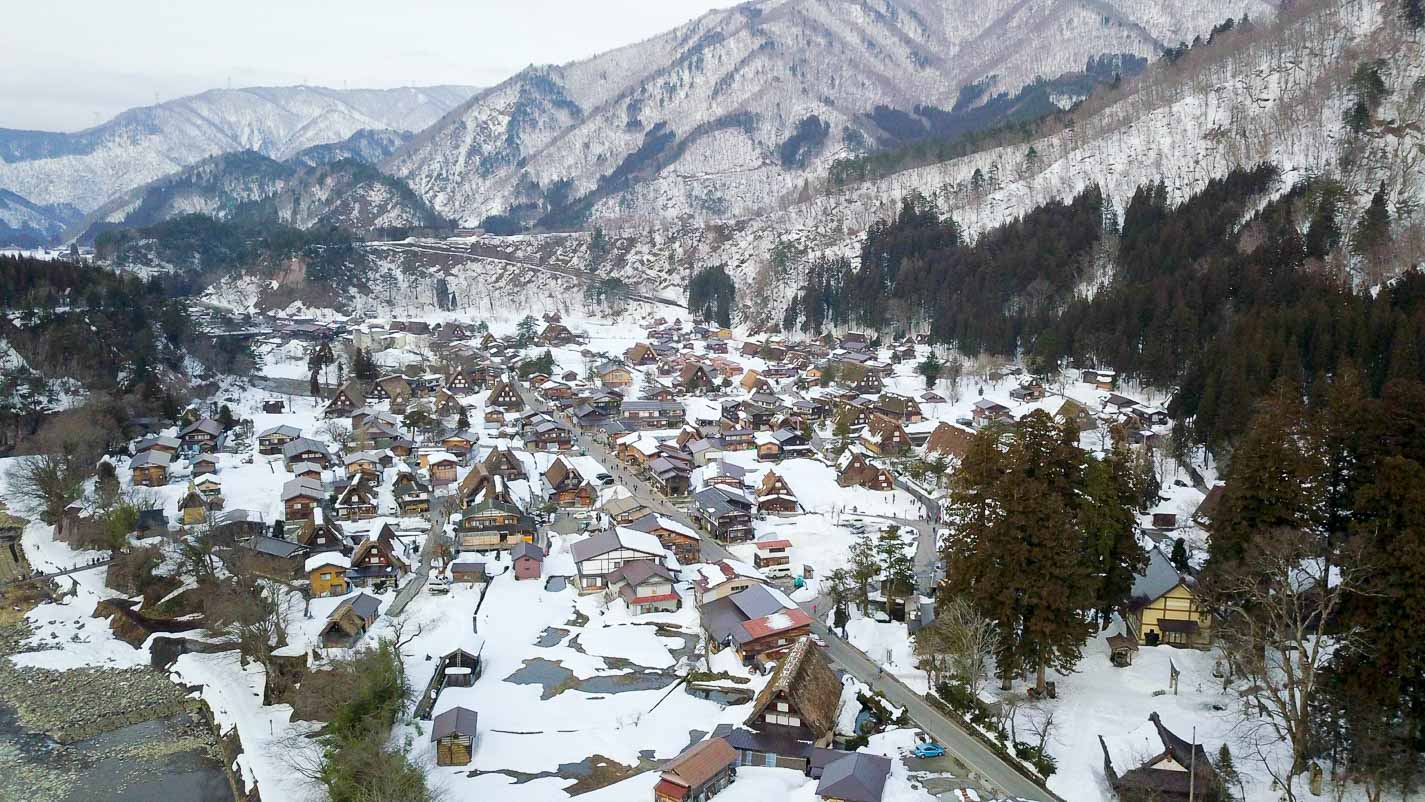
Key highlights include winter must-sees like Zao Fox Village, Jigokudani Snow Monkey Park and the charming snow piled Gassho-styled roofs in Shirakawa-go. Find out how to maximise your JR Pass on a trip to Japan in winter!
Japan is one of those places that’s ideal to visit regardless of the season but after over four trips to Japan , winter is perhaps our favourite — visiting onsen s with Snow Monkeys bathing in them, a village where foxes tumble in snow or curl up for an afternoon nap and experiencing the warm hospitality in a traditional gassho house.
Planning to experience winter in Japan? Here’s how to make the most of Japan during winter with the 7-day JR Pass!
Travelling on a budget with the 7D Whole Japan JR Pass
Update on December 2023: Prices have increased for the JR Pass since October 2023. Find out more in our JR Pass guide .
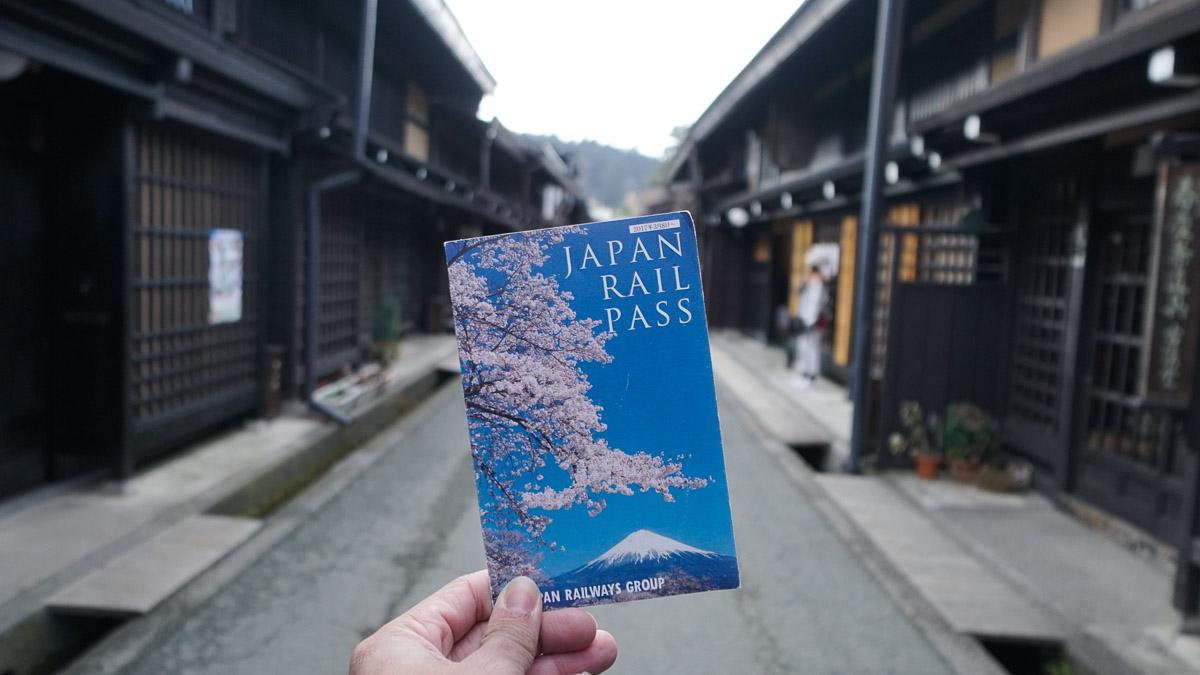
Travelling with the JR Pass is one of our favourite ways of travelling in Japan. While a round trip from Tokyo to Osaka already exceeds the value of one, we’ve taken the challenge upon ourselves to stretch the value of the JR pass and use it to help us discover beyond Tokyo and Osaka; and all without stretching the budget too much 😛
JR Passes can cost a lot but for the sights we wanted to cover, the Whole Japan JR pass saved us a total of S$330 ( Click here for the breakdown )!
Starting from Tokyo, we did day trips to the Zao fox village , attempted to catch sight of Mount Fuji at Kawaguchigo , chilled out with the snow monkeys in Nagano and even stayed a night in the traditional Gassho houses of Shirakawa-go before heading to Kansai where we took our flight out for under S$1.2k! (Incld. accommodation, exclud. flights)
This may not be the cheapest way to spending 8 days in Japan but for the experiences we wanted to leave with, I think we worked out a pretty fair budget. Hope you find our Japan winter itinerary useful!
Budget Breakdown:
Accommodation: ¥23,100 Transport: ¥49,580 (Incld. 7D Whole Japan JR Pass ) Activities: ¥11,50 Food: ¥15,500 Misc: ¥3000 (For SIM Card and Lockers)
TOTAL FOR 7D: ¥102,730 ($1231.77)
Check Flights to Tokyo
We didn’t include flight prices in the budget because they vary depending on your date of travel. To get a better estimate of your total budget, check flights here first:
Check flight prices from Singapore to Tokyo here if you can’t see the widget above.
First Time to Tokyo?
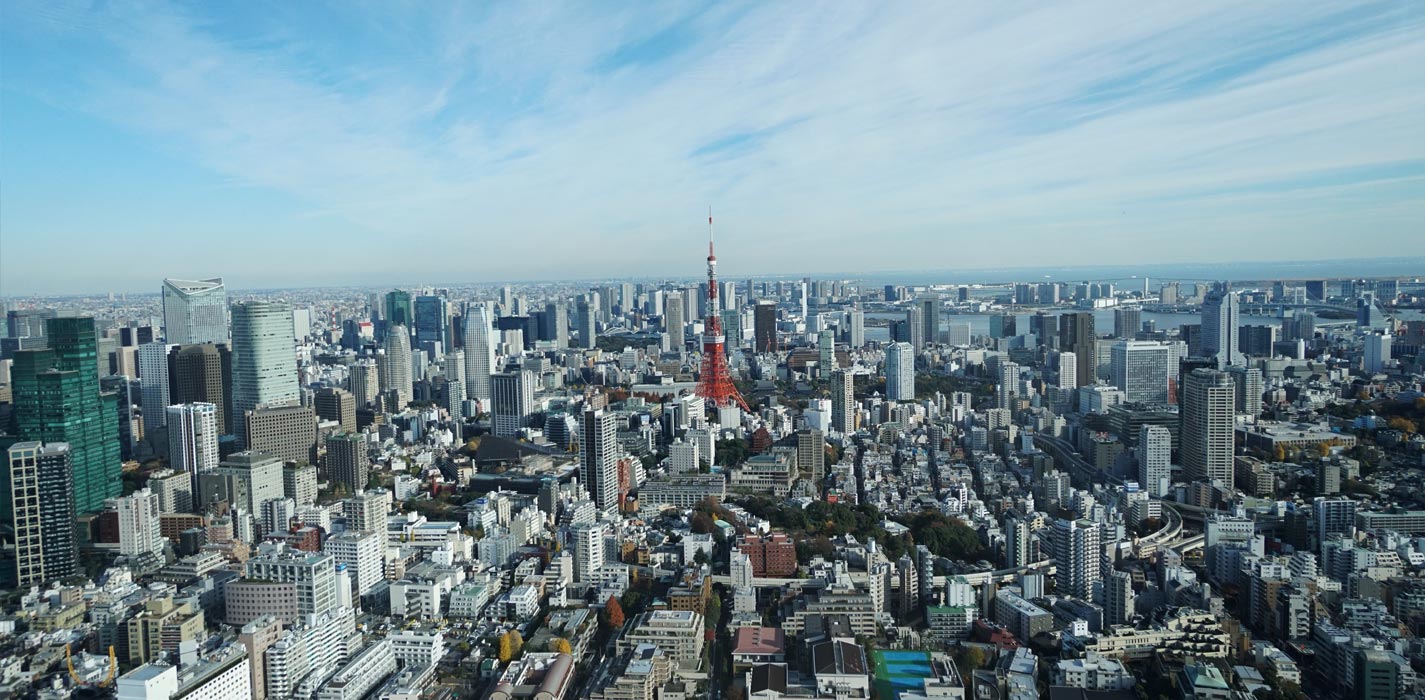
Tokyo has a plethora of activities ranging from quirky to hipster. If you’re planning to spend a couple of days in Tokyo, ask to activate your JR Pass on a later date when collecting your JR Pass at the JR East office in Narita. Ideally, you should begin when you’re ready to take the pass on consecutive day trips out from Tokyo. To get from Narita Airport to Central Tokyo, purchase the Keisei Airport Skyliner as it’s cheaper than the Narita Express (N’EX).
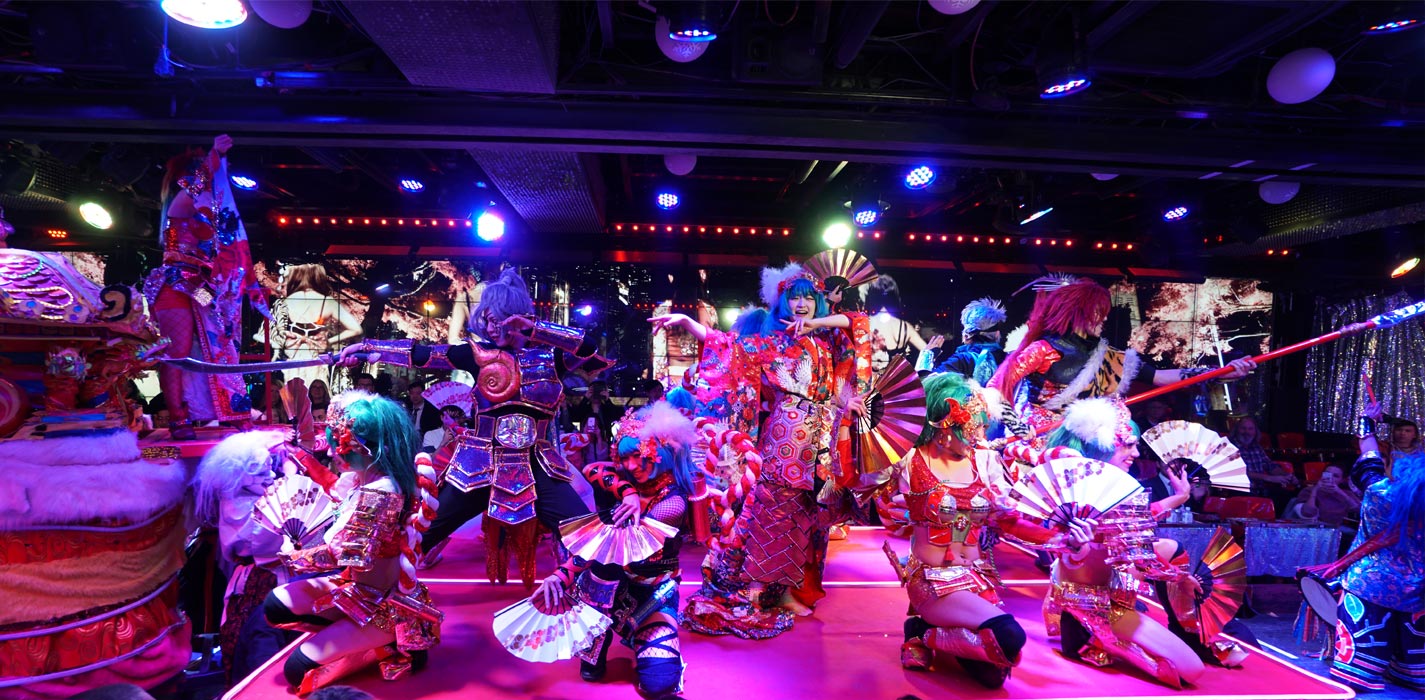
Check out 24 hours in Tokyo for the quintessential Tokyo experience or our Quirky Tokyo Guide for the fun and bizarre stuff!
If you’re activating your JR pass on your first day like us, make seat reservations for the next N’EX to get to Tokyo station. This train is covered by the JR Pass.
Staying connected: Don’t forget to prebook your 4G SIM Card . Comes in 1GB (for 6 days), 3GB and unlimited (both for 8 days). If you’re staying longer than 8 days, perhaps a portable WiFi might be more convenient.
Day 1: Tokyo Day Trip to Zao Fox Village
Accommodation in Tokyo: Wise Owl Hostel Tokyo (only 1 station away from Tokyo Main station which is perfect for making day trips out of Tokyo) — ¥2,300 for a dorm bed
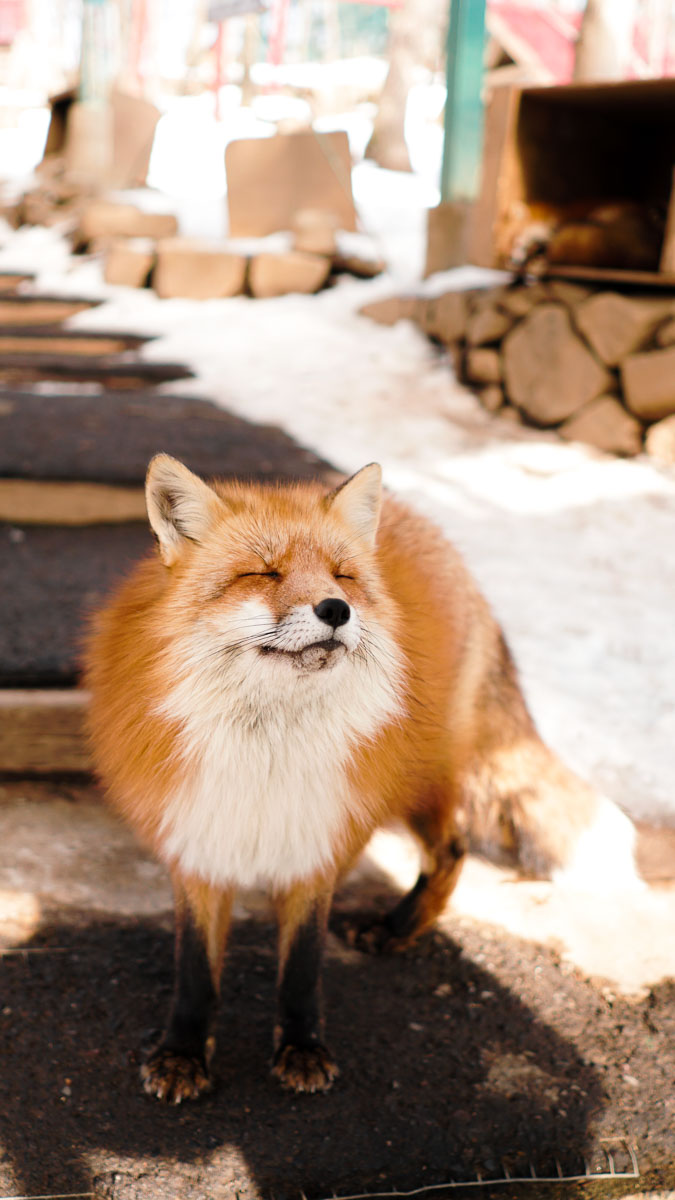
2 hours north-east of Tokyo in the Miyagi prefecture is a village where foxes roam. I know that sounds quite dreamy but after visiting for ourselves, I have mixed feelings about the place.
There are 2 parts to the “village”. Right after you purchase your entrance ticket (¥1000), the first thing you see is foxes either tied on a leash or kept in cages of various sizes. Some are kept in because they’re sick but one section of foxes are kept as designated huggers. For ¥400, you can hug, pet and carry one of these foxes; which I personally found quite sad because most of the time they would be tied up or kept in a tiny confined space.
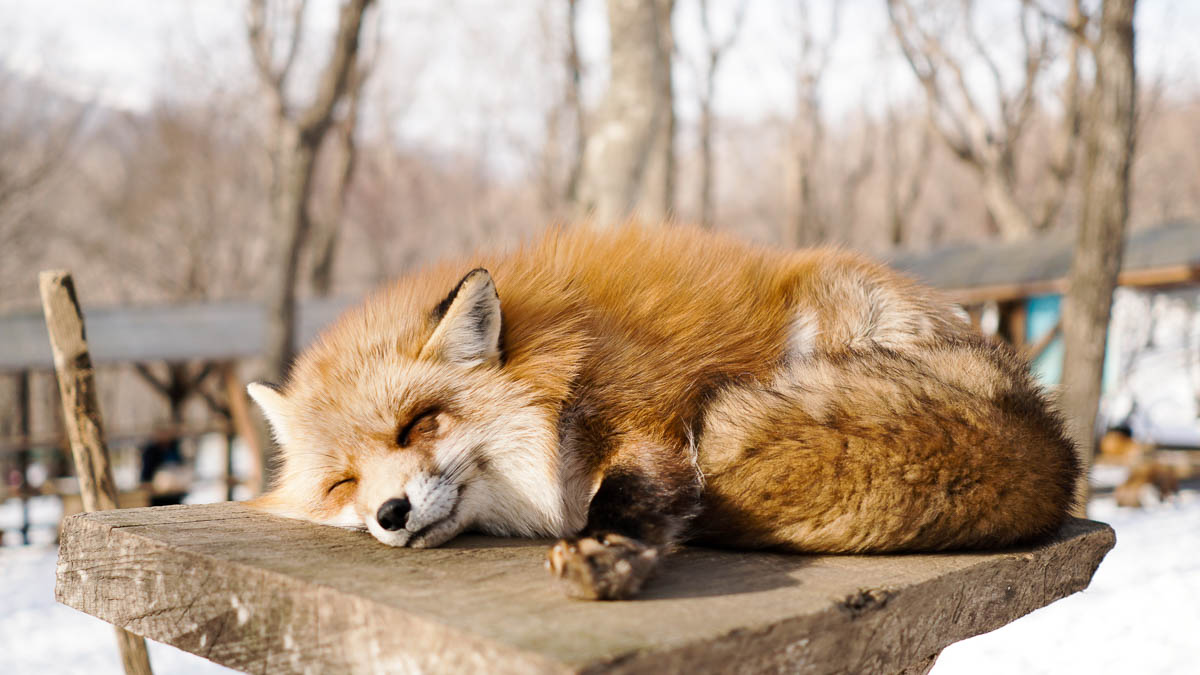
The other part is a lot better although it’s still a fenced up area. Foxes here have more space to roam and you’ll see most of the foxes rolled up into balls of fluff, taking a nap in the wooden crates by the staircase. There’s a lot of space here but foxes aren’t meant to live together by nature so you’ll see a lot of them with injuries on their head or tail from fights.
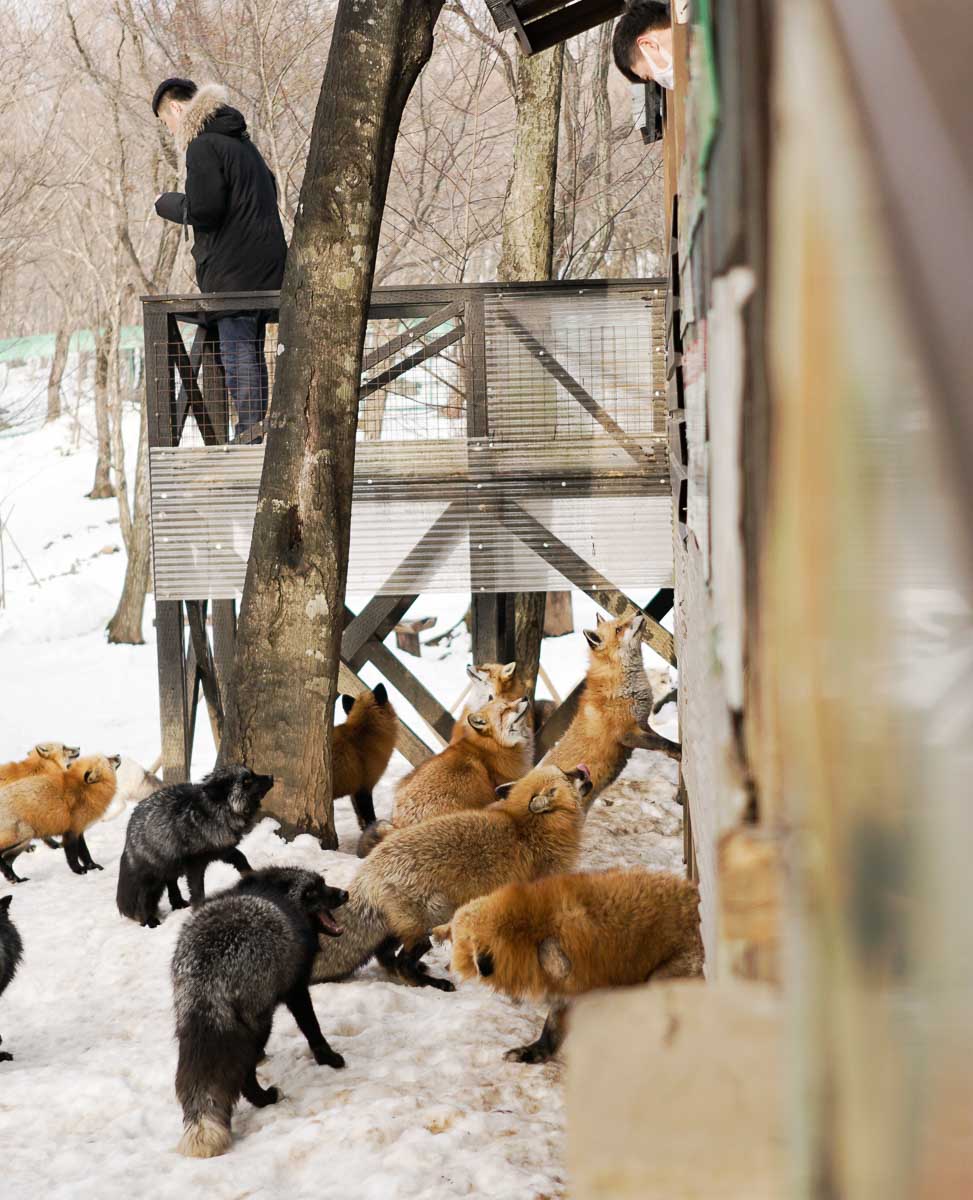
There’s a feeding platform where you can bring your ¥100 pack of feed (from the entrance) and you’ll see hoards of foxes crowding below looking up eagerly. It’s an adorable sight, until you throw the food over the ledge and watch the foxes growl and wrestle aggressively over the few morsels you’ve just released.
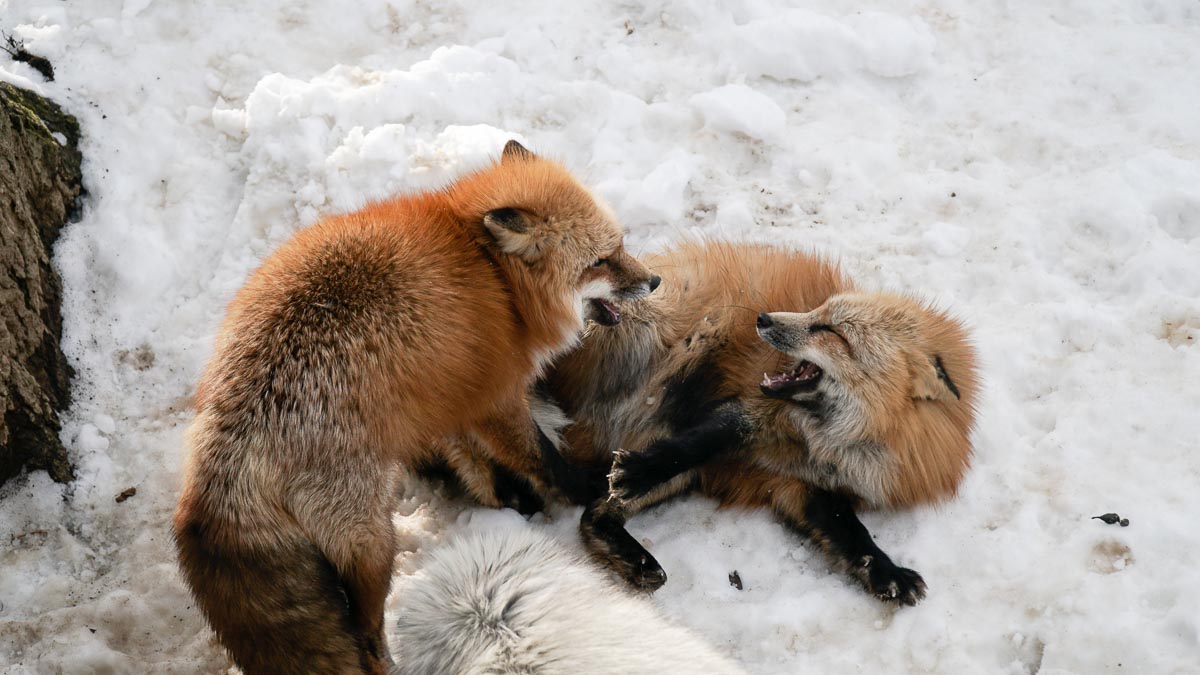
It makes you wonder if their injuries are a result of such proximity or if they would be the same in nature. We did enjoy walking through the areas far from the feeding platform where foxes would playfully take a jab at each other or approach you to chew on your shoe lace (don’t let them! Unless you’re alright walking away with half your shoe lace gnawed off).
Entrance fee: ¥1000 How to get there: From Tokyo station, take the Yamabiko Shinkansen to Shiroishizao station and take a 20min taxi to the fox village (¥4200). Opening hours: 9AM – 5PM (last entry at 4:30PM)
*Pro-tip: On the way back, ask the other guests if they would like to share a cab back to Shiroishi-zao station to split the cab fare.
DAY 2: Tokyo Day Trip to Kawaguchi
Accommodation in Tokyo: Wise Owl Hostel Tokyo
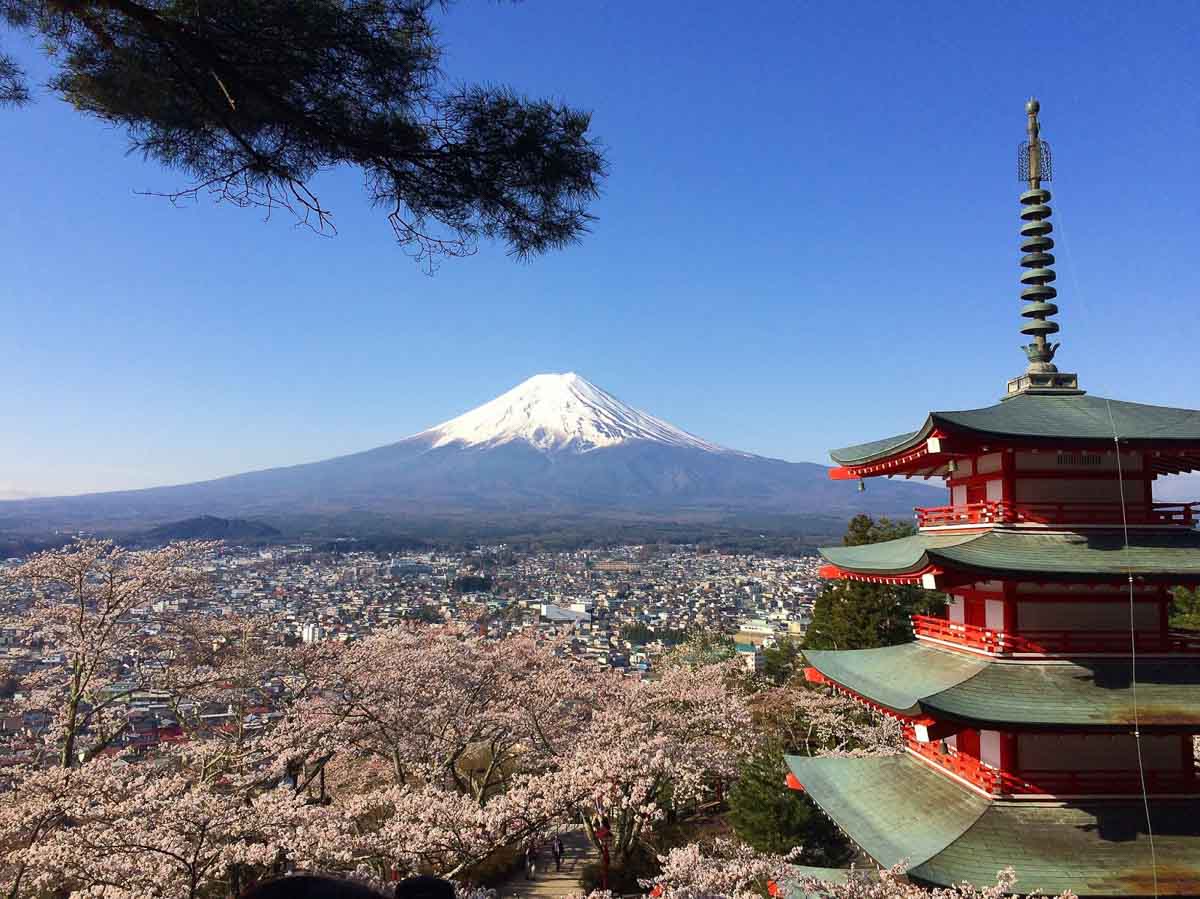
Another key winter experience is catching sight of Mount Fuji from one of 5 Fuji Lakes. We picked Kawaguchi, a quiet town 2 hours from Tokyo. You can use your JR Pass to get to Otsuki station before transferring to the Fujikyu line to get to Kawaguchi-ko station.
Before you arrive at Kawaguchi-ko station, you might want to make a stop at Shimoyoshida. From the station, there’s a popular lookout point of mount Fuji from the back of Chureito Pagoda which takes 397 steps to get to.
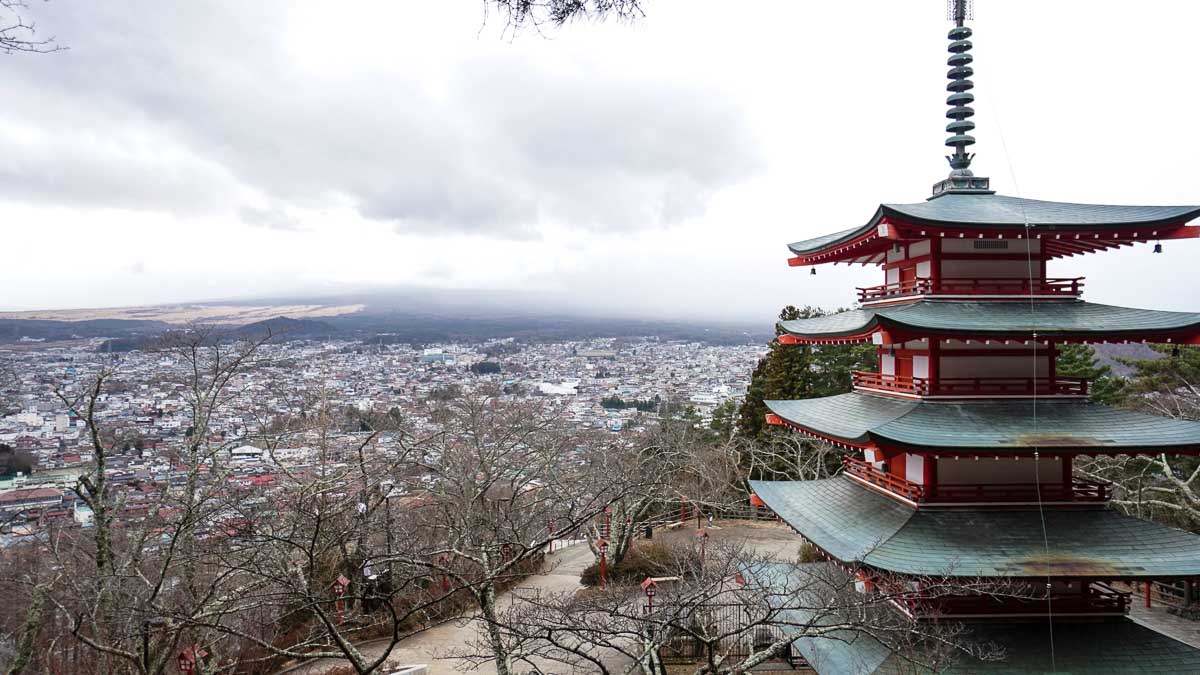
Unfortunately our luck with the weather was pretty bad on the trip and the elusive Mount Fuji was no where to be seen. Do a quick check on the weather before deciding on this day trip or else a trip here is pretty sad if the weather is bad.
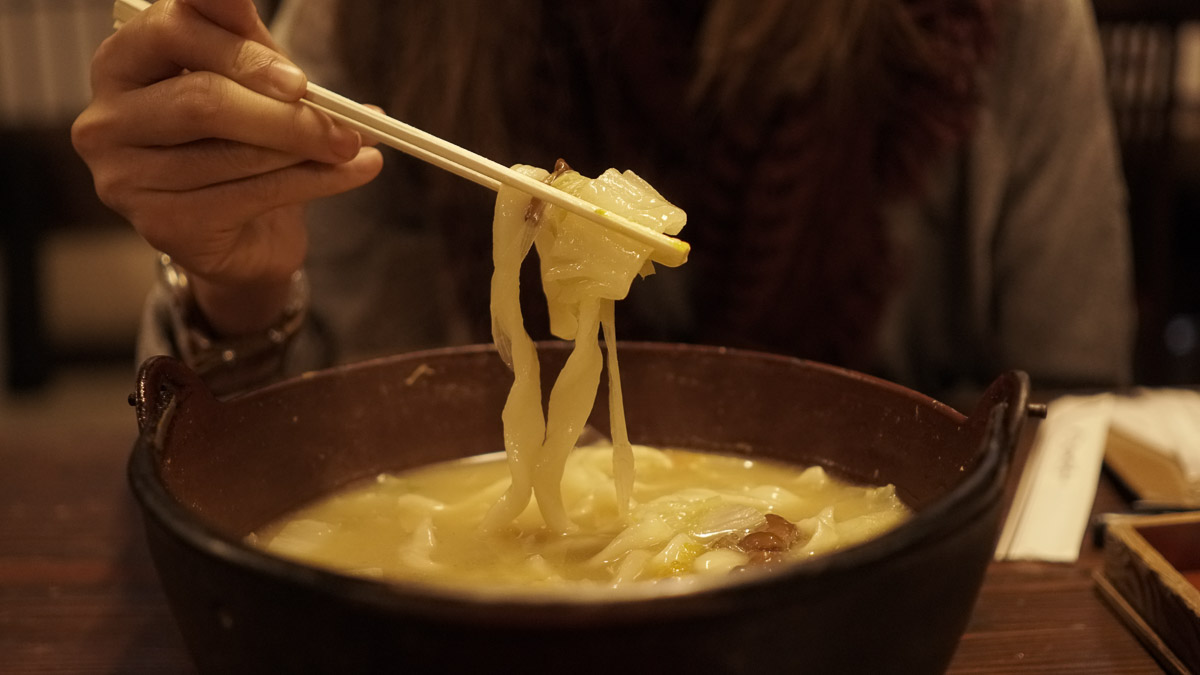
Our only saving grace was probably this hearty bowl of Hoto noodles — a Kawaguchi specialty of springy handmade noodles and probably one of the best dishes to have in winter. The most famous shop is Hoto Fodo located just across the road from Kawaguchiko station.
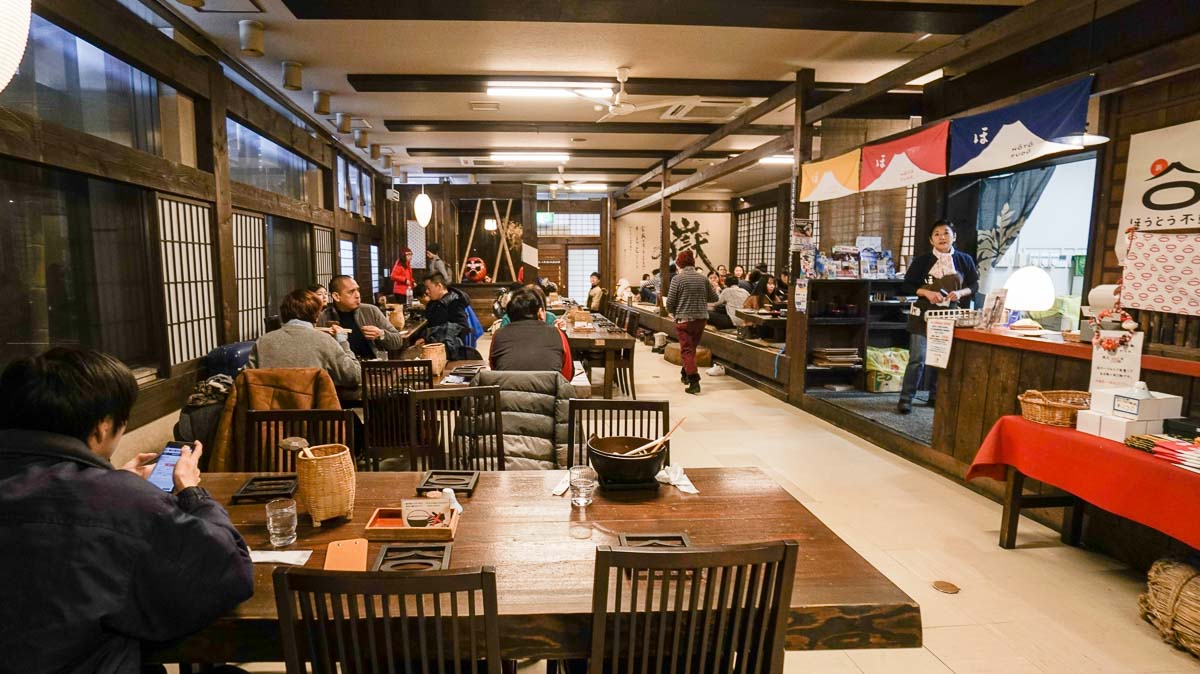
Set in a cosy restaurant, the noodles here are said to be the most traditional version of all and only served in one variation; a miso vegetable soup (¥1080). A common ingredient in all Hoto noodles is a slice of pumpkin which doesn’t stand out a lot but adds a nice touch to the whole dish.
If you like more variety, there’s another restaurant: Hōtō kenkyūjo (ほうとう研究所) located near the Kawaguchi Music forest which has Hoto with a generous serving of seafood including crab and lobster legs (¥1380 – 1980).
How to get there: Take the shinkansen to Otsuki, from Otsuki, switch to the Fujikyu line and get off at Shimoyoshida, then Kawaguchiko station. The JR Pass covers the ride from Tokyo to Otsuki station.
DAY 3: Nagano
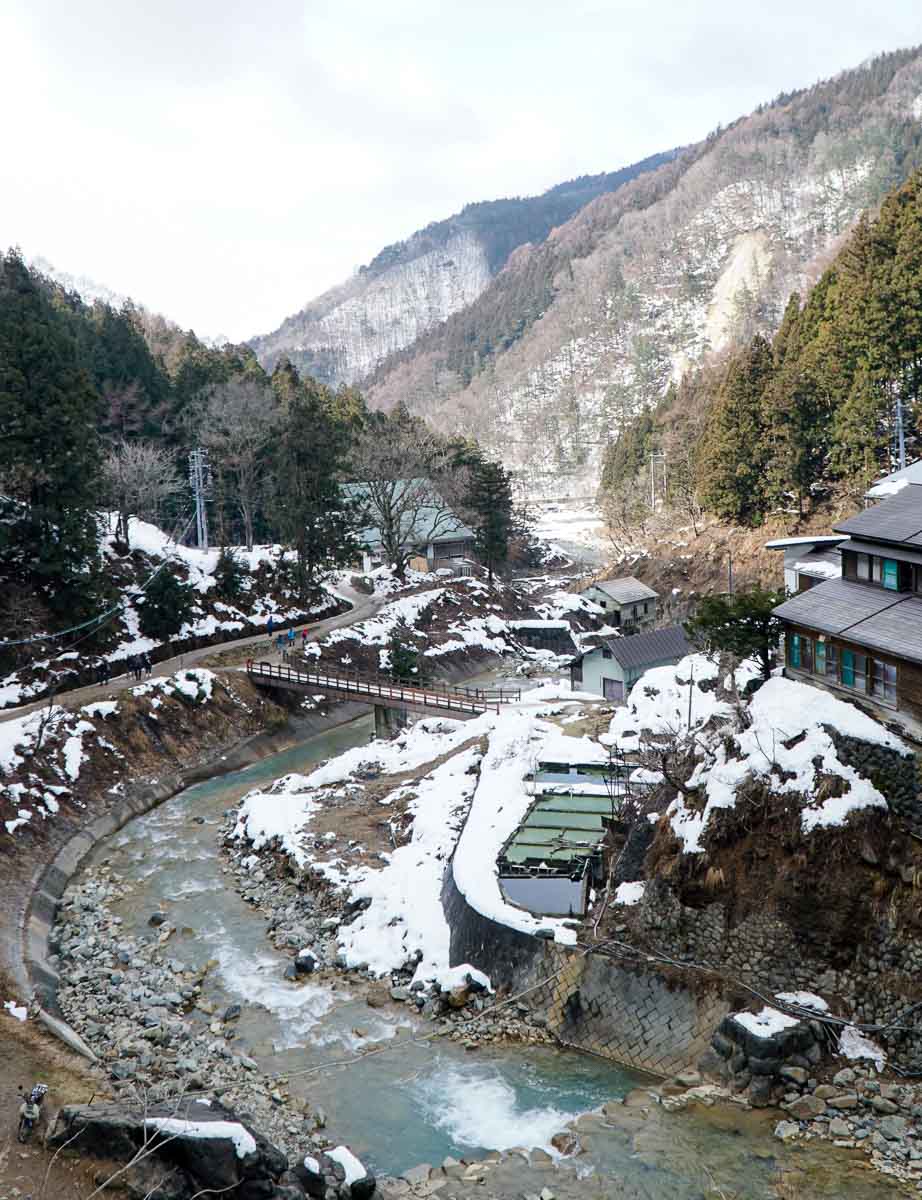
Host of the 1988 Winter Olympic Games , Nagano is a mountainous region most famous for the snow monkeys who definitely know how to enjoy life. It might be hard to believe at first but the onsen pools here are in fact reserved for the monkeys only.
Jigokudani Snow Monkey Park
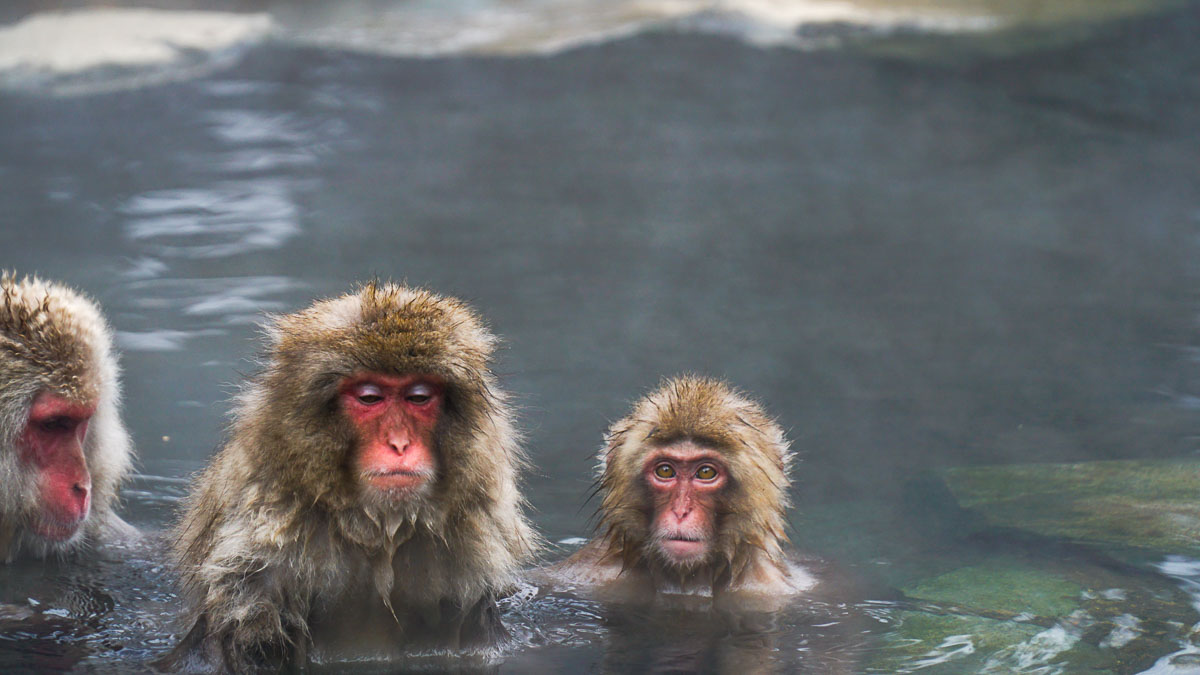
From Tokyo, pack your bags and set out early for Nagano. You can leave your luggage in the many lockers available at the train station. The JR pass covers your ride from Tokyo to Nagano station via the Hokuriki shinkansen (90 minutes). Then hop over to the Nagano Dentsu station where you can purchase the 1 day Snow Monkey Pass (¥3,200) .
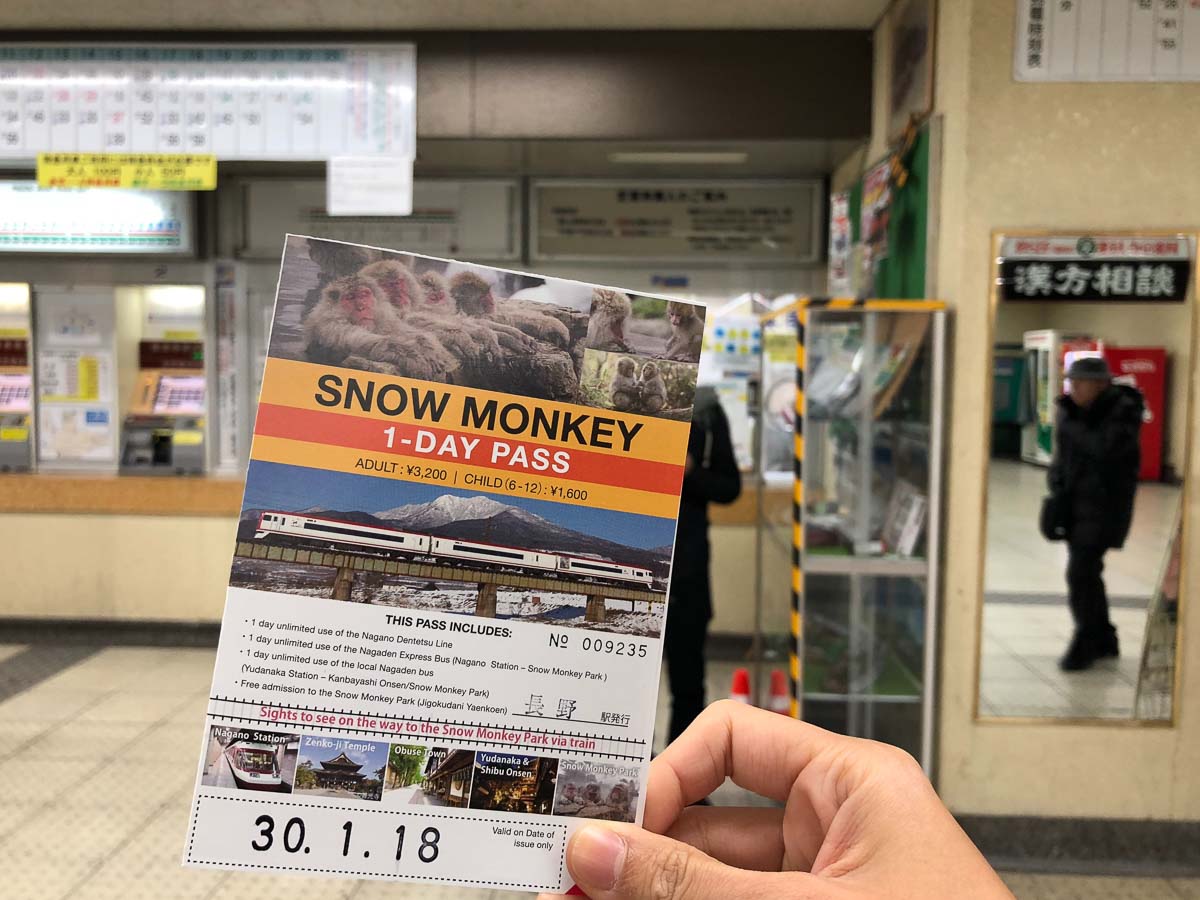
This covers the express bus that will transport you both ways between Nagano station and the Snow Monkey Park in 45 minutes. The pass also includes the entrance fee (¥1000) to the Snow Monkey Park.
From the drop off point, there’s a 20-minute walk to the entrance of the park.
There’s only one main onsen pool and you’ll see lots of monkeys as well as people crowded around.
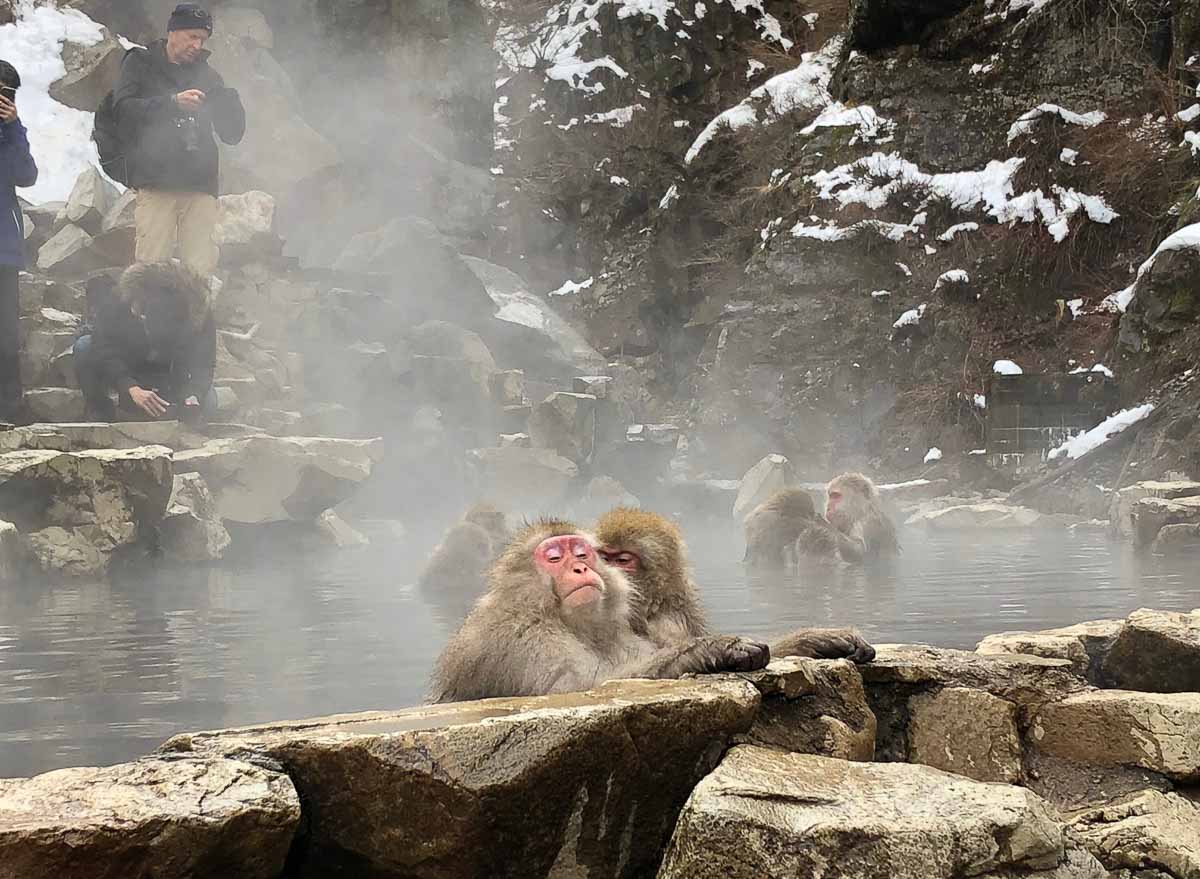
The Monkeys here are wild but are totally chilled and don’t really mind if you’re taking photos of them. However, do be a bit more weary of those with babies hanging on them as they tend to be a bit more paranoid and protective of their little one.
Do note that this is only for the monkeys!
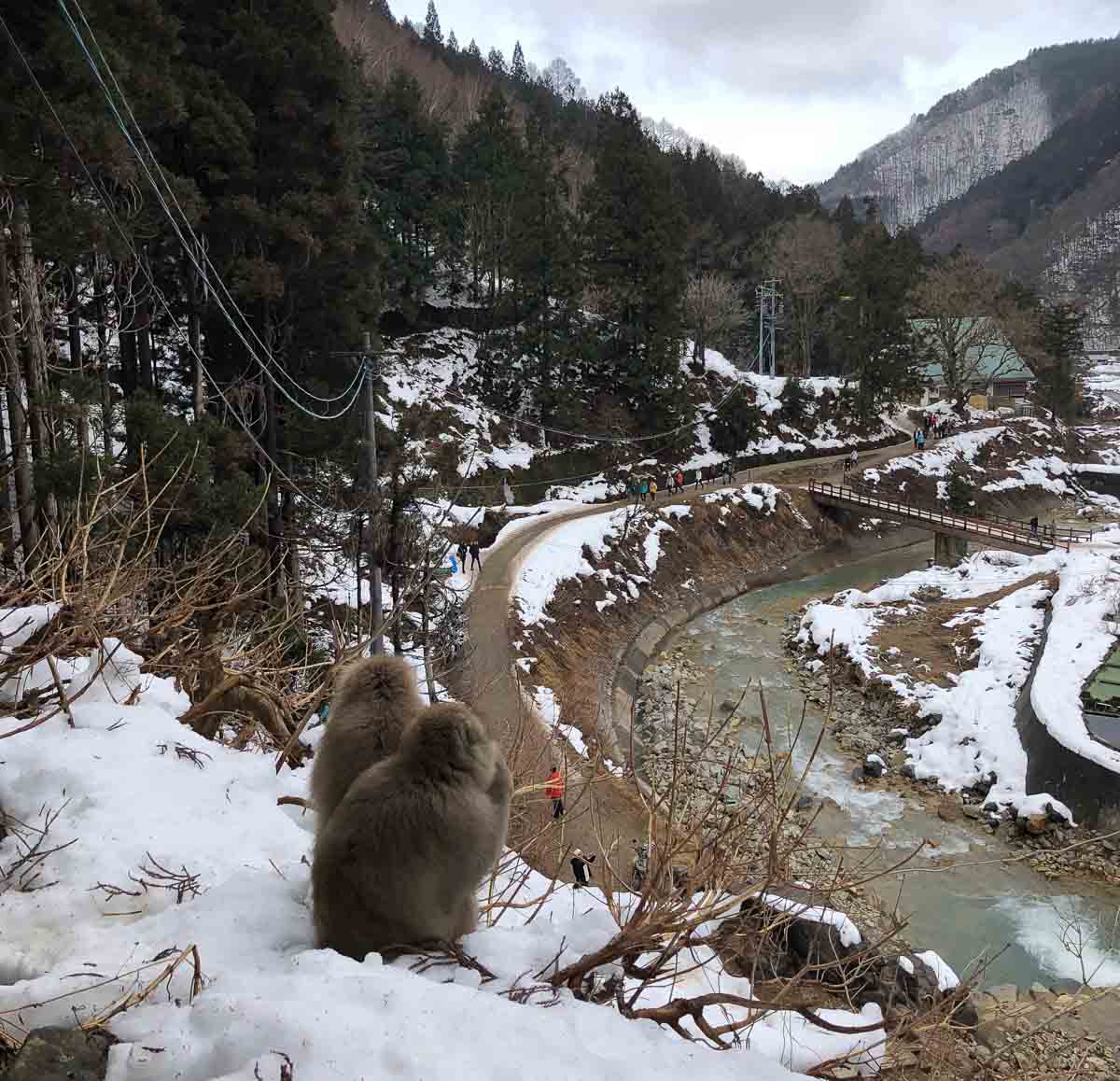
For the humans, you can take a dip in nearby Kaede no Yu , Shibu Oyu , or Wakuwaku no Yu onsens for ¥300 – 500.
How to get there: Take Shinkansen from Tokyo to Nagano (90mins). Purchase a 1 day snow monkey pass for ¥3200 from the Nagano Dentsu station and hop on the Express bus that goes direct to the Snow Monkey Park (45 minutes).
You can stay a night in Nagano at the many onsen resorts but we took our bags from the lockers and continued on to Takayama (2.5 hour train ride).
*Alternative Route to from Nagano: Take Shinkansen to Kanazawa (60mins), spend the night and take a 1.5hour bus to Shirakawago the next morning. From Shirakawago, it’s a 50 minute bus ride to Takayama. If you’re taking this route, you can swap Day 4 for Day 5.
DAY 4: Takayama
Accommodation in Takayama: J-Hoppers Hida Takayama — ¥2,700 for a spacious dorm bed
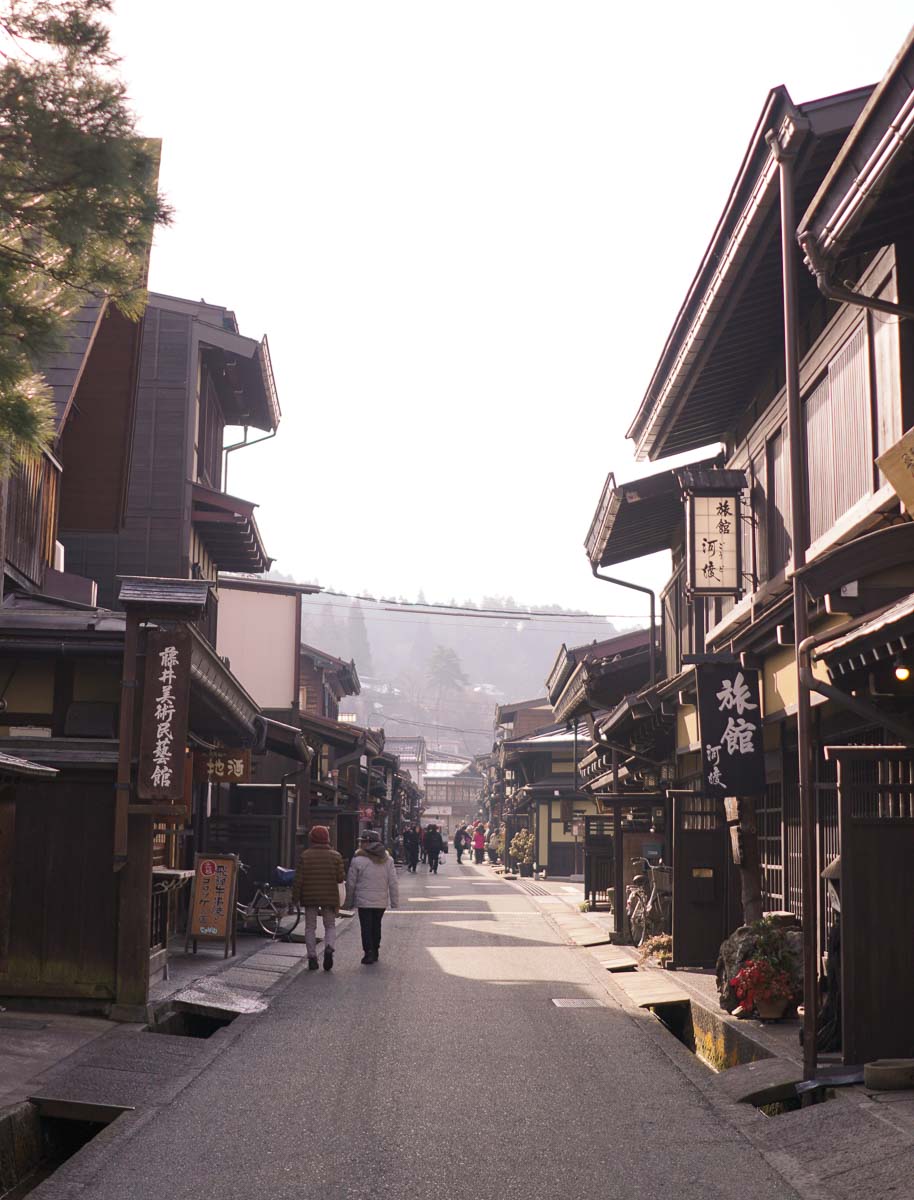
One of Japan’s best preserved towns, Takayama is a popular winter destination for it’s charming Edo-style neighbourhood that’s even more charming when covered in snow.
But as our cursed luck with the weather continues, the snow had just melted off about 2-3 days before we arrived. Despite having almost no snow in sight, I still found the place rather enchanting and the perfect stopover before we visited the ultimate winter wonderland — Shirakawa-go.
Morning Markets
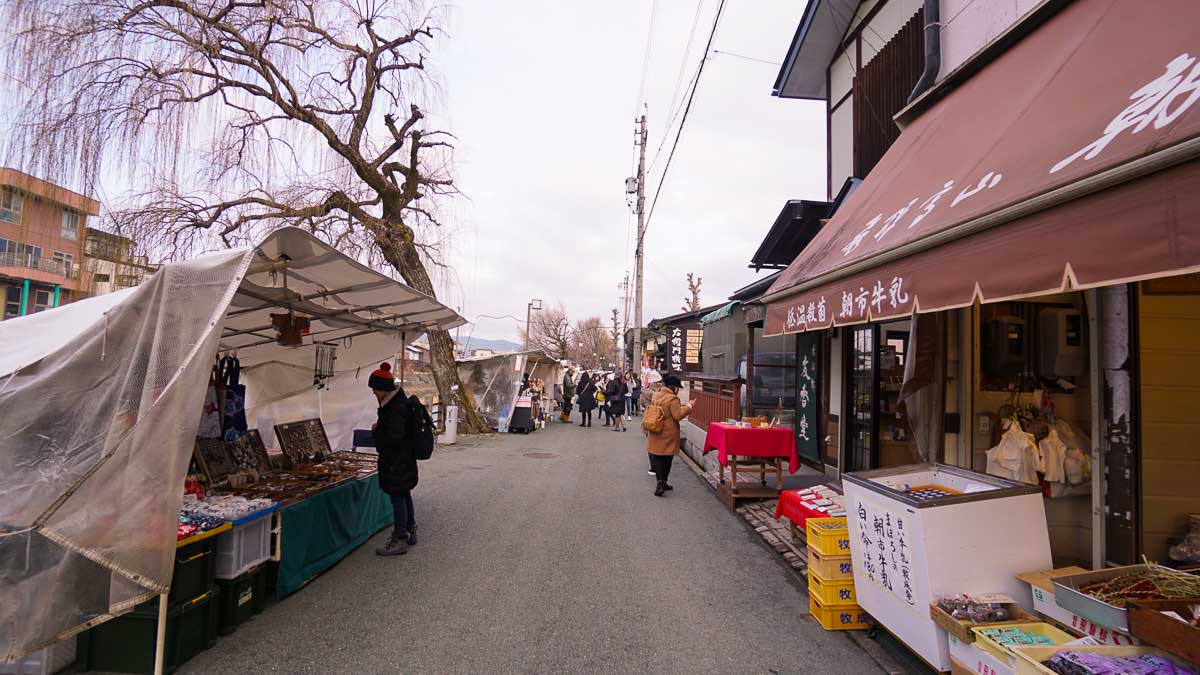
Starting from 8AM, head to either the Miyagawa or Jinya Mae morning market and you’ll see locals setting up stalls by the Miyagawa river.
From traditional snacks like rice crackers to quirkier finds like wasabi chocolate and coffee in a cookie cup, here’s a good place to pick up a gift or two. There’s also seasonal vegetables, wooden crafts and a woman folding really complex origami.
Opening Hours: 8AM – 11AM
Hida Kotte Aburi Sushi
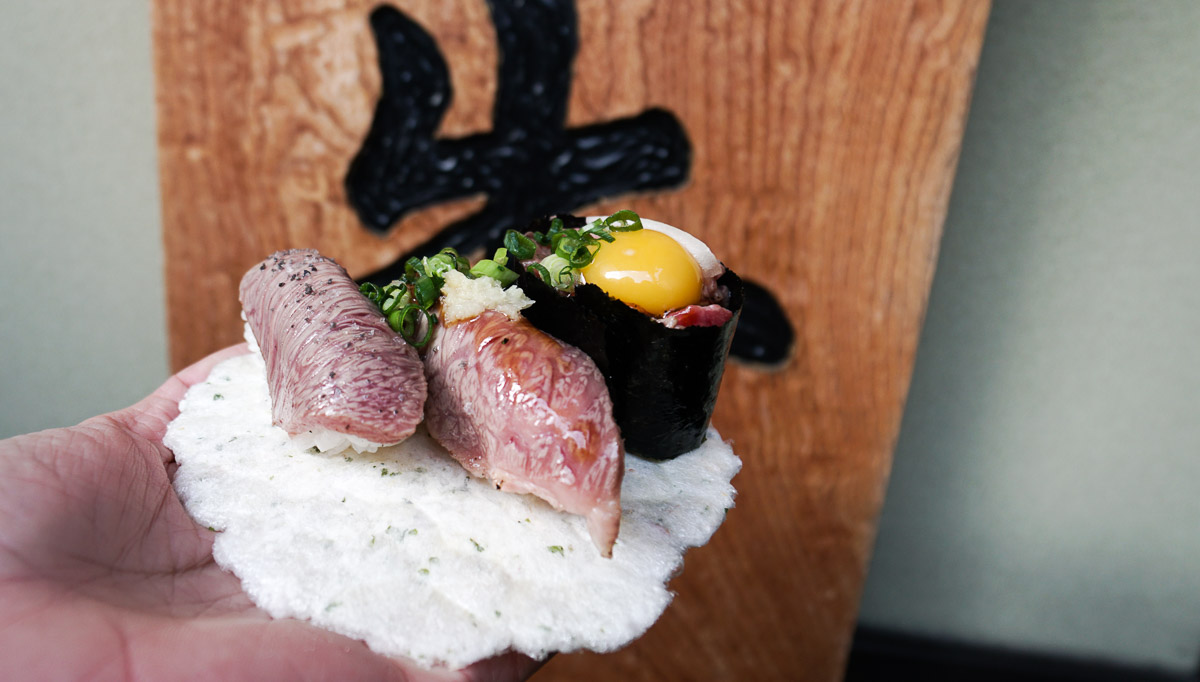
One of the most famous delicacies in Takayama is Hida beef and you can find various beef eateries around the town. But an interesting one is the Hida Kotte snack bar. Beef is partially cooked with a blow torch and served sushi style on a piece of crispy rice cracker. Pick from 3 options: ginger soy sauce, salt or gunkan (warship) style with a raw egg on top. A set of all 3 costs ¥900 but trust me, it’s worth it!
Other recommended beef places to check out: Manpukutei ($), Suzuya ($$) and Ajikura ($$$).
Cost: ¥600 – 900 Opening Hours: 10AM – 5PM Address: Kamiyano Town Takayama City Gifu Prefecture 34
Free Sake Brewery Tours
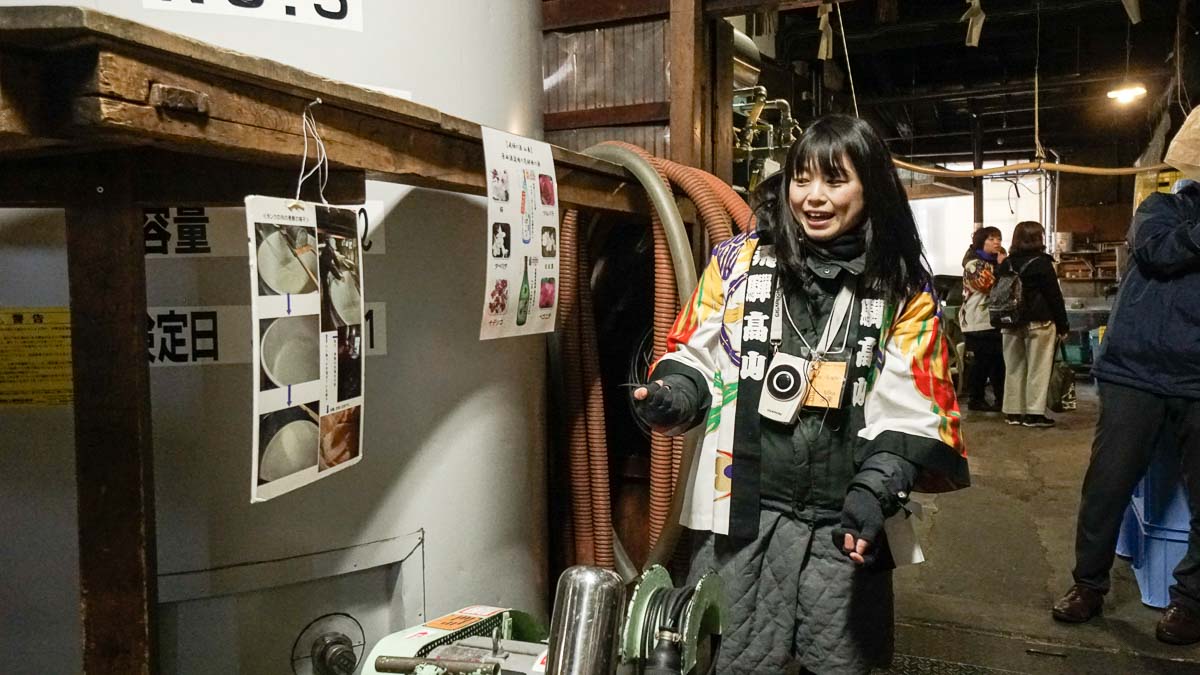
At 3000m above sea level, Takayama’s perpetual cold climate makes it perfect for brewing sake. There are various local breweries around the old city and from 19th Jan – 3rd March, they’re taking turns to run free tours of their sake making facility .
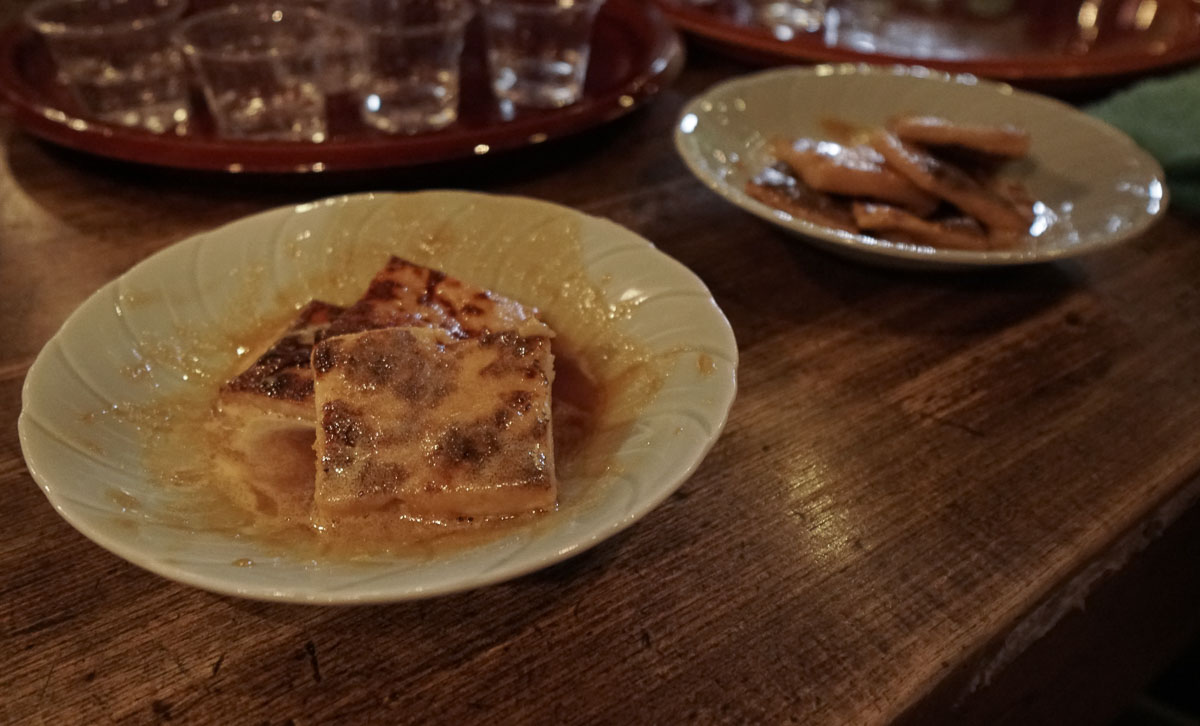
We were there in the first week and did our tour at Harada Sake Brewery . The tour honestly isn’t much but it was quite cool to find out what they did with the left over fermented sake (Sake Lees).
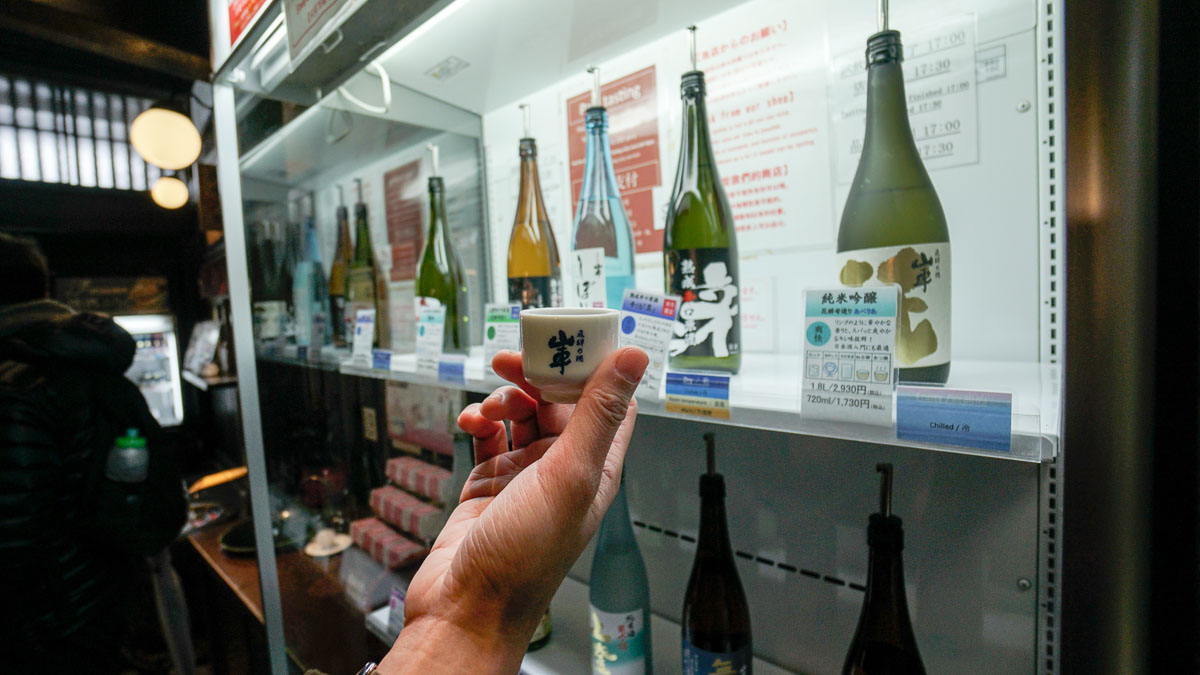
But perhaps our favourite part of all was the sake tasting 😛
There’s a tasting fridge with around 15 different sakes and you can try them all just by purchase a sake cup for ¥200 (yes you get to bring this home). We loved it so much we ended up buying a bottle home too.
Tour timings: 10AM – 12PM, 1PM – 4PM Address: Various breweries around the old city
Visit Shirakawa-go
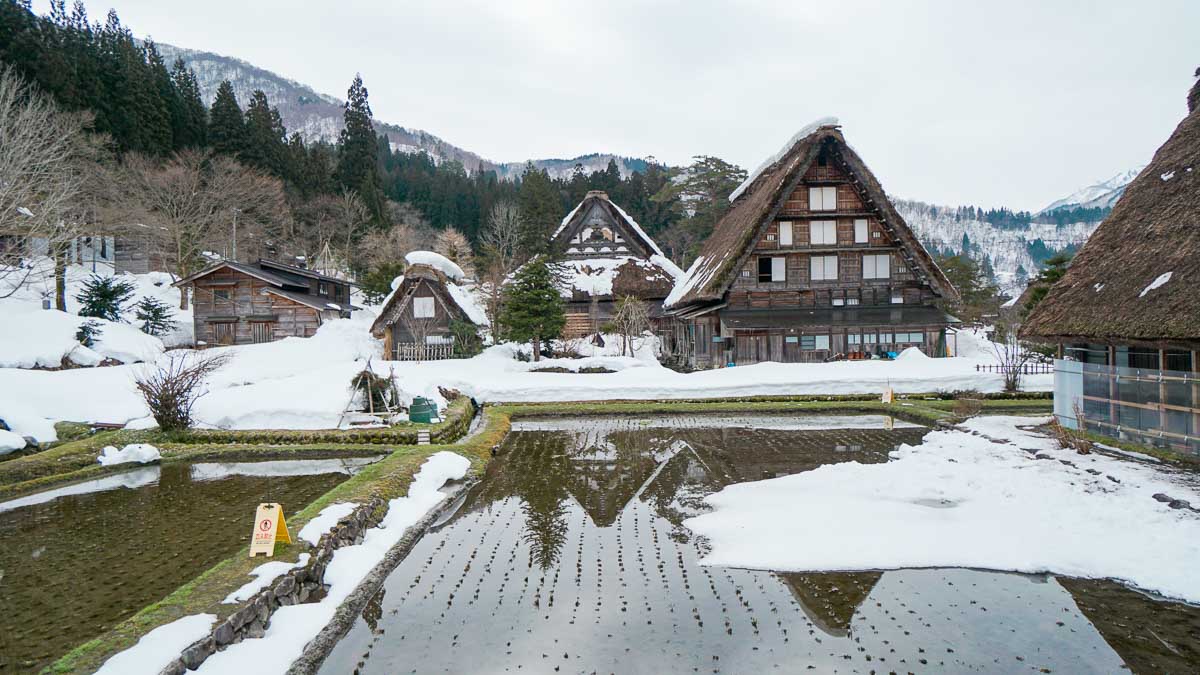
If you aren’t planning to stay the night in Shirakawa-go, J-Hoppers Hostel (where we stayed) offers half day bus tours there for ¥3900. It leaves once in the morning and another in the afternoon. For us, we decided to spend a night in Shirakawago. You can take the highway bus from the Nohi bus terminal right next to Takayama station (¥4420 round trip). Check the timings for the Nohi Highway bus here .
DAY 5: Shirakawa-go
Accommodation in Shirakawa-go: Shimizu Inn — ¥9,500 – ¥13,000/pax includes dinner and breakfast
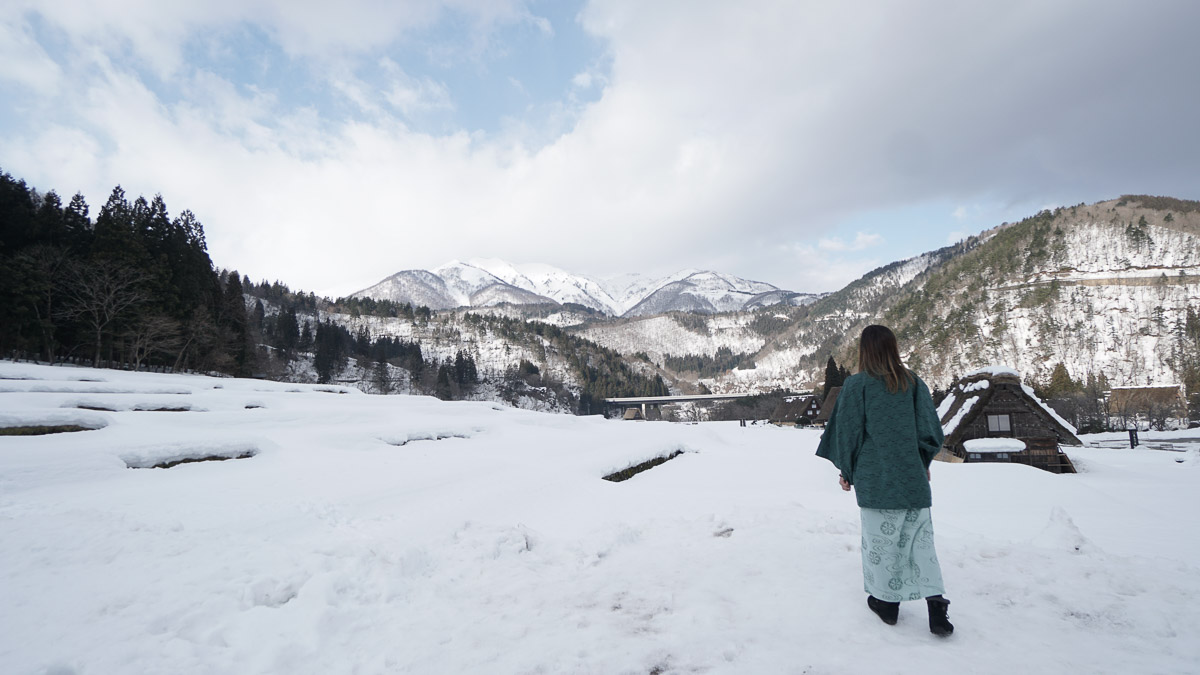
A UNESCO World Heritage Site, Shirakawago (白川郷) receives quite a bit of snowfall every winter. In order to avoid snow buildup on the roofs, the gasshō-zukuri style homes you find here can be spotted with high straw roofs with steep slopes on each side giving the entire town a dreamy winter wonderland look.
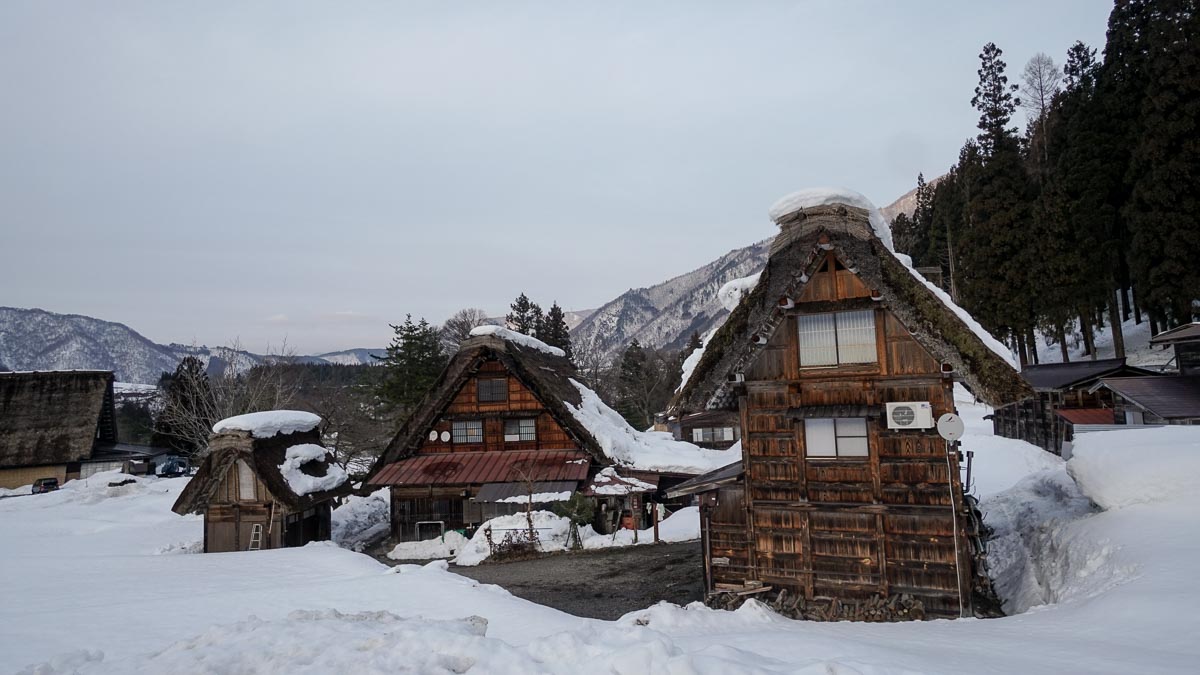
There really isn’t much to do in the town but a key experience is staying in one of these traditional gasshō-zukuri guesthouses. They’re super popular during the Dec – Feb period so book early if you’re planning to stay.
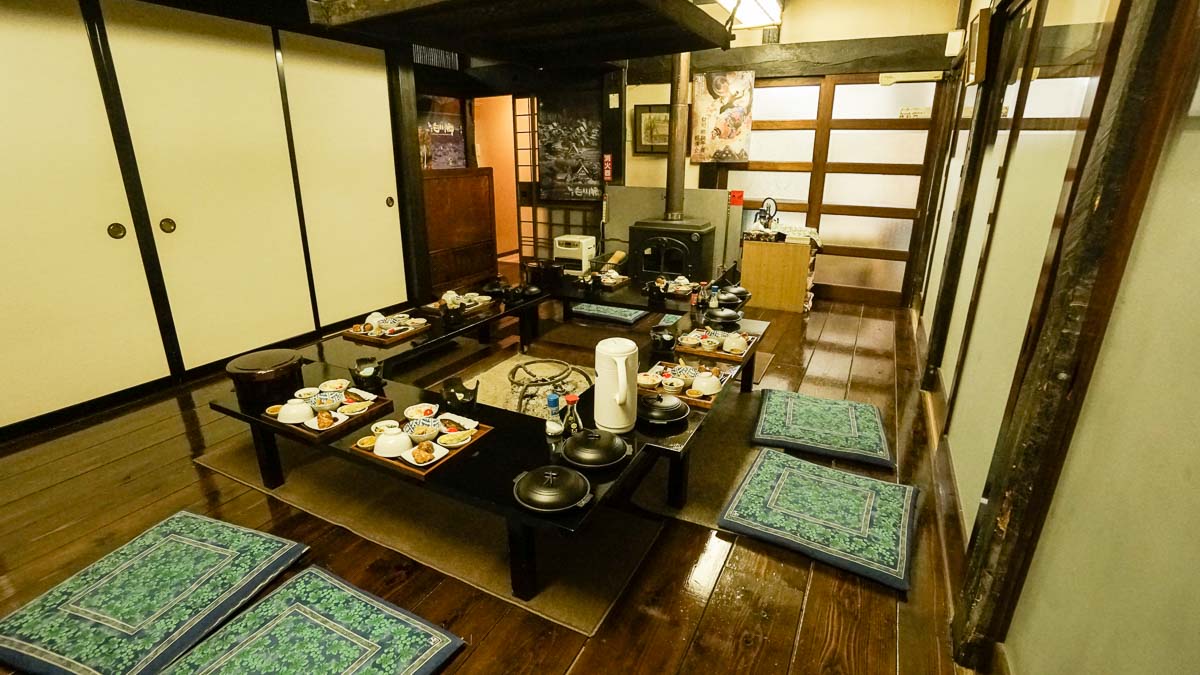
There are no restaurants in the area so your accommodation will usually include 2 meals for each night you’re staying (dinner and breakfast).
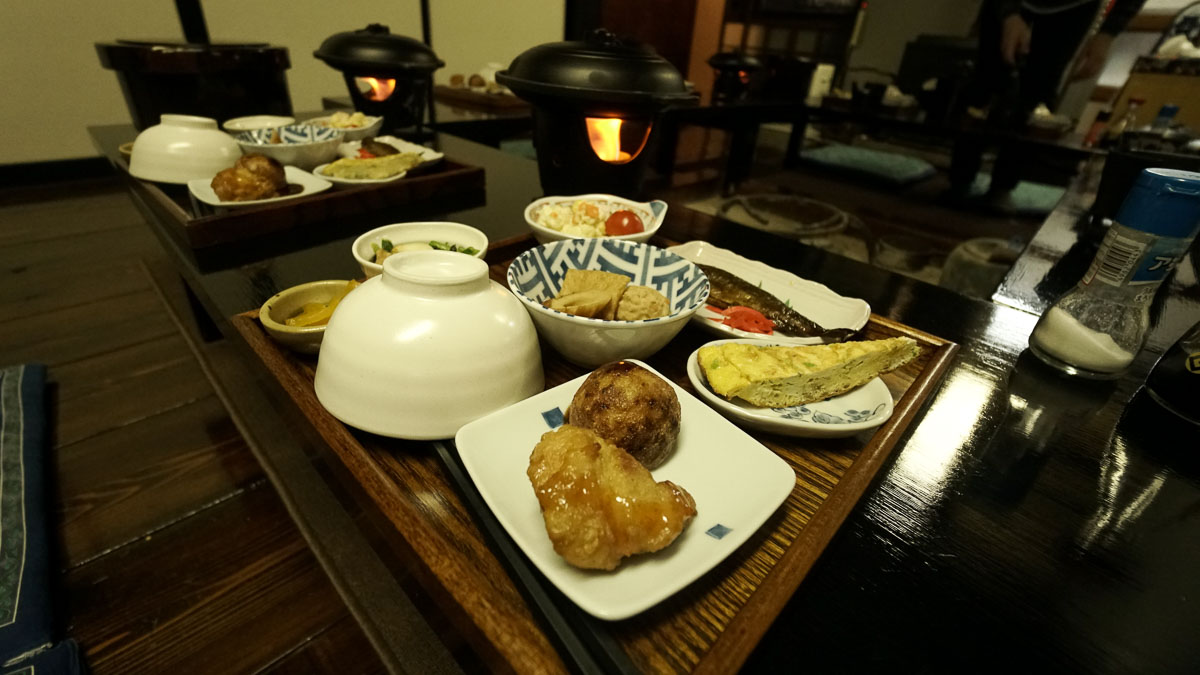
I loved how homely the meals were with little servings of many varieties. Be careful though, the servings may look small but it adds up and you’d be stuffed before you know it.
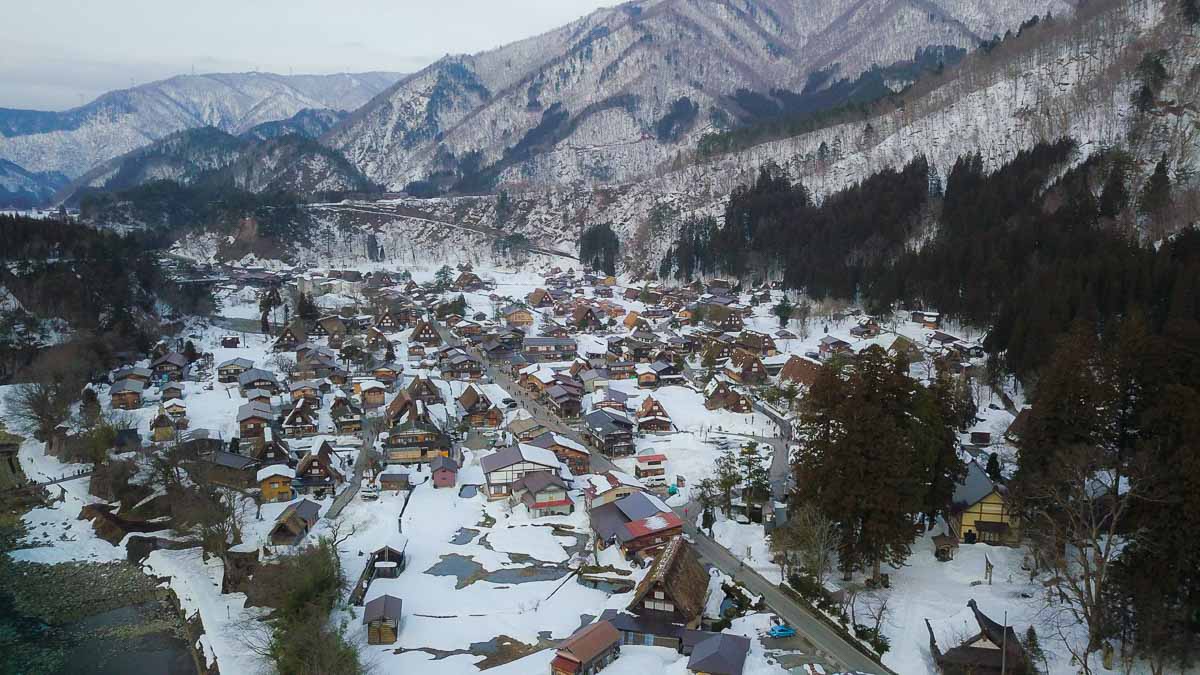
In the day, you can take a shuttle bus (¥200) to the observatory for a unobstructed view of the village.
Leaving Shirakawago: From the bus terminal you can take the bus to 3 nearby cities: Takayama (50 minutes), Kanazawa (75 minutes) or Toyama (80 minutes).
The train ride to Kyoto is 135 minutes from Kanazawa, 163 minutes from Toyama and 182 minutes from Takayama.
DAY 6: Kyoto
Accommodation in Kyoto: Wasabi Kyoto Soba Hostel — ¥1,700 for a dorm bed (located 15 minutes from Kinkakuji temple)
Kyoto rarely snows, but it did this year (2018 Jan)! And of course, our poor luck continued and it only snowed when we left.
If it’s your first time in Kyoto, you really should spend at least 2 nights here. Check out our Kyoto budget guide for all the quintessential Kyoto experiences. Below are our all-time top 5:
1) Arashiyama Bamboo Forest
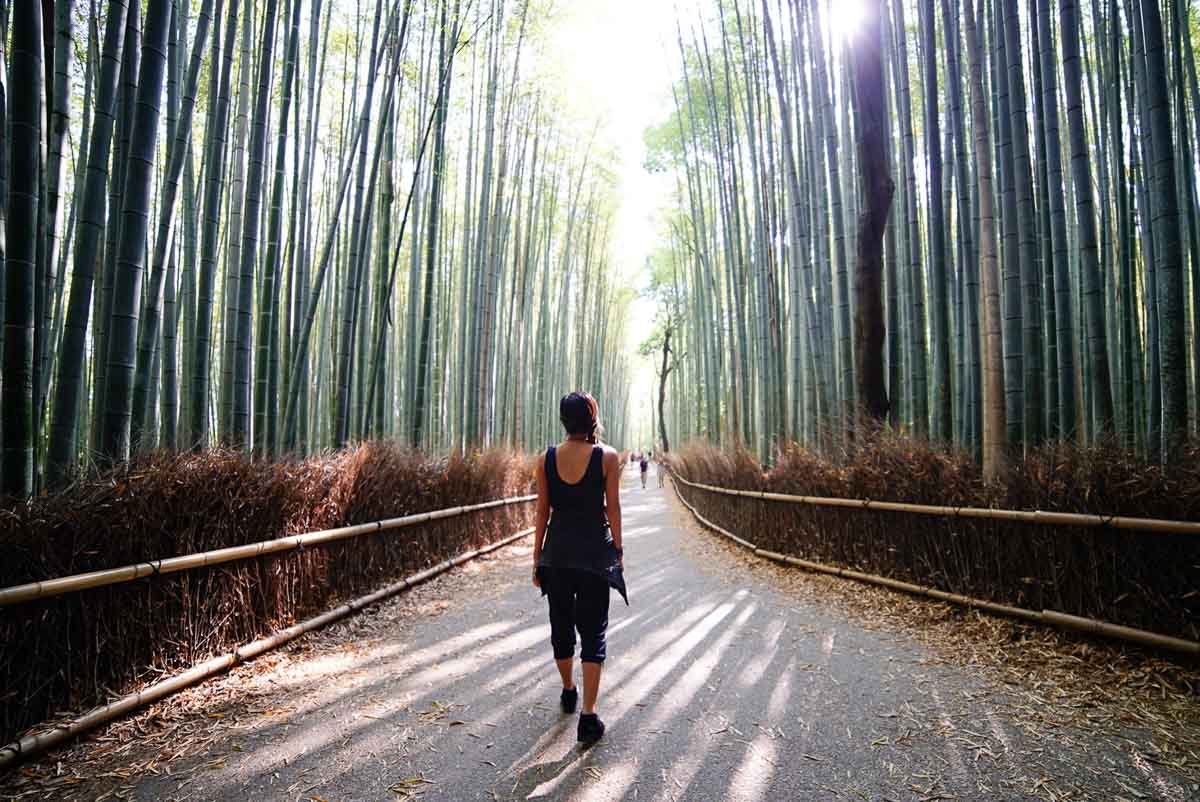
Entrance Fee: None Opening hours: 24 hours Nearest Station: Saga Arashiyama Station, JR Sagano line
2) Fushimi Inari
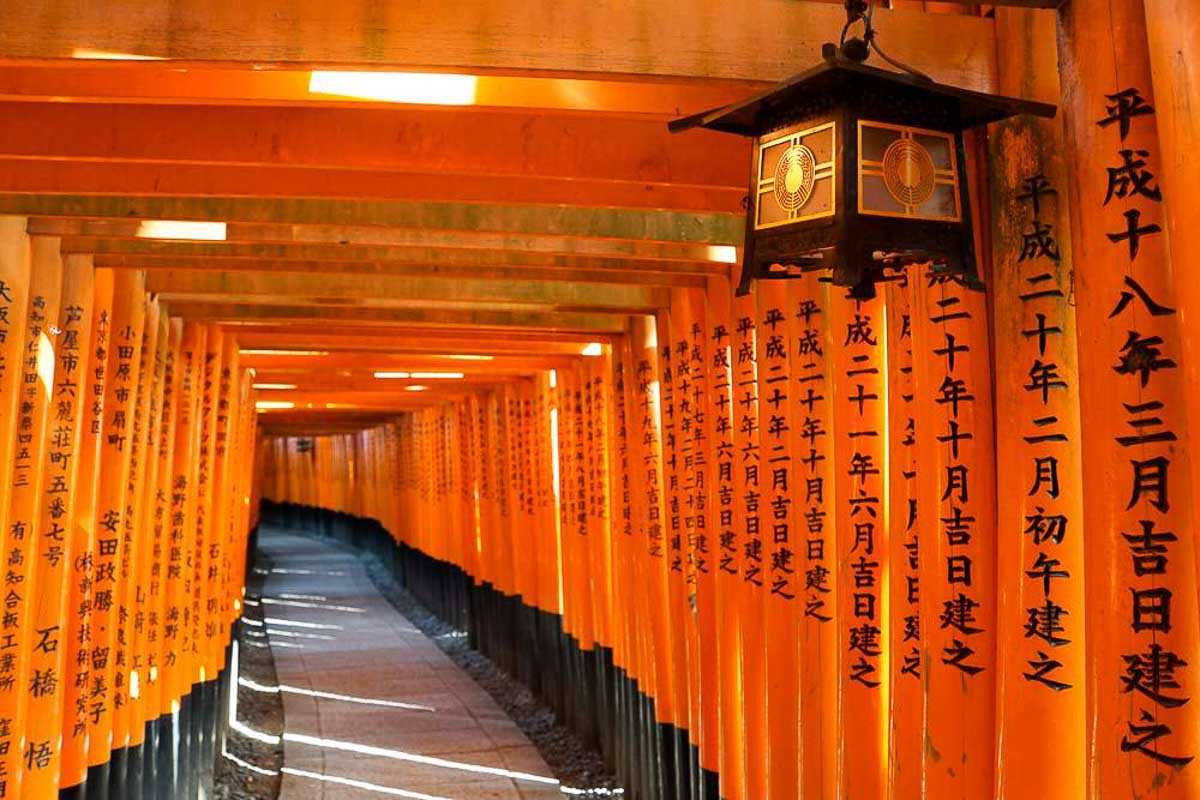
Entrance Fee: None Opening Hours: Dawn to dusk Nearest Station: 5min walk from Inari Station (JR Nara line) OR 10min walk from Fushimi Inari Station (Keihan line)
3) Kinkakuji Temple
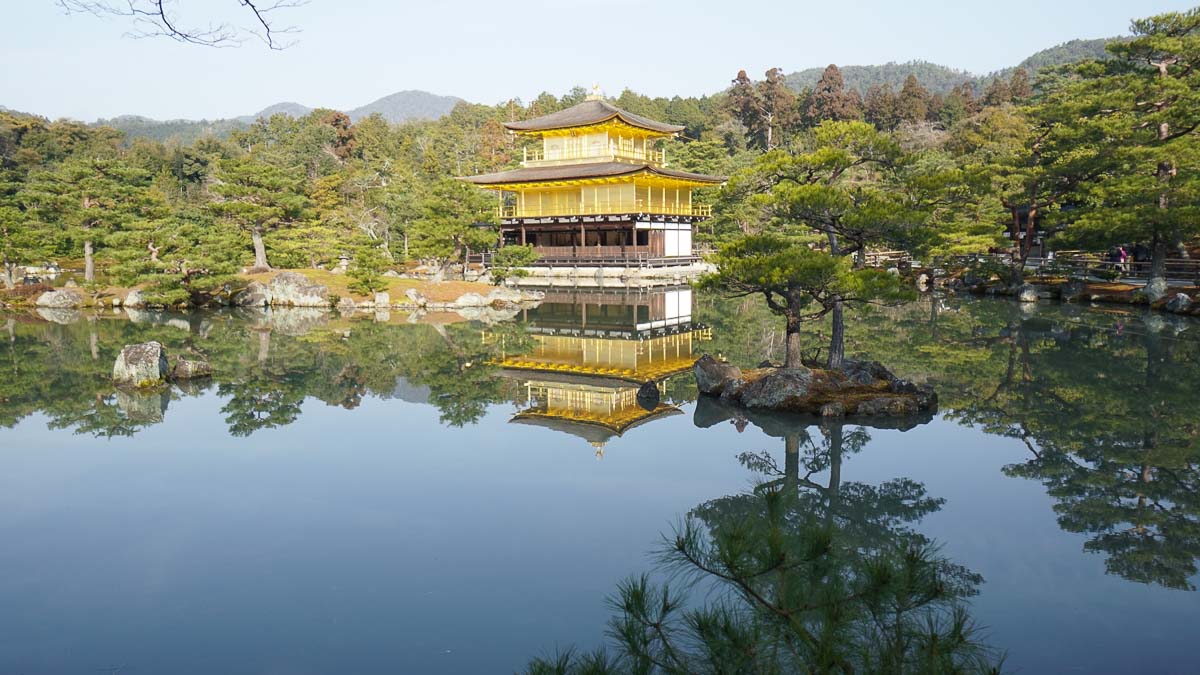
Entrance Fee: ¥400 Opening Hours: 9AM – 5PM Nearest Station: From Kitaoji Station (Karasuma Line), take bus 204 or 205 to Kinkakujimichi bus stop and walk 400m to Kinkakuji
4) Nishiki Market
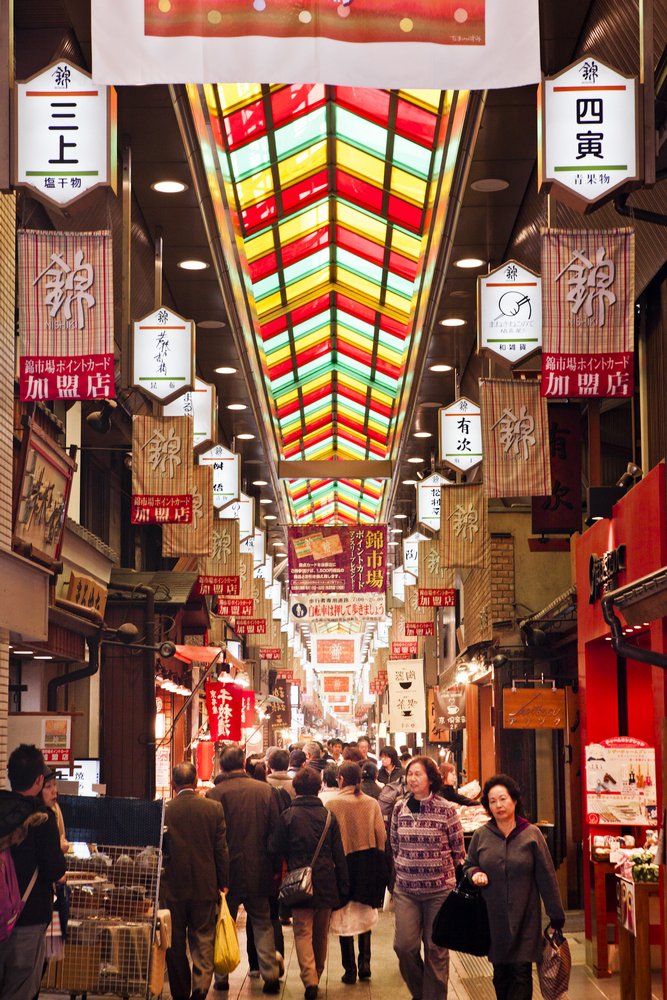
Opening Hours: 9AM – 5PM Nearest Station: Shijo Station (Karasuma line)
5) Kiyomizudera
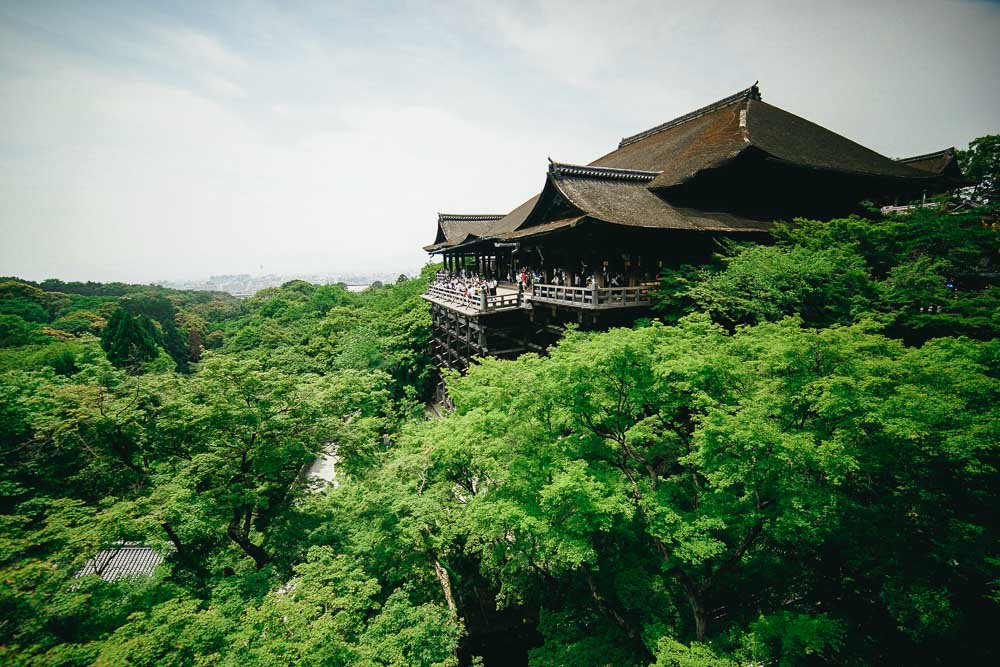
Cost: ¥400 Opening Hours: 6AM – 6PM (may vary slightly depending on season) Nearest Station: Most accessible by bus or by cycling. For bus, take bus 206 from Kyoto Station to Kiyomizu-michi and walk for 10 minutes.
Read more about these in our Kyoto Budget Guide .
DAY 7-8: Osaka
Accommodation: J-Hoppers Universal Osaka — ¥2,300 (15 minutes from USJ) Osaka Namba Hostel Miyabi — ¥2,300 (Near Namba Station)
Osaka is best known for 2 things, Universal Studios Japan and FOOD. And that’s exactly what were in Osaka for this trip.
Don’t get me wrong, Osaka too, has many gorgeous monuments and interesting activities. If it’s your first time to Osaka, check out our very first Osaka Budget Guide for all the best things to do, see and eat for under S$70/day including accommodation!
Universal Studios Japan
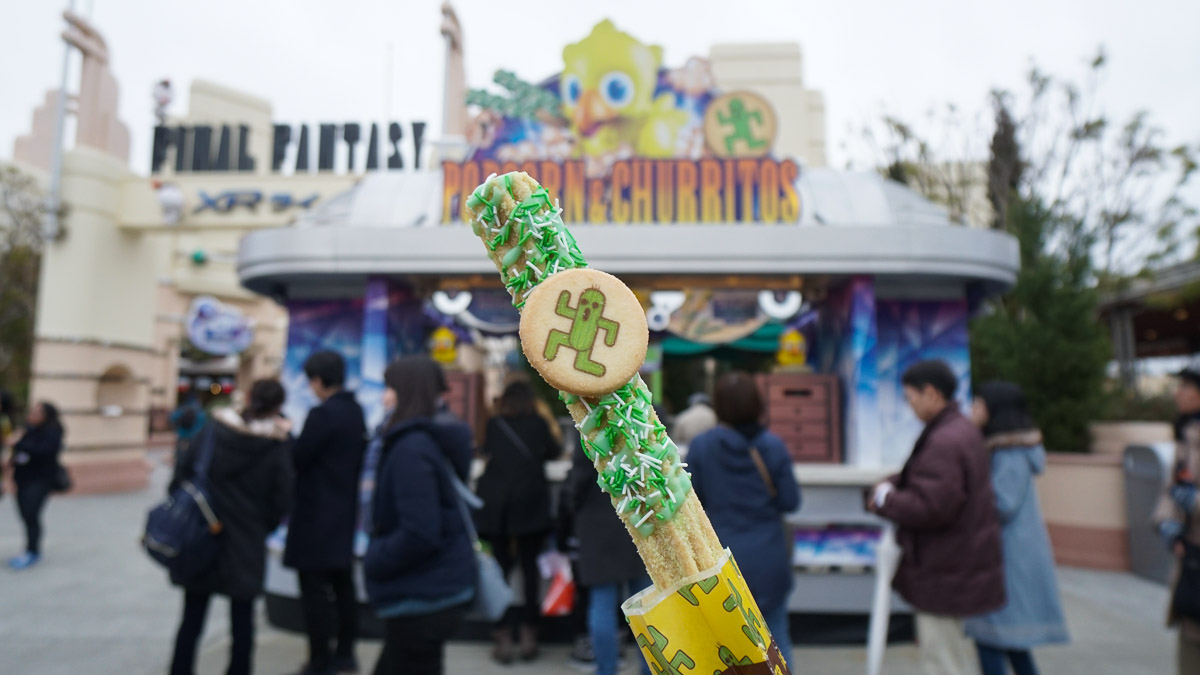
If you’re visiting from 19th Jan – June 24th 2018, definitely check out the newly refreshed Universal Cool Japan section in USJ.
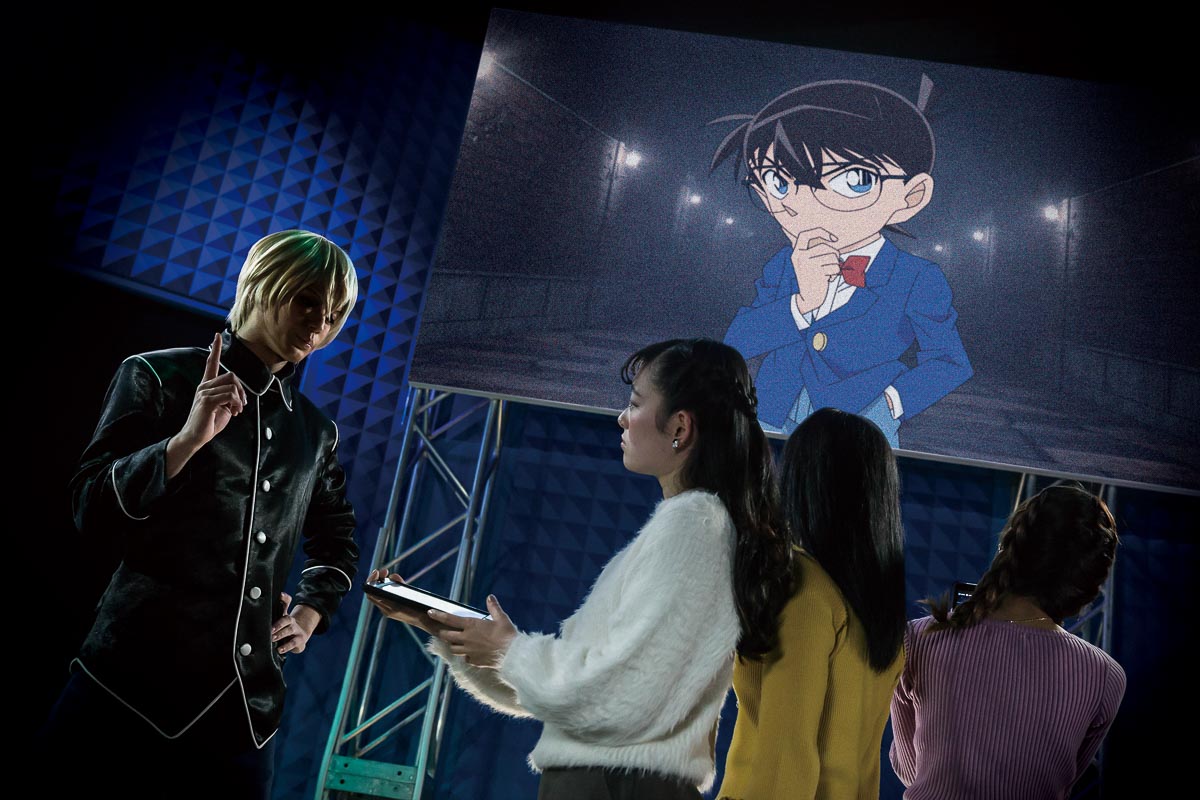
Find yourself in an exciting Final Fantasy themed VR roller coaster or stretch your brain at the 4 storey Detective Conan Real Escape Room . These 2 were my favourite experiences at USJ this round.
Read also: Universal Cool Japan 2018 for what to expect in this new section, or our Ultimate USJ guide for tips and tricks to beating the crowds and maximising your time in the park.
Useful USJ Passes to get:
Universal Studios Japan 1.5 day pass — Enter the park after 3pm on the first day and have the whole of day 2.
Universal Cool Japan 3 Express Pass — Express access to 3 popular attraction in the Universal Cool Japan section. You’ll need this to enter the Detective Conan Real Escape Room game.
Namba Food Hunt
Known as THE entertainment and shopping district, Namba is perhaps the most exciting area in Osaka. Here are just some of our favourite food finds in the area; all under ¥1000!
1) Beef Cutlet Takeru
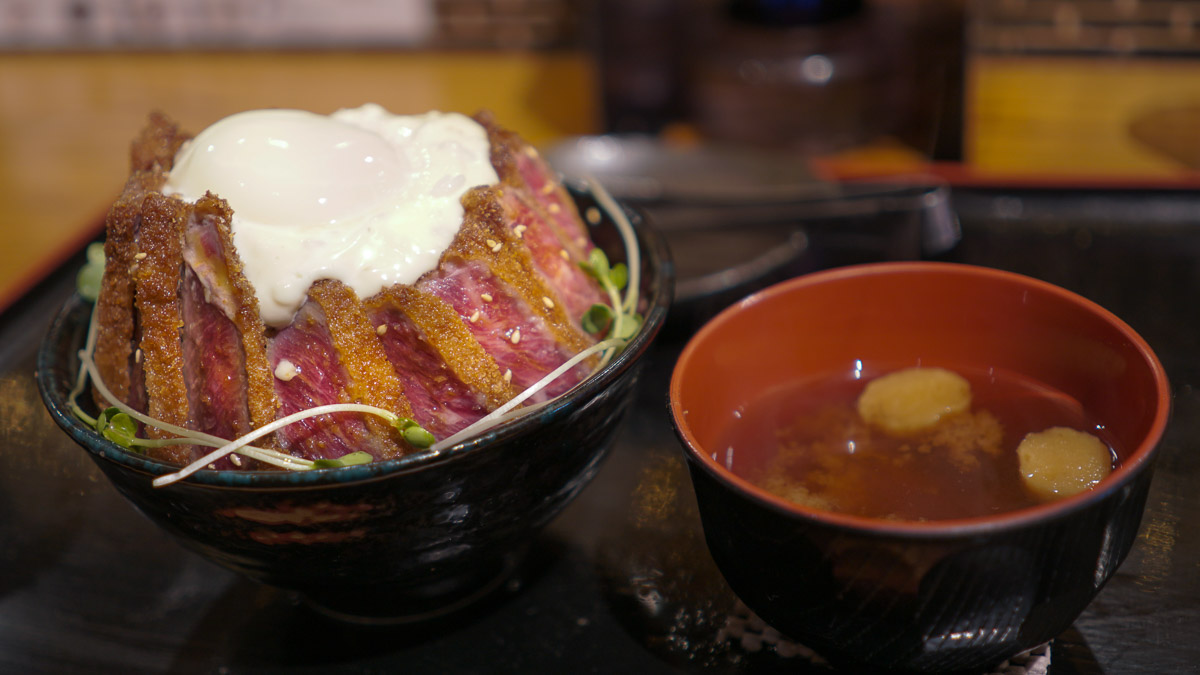
The most famous menu item at Beef Cutlet Takeru is this 1kg super large size beef cutlet rice bowl . For just ¥940, it comes with a miso soup and topped with a perfectly poached egg.
Each cutlet is lightly breaded on the edges and almost completely raw in the middle. In front of you in a mini grill where you can cook each individual piece to your liking.
While this set doesn’t serve 1kg of beef, the serving is pretty generous but basically comes with a mountain load of rice. If you’re not a “rice bucket” kind of person and don’t want to waste food, you can request for less rice (although the price will stay the same).
The catch is, each outlet only serves 5 of these bowls a day — which means you need to queue around 30 minutes before the shop opens to get your hands on one of these.
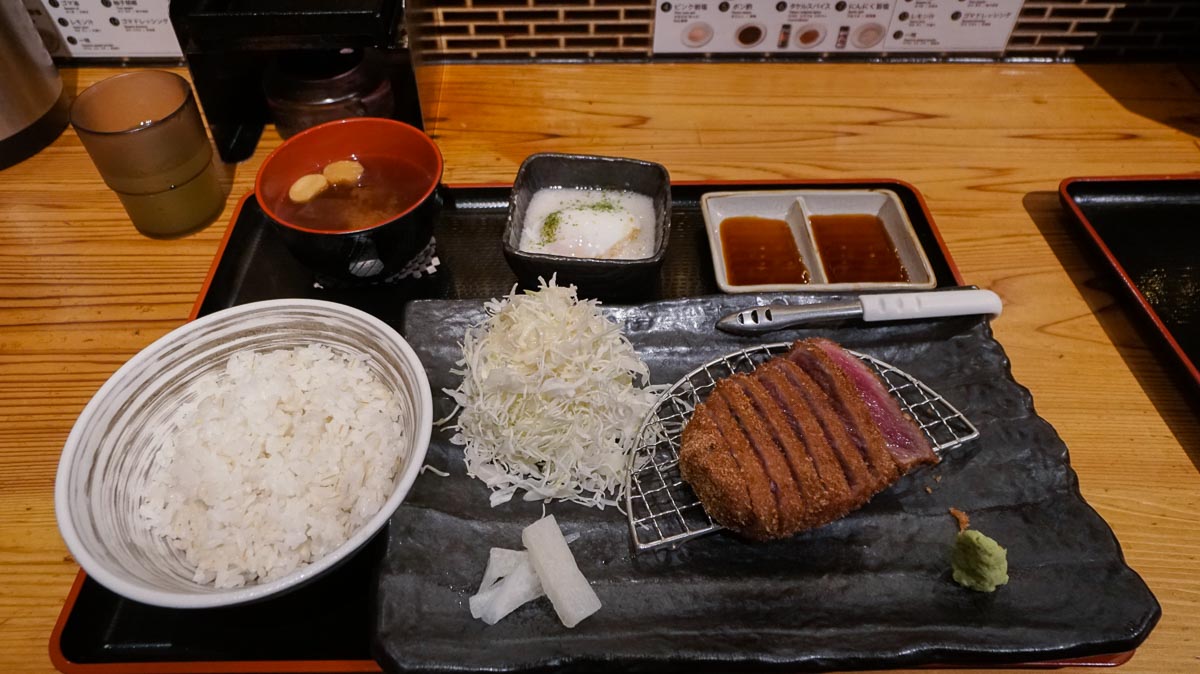
If you happen to miss out, the ¥1,200 set is equally worth it and comes with a free flow bowl of cabbage salad.
Don’t forget to ask for sauces! There are up to 15 different types of dips and sauces to go with the cutlet including Garlic Soy Sauce, Mustard, Ponzu Sauce, Garlic Salt and our favourite of all — freshly grated garlic!
Address: 2 Chome-4-4 Nanbanaka, Naniwa-ku, Ōsaka-shi, Ōsaka-fu 556-0011, Japan (Namba Outlet) Opening Hours: 11AM – 11PM (Everyday)
*Pro-tip: There are 2 outlet in Namba alone so if the queue looks long on one, try the other just 1 street away!
2) Niku Geikijou
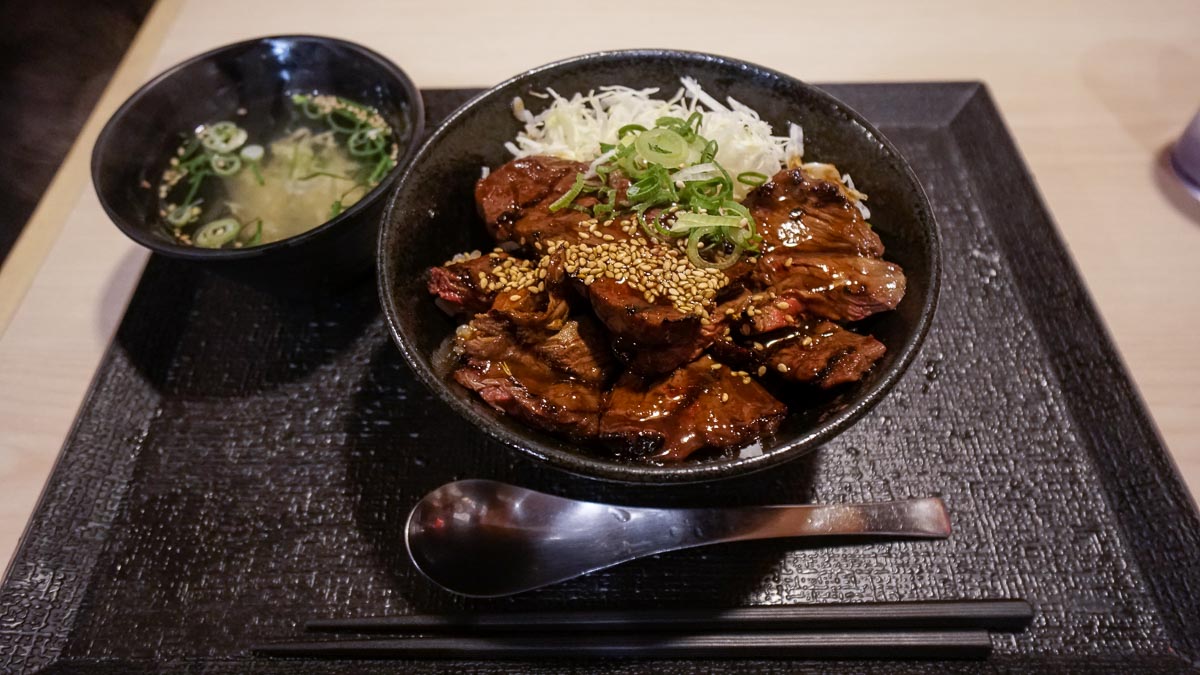
A relatively new brand in the “fast food” rice bowl world (along with Yoshinoya, Matsuya and Sukiya), Niku Geikijou may very well be a new favourite.
It’s a little pricier than the rest (ranging from ¥690 – ¥790) but serves a very generous portion of meat and you can choose from 12 different sauces to have the rice drenched in.
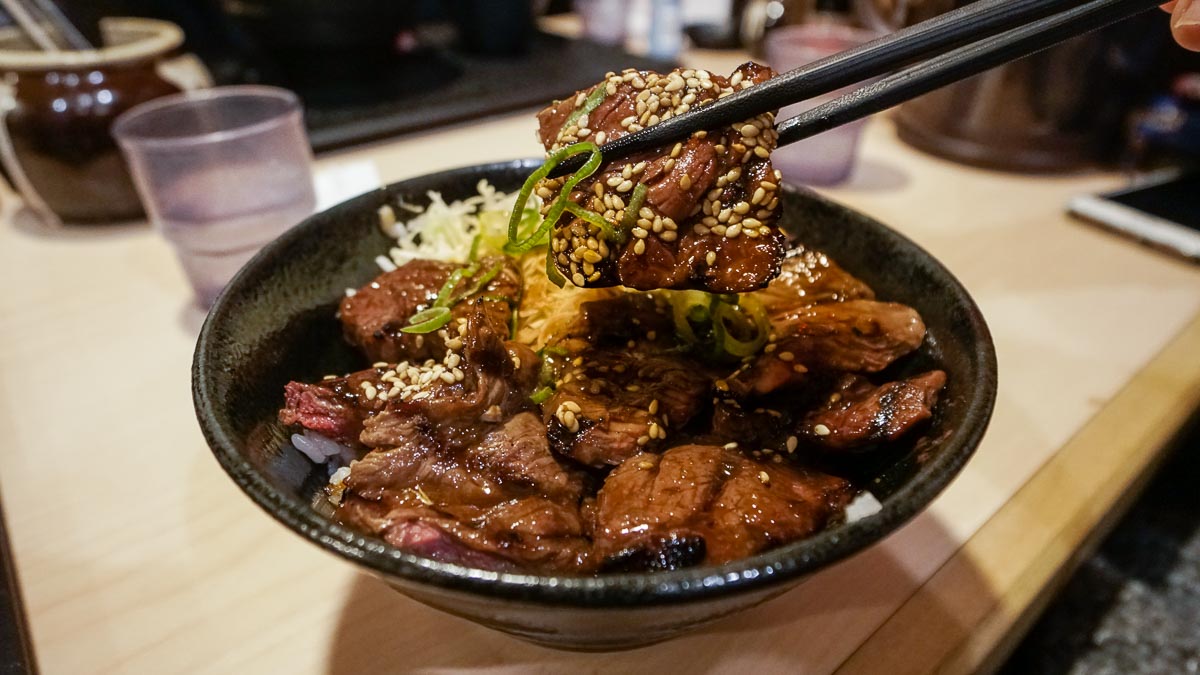
Sauces range from sweet to extra spicy, with garlic, with ginger or with miso. We ordered the skirt steak bowl and asked for the garlic miso sauce which turned out super addictive! Oiishi indeed!
Address: 2 Chome-4-4 Nanbanaka, Naniwa-ku, Ōsaka-shi, Ōsaka-fu 556-0011, Japan Opening Hours: 11AM – 11PM (Everyday)
3) Imai Honten Udon
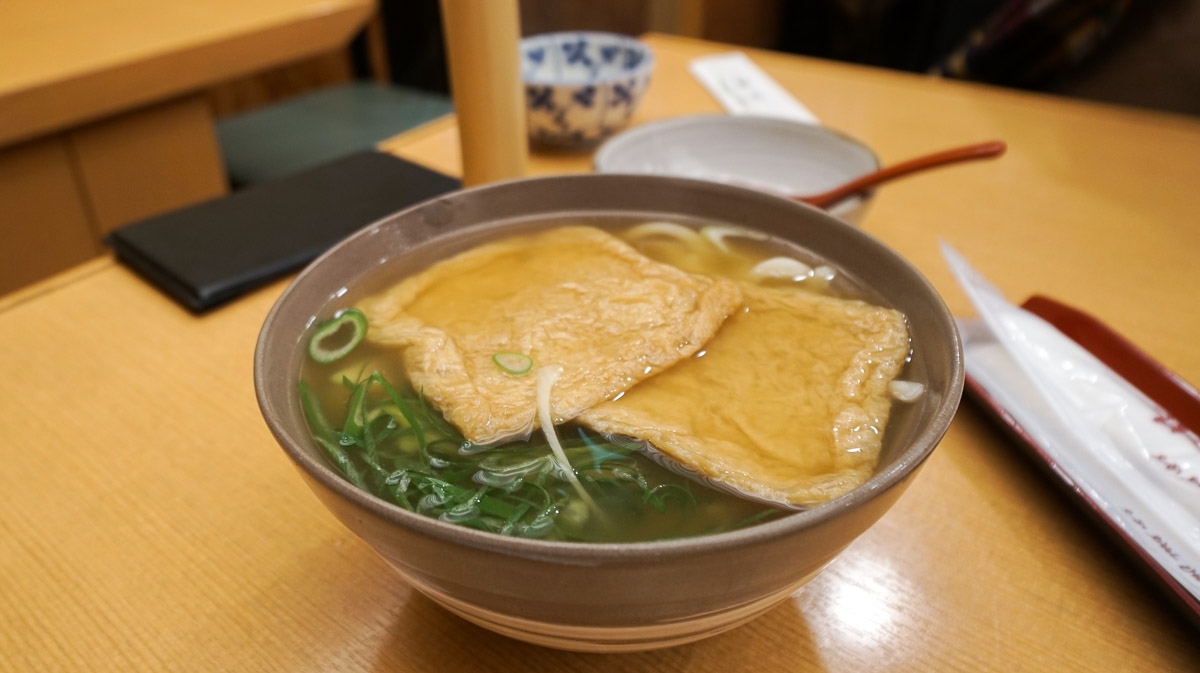
The specialty at Imai Honten is their Kitsune Udon which is fried bean curd cooked in a sweet soup broth for hours until it absorbs all the goodness. It might seem like a plain dish but light and light broth somehow manages to be just tasteful enough for you keep wanted another spoon of it.
Address: Osaka-shi Chuo-ku Dotonbori 1 – chome 7 No. 22 Opening Hours: 11AM – 10PM
One-stop place to book all your travel essentials
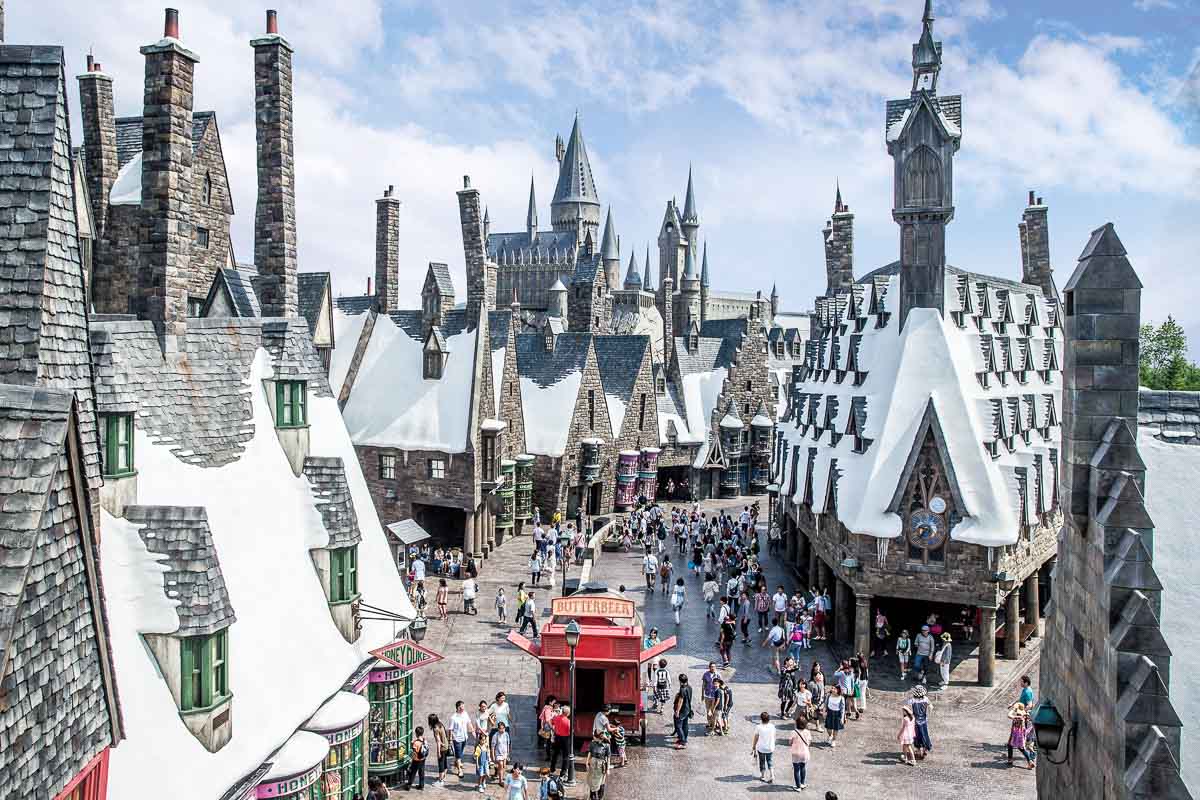
Klook has become one of the first sites we turn to when it comes to trip planning. From WiFi, to transport, to experiences, they have almost everything we need and at very competitive prices. Here’s what we booked from Klook for this trip:
1) 7 Day Whole Japan JR Pass — Saved us $300+ in value. Click here for JR Pass breakdown 2) 8D 4G SIM Card — Fuss free pick up from Tokyo Airport (Comes in 3GB and Unlimited) 3) ICOCA IC Card — Comes preloaded with ¥1,500 credits and can be used on all transports in the Kansai region including Osaka, Kyoto, Nara and Kobe 4) Universal Studio Ticket — Available in 1, 1.5 and 2 day passes. No printout needed. You can get access just by scanning the QR code on your phone. 5) Nankai Airport Express — Since we returned on day 8, we could no longer use our JR pass to get to Kansai Airport so this was our next best option! The limited express trains will get you to the airport under 45 minutes but leaves only 2 times every hour so be sure to check the timetable from Kansai airport and to Kansai airport .
All set for your winter adventure? Start securing your flights now:
Can’t see the widget above? Check flight prices from Singapore to Tokyo here instead!
This post was brought to you by Klook .
Like what you’re seeing? Follow us on Facebook , Instagram , and YouTube !
A post shared by The Travel Intern (@thetravelintern) on Jan 25, 2018 at 8:44pm PST
RELATED ARTICLES MORE FROM AUTHOR

31 New Deals and Attractions in Singapore this April 2024
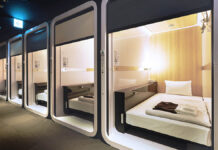
Top 11 Stunning Yet Budget-Friendly Tokyo Capsule Hotels (from ~S$40/night)

Tokyo Vs Osaka: Why Are These Two Popular Japanese Cities so Different — Cultures Explained
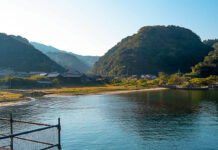
Hiroshima and San’in Guide — Going Beyond Tokyo/Osaka to Find Japan’s Best Hidden Gems

Tokyo Disneyland and DisneySea Guide (2024) — Maximise your Tokyo Disney Day with these 12 Tips and Tricks
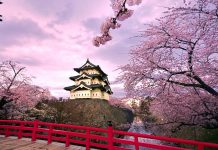
Ultimate 2024 Cherry Blossom Japan Guide — Everything You Need to Know
13 comments.
This provides a good overview of places to go in Japan. I find this an interesting express itinerary to cover so many places in Japan over 7 days. I would think in reality I would spend a bit more time at each location, account for waiting time, find my way, etc in order to get from place to place. I guess it would be too stressful for me to cover 7 places/cities in 7 days. Seat reservations on some trains are probably needed when using the JR pass. This was something that put me off when I considered the JR Pass.
Yeah it’s super express as mentioned! mainly for those who wants to do many things in a short period of time as they might have limited vacation leave. For most routes, JR trains are actually ok without the JR Pass if you avoid the usual peak hours. Only for the overnight trains and long distance trains is it more important to make the reservations!
Hi.. How to book accommodation in Shirakawa-go: Shimizu Inn? I cant find it in agoda. thank you very much
We booked via Japanguesthouses.com. you can check for availability here: https://www.japaneseguesthouses.com/ryokan-single/?ryokan=Shirakawago-Shimizu
Thank you Cherie..
Hi Ms. Cherie.
I have read your itinerary and it is awesome.
I would like to ask, is this a February trip? Is this itinerary advisable for a December trip?
Yes, we did this in late Jan/early Feb but even then, Takayama’s snow happened to have melted on the day we arrived so pretty it’s unpredictable. But if you’re just looking to enjoy the warm houses in Shirakawago then I can imagine December to be a great time too!
Hi I have read this post and it’s awesome . I made small changes in this plan according to my family needs & completed my trip with family between Dec 22 to Dec 31. Below is my itinerary . Day 1 22-12-2018 Singapore to Tokyo and settle in room Day 2 23-12-2018 Hakone ( using Hakone free pass klook pass ) Day 3 24-12-2018 Gala Uzawa ( Activated JR Pass First day ) Day 4 25-12-2018 Nagano (snow Monkey park ( JR Pass day 2)) Day 5 26-12-2018 Shirakawa-go ( Nohi bus ) Day 6 27-12-2018 Nagoya nabana no sato winter illumination ( JR Pass day 4 ) Day 7 28-12-2018 USJ ( 1.5 days pass) ( JR Pass day 5) Day 8 29-12-2018 USJ ( 1.5 days pass) ( Traveled back to Tokyo 8.26 Hikari 2.30 hrs travel ( JR Pass day 6 )) Day 9 30-12-2018 Tagarakawa Onsen ( JR Pass day 7 ) Day 10 31-12-2018 Ueno Park & Pack up back to singapore.
Bought suica card for local subway travel in Tokyo & Nagoya also used this card in vending machines . Traveled with family(Indian vegetarian )bit hectic, but can manage easily .(Me ,Wife,daughter (11) ,son (7) ) Budget 10K )
Thanks a lot for such a wonderful post and keep travelling 🙂
sounds like a great plan. Thanks for sharing!
Hi, I wonder how big your luggage is? We are going to visit Japan next January – February, and we “copied” your itinerary so ours is more or less is quite similar to you. But we wonder if we would be able to do all the stuffs if we carry big sized luggage. Please help 🙁
Believe it or not, we actually did this trip with a cabin sized luggage! It might be a little hard to find luggage space in the trains but the buses usually had a luggage compartment below so that wasn’t a problem!
Hi found your wonderful itinerary. Wanted to travel to Japan end Nov. Is picking up a car to drive advisable?
Hi Chris! If you are comfortable driving, it’s always nice to have some flexibility. We have driven in Hokkaido and around Mount Fuji before pre-covid!
LEAVE A REPLY Cancel reply
Save my name, email, and website in this browser for the next time I comment.

11 Unique Things to Do in South Australia — Quirky Wineries,...

7 Boutique Hotels in Singapore For an “Out of the Country”...

How to Pay in China Without WeChat or Alipay — New...

11 Things to do in Clark, Philippines — A Quiet Adventure...

20 Things to Eat-See-Do in Sabah’s Capital Besides Climbing Mount Kinabalu

- Terms Of Use
- Privacy Policy
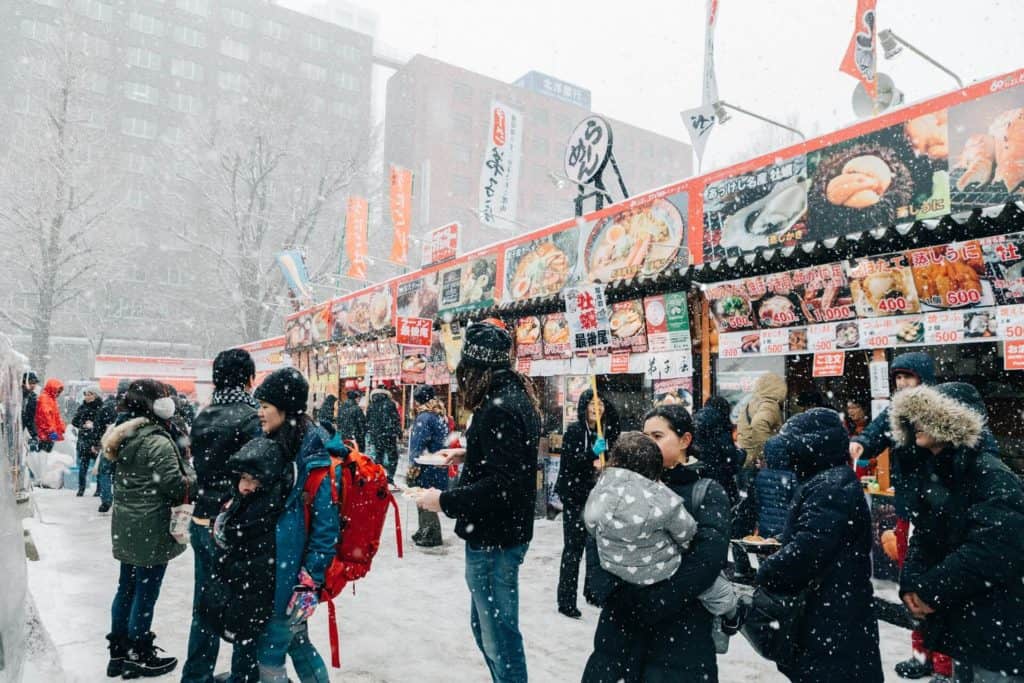
Ultimate Japan Winter Packing List (2024 Guide)
Disclaimer: This page may contain affiliate links and I may get a small commission if you decide to make a purchase through my links, at no additional cost to you. Thank you !
Are you trying to figure out the Japan winter packing list?
Continue to read on because you have come to the right site!
Consisting of five main islands, Japan is a beautiful four-seasoned country with many fascinating attractions, stunning natural splendours , delicious food, and rich culture.
Thanks to these aspects, you can expect Japan to be visited by foreign travellers all year round including the non-peak travel period in winter.
But if you are first-time visitors or travellers who originated from tropical climates , chances are you might get slightly overwhelmed when it comes to packing winter wear and accessories for Japan travel.
I guess the only time one ever needs a down jacket in a tropical country is visiting a snow-themed attraction park.
Worry not; I have got your back!
Here is the detailed article that I put together on the list of must-have items to bring and handy Japan winter travel tips that you can refer to for a cosy, toasty travel experience.
So let’s dive right in.
Related Articles:
- Takayama in Winter: All You Need To Know (2023 Guide)
- Japan Ski Packing List: What To Pack & Useful Tips
- Best 13 Onsen Ryokan In Kanazawa (For All Traveller Types!)
- Best 17 Ryokan With Private Onsen In Hakone (2023)
- Top 23 Snacks In Japan To Try (And Where To Get Them)
- 16 Best Apps For Travel To Japan (2022 Guide)
Winter Packing List For Japan
- Wheeled Luggage
- Travel Backpack
- Long Sleeves Top
- Down Jacket
- Gloves
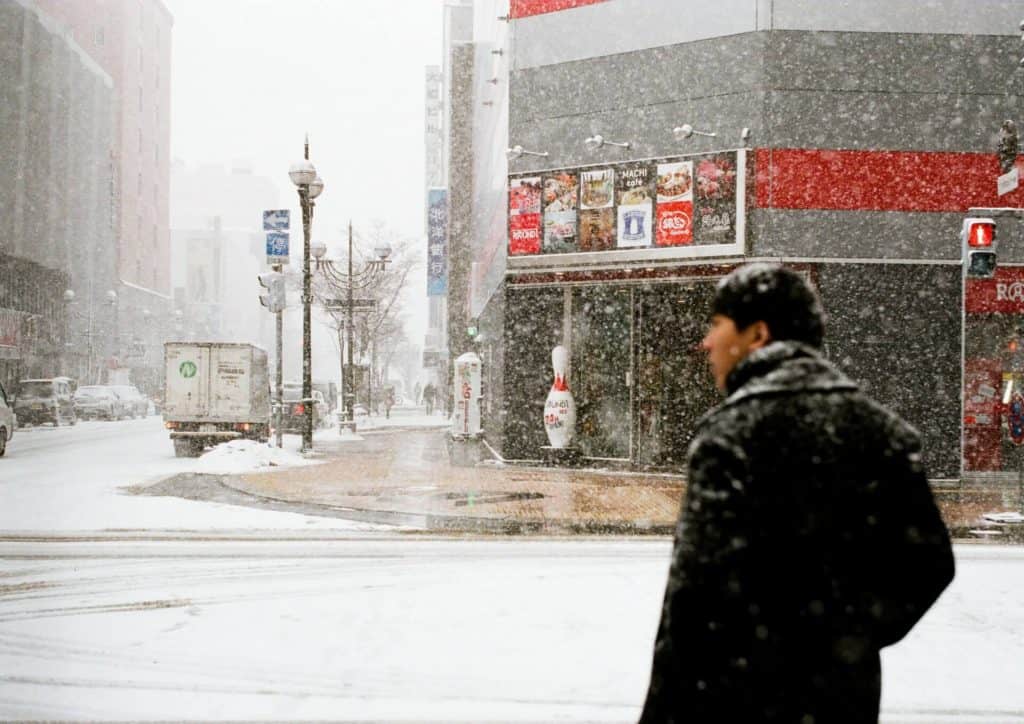
Planning to replace your old winter wear with newer, better models through online shopping at Amazon ?
Sign up for a Amazon Prime 1-WEEK Trial at a mind-blowingly low fee to get your hands on exclusive deals, additional member perks, benefits, and savings!
What Should I Pack For Japan In Winter
1. wheeled luggage.
If you are in the team luggage when travelling overseas, get yourself high-quality wheeled luggage like this classy-looking Samsonite Double Spinner Wheels .

Chances are you are going to bring multiple layers to keep your body warm when visiting Japan in winter.
And all the little things add up and your luggage gets heavy .
So, navigate around with a breeze while rolling the wheeled luggage along until you reach your destination in Japan.
2. Travel Backpack
If wheeled luggage is not your thing, then buy yourself a travel backpack to keep your winter wear.
Some reliable travel backpacks to opt for include TETON Sports .

Travel tip: Make sure to use packing cubes to pack the thick winter wear to have more space in your backpack.
3. Thermals
Be sure to include thermals on your Japan winter packing list too.
Being the base layer, thermals help in conserving the body heat and keeping you warm as you are having fun exploring Japan during the cold season.
If you are planning to get a complete set of thermals, check out Thermajane Women’s Thermal or Thermajohn Men’s Thermal .

4. Long Sleeves Top
Of course you can’t miss out on some long-sleeved tops when planning your Japan winter itinerary.
These tops can offer an additional layer of warmth against the cold winter breeze while walking down the Japanese cities.
You can get plenty of stylish long sleeves top online, such as Cuddl Duds’s .

If you are not a big fan of the cold season, be sure to include several comfy sweaters on the Japan winter packing list.
Typically made with thicker material, sweaters perform better when it comes to body heat retention and against the chilly wind .
Among the top sweater choices that you can consider getting are Kingfen Women’s Sweater or Hanes Male’s Sweatshirt .

6. Long Pants
After getting the upper body part warm and toasty, it is time to move over to the lower limbs.
One major turn-off while travelling in winter is having cold, wet pants after walking in snow-prone regions.
So it is always recommended to look for waterproof and breathable long pants lined with fleece.
For a casual style, consider buying Camel Crown Women’s Fleece Pants or Free Soldier Men’s Cargo Pants .

7. Down Jacket
A down jacket is definitely one of the must-have items to bring on your Japan winter packing list.
Typically made with duck or goose feathers, wearing a down jacket helps to retain heat and provide warmth for as long as you are wearing it.
If you are looking to boost your style, Columbia Women’s Down Jacket or Columbia Men’s Down Jacket could be a good fit.

Apart from keeping your head from excessive heat loss in winter, a beanie can be a great fashion prop too!
Get yourself a cute beanie like Furtalk Beanie .

9. Wool Scarf
Wool scarves help to retain heat and keep the neck-chest area warm and cosy against the cold wind and snow.
Also, wool scarves are more durable and breathable—not to mention more affordable too.
Check out these stylish wool scarves like Ohayomi Women’s Wool Scarf or Alpine Swiss Men’s Winter Scarf to complement your overall winter while you are looking for the answer to “What to wear in winter in Japan”.

10. Earmuffs
If you have been wondering what other items to include on the winter Japan packing list, earmuffs are one of them.
Apart from being a cute fashion accessory , earmuffs help keep your ears warm and toasty during winter in Japan.

Gloves are a crucial winter accessory to have when visiting Japan in winter.
Be sure to look for touchscreen-friendly gloves so that you can use your phone at ease without taking out the gloves.

12. Wool Socks
Another must-have item on your Japan packing list winter is wool socks .
As you are exploring the country during the cold season, keep your toes and soles warm and comfy by putting on wool socks.
So get yourself a few pairs of great quality wool socks before going to Japan in winter.

13. Snow Boots
During winter, the amount of snow produced in Japanese cities varies depending on its location.
Nevertheless, be sure to pack a pair of walking boots so that your feet are always warm and dry when you are walking around.
The last thing that you want while being in cold weather is to have freezing wet feet, especially in snow-heavy regions.
The important qualities of walking boots to have are waterproof, lightweight, and comfy.
So check out Columbia Women’s Snow Boots or Columbia Men’s Snow Boots if you are looking for one.

What To Pack For Winter In Japan: Other Items
1. portable phone charger.
The last thing that you want is to have your phone run out of juice when you are taking nice scenery photos or posing your iconic pose at the Instagrammable spots in Japan.
Make sure to include a portable phone charger on your packing list Japan winter.

2. Travel Camera
Want to brush up on your photography skills ?
Or keen to take spectacular photos of Japan that can make your followers go “Awww. What a nice photo!”?
Regardless of which answer you pick, this comprehensive Canon travel camera bundle seems like a good fit for your Japan trip.

3. Headphones
Chances are you are going to spend hours travelling from the departure country to Japan.
Or getting on the shinkansen train services using JR pass hopping around major cities like Tokyo , Osaka , Kyoto , and others.
So fill your journey with your fav music with Anker Soundcore Life Q20 .

4. First Aid Kit
It is always good to have a basic first aid kit when you are travelling overseas.
5. Lip Balm
Winter conditions in Japan can leave your lips dry and flaky .
So bring along your trusted lip balm and apply generously after the Japan touchdown.
6. Toiletries
Don’t forget to bring along your preferred brand of toothbrush, toothpaste, and other toiletries before flying into Japan.
If you want to organise everything neatly and prevent missing out on any must-have toiletries, get yourself this sleek travel toiletry bag .

7. Laundry Bag
Separate your dirty clothes from the clean ones by using a laundry bag .
This item is particularly useful when you are planning to stay and explore Japan for 3 weeks or more.
8. Japanese Phrasebook
If you prefer to read a book to kill time, you might consider buying a Japanese phrasebook to learn some basic Japanese words.
Some shinkansen rides can take up to hours when getting from one Japanese city to another, so have a read, learn a little, and impress the locals with your simple vocab!
Here are some of the recommended phrasebooks :
- Lonely Planet Japanese Phrasebook & Dictionary
- 2000 Most Common Japanese Words in Context
- Conversational Japanese Dialogues

- Day Trip To Nara—The Ultimate Nara Itinerary One Day
- 1 Day Itinerary Osaka—The Best Itinerary To Explore Osaka In 24 Hours
- The Perfect Kyoto 2-Day Itinerary—Epic Guide To Explore Kyoto
- Best Day Trip To Hakone From Tokyo: The Ultimate Guide
- Off The Beaten Path Japan—Top 18 Places That You Need To Discover
- First Time To Japan: 45 Useful Travel Tips For First Time Traveler
- What Japan Is Known For: 33 Famous Things To Discover
Essential Japan Travel Tips In Winter
Prepare your japan winter travel packing list earlier .
So now you know what you need to pack for the winter trip. What happens next?
Make sure to prepare the packing list and decide on what to wear in Japan in winter at least a few weeks before your flight!
With early planning , you will have enough time to buy the necessary winter wear for the Japan trip. And sometimes at a lower price too.
Travel tip: Don’t worry if you forget to bring some items—you can get them in the local stores after reaching Japan.
Use Packing Cubes
The main function of winter wear is to provide or retain warmth against the cold weather.
And so you can expect most winter wear and accessories to be bulky and thick.
To save space , make sure to use some packing cubes when you are packing the items.
Pack Slip-On Shoes
The majority of the temples and shrines in Japan require their visitors to remove their shoes before entering the traditional buildings.
For convenience, it is recommended to wear slip-on shoes before heading over to these fascinating religious sites.

Use Japan’s Luggage-Forwarding Service
If you are bringing lots of luggage when travelling to Japan in winter, consider using the local luggage-forwarding service.
This reliable service helps users to send their belongings from one place to another at an affordable cost.
So you don’t have to spend much energy lugging bulky luggage across the airport or through the jam-packed public transportation systems.
Among the most popular luggage-forwarding service companies in Japan is Yamato Kuroneko .
Travel tip: If you plan to ski in Japan during winter, you can opt for this service to send your heavy ski gear directly from the airport to your ski resort!
Also, don’t forget to bring some Japanese yen before visiting Japan.
Some establishments in rural areas are only accepting cash as transactions.
Keep all your travel cards and cash securely using Lewis N. Clark RFID Travel Wallet .

Buy Travel Insurance
Of course you shouldn’t miss out on getting travel insurance while you are travelling overseas.
Disclaimer: World Nomads provides travel insurance for travelers in over 100 countries. As an affiliate, we receive a fee when you get a quote from World Nomads using this link . We do not represent World Nomads. This is information only and not a recommendation to buy travel insurance.
Rent Pocket Wifi
Want to stay connected with your friends and family members no matter wherever you are in Japan?
Or perhaps you want to post your beautiful Instagrammable pictures immediately to your social media accounts?
Then be sure to rent a pocket Wifi device for your Japan trip!
Travel tip: You can choose to claim the device at the airport or have it sent to your accommodation site.
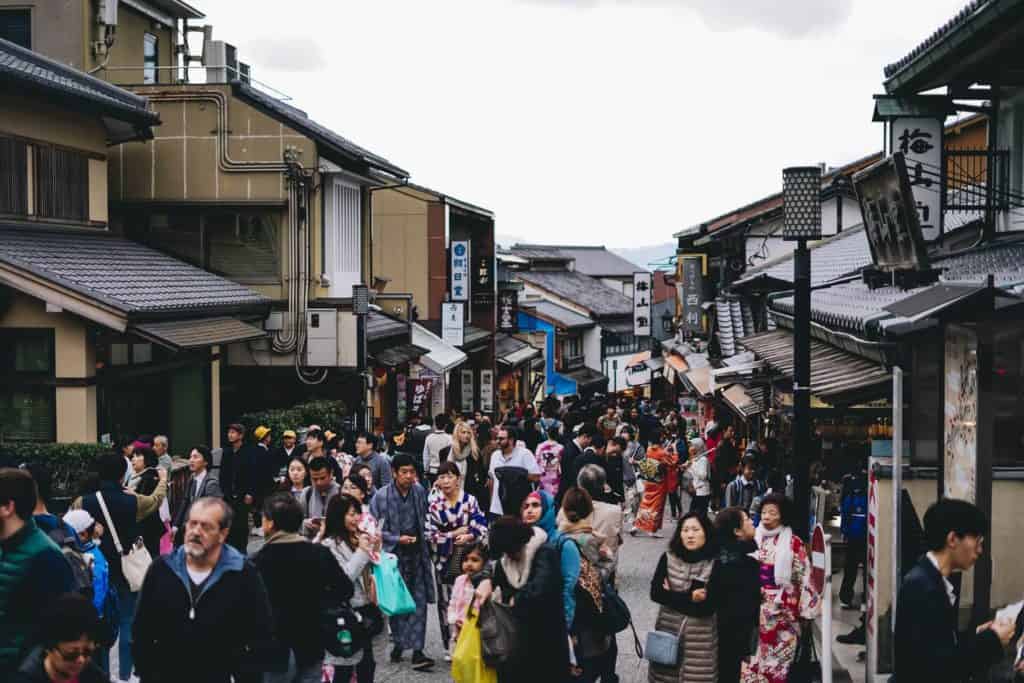
Leave Some Luggage Spaces For Your Japan Shopping Haul
If you are a shopaholic , chances are you are going to have plenty of shopping haul to bring home from Japan!
So leave some spaces in your luggage to keep the new clothes or bring in additional packing cubes .
Buy Heat Packs
If you are not a big fan of the winter season and need additional warmth against the cold weather, consider getting yourself some heat packs .
Locally called “Kairo”, this useful item can be found in most convenience stores or retailers in Japan, including 7-11 and Don Quijote .
Unmissable Things To Do In Japan During Winter
1. watch the beautiful winter illuminations.
Japan is famous for its beautiful winter illuminations that attract both local and international travellers.
Get ready to be dazzled by the pretty light displays that lit up buildings, trees, man-made sculptures, and others!
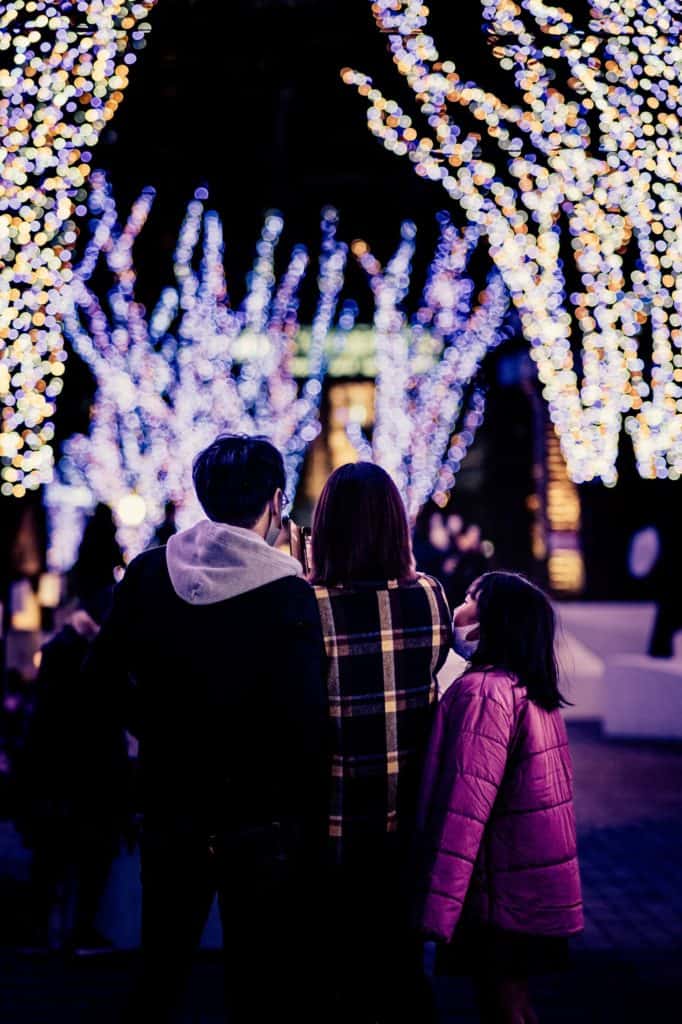
2. Go For Skiing
Japan is popular among skiers and snowboarders too thanks to the ideal snow conditions for these thrilling outdoor activities.
Some of the recommended Japanese regions to hit the slopes include:
- Niseko in Hokkaido
- Hakuba Valley in Nagano
- Naeba in Niigata
Check out my detailed Japan ski packing list if you are keen to experience skiing in winter while you are exploring the country.
3. Visit Mount Fuji
Do you know that it is not common to see the peak of Mount Fuji even during the day?
Thanks to the cooler weather and low humidity, this iconic mountain offers greater visibility and plenty of photo opportunities in winter .
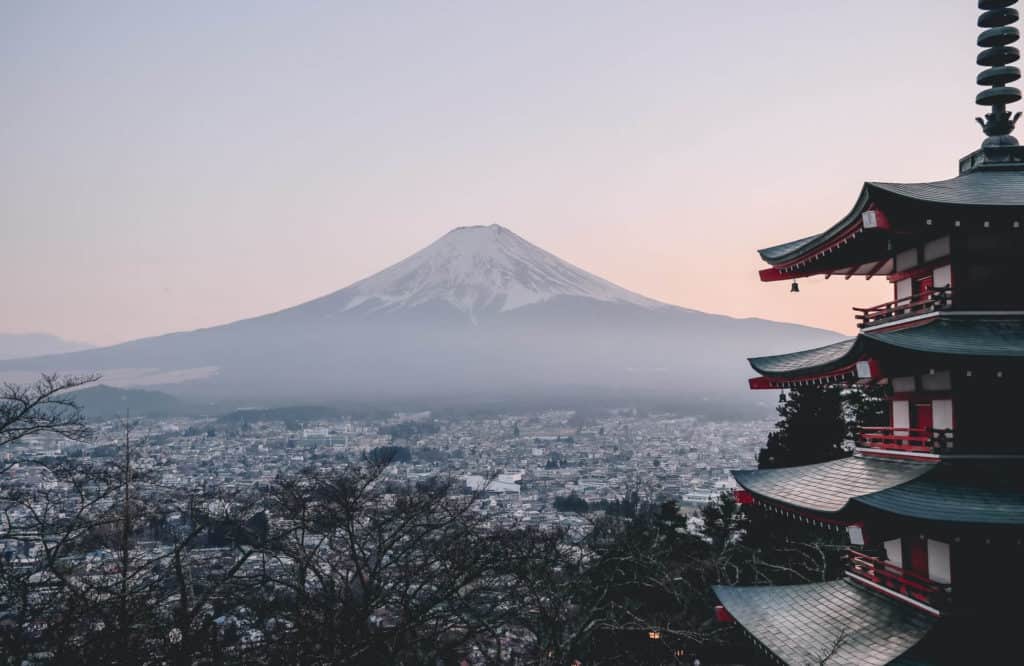
4. Visit Jigokudani Snow Monkey Park
Another unmissable thing to do in winter in Japan is to visit the Jigokudani Snow Monkey Park .
With the layers of snow covering the surrounding mountain, the stunning backdrop offers great photo spots with the playful monkeys dipping around the park’s natural hot spring.
Travel tip: The monkeys may look cute and friendly. But remember don’t touch or feed the them while you are there.
5. Have A Dip At Onsen
What’s better than having a relaxing dip in the local onsen to escape the winter chill in Japan?
Though onsen is popular all year round, visiting one in winter offers a slightly more stunning experience as you get to enjoy the magical snow-filled landscape while having the soak.
Travel tip: Read through the Japanese onsen etiquette to learn more about the local culture and the dos and don’ts .
6. Sign Up For A Food Tour
Reward your palate with the mouth-watering local cuisine by signing up for a food tour while you are in Japan during winter.
Different Japanese seasons boast different food types. So make sure to experience the tasty must-try winter meals and immerse into the local culture under the guide’s guidance.
Check out these highly-rated Japanese food tours :
- Tsukiji Outer Market: 3-Hour Food & Drink Walking Tour
- Tokyo: Ramen Tasting Tour with Local Ramen Guru
- Kyoto Nishiki Market Food Tour
- Osaka: Eat Like a Local Street Food Tour
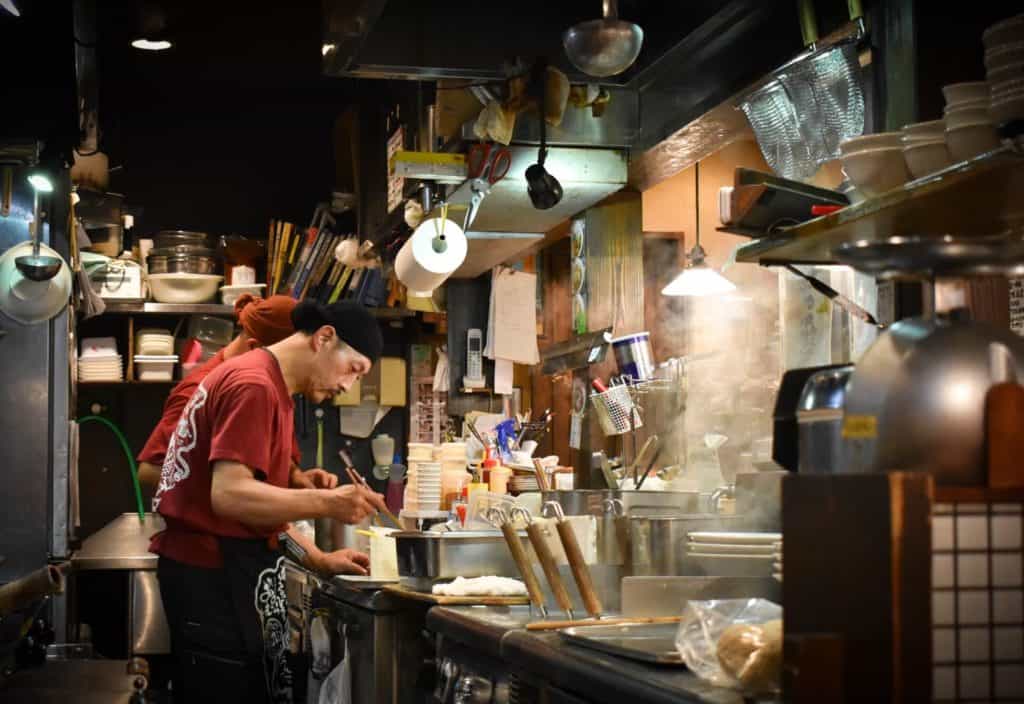
FAQs: Winter Packing List Japan
1. best luggage to take to japan .
The public transportation system in Japan is typically crowded, particularly in the major cities. There are limited luggage storage areas on the trains too.
It is recommended to bring small to medium-sized wheeled luggage or a travel backpack . You can also add on a small messenger bag a duffel bag .
2. When Is Winter In Japan ?
Japan’s winter duration and intensity depend on the region’s geographical location. Typically, the season starts in early December and ends in mid-March. The temperature of cities located in the centre’s region like Tokyo and Osaka during winter is ranging from 2 to 10 degrees Celsius.
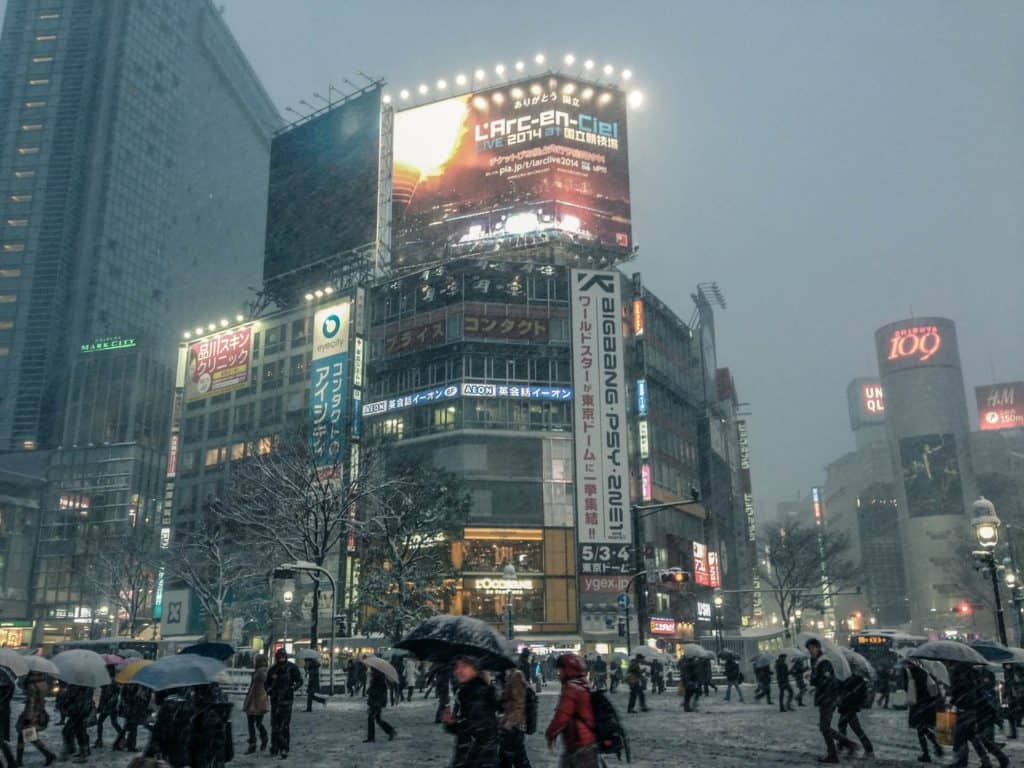
Japan Winter Packing List: Conclusion
Here you go—a comprehensive article on the Japan winter packing list that you can rely on for your upcoming trip!
Is there any other winter-related apparel or gear to pack that I missed out on? If yes, please let me know. I would really love to hear from you.
And if you find this article useful, I would appreciate it if you share this with your friends and family members.
Have fun chilling!

Sam Lee, founder of Sam Lee Travel, is a seasoned traveler with over 10 years of experience exploring various Asian countries. Having lived in Singapore for almost a decade, Sam has developed a deep understanding of the culture, customs, and attractions in the region.
With a passion for outdoor travel adventures and water sports, Sam has helped over 25K readers per month plan their trips around Asia, including off-the-beaten-path destinations, offering helpful travel tips and unfiltered personal travel experience.
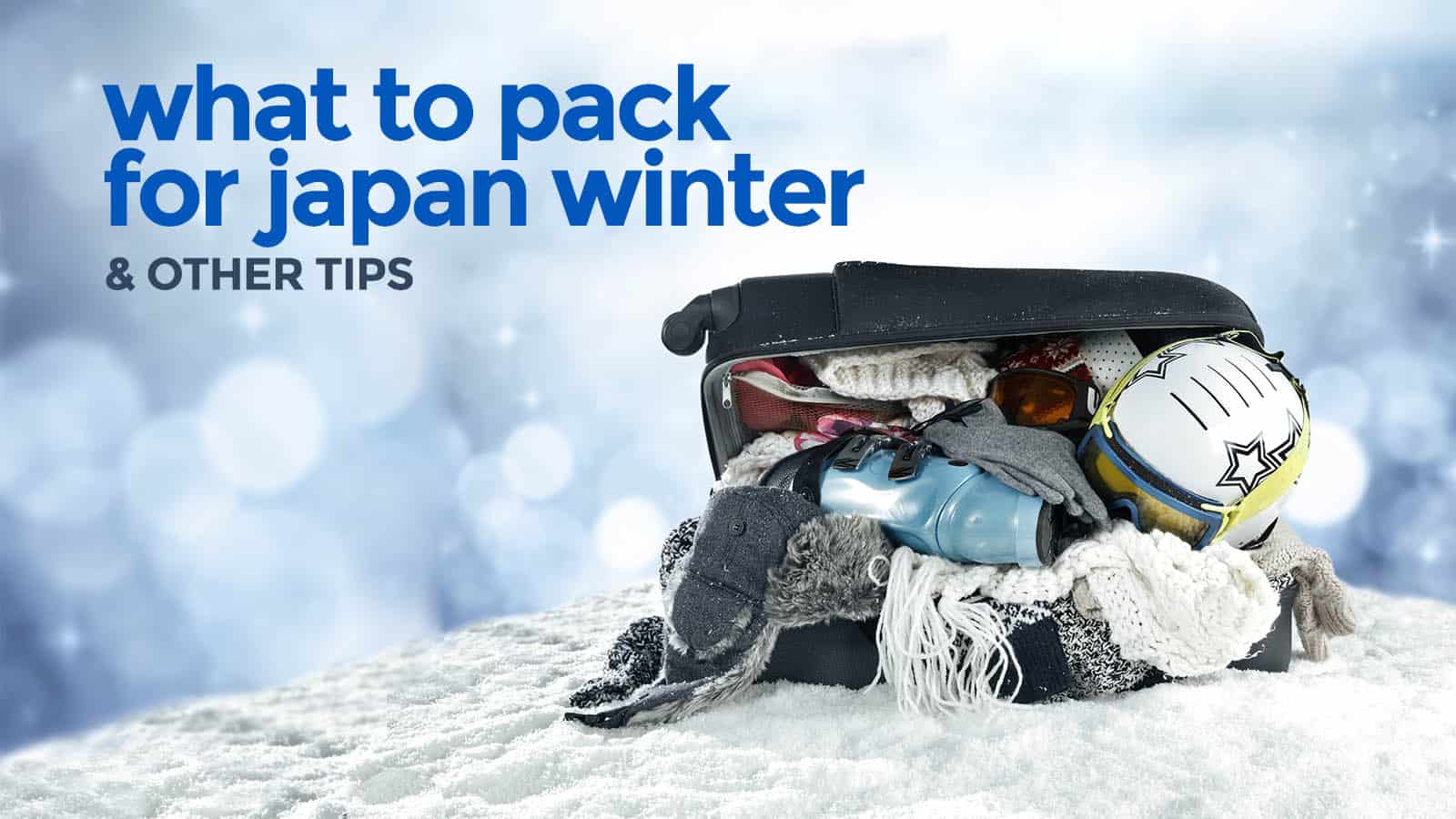
12 JAPAN WINTER TRAVEL TIPS: What to Pack, Where to Buy

Between Vins and I, we’ve been to Japan 20 times so far, spanning over a dozen cities including Tokyo, Osaka, Kyoto, Kanazawa, Hiroshima, Nagoya, Takayama, Ibaraki, Biei, and Sapporo. Seven of these trips happened in winter.
Our obsession fascination with winter probably stems from the fact that we spent 30 years of our lives in tropical islands. Like many kids who had never seen real snow, we grew up dreaming of white Christmas and winter wonderland! Many of us whose roots are planted near the equator once imagined ourselves in that snow globe we shook dreamily. And that was way before Frozen hit the theaters. Imagine kids these days. (Cue: Do you wanna build a snowman..? ) For us, snow is a reward, something that we could only see if we work hard enough to afford it, after we had been burdened by life’s many responsibilities. While I’m aware that too much of it has a dark side, for the young, naive me, snow is not ice powder but fairy dust, the stuff that magical places are made of.
And of all these winter wonderlands, Japan is probably the most accessible.
If you want to make your icy dreams come true in Japan, you have to prepare for it. Winter may be dreamy, but it is often harsh and can be unforgiving. Here are some tips!
1. Thermal Underwear
It can be challenging to walk around in multiple layers of clothing. The best way to minimize this is by being smart with the pieces you wear. For this reason, purchase thermal underwear.
Thermal underwear traps the body heat to insulate the wearer against the cold air outside. It covers your entire body: not just the torso but also the arms and the legs.
In Manila, you can find it at UNIQLO or Marks and Spencer branches. At UNIQLO, tights or leggings are somewhere between P790 and P990, long sleeved tops are also within the same range. But if they’re too pricey for you, some stalls at St. Francis Square sell them too.
The thing is, it’s much cheaper to buy them in Japan than in the Philippines. For example, the bottom tights or leggings that cost P790 at UNIQLO in Manila, they cost only 790 YEN in Japan. ¥790 is equal to only P350 . That’s less than half of the Manila price.

My advice is to buy just one pair before your trip and then buy the rest when you’re already in Japan. UNIQLO and GU stalls have them.
2. Layering
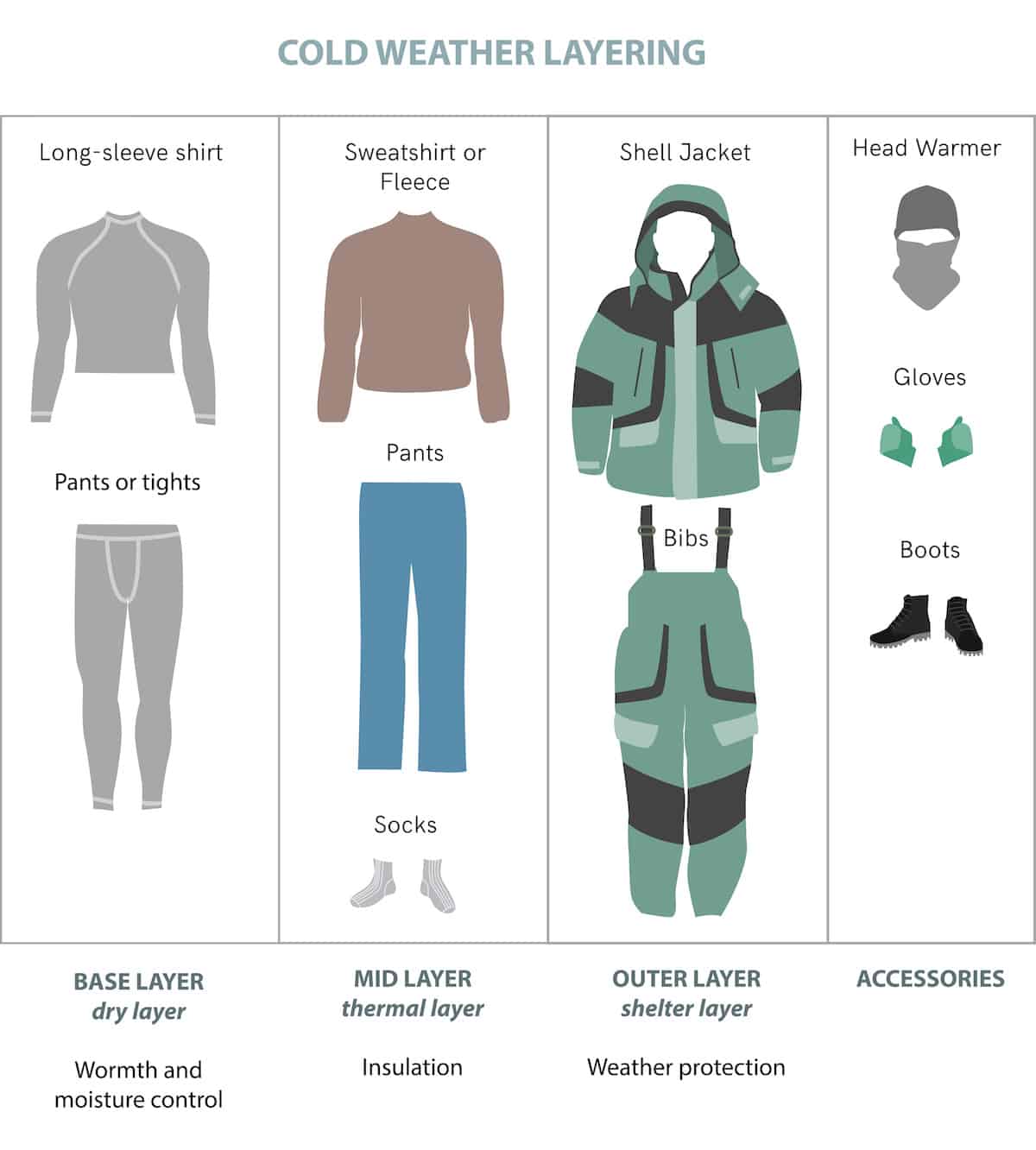
I usually just wear four layers when I’m sightseeing.
- The Base : Thermal underwear.
- The Mid-layer : Sweater (fleece, wool) and pants (denim).
- The Outerwear : usually a trench coat, pea coat, or a padded hoodie, depending on my activity for the day. May be wool, fleece, polyester.
- The Accessories : gloves, scarves, beanie, .
Choose an outerwear (jacket, blazer, overcoat) that you can easily take off. In winter, buses, trains, and establishments are well-heated, so no matter how cold it is outside, it can still be pretty warm inside. It can be inconvenient and annoying to take your jacket off and to put it back on over and over again, so choose a piece that you can easily get out of.
For cheap finds, visit your suking ukay-ukay. But if you don’t like hand-me-downs, go to SM Surplus Shop, St. Francis Square or Greenhills for off-season garments.
Again, it’s cheaper to just purchase outerwear in Japan.
By the way, if you want to blend in with the locals, pick clothes that are black, white, gray or neutral. This is especially true in Tokyo. Outside the capital, colors get more common.
3. Shoes, Socks, and Accessories

Even winter shoes and accessories are much, much cheaper in Japan. If you don’t own gloves, scarves, beanies, or even ear muffs yet, I suggest that you buy in Japan instead.
- Shoes . Walking on snow can be dangerous because it can get slippery. Make sure your shoes have a great grip and provide good traction. Boots with non-slip neoprene or rubber is ideal, especially if the soles have grooves. I have tried using only the typical sneakers and gosh, my butt met the ground so many times. (More about walking over snow below.)
- Socks . Purchase long socks and make sure they look good. In Japan, you’ll have to remove your shoes on multiple occasions like entering temples, shrines, traditional restaurants, and ryokan (traditional Japanese inn) among others. Make sure they are presentable and have no holes.
- Scarves . While Tokyo locals prefer dark or neutral colors for their clothes, you can be more creative when it comes to accessories. Most scarves are still pretty muted, though.
- Gloves . Essential in colder months (January/February). Problem with the regular gloves is that it makes using your phone harder. If you feel like you’ll be depending on your smartphone a lot, but those pairs with special tips that can be detected by phones.
4. Sunglasses
I always get weird looks from my companions — be it family, friends, or other bloggers — when I put on sunglasses in snowy places. Just because it’s cold and cloudy doesn’t mean the ultraviolet rays are not there. We still need to protect our eyes especially from the UV rays that the snow reflects.
Up to 85% of the UV rays from the sun bounce off of snow , and this can lead to a condition called snow blindness . The medical term is photokeratitis (or inflammation of the cornea). So please, don’t forget sunglasses.
5. Sunscreen, Moisturizer and Lip Balm
Winter is brutal to the skin too. The cold can leave your skin dry and your lips flaky. Help lock in the moisture by using your trusted moisturizer and lip balm.
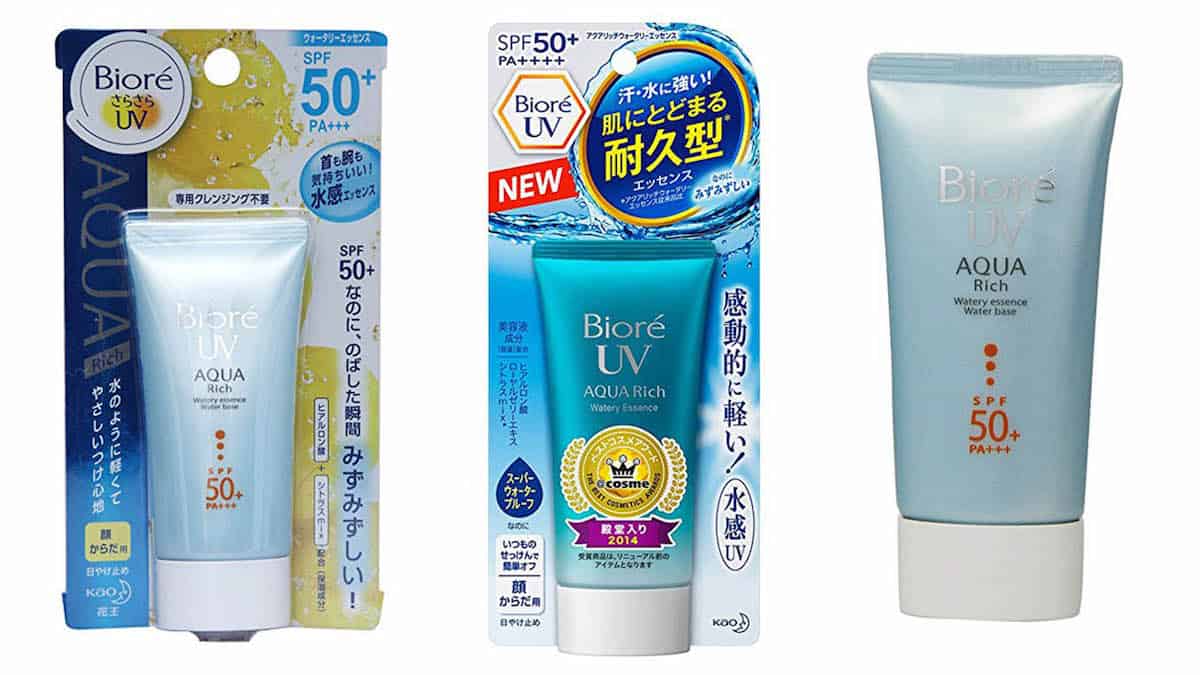
Sunscreen is also essential even on cloudy days! My sunscreen of choice is BIORE UV AQUA RICH with SPF 50. It’s water-based so it doesn’t leave a sticky feeling. It protects the skin from harmful UV rays. It became available in the Philippines in 2016, but if you can’t find one, you will definitely see it at convenience stores, cosmetic shops, or supermarkets in Japan. It’s a bit ubiquitous in Japan.
6. Meds and Surgical Face Mask
The body becomes more vulnerable in winter. The common cold is, well, common.
In Japan, people do not wear mask because they’re afraid to catch a cold. They do it because they do not want whatever illness they have to spread to other people. If you have a cold or cough — and it’s easy to catch it in winter — the polite thing to do there is to keep your nose and mouth covered. Masks are available at convenience stores, too.
And oh, bring your own meds for common, non-serious illnesses so you don’t have to worry about the language barrier in case you get sick.
7. Heat Pack
You know what else is available at convenience stores in Japan? Kairo .
Kai-what? For foreigners, kairo is more commonly referred to as a heat pack or pocket warmer . It’s a small package that contains heat-generating powder or liquid that you can attach to your clothing. (Stick it to your clothing, NOT your skin. Avoid skin contact.)
It’s perfect for those with low cold-tolerance because it will provide the necessary warmth for around 12 hours.
8. Humidifier in your Hotel Room
Many hotel rooms in Japan are equipped with humidifiers in winter. Humidifiers add moisture to the air, which will prevent skin dryness and irritation. It can also relieve dryness of the throat and lips. This can make your stay much more comfortable.
Some hotels provide humidifiers for free. Some rent it out. But to be absolutely sure, contact your hotel before your trip or request for one at the reception upon arrival.
9. Hot Drinks from Vendo
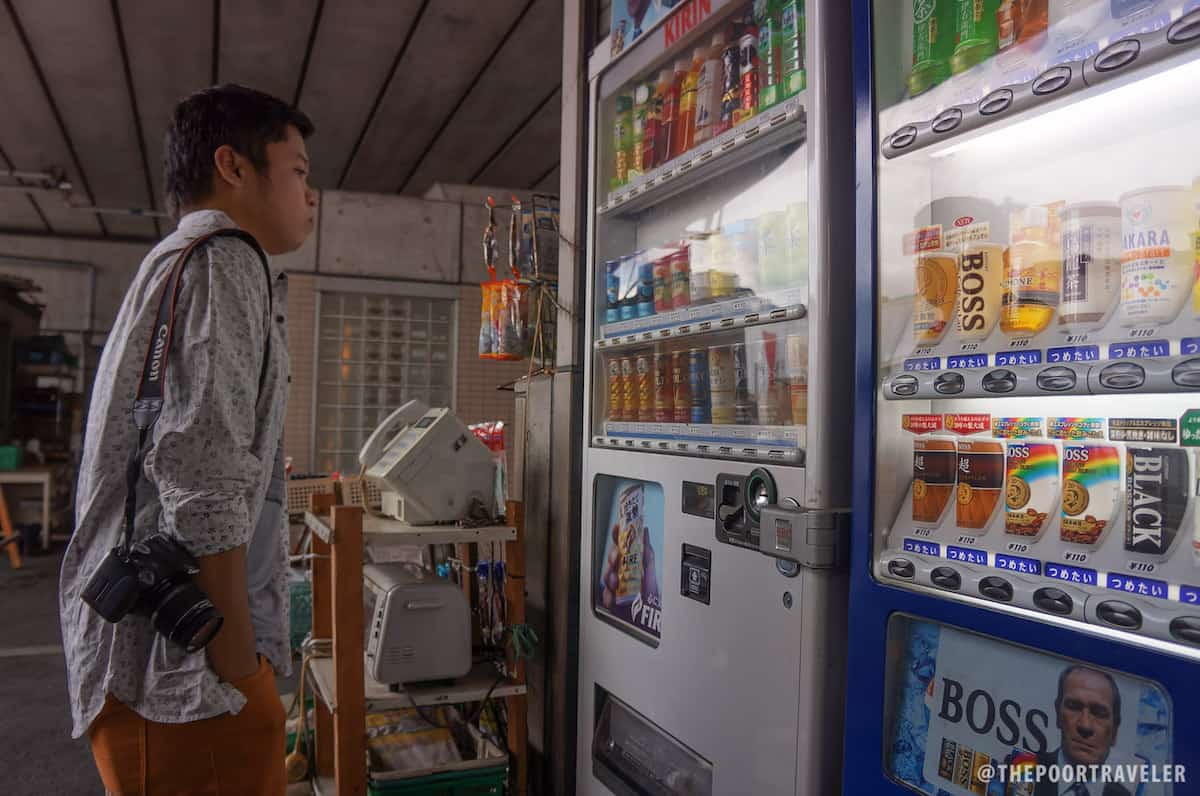
Another way to battle the cold is having a hot drink. In Japan, you don’t need to walk into a cafe or restaurant to have a cup of hot chocolate, coffee, or tea. Hot drinks are widely available at many vending machines throughout the country. Many first-time travelers in Japan don’t notice them because they’re usually in the same machine as the cold beverages.
Hot drinks are often marked RED, while cold drinks like sodas are marked BLUE. (Often. Not always.)
10. Walking on Snow
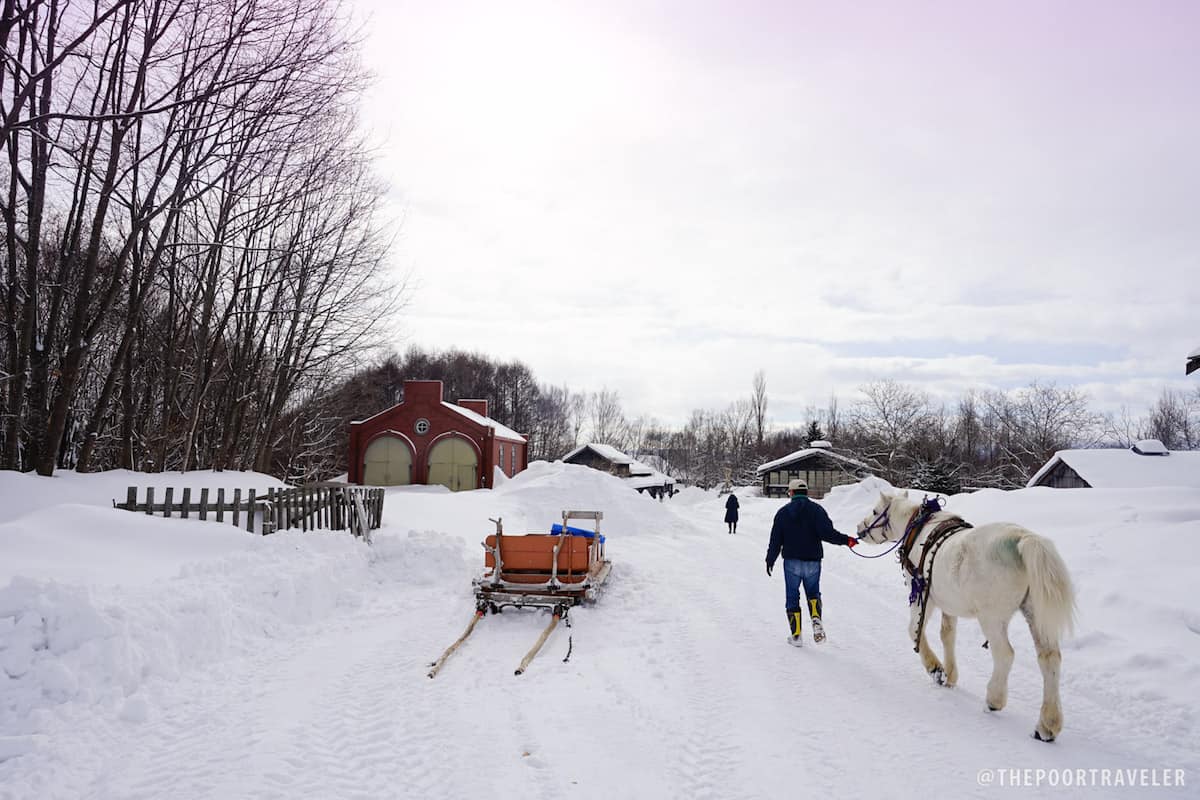
Like I said earlier, walking on snow can be dangerous so take extra care. If it’s your first snow experience, you may feel tempted to step on snow immediately, but you need to figure out which parts are slippery and which parts are safe. Some pointers.
- If there is a designated walking path, stay on that path . It’s hard to tell what’s underneath the snow sometimes. You might walk straight into a hole. True story. LOL. Seriously though, I once walked right into a hole in the ground because the entire place was covered in snow. This was in Sapporo.
- If the snow looks dark, wet, compact or icy, it’s probably slippery. Avoid stepping on that.
- Maintain balance by stretching your arms out to the sides . Don’t put them in your pocket. Having your arms out also gives you better reflex should you slip or fall.
11. Tattoo and Onsen
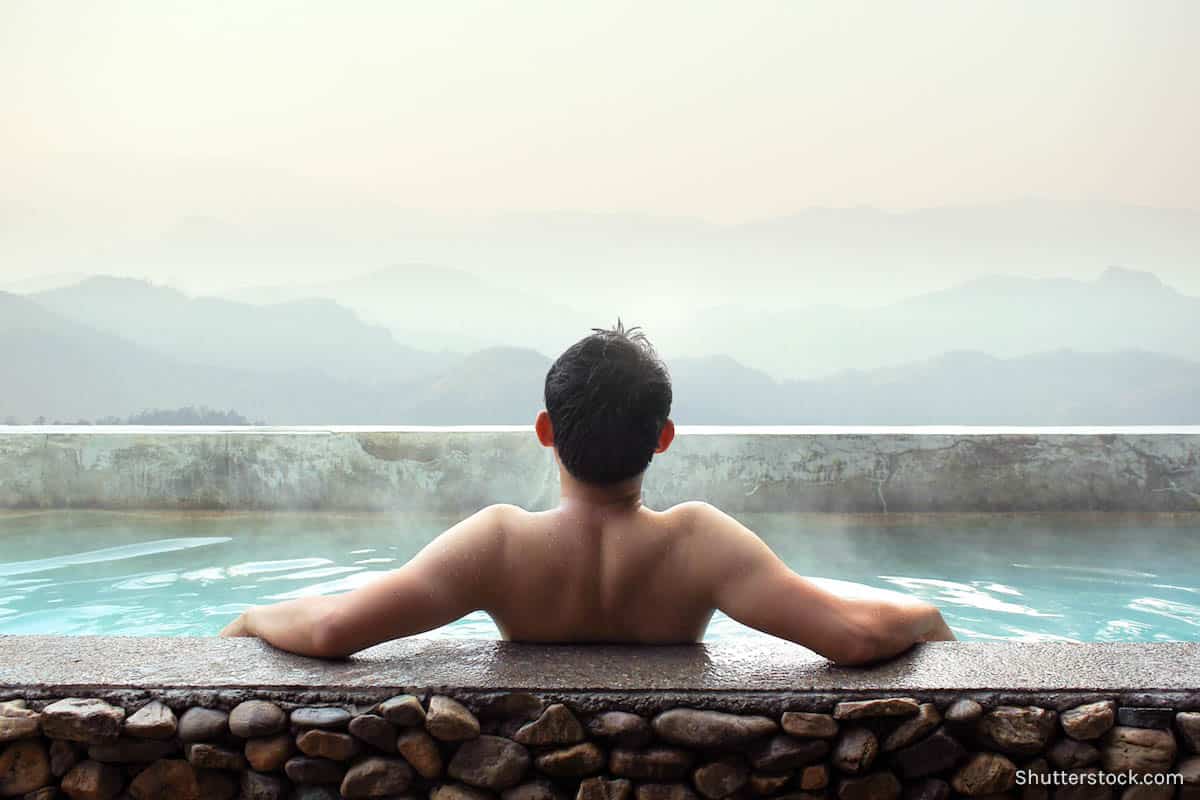
Nothing is more relaxing than taking a hot bath in winter, which is why onsen and sento are very popular throughout Japan. Onsen is hot spring, while sento is public bath that uses regular water. Onsen is generally fancier and more sought after.
However, tattoos are banned in most onsen and sento. Although the younger generations are becoming more open to it, tattoos are still generally frowned upon in Japan as a whole. The aversion probably stems from its long history of association with criminality, whether as a punishment or as a symbol for the Japanese mafia.
Some onsen places accept guests with tattoo. There are websites that keep a list of these establishments. But in most onsen, you may be asked to leave. Some guests with small tattoos get away with it by using concealers or getting creative, though.
If you really want to experience an onsen and you have tattoos, a good alternative is the so-called kashikiri-buro , which is a private bath. You can also stay at a ryokan that offers rooms with private onsen, but these are very luxurious (ergo: expensive).
12. Timing is everything.
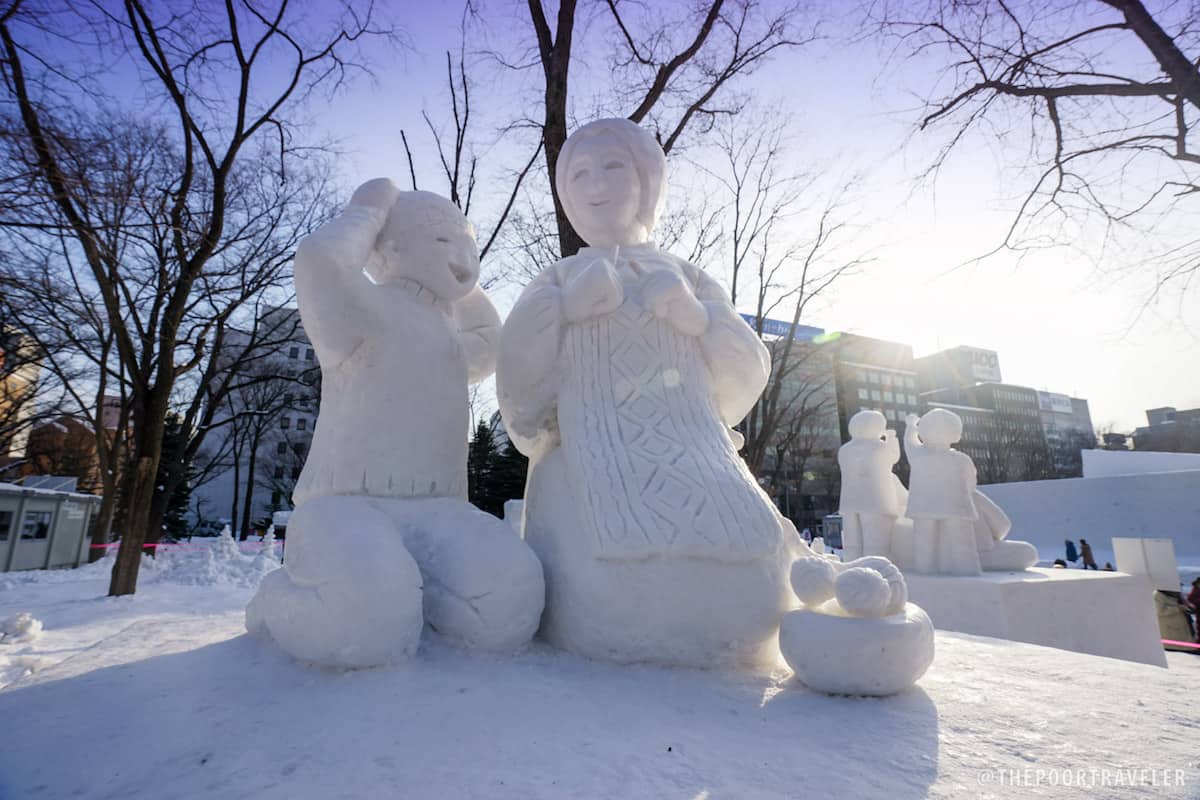
Winter may not be as vibrant as the other seasons, but it doesn’t mean it’s boring. Before booking your flight, check the schedule of festivities in your destination. Here are some well-known events.
- December 23 : Emperor’s Birthday Appearance at Imperial Palace, Tokyo
- January 1 : Hatsumōde (first Shinto shrine visit), nationwide
- January Week 1 : New Year SALE, Tokyo and Yokohama
- January 2 : Emperor’s New Year Greeting at Imperial Palace, Tokyo
- February : Sapporo Snow Festival (dates vary, early February)
Also, winter illuminations are worth checking out. Numerous installations are scattered all over the country. Schedule is often between mid-November to February, some until March.
Japan isn’t big on Christmas. Although you can hear Christmas tunes and see decors at commercial spaces, it’s a regular working day. New Year’s Day is a holiday, but don’t expect to see grand fireworks displays. Locals gather at Shinto shrines on New Year’s Eve for hatsumōde, the first shrine or temple visit. If you decide to experience this, know that it will be super crowded and the lines can extend for blocks.
In winter, days are shorter, which means you have fewer hours to explore. Establishments also close earlier than usual, so make sure you double check their winter schedule.
If you’re into photography, don’t expect to see the sunset at 6pm. The golden hour happens at 4-ish in the afternoon.
2️⃣0️⃣1️⃣7️⃣ • 1️⃣2️⃣ • 2️⃣6️⃣
More Tips on YouTube ⬇️⬇️⬇️
Is this post helpful to you?

Related Posts:
- JAPAN VISA REQUIREMENTS & Application for Tourists
- SAMPLE ITINERARY for JAPAN VISA Application (Schedule of Stay)
- FIRST TIME ABROAD: Airport Tips & Frequently Asked Questions
- 8 Ways to Save While Traveling In India
- 5 Reasons We’re Excited About ANA’s New Tokyo Haneda-New York/Chicago Flights
- JAPAN VISA: LIST OF TRAVEL AGENCIES Accredited by the Embassy
- HIROSHIMA ITINERARY: 9 Best Things to Do & Places to Visit
- THE BEST OF TOKYO IN 2 DAYS: Sample Itinerary and Budget

- Recent Posts
- 2024 Resorts World One HONG KONG CRUISE Guide for First Timers - 13 April 2024
- FLIGHT RESERVATION for VISA • How to Get Dummy Ticket for Schengen, Canada, China and Other Visa Applications - 22 March 2024
- 2024 Cebu Pacific Promos & PISO SALE with List of Covered Destinations - 4 March 2024
Hi, do you have any tips regarding gadgets during winter in japan, mobile and cameras like is it safe to use camera in freezing environment?
I am planning also to experience snow for the first time. from manila also. thank youuuu! this blog is very very helpful.. thanks for this! xx God Bless.
I used a Huawei phone and a Canon 550D in -10 degrees celcius in Sapporo, I didn’t have any problem.
One of our mobile wifi units suddenly died though. Our Osmo camera and iPhone also malfunctioned (would not turn on for a long time). But it eventually did inside the hotel.
Hello. What is the rate of possibilities that it will snow or there will be a snow during December? Probably last week of Dec to 1st week of January? Since you said most of your trips in Japan were during winter season.
Depends kung saan sa Japan ka pupunta. If sa north like Hokkaido (Sapporo) and mountainous regions like Nagano or Shirakawago, there is a big chance na may snow na, at least on the ground.
If Tokyo, maliit lang ang chance because the first snow in Tokyo doesn’t happen until mid-January. Although naranasan ko na before na nagsnow November pa lang. Pero it was very rare and sandali lang. If Tokyo ka papunta, your best bet na malapit lang is Yamanashi.
If Kyoto, probably light dusting at best and the snow won’t stick.
If Osaka, malabo.
hi, your response is very helpful. we are having our first trip to japan by the 12th-19th of next year. should we expect more winter? and how about clothing? thank you
Wow! Thank you for the info our family will have a first trip to Japan in 26dec to 1 Jan and I learnt a lot after reading all your info. Appreciate that much!
Hi. What would be the best tip you would advise for a first timer in Japan that will travel by first week of March?
Hi Reyn, winter pa rin naman yung first week of March, so same pa rin yung mga tips ko for it.
Hello would u know where can i rent pocket wifi in tokyo like for 1 week? Thank you!
Hi Lany, have you tried Klook? Check this out: https://affiliate.klook.com/jump/activity/1306-4g-wifi-device-tokyo/?adid=4353&af_wid=825
Hi, we’ll be having a trip by first week of dec., tokyo, how’s the weather during those days.
Generally cold but no snow. Check accuweather na lang din.
Hi We will be travelling to Osaka next week, so most probably hindi naman mag snow diba? But it will still be cold kahit hindi mag-winter? Kasi 6 degrees yung lumalabas sa research. :D
Hi Patrick, winter sa Osaka now. Malabo ang snow sa Osaka ng early January pero it’s very cold.
Thank you for this wonderful tips. Upon reading this and other similar blogs, I conclude that it’s better to buy winter clothes on our destination; in this case in Japan. It’s our first time to travel in a winter season and I realized that buying winter outfits in a tropical country is quite challenging and very expensive even if it’s already on sale!!! I’m also reading a lot of negative feedbacks on the quality and it’s not like we can try them on and say that they were right. So! I decided to allot a shopping fund for our winter clothes and do our shopping in Japan. Do you have a suggestion on how much I should allot? I am traveling with my two teenage daughters so the budget should be for 3. Just the basics that we shall need to survive the cold..
You can check GU shops. You’ll find coats for sale for less than 5000 yen. Some are much cheaper. Thermals at less than 1000 yen per piece (top or bottom). Scarves for around 1000 yen.
Hi, first time naming pupunta ng Tokyo this second week. How much ang ticket pagpasok ng Disneysea? Thank you!
Everything we know about DisneySea is here: https://www.thepoortraveler.net/2017/05/tokyo-disney-resort-travel-guide-tips/
Hi. If walang snow sa Osaka, where is the nearest snow park? Planning to go there sa 3rd week of December this year. And available ba ang USJ entrance ticket sa KIX airport o mas maganda bili in advance sa klook?
I think the closest snow park is Rokkosan in Kobe. More info here: https://www.thepoortraveler.net/2019/02/diy-kobe-days-trip-itinerary-osaka/
i learned that the winter/snow festival is usually feb. what other festivals happening in jan first week in hokkaido? not lots of info on that. think, our trip is bad timing. any suggestions where we can celebrate new year in sapporo? lastly, can we enjoy affordable private onzen without booking riokan hotel?
thanks much for very informative infos
hi, good day po :D , kapag first to 2nd week of december po need pa rin po ba mag heattech? or di masyado malamig? thanks :D
Hi Cathy, saang part ng Japan ka punta?
Hi! We are going to visit Niseko this January. Is it vital to wear waterproof boots/shoes? TIA!
Hi Cath, if you can, better, and make sure may magandang grip. Di kasi madali maglakad sa tumigas na snow.
Hi my visa expires feb 19, 2020 have trip jan 25-feb 2, 2020 can i still use it?
hello, from your experience, anong weather na by 3rd-4th week of November?( Kyoto-Osaka) Should we bring autumn or winter clothes? :) Thank you!
Featured On

We heard you!
Your comment is now queued for moderation! We’ll try to get back to you soonest. While waiting, follow us on these channels.
Subscribe on Youtube! Follow us on Instagram!

The Kosha Journal
- Travel Talk
- Kosha Quotient
Japan in Winter: Essential Travel Tips and What to Wear
May 13, 2023.

Table of Contents
Discover Japan in Winter: Essential Travel Tips and What to Wear
Are you ready for a winter adventure like no other? Have you ever dreamed of exploring the enchanting beauty of Japan during the snowy season? Wondering what to wear in Japan in winter season to stay warm and stylish?
Well, look no further! In this exciting blog post, we’re here to guide you through an incredible journey to discover Japan in all its winter glory. Get ready to dive into a world of mesmerizing landscapes, cultural traditions, and of course, the essential travel tips and fashion advice you need to make the most of your winter escapade. So, are you ready to bundle up, explore, and experience the magic of Japan in winter? Let’s get started!
Japan is located in the Pacific Ocean, chilly winds blow over it making the weather gradually cold. Big cities like Osaka and Tokyo have short winters and occasional snowfall.
As you head towards the northern parts of Japan, the temperature starts to drop. You will experience bitterly cold, long winters with heavy snowfall for months. Despite the cold weather, there are many sights to see and experiences to encounter during your trip to Japan.
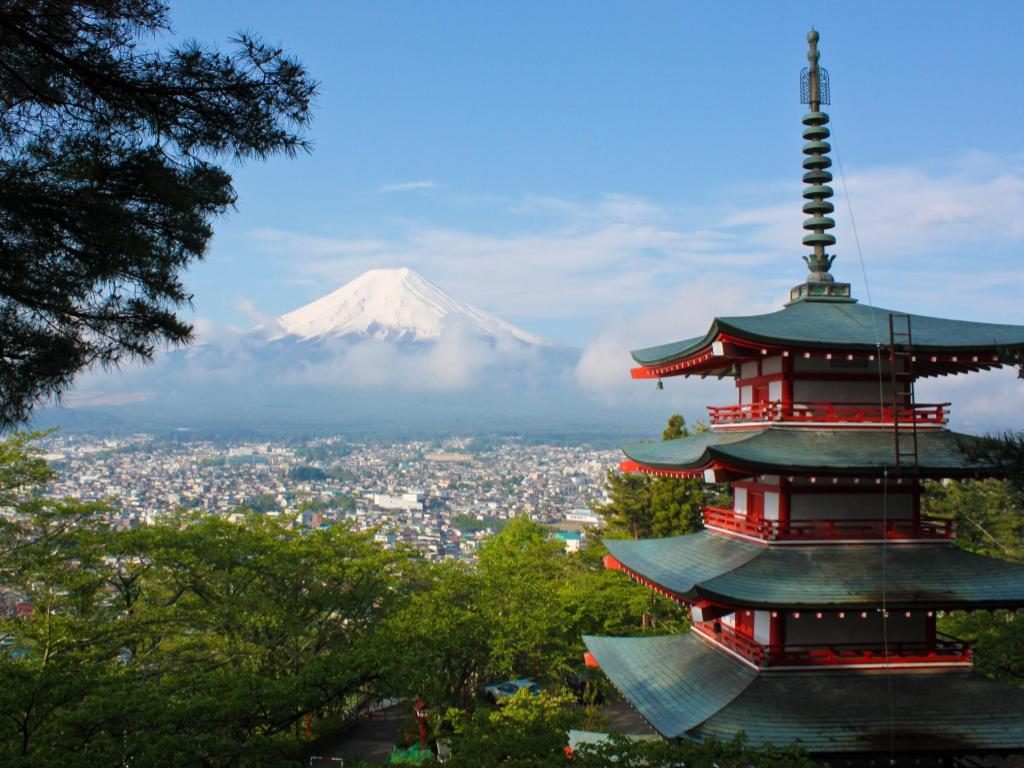
Experience true Japanese culture with culturally rich events that are listed further in the article.
Winter in Japan Travel Tips: What to expect
Japan can be quite a mystery for many visitors as many of us tend to know the country from its architecture and cherry blossoms. But it is important to know that Japan can make a wonderful destination for your next winter trip.
Being culturally rich, it has plenty to offer to its tourists some of which is explained through the course of this article.
Winter temperatures in Japan
Japan experiences the winter season generally from December to February. During these winter months, places like Tokyo, Osaka and Kyoto also experience small amounts of snow thus making Japan a pleasant winter destination.
- December – The temperature range seen in Tokyo is from around 12 degrees Celsius to 5 degrees Celsius.
- January – The month of January sees a further drop in the temperature range. One can experience temperatures as cold as 2 degrees Celsius to 10 degrees Celsius. While August is the warmest month in Japan, January acts as the coldest.
- February – February is when the winter season begins to falter. One experiences a temperature range of 11 degrees Celsius to 3 degrees Celsius.
Things to do in Japan in Winter
Despite the unbearable, rough winters of Japan, all kinds of snow events are held across the country. It comes as no surprise that Japan welcomes over 13 million visitors every year. The advent of the winter season opens up a whole new Japan for the locals as well as the tourists.
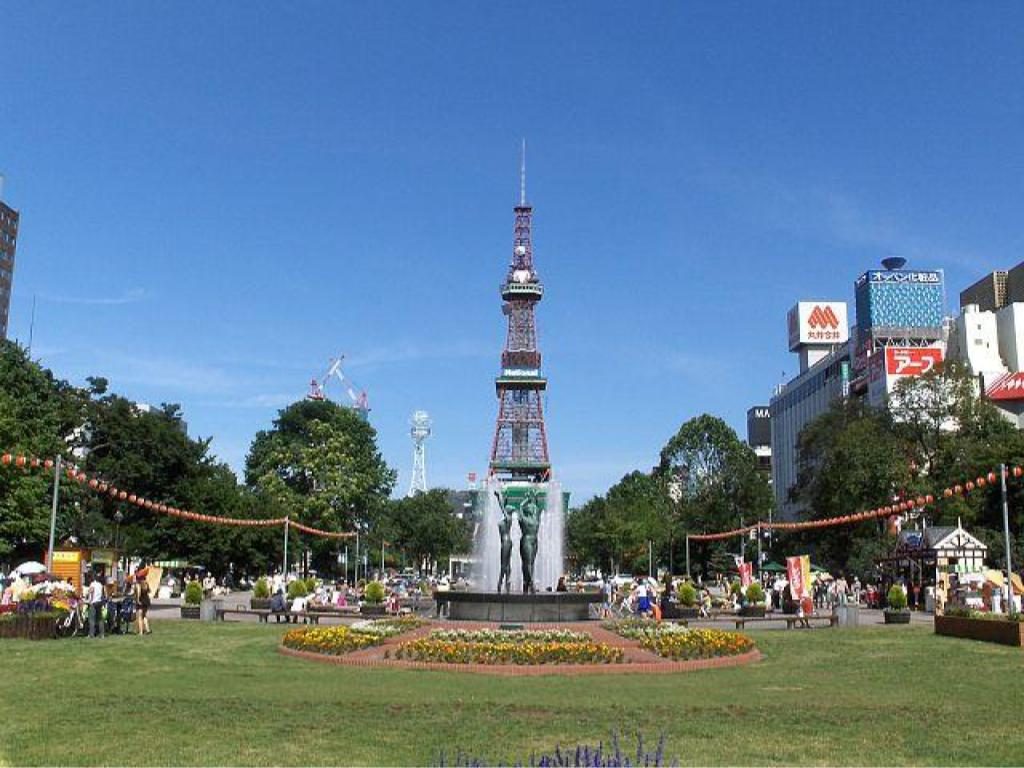
Sapporo Tower, Japan
Apart from the variety of cultural fests, the place is also renowned for sports activities like skiing or hiking. Shiga Kogen is a very popular skiing area and resort for winter activities.
Another place to visit would be the Tadami Line. You might know this place from the plenty of pictures that are taken here. Being a very picturesque area, this is a railway line. Its section between Aizu- Kawaguchi and Tadami has been shut down since July 2011. However, this section is to be restarted later this year or around 2022.
Japan Winter Festivals
Held over seven days in February each year, the Sapporo Snow Festival in Hokkaido is world-famous; the winter showcase during this event is spectacular. One should not miss its breathtaking views which attract many visitors not just during the winters but also during the warmer months.
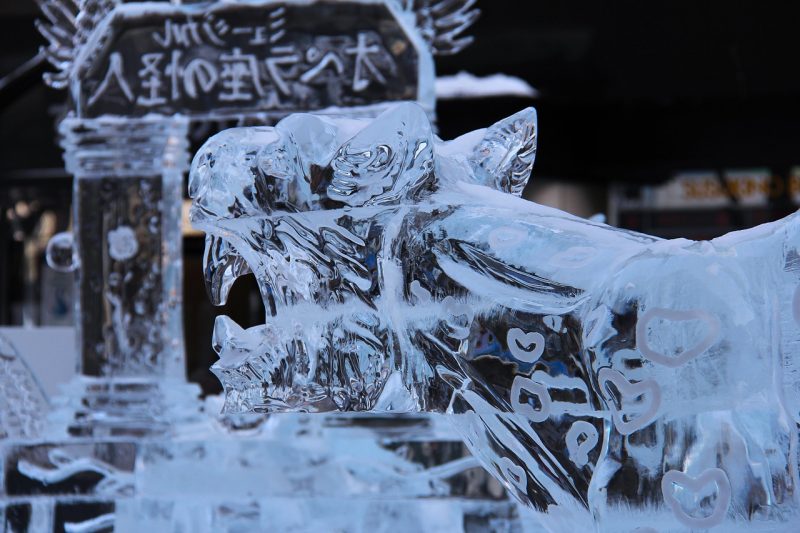
Sapporo Snow Festival
Every year the festival has a tradition of carving sculptures. At night these sculptures are illuminated, and the main street leading from the Sapporo rail station is all done up with lights.
You must witness the gigantic snow sculptures erected by the people of Sapporo and take a look at Japan’s Ground Self-Defence Force which is considered a masterpiece at this event.
The Asahikawa Winter Festival held in February is also known for its snow sculptures. The World Ice Sculpting Contest held here draws many talented ice sculptors not just from Japan but across the globe who vie for the “Best Ice Sculpture” title.
The opening show of this festival has powerful fireworks to thrill you. It looks spectacular when gigantic sculptures of this festival softly glow in the night. It is a sight not to be missed as these winter illuminations remind you of bright lanterns floating on a river.
Snowshoeing in Japan
Another fun-filled activity that one can indulge in is snowshoeing. Snowshoes make it fun and easy to walk through the snow!
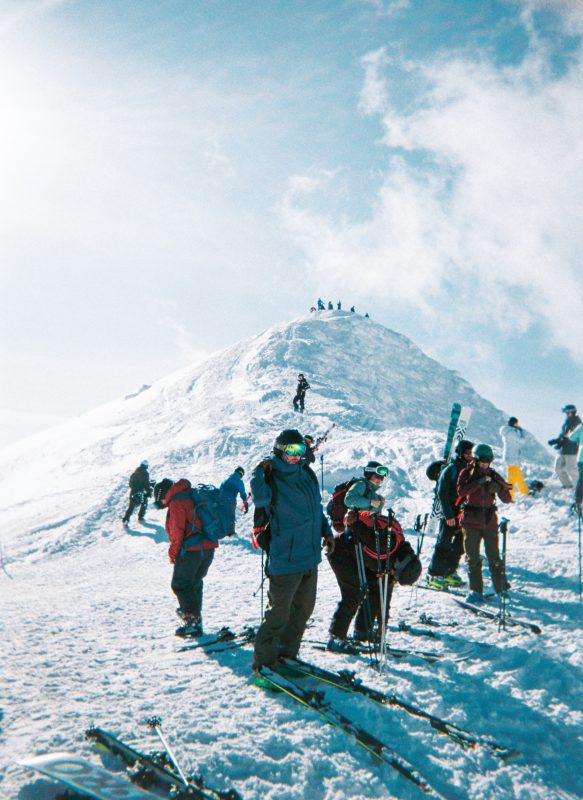
The sparkling-white Myoko Highlands of Japan, called Myoko Kogen, Hakuba and Shigure is considered the Mecca for snowshoeing. It does not matter if you have no experience; try a half-day trip of snowshoe hiking.
Pause to enjoy some icicles, draw angels in the snow, catch snowflakes or watch the wildlife. There are plenty of move-at-your-own-pace snowshoe experiences to be enjoyed here.
You can also try your hand at Origami/Paper folding and making your own soba (buckwheat) noodles under the guidance of Hakuba’s experts. You even get to cook and eat them later.
Visiting the Ice Village
You should also consider visiting the mystic ice villages of Japan that appear only in winter from the end of December to mid-March. Some of the most famous villages are Hokkaido, Tomamu and Asahikawa.
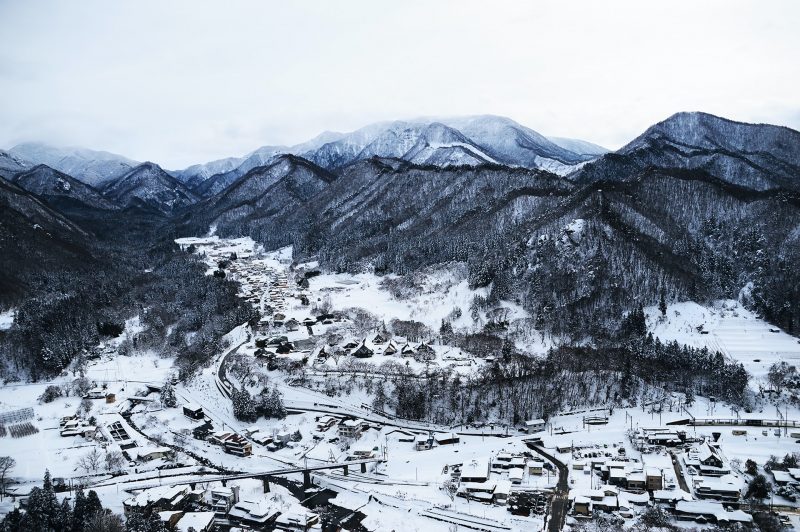
Japan Ice Village
These villages have numerous charming, scenic viewpoints and multiple hotel buildings for those looking for an overnight stay.
One can enjoy activities like the snow park, ice fire palace, warm-up cottages, Santa’s home, ice skating, skiing, and ice bar among many others. Children can be kept busy in ice schools that teach how to make ice candles and glasses.
An onsen is a term for hot springs in the Japanese language and these can be enjoyed throughout the year. Many travellers recommend travelling to Shibu Onsen or Yamanaka Onsen.
These are attractive hot spring towns that have traditional baths for you. Pamper yourself in these traditional baths with mineral content such as iron, cobalt, etc. Many of the Onsens have traditional Japanese floors, known as tatami, in the changing rooms.
Be careful of where you put your shoes. In the Japanese tradition, it is considered bad manners to wear shoes on the tatami.
Nabana no Sato
It is also worth visiting the Nabana no Sato theme park on the island of Nagashima in Kuwana. The Nagashima Resort comprises 4 main facilities – the Nagashima Spa Land, an amusement park which also includes a water park, a hot spring/onsen complex, an outlet shopping mall, and a flower park named Nabana no Sato.
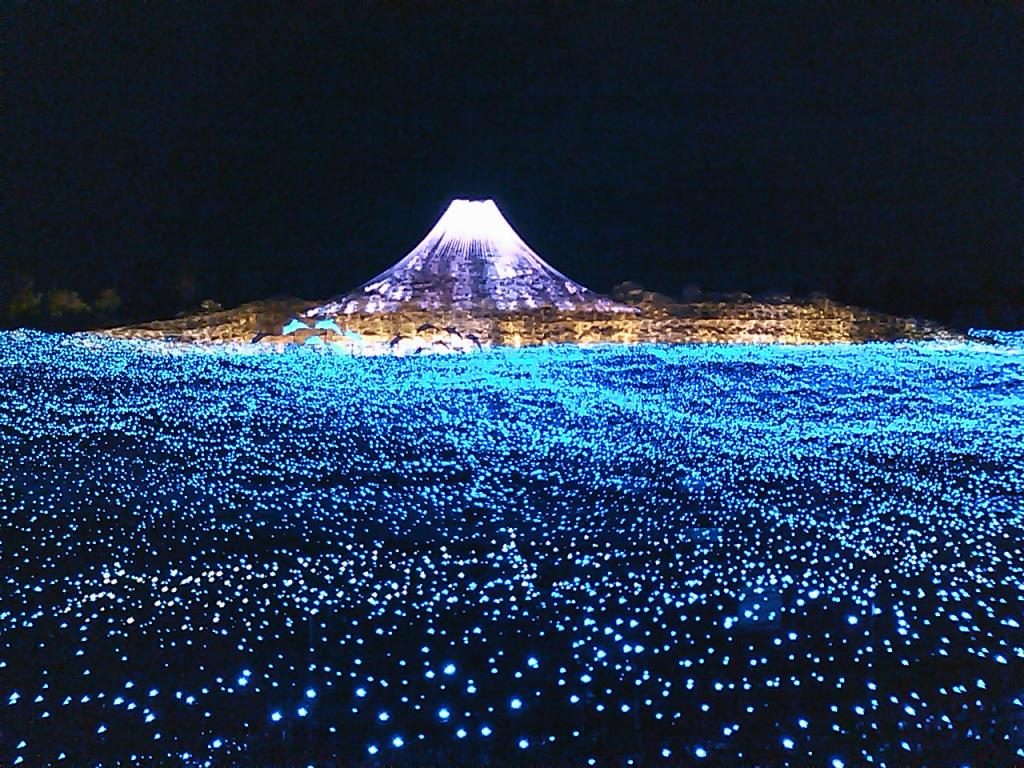
Nabana no Sato, Japan
The gardens are home to a variety of flowers, such as Hydrangea, Tulips, Roses, and Daffodils. Nabana no Sato attracts tourists all year round, however, the Winter illuminations which are one of the largest in Japan, gather large crowds from across the country. They are held from November to the end of March.
Jigokudani Monkey Park
Jigokudani Monkey Park is located in Yamanouchi, Nagano Prefecture in Japan. Being a part of Joshinetsu Kogen National Park, one can find this place near the Yokogu River. The place is also beautified by the heavy snowfalls that are available for visiting only via a 2 km long footpath being covered in snow for four months a year.

View from Jigokudani Monkey Park
Macaca fuscata or the Japanese Macaques are the snow monkeys that this park proudly showcases.
Northern Alps
Home to some of Japan’s most spectacular scenery, the Northern Alps of Japan is accessed from Matsumoto. Gifu, Toyama and Nagona Prefectures are stunning peaks above 3000m that are enjoyed by experts and amateur hikers alike.
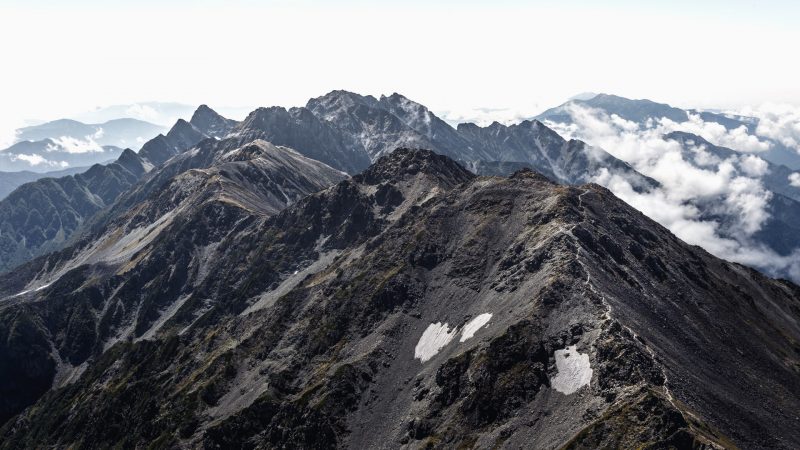
Highlights include the Chubu-Sangaku National Park, Shin-Hotaka Ropeway and soaking up the splendour of Hida’s many mountain rotenburo (an open-air bath).
Open from late July to late August, and during the foliage season in October, Kamikōchi has become a base for day-trippers, hikers and climbers who come for snow-capped peaks, bubbling brooks, wild monkeys, wildflowers and ancient forests.
It’s perfectly feasible to visit as a day trip but you’ll miss out on the pleasures of staying in the mountains and taking uncrowded early-morning or late-afternoon walks.
Ice Fishing in Japan
Ice fishing is a popular winter activity, enjoyed during the cold months of January to March. Barato River of Hokkaido, Eniwa, Shinotsu and Lake Yamanakako are popular destinations for this much-enjoyed family sport.
The thickness of the ice can be more than 50cm! The fishing instructor will show you the ropes, and with a bit of practice, you will find it easy to get yourself off the tasty local wakasagi (smelt)!
Horse Riding in the Snow
Horse riding in Niseko and Mustang’s Town during winter is another great way to relax and see some of the surroundings that can only be reached by horse.
These towns are located on hills, so the air is fresh and blessed with natural beauty. Tours can be organised in advance for beginners in horse riding.
Be sure to carry a wool cap , waterproof warm jacket and thermals to enjoy the ride on this beautiful winter land.
Trying the Japanese Cuisine
Japan happens to be one of the largest culinary countries in the world. The country gives importance to seasonal dishes to decide the menu. Make it a point you order what’s fresh and produced during your visit. In the year 2011, Japan overtook France to be the country with the greatest number of Michelin 3-starred restaurants and Tokyo is the city with the greatest number of Michelin 3-starred restaurants in the world.
Make use of this information and try out the street cuisine and traditional Japanese delicacies. Don’t hold yourself back and stick to what is popular in Japan. Yes, Japan is famous for sushi but don’t forget to try some yummy kaiseki while you are at it.
This multi-course dinner originated centuries ago alongside the tea ceremony that was started in Kyoto. You should even try Natto in the popular Tsukishima restaurant. Try not to limit your exploration of the haute cuisine that Japan offers.
Watch this video for some winter wear trip for your trip to Japan
What to Wear in Japan in Winters
Are you planning to visit Japan in winter and wondering what to wear to stay comfortable and stylish? Look no further! In this section of our blog, we’ll provide you with essential tips on what to wear in Japan in winter season .
Whether you’re visiting in December or braving the chilly temperatures throughout the winter months, we’ve got you covered. From layering strategies to must-have winter accessories, we’ll help you navigate the Japanese winter fashion scene like a pro.
And if you’re considering a trip during the summer, don’t worry – we’ve included some insights on what to wear in Japan when the sun is shining bright. So, get ready to dress to impress and make the most of your time in this incredible country, regardless of the season. Let’s dive in and discover the perfect outfits for your Japan adventure!
Puffer Jackets, Parkas or Trench Coats
Winters in Japan can be tough to take for someone who is not used to very cold climatic conditions. In such a scenario, it is better to research and plan out what to wear well in advance that can keep you warm and enhance your experience in Japan. Layering is a great way to stay warm as it helps to keep you insulated and comfortable in winter clothing.

Warm jackets: Wear them at a ski resort in Japan
The three main kinds of layers are base layers, mid-layers and outerwear or shell layers. Outerwear includes winter jackets and coats like puffer jackets, and parkas. These are usually the outermost winter layer. Check out Kosha’s range of outerwear. Kosha’s parkas and puffer jackets guarantee insulation while being light in weight and compressible.
Check the fleece-lined puffer jacket for men here
Check out the Fleece lined puffer jacket for women here
Sweaters and Pullovers
Sweaters and pullovers are the kind of winter apparel that count as the safest, most trusted winter garments. Reliable for a long time, sweaters have maintained their status as the most sought-after winter clothing. So if you are wondering what to wear on your next winter vacation to Japan, think no more and buy Kosha’s Merino wool sweaters and Pullovers .
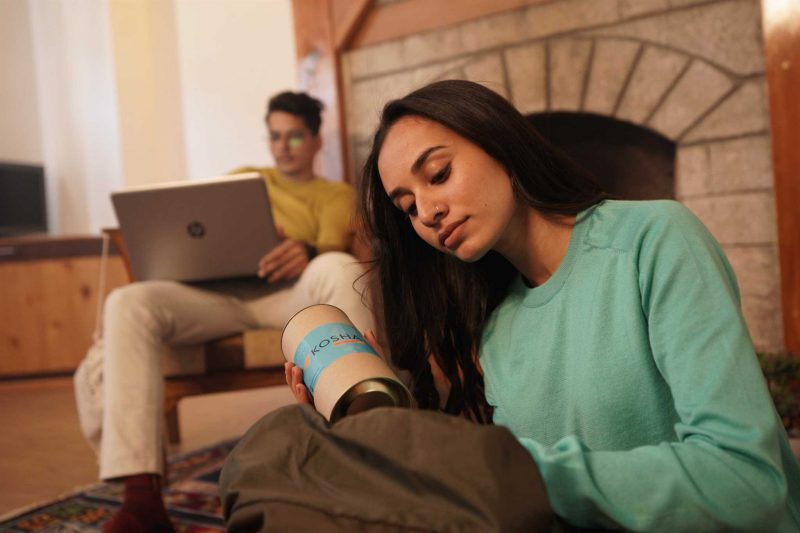
Comfortable Pullovers
Check out Kosha’s range of sweaters which are dual-coloured and reversible . They are available in full sleeves as well as in the form of vests.
Thermal for Base layers
When it comes to dressing for the extreme winters in Japan, winter layering is a must. And one key component of this layering strategy is warm base layers. These base layers, which form the innermost lining next to your body, play a crucial role in keeping you comfortable and insulated from the cold. When visiting Japan in December or during the winter season, especially in ski resorts, combining warm base layers with your outerwear is essential.

Warm Base Layers: Use them along with outerwear in ski resorts
At Kosha, we offer a remarkable range of base layers designed with a unique blend of merino wool and bamboo fabric. This combination ensures that our base layers are not only incredibly soft and cushiony, but also provide optimal warmth and insulation. With base layers worn underneath your regular clothing, it’s important to prioritize comfort and breathability, ensuring that they don’t cause any itching and are gentle on your skin.
Check out our collection of men’s thermal base layers here. And for women’s thermal base layers , take a look at our selection here. By incorporating these high-quality base layers into your winter wardrobe, you can elevate your level of comfort and enjoy the best that Japan has to offer during its chilly winter months.
So, don’t forget to layer up with our cozy and breathable base layers, and get ready to embrace the beauty of Japan in winter with style and comfort!
Merino Wool Snow Pants
When braving the extreme cold or snowy areas of Japan, it’s crucial to wear clothing made from breathable materials that offer both mobility and protection. Heavy fabrics like denim tend to absorb moisture and weigh you down, making it difficult to fully enjoy winter activities.
Instead, opt for snow pants made from high-performance materials like nylon or thermals crafted from merino wool and other sustainable fabrics. These options provide excellent insulation while allowing for comfortable movement. At Kosha, we offer a fantastic collection of winter bottoms designed to keep you warm and stylish throughout your Japan winter adventure.
So, whether you’re exploring Japan in December or seeking comfortable attire for summer activities, consider our range of Merino wool snow pants and other winter bottoms. Embrace the freedom of movement and the protection they offer, and make the most of your winter escapades in Japan. Check out our collection now to figure out what to wear in Japan in winter and prepare to elevate your winter wardrobe to new heights!
Warm Winter Accessories
Winter accessories make for the informal fourth layer of winter wear. However, it should be noted that these informal layers have a lot of utility. Apart from fulfilling the aesthetic requirements that complete an outfit, these winter accessories play a major part in insulation provision.

All-weather Kosha winter wear Accessories
Winter accessories constitute gear like scarves, mufflers, stoles, gloves, mittens, socks, earmuffs, monkey caps, beanies and more. These winter accessories will answer all your queries about what to wear in Japan in winter and will ensure that the otherwise exposed areas of the body are covered and kept warm. Check out Kosha’s range of winter accessories for your Japan trip in winter .
Warm shoes or boots
When it comes to winter in Japan, don’t underestimate the importance of warm shoes or boots. It’s easy to overlook this essential accessory, opting for everyday sneakers or sandals, or even sports shoes with spikes. However, during the winter season, it’s crucial to choose footwear that is specifically designed for the cold weather conditions.
If you are also thinking of what type of footwear to wear in Japan in winter, here is what we recommend! Winter vacations call for lightweight yet grippy shoes or boots. They should provide reliable traction and keep your feet warm and dry. With the possibility of snow or unexpected rain, waterproof footwear is a must-have. So, be sure to pack shoes or boots that are made of high-quality materials and offer the reliability you need to navigate the winter terrain.
Trust us, you don’t want to find yourself settling for the first decent pair of shoes you come across in a foreign country. It’s always better to come prepared with the right footwear, ensuring both comfort and style during your winter adventures in Japan.
So, don’t forget to prioritize warm and waterproof shoes or boots for your winter escapades in Japan. Give yourself the freedom to explore without worrying about uncomfortable or unsuitable footwear. Stay warm, stay dry, and make the most of your time in this incredible country!
Check out winter boots for men here
Check out winter boots for women here
Woollen Warm socks
When it comes to winter in Japan, the significance of socks cannot be overstated. Wearing the right socks is crucial for several reasons. Not only do they protect your feet from shoe bites and blisters, but they also provide essential insulation to keep your feet warm and cozy.
That’s where Kosha’s no-blister socks come into play. These thermal socks are specially designed to meet your winter footwear needs. Crafted from breathable merino wool, they offer superior comfort and temperature regulation. With added arch support, they provide excellent grip and stability. Plus, their mesh construction ensures they are sensitive to temperature changes, keeping your feet comfortable throughout the day. And to top it off, they even help control foot odour, ensuring freshness.
So, when it comes to what to wear in Japan in winter, don’t overlook the importance of high-quality socks. Opt for Kosha’s range of no-blister socks, and give your feet the warmth, comfort, and protection they deserve during your winter adventures in Japan.
Check out Kosha’s no blister socks for men here
Check out Kosha’s no blister socks for women here
View this post on Instagram A post shared by Kosha Travelwear & Winter Layers (@koshatravelwear)
Best time to visit Japan?
Japan is a world apart…
The best time to visit Japan is from December to February. You are sure to find snow-clad mountains, which are perfect for winter sports such as skiing, ice-skating, snowboarding, snowshoeing, ice-fishing, and horse-riding even in the snow.
There are many winter-sport resorts in Japan that offer packages that you can take advantage of to enjoy these outdoor activities.
The Japanese spirit is strong, warm, and incredibly welcoming. If an international holiday is on the itinerary, we suggest that you plan your journey to this gorgeous island nation where a unique civilisation blossomed and today thrives in delicious contrasts of traditional and modern culture. And not just that, we have also answered all questions to help you figure out what to wear in Japan in winter for you to capture your best moments in stylish as well as warm winter clothing options.
FAQ’s
What do people in Japan wear in winter?
Japanese people wear warm winter clothes such as coats, sweaters, and scarves to stay warm in the cold winter months.
How should I dress in Japan in December?
Dress in layers with warm, waterproof clothing in December in Japan, as the average temperature is 45°F (7°C).
How should I dress for Tokyo in December?
Pack warm clothes for Tokyo in December, with layers to adjust to the varying temperatures.
Do I need thermals for Japan?
Yes, thermals are a good idea for Japan in the winter, especially if you are visiting the mountains or colder regions.
What shoes to wear in Japan in December?
Wear waterproof, warm, and comfortable shoes in December in Japan. Snow boots are not necessary unless you are going to be hiking in the mountains.
Stay tuned for more stories! Share your adventure and experience with us by tagging us @koshatravelwear on Instagram , Facebook , LinkedIn , Pinterest and use #mykoshastory!
For any queries related to wearing thermals, base layers, or winter wear in general, visit Kosha’s store and get a free consultation! While you’re at it, check out Kosha’s website for the wide range of thermals and jackets available at Kosha .
This blog article was updated by Kosha Team Member – Sanika Totade.
Packing List for Indian Students Going Abroad in 2023
May 12, 2023, 10 facts about scandinavian countries and their winter, related posts.
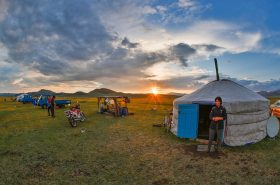
Mongolia Travel Guide: Explore the Land of the Eternal Blue Sky
October 28, 2023.
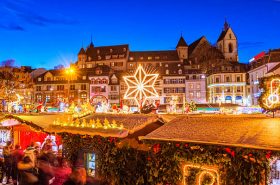
Christmas Markets: The Ultimate Guide to Festive Shopping and Fun

Winter Backpacking Essentials for Your GlampEco Getaway
October 27, 2023, leave a comment.
Our history goes all the way back to early 50s. Prrem and Aloo Vazirani – an accomplished couple who chased after their wanderlust bug. She was a doctor, he was a businessman, and both were filled with a desire to explore the world.
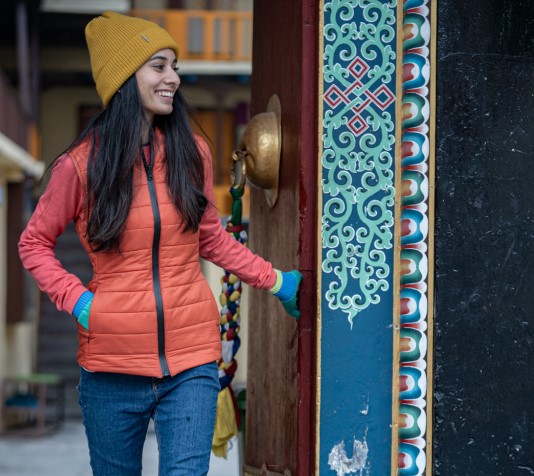
Hello Traveller!
Don't leave just yet!
Our travel clothing will take your wanderlust to the next level.
Claim your RS.500/- coupon now.
Simply fill in below to unlock this exclusive offer.
You have successfully subscribed to the newsletter
There was an error while trying to send your request. Please try again.

35+ Helpful Japan Travel Tips To Know BEFORE You Go
J apan is a remarkable country filled with so much history, natural beauty and modern touches. I’ve just returned from my second trip to Japan and was reminded of so many things I had forgotten about the country! Traveling in Japan is an amazing and enriching experience, however it is also a country filled with traditions and unique ways of operating that visitors may not be used to. Below I share the best Japan travel tips to help you make the most of your trip.
Disclosure: Some of the links in this post are affiliate links, meaning at no additional cost to you, I will earn a commission if you click through and make a purchase.
Top Japan Travel Tips to Know BEFORE You Go
Before you head off to Japan, there are a few things you will need to know in advance and to plan for. While most things on this list can be figured out while in country, a few MUST be done before you leave your home. Whether you opt for the classic tourist circuit Japan itinerary or get off the beaten path , these tips will go a long way to help you enjoy your trip to the fullest.
Get A Japan Rail Pass in ADVANCE
If you want a Japan Rail Pass , it is only available to purchase for overseas tourists BEFORE they enter the country. Once you are in country, you can no longer purchase a JR Pass, so if you plan to use the bullet train between destinations quite a bit, this is a must do before you leave. You must also give yourself plenty of advance notice as well as the pass is still mailed to a physical address.
However, I will say that sometimes it’s not actually cheaper to get a JR Pass. Research the Shinkansen trains here and which trains you plan to take to budget accordingly. Often you can take a train that is just a bit slower, for a lot cheaper.
Regardless, the most important piece of advice for the JR Pass is once it is activated you CANNOT lose it. If you lose it, it is gone. You will not be able to print a new pass. You will not be given a refund. You cannot buy another pass until it is expired as it is connected to your passport. A fellow traveler on my recent trip had this experience, and it was not pleasant to lose a $600 pass on day 1 of his trip!
Keep Your Train Tickets With You
Along with the JR Pass information above, another thing to know when traveling on the trains in Japan is to keep your train ticket with you at all times. One, you will often be asked to show it on many longer distance train journeys and you will need it to exit the stations. Even better is to get a transportation card mentioned below for city travel as it is a little less easy to lose. Trust me, these tiny slips of paper are easy to misplace!
Get an IC Transport Card
There is nothing worse than arriving to Japan, transferring through the airports and needing a drink but unable to get one! Japan’s vending machines and many shops do not take US or foreign credit cards. What do you do when you only have a vending machine as an option in the airport? The best way to deal with this is to download and preload an IC card BEFORE your arrival. Not only does a Suica card or Pasmo card provide easy access to public transportation, it can also be used at vending machines and for small purchases at convenience stores.
Insider Japan Travel Tips You MUST know: If you have an iPhone, you can go to your wallet, click the plus sign, then click Transit Card. Now you can search “Japan” to see the Suica option. Now you can select the amount to add to your card and go through the payment portal. BAM. You are ready to roll upon hitting the ground in Japan.
If you cannot load it on your phone, you can purchase Suica Cards at most train stations. You can also order Suica Cards online and have them mailed to your house abroad prior to your trip to be sure you will have access when in the country.
Learn Basic Japanese Words
While you might find some level of English in the big cities or top tourist spots, much of Japan still exists without much English. I always find this interesting, but again, how cool that they have managed to keep their language and Japanese culture so true to themselves! That said, if you plan to get off the beaten path at all, make sure you know a few phrases and have your Google Translate handy!
The top phrases I found useful while in country include:
Hello – Konichiwa
Thank you – Arigato
Thank you very much – Arigato Gozai mas
Delicious – Oishi
Cute – Kawaii
Cheers – Kanpai
Sorry, Excuse me, Pardon me – Sumi masen
Download Google Translate
One of the most important travel tips I can provide is to download the Google Translate app and Japanese packet as you will often need it. As mentioned above, there is often still quite a bit of a language barrier in Japan, especially in smaller towns or off the beaten path at all. Having Google translate will help you when you want to say something to someone but can’t communicate. The translate will provide it in text for the other person to read which is super helpful. Additionally, you can actually just turn on your microphone and let a person speak into your app and get the translation quickly. This is a great help throughout Japan!
Cash is King
Tipping is not customary.
Contrary to the West, tipping is not customary here and in some cases can be considered rude. To be honest as an American who is asked for a tip at every turn, this was a welcome change. I was so happy to not have to worry about tipping at restaurants, bus drivers or our guides. If you are unsure you can ask, but in general it is not done!
Don’t Expect a Western Breakfast
One of the things I most remembered from my first trip to Japan was the very different, for me, breakfast options. While I am all for trying things and diving into the local culture, sometimes you want a little something that is reminiscent of home. For me that is often breakfast. At most restaurants and hotels, you can expect to see very little western offerings for breakfast. If you want something you are used to (coffee even) you will need to seek out western establishments. I don’t often go to McDonalds at home or abroad, but I sure do like that sausage egg mcmuffin after a week in Japan!
Walk on the Left Side of the Street
Without even noticing it, I found myself crossing over a path of people in the underground to get on the “right” side of the walking path. You will see that people traffic flows very smoothing in Japan and most of that is because of how the Japanese walk on the correct side. Watch the flow of food traffic and you will quickly see where you need to be! When I was in Sapporo, there was an entire city of underground walkways. I quickly realized that everyone was sectioned off in the direction of their travel. It made it very easy to get through even with large end of day crowds. But beware of those very useful, but pesky bumps for sight impaired. They are everywhere and are not really an indicator of which side of the street you should be on!
Get Ready to Take Off Your Shoes
While it isn’t as common to remove your shoes in Japan as it is for say India, you will need to remove your shoes for more traditional establishments including restaurants. We had to remove our shoes at the front door to one of our hotels even and couldn’t put them back on until we were leaving! I love not wearing shoes indoors, but it was not always easy especially when I was wearing my Blundstones that are so difficult to get on/off!
Take Your Passport Shopping
If you would like to take advantage of tax-free shopping, make sure to take your passport with you when you go shopping. Some shops like UNIQLO will automatically give you the tax free savings right away once they see your passport, helping you to avoid doing it at the airport. Other shops will require you get a refund at the airport. If you plan to do any shopping, just take it with you!
Respect the Japanese Traditions
One of the most amazing parts of traveling to Japan is how it is SO different than what many of us are used to. Historically, Japan has been a closed off society. Most of the country is Japanese origin with little Western influence. It is one of the many things that makes it so unique. That said, the most important thing is that you recognize and respect their traditions even if it’s very foreign to you. Take time to learn and ask about the traditions and practice them during your visit. It’s a great way to show respect and fully immerse yourself in the country.
Prepare Yourself for A Japanese Onsen
One of the most beautiful parts of Japanese society is the public bathing system of the onsen. These hot springs are located throughout the country in stunning locations. It is definitely a big part of life here and something tourists should try at least once. I will warn you though, that unless you are having a private onsen, they are completely nude and can be mixed gender as well. I could write an entire article on how to visit an onsen as there are customs and rules to know, but in general you will need to fully shower and bathe with soap before entering the pools, they are totally nude and many do not allow people to enter with visible tattoos. If you are staying in a ryokan with no private shower facility in your room, make sure the staff are aware of any tattoos in advance so they can make arrangements for you.
Transportation Etiquette
Don’t be afraid of shopping at convenience stores.
In Japan, convenience stores are everything. And EVERYWHERE! There are so many varieties from 7-11 to Lawson’s to Family Mart or more local shops like SeicoMart in Hokkaido that you can never be very far from one. Here you can literally get anything you want including breakfast or dinner! You can find ready made meals like fried chicken in Hokkaido to udon noodles, tempura, sandwiches and more. They also have chargers if you happen to have soaked your phone and need a cordless charger. They have candy and sweets, beer, iced coffee and so more more.
Get Ready to Carry Your Trash Around
One thing that is always a surprise to me when I’m in Japan is the lack of trash cans in public spaces. They are not on the roadsides or even that frequently found in shops. You will carry a lot of trash in your pockets all day long! Carry a small plastic bag for your trash to make life easier, but do remember to say no to plastic bags at most places as they are given very freely still or a minimal extra cost.
Separate Your Trash
Japan is not super up on the “use less plastic” concept, but they are very strict about separating their garbage. Hopefully this means they have a much better track record of recycling than we do in the US! If you are not used to separating your trash, educate yourself a bit on what is compostable, what is recyclable and what is landfill trash. At big festivals or events you will find very trash cans (as mentioned above), but when you do, they will expect you to seperate it all into the correct containers.
Eating, Drinking & Smoking in Public
While I am not 100% if there are rules on this, but in general you will notice that the Japanese people do NOT eat, drink or smoke while walking. There are of course designated areas for smoking, which is not allowed all over the place. But for drinking your morning coffee on the way to the train station? Nope, you won’t see Japanese people do this. Is it an unspoken rule or just a custom I am not certain, but I tried to follow suit as much as I could.
Throughout history, Japan has been a closed off society. Would you believe that almost 99% of the country is Japanese? The result is a unique culture with little Western influence and little English. So don’t be surprised if you ask questions or try to converse with people, but don’t receive much of a response. It’s not because they are rude, they simply know they can’t speak your language, and you likely can’t speak Japanese
Japanese Toilets Will Spoil You
Ok, one of the BEST things about Japan has to be their toilets. From the airport to public restrooms, you will find some really great toilets to literally write home about! My absolute favorite that I didn’t realize until I got back home was the heated seats. It really does feel so nice to sit down on a toasty toilet in the middle of the night. There are also several bidet options, drying options and of course also “privacy” sounds/music for many public toilets. Make sure to have your phone handy though as you may need to translate some of the buttons if they aren’t obvious. I have found myself stuff with the water on, not knowing how to turn it off! All of that said, you will also still find squat toilet options in most public bathrooms. They typically have a sign on the door indicating what type of toilet you can expect.
Get an e-SIM For Your Phone
If you haven’t tried an e-SIM yet, you need to get on the wagon. They are SO easy to use, super affordable and available all over the world. For my recently 2 week trip, I used a 10 GB e-SIM card which allowed me to have data access wherever I went. While there is often free Wi-Fi around major cities, often the log-in screen is only in Japanese which makes it challenging to login quickly. Get $3 off your first purchase at AIRLO using my code: KARILY0402
Stay at Ryokan At Least Once
One of the coolest Japanese cultural experiences I can recommend is to stay in a ryokan. A ryokan is basically traditional Japanese inns. While they come in many forms these days including a super traditional ryokan where you sleep on the tatami mats, you can also opt for ones that do have more “western” beds. I have stayed in all various forms and personally I love being able to plop down in an actual bed, but for a one night experience I would recommend trying the super traditional way as well.
As part of the experience, you might find that you have a traditional kaiseki meal for dinner or breakfast, you might also have no private shower in your room or have to take your shoes off at the hotel entrance. It is so fun and cool to see Japanese locals having their dinner or breakfast in the provided yukata (robe in the room) and wearing the slippers. I find this to be one of the most immersive cultural experiences you can have in Japan and well worth the price tag. (Shockingly they are usually quite a bit more expensive than western style hotels).
Japan is Not THAT Expensive
Japan has a reputation of being an excessively expensive country. While it is definitely more expensive than it’s other Asian counterparts, it is also not as pricey as some places in Europe! There are ways to reduce your expenses quite easily. One recommendation to mix up accomodation options – stay in a traditional ryokan, but also stay in chain hotels like Tokyu Stay. We had a great room at Tokyu Stay with a washer/dryer in our room for less than $80 a night. There are plenty of small shops for meals that will run you $5-10 a meal, while more traditional kaiseki meals will cost more. The biggest expense tends to be transport between cities, so that is why it is important to price it out in advance and check for internal flights and getting the JR Pass.
Do NOT Lose (or Keep) Your Hotel Key Card
Traditional hotels still use actual keys, so those are much easier to keep track of and not loose. If you are worried about losing one, you can drop it off with reception before you go out for the day.
Japan Trains Run VERY Timely
While I can’t say that Japanese trains run on time always because I have experienced delays with them, overwhelmingly they do run on a very tight schedule with very little disturbances. This is great as long as you are early, but it’s tough when you are running late! Always plan for delays in the train station and arrive with plenty of time.
Check for Seasonal Festivals
Regardless of when you visit Japan, there is sure to be some type of festival happening. These are often the best places to fully immerse yourself into the culture. For example, the cherry blossoms in the spring often have many festivals that accompany it, which can be quite fun. In Sapporo, there is an Autumn Festival in September that brings in tons of amazing food options every day for visitors to sample.
Bring Snacks With You
Whether it is a bus or train journey, do not plan on food being available. There are no dining cars on trains regardless how many hours they are. We found out the hard way that we needed to always have water and snacks with us because options were not always available. Shockingly though, you can eat and drink on the long distance trains, just make sure to take all of your trash with you.
Tap Water is Safe to Drink
One of the best things about travelling in Japan is that the tap water is safe to drink. I loved not having to purchase water bottles all the time or worry about water being bad quality. I even drank from a mountain spring in Rishiri Island that was crisp and cold and so delicious. Bring you recyclable water bottle and fill up in the hotels every day instead of buying more plastic.
Public Space & Japanese Etiquette
Japan has a concept called “ma” or personal space. Respect it, especially in crowded places with lots of people. Many of these etiquette rules are unspoken, but if you take time to look around you, you will notice that the Japanese people strictly adhere to them. Again, one of the best Japan travel tips I can provide is to look around you and follow what the locals are doing!
Wear Your Bag In Front on Crowded Trains
In places like Paris or New York, you might see people wearing their backpacks on their front on busy trains, but in Japan this is not for safety as much as it is a respect for fellow passengers. When you wear your bag on the front you are making sure that you are not accidentally hitting other people. This culture is one that is very fond of respect for others and I just love this example!
Safety in Japan
Overall I feel VERY safe in Japan at all hours of the day and night. Trains can get super crowded and you will see people wearing their bags in front like I mentioned above, however that is not necessarily for safety as it might be in other cities. All of that said, I would still be aware of your belongings when in crowded public places and wear your mobile on a strap like this one to make sure it isn’t snatched!
Use Google Maps for Train Travel
If you don’t already use Google Maps, one of my top Japan travel tips is to download it now! One of the coolest features of Google maps is that it will tell you how to walk to a train station, which train to get on and even which exit to look for when you arrive to the destination train stations! However it is important to note that oftentimes your internet may not work in the subway stations, so it is a good idea to have it all loaded before you get underground.
Expect Lines at Restaurants
Dietary restrictions are challenging.
In Tokyo you can often manage with dietary restrictions more easily, but once you leave the big city, it can often be quite challenging to deal with dietary restrictions. I personally am allergic to MSG, which meant asking everywhere if I could eat the food prepared. For the most part, most chef’s knew instantly whether they used it or not. In the more rural parts of Japan in the far north of Hokkaido, I ran into a few more challenges. If you are a strict vegetarian, it is also a bit cumbersome to find food that does not include any fish sauce as it seems to be included in a ton. Just take your time and ask around as there are often places that can cater to your needs.
An International Drivers License is Required in Japan
If you plan to hire a car and self drive during your visit to Japan, make sure you acquire an International Driver’s license before you leave home. If you are in the US, this is easily obtained at AAA for around $20 in one day. This is just an additional piece of paper that says that yes, your license is for driving and you are able to drive outside of your home country.
Japanese Wait for the Walking Sign
Just like in Germany, for the most part Japanese people do not jaywalk or cross until the walking sign is illuminated. I have seen a few people here and there cut across the road or go before the walk sign is lit up, but by far the general rule is that you wait patiently on the sidewalk!
Try All the Drinks, But Don’t Expect Much More than Coke
In Japan you will quickly notice that the only western drink you can purchase by and large is Coca Cola and not even diet, just regular coke. I was so surprised when our Japanese exchange student had never had a Sprite, but after my recent visit I was reminded why – it’s tough to come by! Only occasionally did I see a Sprite in a convenience store and almost never in a vending machine. Overall, you will be presented with a ton of drinks that are only Japanese!
Also, I found out after much sampling and discussion with our Japanese hosts – you will never find sweetened tea in the vending machines unless it is Chinese or American. They do not put sugar in their green tea at all. I purchased MANY tea varieties looking for a sweet option, with absolutely no luck!
Buy From ALL the Vending Machines
One of my top Japan travel tips includes buying stuff from the vending machines. I just love the vending machines in Japan. And I love that you can purchase almost anything in the world from them. At one of my onsen visits, they had a vending machine with underwear (new!), razors, earbuds and more. We saw a vending machine selling frozen ramen which would be the perfect take out food if you lived there. You will of course find drinks machines everywhere you go as well. My favorite one of the entire country has to be the “cake in a can” vending machine in Sapporo. The cake was amazing as is the concept. It was pricey, but worth it at least once.
Another great one to look out for and try is a coffee vending machine. You can usually adjust how strong you want the coffee, how much sugar and how much milk. It is so fun to just pay 100 yen and have a hot coffee. Additionally, on most regular machines you can look for the signs that say hot/cold as some machines dispense BOTH hot and cold drinks. You want a hot tea, but your friend wants a cold drink. You got it. Seriously, these machines are the best and one of my favorite things to check out while wandering around towns!
Japan is a country with a rich culture and history, so embracing its traditions and customs can really enhance your travel experience.
There really is no “best time” to visit. There are distinct seasons, each offering unique experiences, so you do not have to only go during the high season of summer (or during the cherry blossom season in spring!). The colorful foliage in fall is worth a trip as is seeing the country blanketed in snow! Wherever you go, have fun and enjoy all the differences that you are sure to find!
MORE TRAVEL AROUND JAPAN
We hope you enjoyed these Japan travel tips! For more travel around Japan, see the links below:
- 3 week Classic Japan Itinerary in Photos: Tokyo, Kyoto, Snow Monkeys & More
- Get off the Beaten Path in Hokkaido: Rishiri & Rebun Islands
- The Best Food in Japan That You MUST Try!
If You Enjoyed This Post, Sign Up To Receive Posts By Email or…
- Join us on Facebook for regular updates and related articles
- Check us out on Instagram to see what we are up to in photos
- Follow us on Twitter for links to great travel articles curated just for you
- Or share this post with others by pinning on Pinterest!
The post 35+ Helpful Japan Travel Tips To Know BEFORE You Go appeared first on No Back Home .
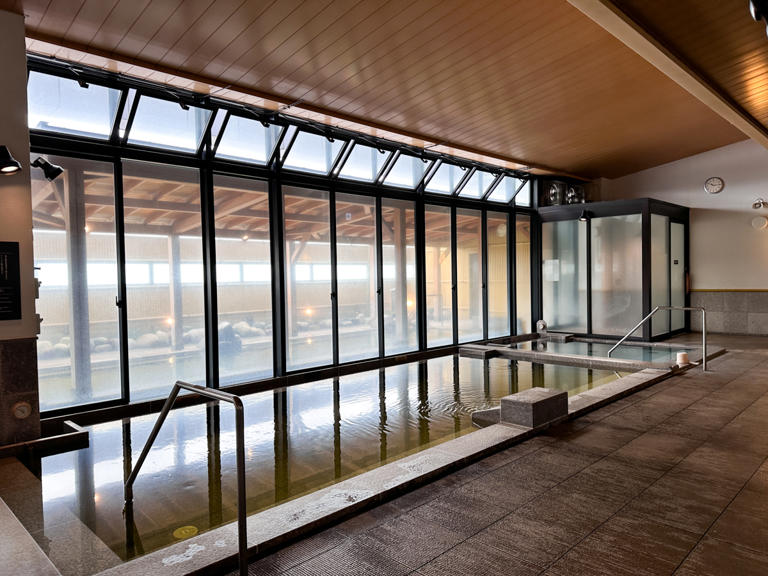

IMAGES
VIDEO
COMMENTS
Winter Temperatures in Japan. Winter in Japan generally lasts from December to February. In Tokyo, December temperatures tend to be around 12ºC (54°F) in the afternoon and drop to about 5ºC (41°F) in the morning and at night. By January, afternoon temperatures drop to 10ºC (50°F) and morning temperatures tend to hover between 2ºC - 3ºC ...
Cold weather and warm spirits. As winter approaches, a frigid chill engulfs the whole of Japan, and while it rarely snows in most of the country's metropolitan areas, the surrounding mountains and northern regions are regularly covered by fresh blankets of powder. Pack plenty of warm clothes, then bundle up and head outside to enjoy snow ...
Tips for Winter Travel in Japan. To create a wonderful winter trip in Japan, here are some suggested tips to help you to avoid unnecessary hassles. Christmas and New Year is one of the busiest times in Japan. It's better to plan ahead and book flights and hotels at least 6 months in advance to reserve your favourite hotel/room.
Travel Tips for Visiting Japan in Winter. Here are a few travel tips to help you make them most out of your Japan winter itinerary: Layering is key: It's important to dress appropriately. Winter temperatures in Japan can range from freezing to chilly depending on where you go. Pack layers like thermal tops, sweaters, and a good quality ...
Day 4: Journey to Takayama, known for delicious Hida beef. You'll spend a good chunk of the day getting to Takayama, which is best accessed on Japan Rail (JR) via Nagoya. The ride there is beautiful, most of it alongside a deeply blue river. (Sometimes there's also a direct bus, though, so be sure to check!
The Best Things to Do in Winter in Japan. 1. Hit The Powdery Slopes. One of the top reasons to visit Japan in winter is skiing and snowboarding. Ski resorts can be found in much of Japan, including the well-established Niseko in Hokkaido, which sits in the shadow of Mt. Yotei.
2. Prices are cheaper in the wintertime. Since fewer people are visiting Japan during the wintertime, prices of hotel rooms tend to drop to reflect this. So if you're looking to travel to Japan on a budget, winter is a great time to visit this notoriously expensive destination.
Domestic travel in Japan is super easy with an excellent public transport system and rail network, plenty of cheap domestic flights, and even night buses offering transport options to suit any budget. Days 1-2 Tokyo. Days 3-4 Hakone/Mt Fuji. Days 5-7 Hokkaido. Days 8-10 Japanese Alps.
Mount Fuji, Kawaguchiko - Winter is the best time for chance of catching a glimpse of Mount Fuji and the shores of the 5 lakes in Kawaguchiko is one of the best places to view it from. 4. Winter Sports. If you thought Europe was the only hot spot for winter sports, well think again.
With perfect powder snow and over 600 resorts to choose from, Japan is the ideal destination to enjoy incredible winter sports. Even if you don't ski or snowboard, Japan offers winter adventures full of culture, outdoor activities, and superb cuisine. What's more, Japan embraces the wintertime like few other countries, making the coldest ...
3 Things to Do in Winter in Japan. 3.1 Gawk at the Incredible Beauty Around You. 3.2 Practice Your Winter Photography Skills. 3.3 Enjoy Japanese Animal Adventures. 3.4 Savor Warming Winter Foods. 3.5 Visit a Ski Resort Anyway. 4 Best Onsen for Japan in Winter Travel. 5 Other FAQ About Traveling to Japan in Winter.
Kyoto and Osaka in winter. Activities to add to your Japan in winter itinerary. 1 - Visit an onsen. 2 - Slurp ramen. #3 Make the most of indoor entertainment. 4 - Stay in a traditional Japanese house. 5 - Indulge in the izakaya experience. 6 - Go shopping. 7 - Take part in a traditional tea ceremony.
Reserve seats on NRT express. Tip - 12th floor is dedicated to Japanese artist inspired t-shirts - only place to find them! Planning a trip to Japan in 2021? This 10-day itinerary along the classic golden route is perfect for first-time travelers with family. It covers Kyoto, Tokyo, Hiroshima, and Hakone.
If you do plan to hit the slopes, snow resorts in Japan popular with my fellow Aussies are: Hakuba, Nagano. Iiyama, Nagano. Furano, Hokkaido. Niseko, Hokkaido. TIP: From mid-April, it's possible to see walls of snow along the roadsides of the famous Tateyama Kurobe Alpine Route.
How to spend winter in Japan. 10 day winter itinerary with the Japan Alps; 7 day winter itinerary in Hokkaido; If you're looking for a route for winter in Japan, here are some ideas! 10 day Japan winter itinerary; Tokyo to Nagano bus; 2 days in Nagano with snow monkey pass // Stay at this Nagano hostel (private rooms available)
Gloves: Try to get a pair that match what you'll be doing in Japan. A pair that's compatible with a smart phone is recommended. Hat or Ear Muffs: You're going to want to cover your ears, I promise. Muffler or Heavy Scarf: We recommend bringing a scarf to protect your neck. Thick Socks: Bring plenty of thick socks.
Here are 8 activities that will keep you cozy and entertained during winter in Japan. From hot springs to indoor performances, explore the best ways to stay warm and make the most of your trip to Japan. Some of the most beautiful onsen towns you have to visit include Arima Onsen, Ginzan Onsen, Kinugawa, and Kusatsu.
This may not be the cheapest way to spending 8 days in Japan but for the experiences we wanted to leave with, I think we worked out a pretty fair budget. Hope you find our Japan winter itinerary useful! Budget Breakdown: Accommodation: ¥23,100 Transport: ¥49,580 (Incld. 7D Whole Japan JR Pass) Activities: ¥11,50 Food: ¥15,500
Travel tip: Make sure to use packing cubes to pack the thick winter wear to have more space in your backpack. 3. Thermals. Be sure to include thermals on your Japan winter packing list too. Being the base layer, thermals help in conserving the body heat and keeping you warm as you are having fun exploring Japan during the cold season.
By the way, if you want to blend in with the locals, pick clothes that are black, white, gray or neutral. This is especially true in Tokyo. Outside the capital, colors get more common. 3. Shoes, Socks, and Accessories. UNIQLO Products. Even winter shoes and accessories are much, much cheaper in Japan.
An onsen is incredibly relaxing, especially during the winter months and an experience to be had. As Japan is a volcanically active country, there are thousands of onsens scattered throughout. Don't be shy! ... I'm going to end these Japan travel tips with an important note! Geisha, Maiko, and Geiko are huge and essential parts of Japanese ...
Winter in Japan Travel Tips: What to expect. Japan can be quite a mystery for many visitors as many of us tend to know the country from its architecture and cherry blossoms. But it is important to know that Japan can make a wonderful destination for your next winter trip. ...
This guide for planning a trip to Japan will cover: How to prepare for a trip to Japan in 2024. 20+ crucial Japan travel tips to know before you go. Hire a pocket wifi or buy a 4G SIM card for your phone when visiting Japan. Don't blindly buy a JR Pass thinking all tourists need it. Take time to read these Japan travel guide books.
We hope you enjoyed these Japan travel tips! For more travel around Japan, see the links below: 3 week Classic Japan Itinerary in Photos: Tokyo, Kyoto, Snow Monkeys & More